NASA's Artemis 1 moon mission: Mission updates archive
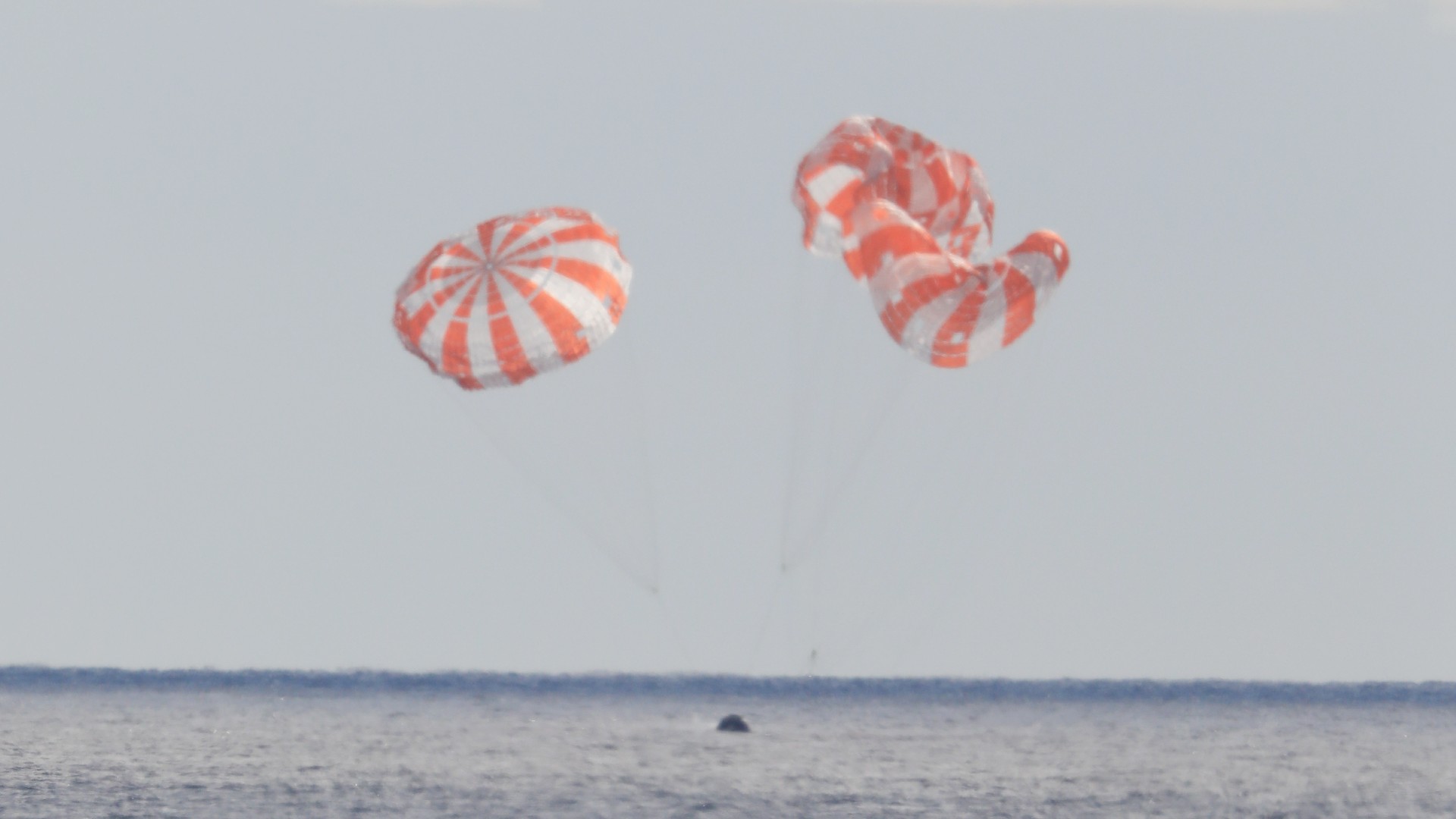
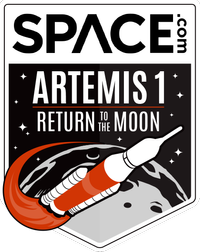
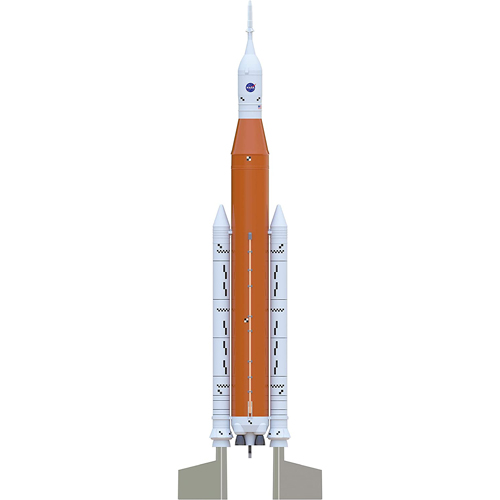
You can launch a Space Launch System of your own with this Estes NASA SLS model rocket for a 1:200 scale version of NASA's moon megarocket. Read more about it.
NASA's Artemis 1 moon mission, the agency's first big step toward returning astronauts to the lunar surface, launched to the moon on Nov. 16 on a critical test flight to return astronauts to the moon. It splashed down on Dec. 11.
Artemis 1 is the first test flight of the agency's new Space Launch System megarocket and the Orion spacecraft. The SLS rocket launched the uncrewed Orion spacecraft on a 26-day mission, during which it will orbit the moon before returning to Earth. Find out how to track Orion on Artemis 1.
See our complete coverage of the Artemis 1 mission below.
10 greatest Artemis 1 photos | Weird stuff on board | Videos | Latest news

Tariq Malik is the Editor-in-Chief of Space.com and has been covering human spaceflight for more than 18 years and space exploration overall for more than 20 years. He covered the final 22 space shuttle missions and NASA's ongoing International Space Station and Artemis program.
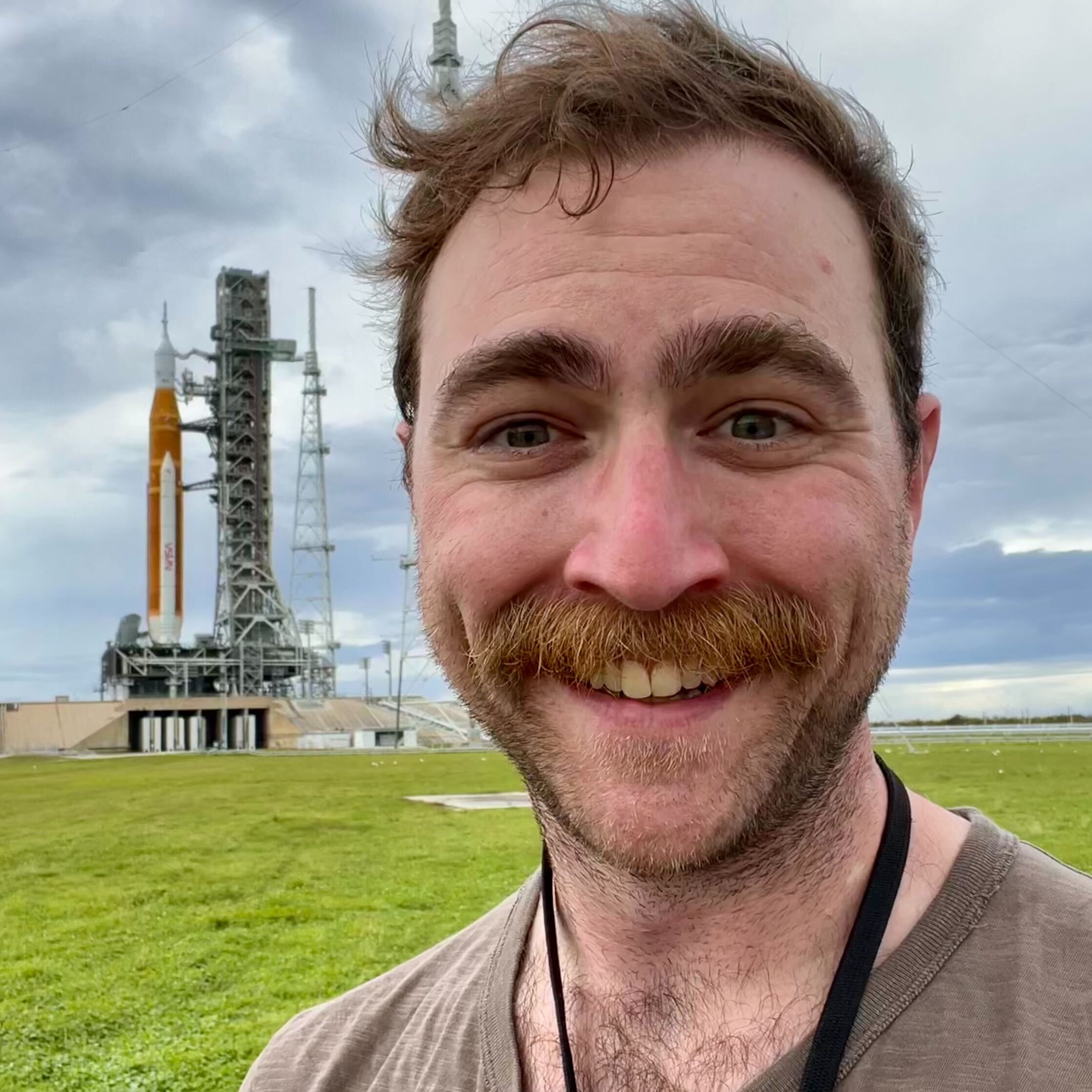
Josh Dinner is the Staff Writer for Spaceflight at Space.com. He is a writer and photographer with a passion for science and space exploration, and has been working the space beat since 2016. Josh has covered the evolution of NASA's commercial spaceflight partnerships and crewed missions from the Space Coast, as well as NASA science missions and more. He also enjoys building 1:144-scale model rockets and human-flown spacecraft. Find some of Josh's launch photography on Instagram and his website, and follow him on X, where he mostly posts in haiku.
Artemis 1 prepares for burn at 7:44 a.m. EST
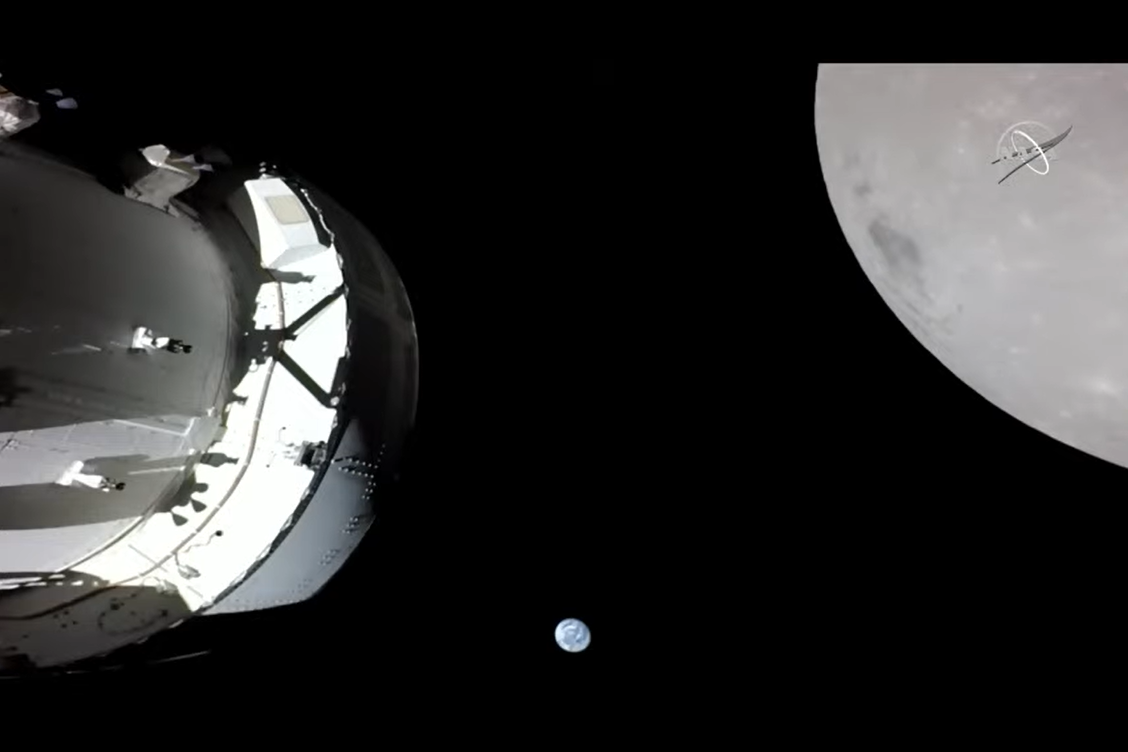
The Artemis 1 Orion spacecraft is preparing for a burn at 7:44 a.m. EST (1244 GMT) as it swings around the moon. Live views beaming from the spacecraft showed the Earth and the moon within the camera view. Orion is on an uncrewed journey testing out all systems ahead of flying astronauts, which may happen as soon as Artemis 2 in 2024.
Artemis 1 status briefing starts soon
NASA officials are holding a news conference today (Feb. 2) at 12 p.m. EST (1700 GMT) to discuss the delayed rollout of the SLS rocket. You can listen to the teleconference live in the window above, courtesy of NASA.
"While the teams are not working any major issues, NASA has added additional time to complete closeout activities inside the VAB [Vehicle Assembly Building] prior to rolling the rocket out for the first time," agency officials wrote in a statement.
Full story: NASA delays rollout of Artemis 1 moon mission's SLS megarocket until March. Hear why today.

You can launch a Space Launch System of your own with this Estes NASA SLS model rocket for a 1:200 scale version of NASA's moon megarocket. Read more about it.
Artemis 1 rollout delayed, NASA says
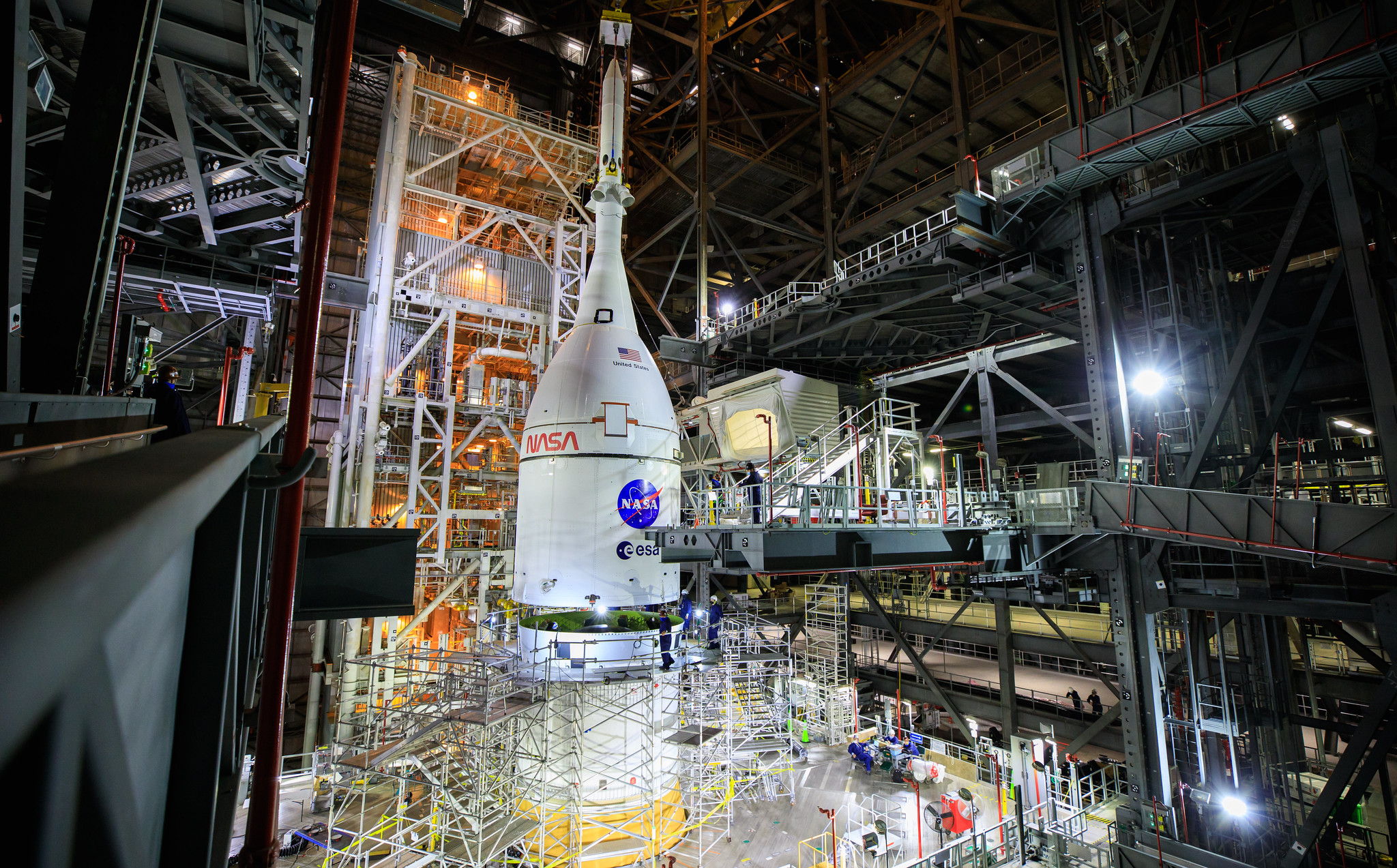
NASA's first Artemis moon mission will launch a little later than expected.
Today (Feb. 2), NASA announced that the rollout of its Space Launch System (SLS) megarocket and Orion capsule will be pushed from February to March, though the agency has yet to announce an exact date.
"Ultimately, we're going to launch this flight hardware when the flight hardware is ready and when the team's ready," Mike Bolger, the program manager of exploration ground systems at NASA's Kennedy Space Center, told Space.com during a news conference held today.
While the exact rollout date and new launch date have not yet been announced, Mike Sarafin, the Artemis 1 mission manager at NASA Headquarters, said during the news conference that if the launch is pushed to April or May, a launch window would extend from April 8 to April 23; another would open May 7 and close May 21.
Learn more at Space.com here.
NASA fires up Artemis 1 moon rocket's first-stage engines again
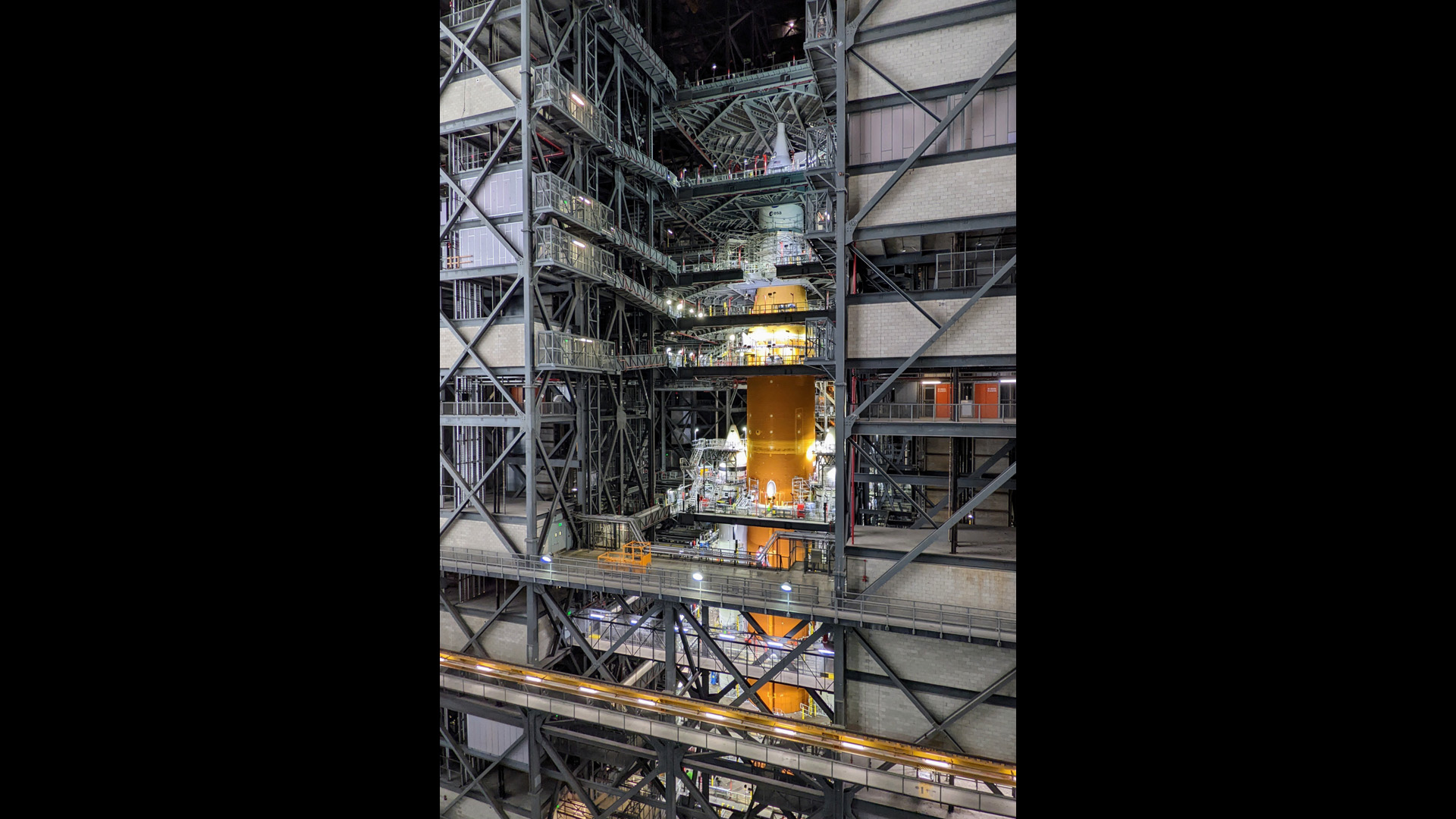
NASA appears to have ironed out the kinks with the core-stage engines of the Space Launch System (SLS) rocket that will launch the Artemis 1 moon mission this spring.
A faulty controller on one of the SLS core-stage engines required some troubleshooting recently, pushing the launch of Artemis 1 — an uncrewed journey around the moon — back to April. Those fixes appeared to work, for the SLS core stage engines performed as expected during a recent series of tests, NASA officials announced on Friday (Feb. 18). Read our story about these developments here.
And speaking of developments: We're going to get another Artemis 1 update soon. NASA will hold a media teleconference on Thursday (Feb. 24) at 1:30 p.m. EST (1830 GMT) to discuss the latest progress toward launch. You can listen to it live Thursday here at Space.com, courtesy of NASA, or directly via the space agency.
NASA Artemis 1 mission update today
Update for 1:30 pm ET: NASA is now targeting 2:30 p.m. EST (1930 GMT) for its press teleconference today on the Artemis 1 moon mission update.
NASA will hold a live teleconference today to discuss its plans to launch the Artemis 1 moon mission as early as April. The teleconference will begin at 1:30 pm ET (2030 GMT) today and you can listen in live here.
Artemis 1 is NASA's first mission to the moon under the agency's Artemis program, which aims to send astronauts to the moon by around 2025 or so. That crewed moon landing will occur on the Artemis 3 mission.
As the first to fly, Artemis 1 will not carry a crew, but will fly on a trip around the moon with instruments, cubesats and more aboard. The mission will use the new Space Launch System to launch an Orion space capsule to the moon and back.
The rollout of that SLS moon rocket is expected sometime in March, with NASA due to give an update on that process today.
Artemis 1 rocket rollout set for March 17 for May launch
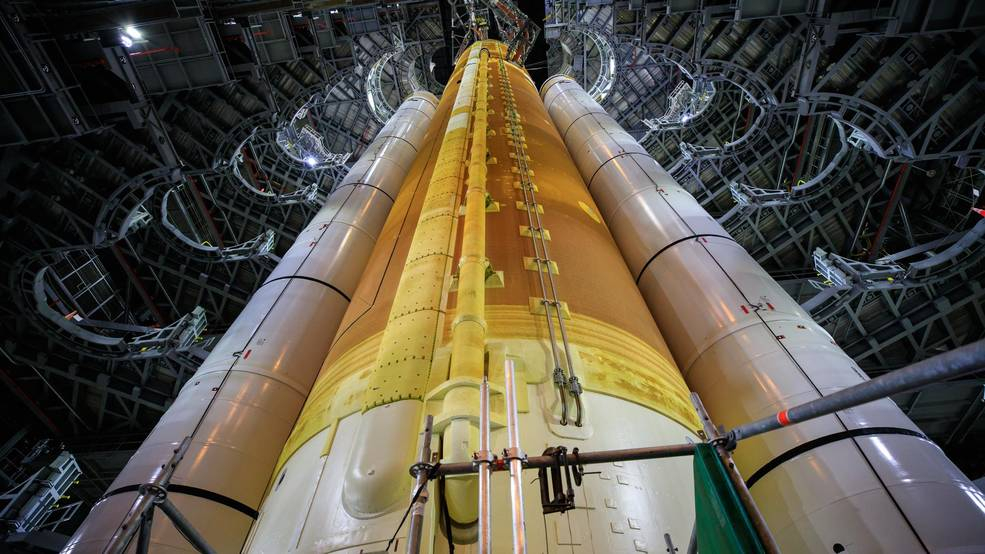
In a press conference today, NASA announced that it will roll out the Artemis 1 moon rocket, the agency's first Space Launch System megarocket, on March 17 at the Kennedy Space Center in a major milestone for the agency's return to the moon.
Artemis 1 will roll out to Launch Pad 39B at the Kennedy Space Center for up to a month of pad tests and a "wet dress rehearsal" in which the rocket will be fueled as if for launch. The tests will set the stage for an Artemis 1 launch sometime in May 2022, but that could slip to June or July, NASA officials said today.
You can read the full story, including details on the wet dress rehearsal, rollout and launch window plans, in our wrap story by Mike Wall.
Send your name around the moon on Artemis 1
You can send your name around the moon on NASA's Artemis 1 mission, an uncrewed flight that's scheduled to launch in May or June. Just sign up for a free "boarding pass" at this NASA page — that's all there is to it! Read more here.
Artemis 1 rollout media teleconference today
Today (March 14), NASA will be hosting a live media teleconference discussing the details of the upcoming rollout of the Artemis 1 vehicles.
Rollout of the vehicles, the Space Launch System (SLS) megarocket and the Orion spacecraft, will take place on Thursday (March 17) at NASA's Kennedy Space Center in Florida. The pair will be carried by the agency's crawler-transporter 2 vehicle on a slow, 4-mile journey to Launch Pad 39B.
Join the media teleconference live today at 5:30 EST (2230 GMT) at Space.com or directly via the agency's Youtube channel. You can watch the event live at the video above.
It's rollout day for Artemis 1 moon rocket!
It's finally here: rollout day for NASA's Artemis 1 moon rocket.
As Space.com Senior Writer Chelsea Gohd reports, NASA's first Space Launch System megarocket will roll to Launch Pad 39B at the Kennedy Space Center in Florida at 5 p.m. EDT (2100 GMT). You'll be able to watch it live at start time on this page and on the Space.com homepage, courtesy of NASA TV. It will take up to 12 hours to reach the pad. Gohd is at the Kennedy Space Center and will cover the rollout overnight for Space.com.
The Artemis 1 mission will launch an uncrewed Orion spacecraft around the moon no earlier than late May 2022. Today's rollout is a debut of sorts for the rocket and will kick off a month of pad tests that, NASA hopes, will include a "wet dress rehearsal" to fuel the rocket for the first time.
Today's rollout marks the biggest move in years for NASA's massive crawler carrier vehicle as well. The Apollo-era vehicle, originally built to move Saturn V rockets, weighs 5.75 million pounds (2.60 million kilograms) and was used to move NASA space shuttles and the Ares I-X test rocket to the pad.
Space.com's Spaceflight Editor Mike Wall has this explainer of the crawler carrier vehicle.
NASA opens VAB doors for Artemis 1 rollout
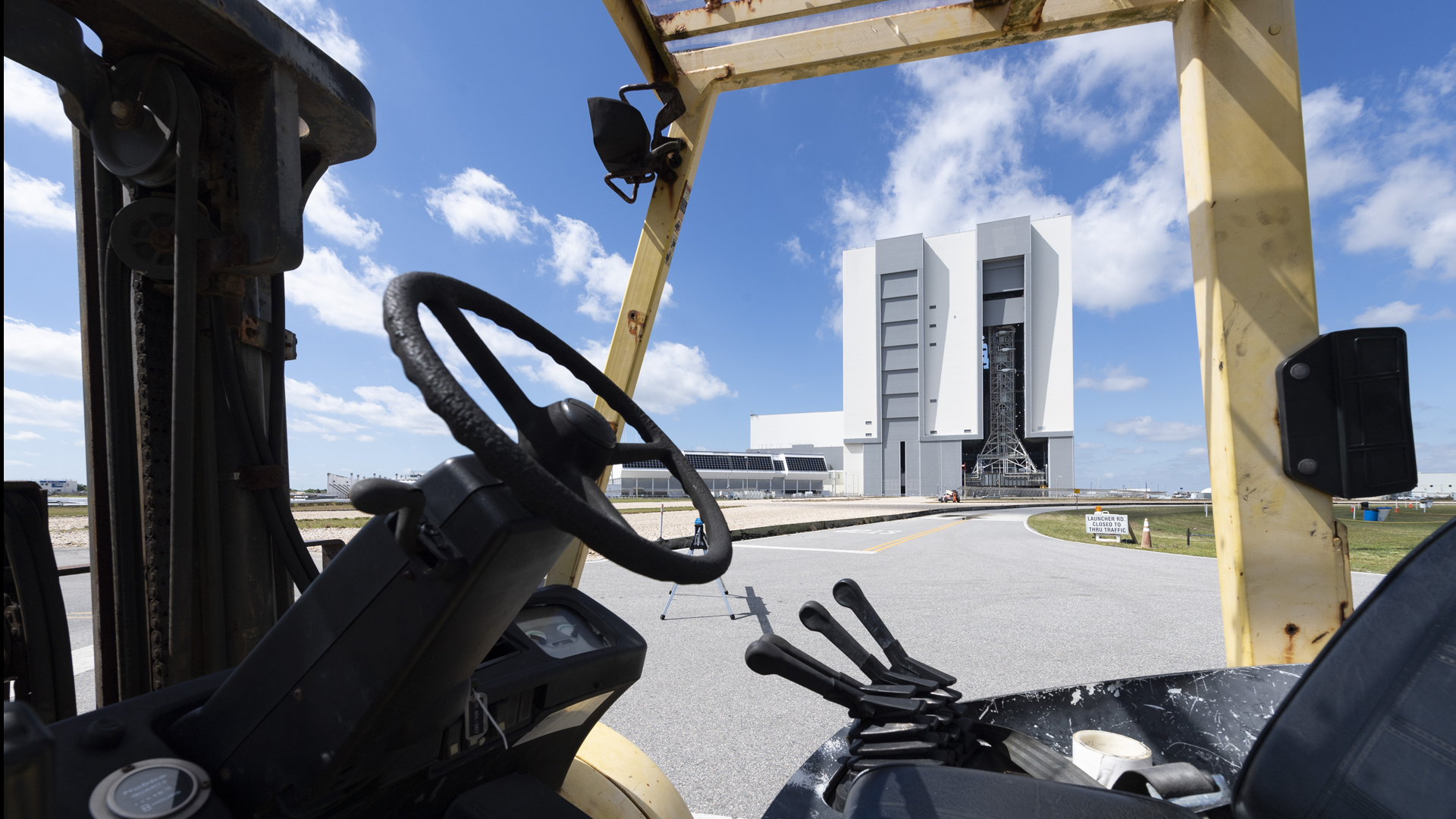
NASA has opened the massive bay doors on the Vehicle Assembly Building to begin today's planned rollout of the first Space Launch System megarocket that will be used to launch the Artemis 1 mission to the moon. Rollout will begin at 5 p.m. EDT (2100 GMT).
Space.com Senior Writer Chelsea Gohd is at NASA's Kennedy Space Center in Cape Canaveral, Florida where she is covering the rollout live. Here's some of her photos so far.
Slow and steady is the name of the game today pic.twitter.com/V4uHvuaJ1lMarch 17, 2022
Artemis 1 rollout is live!
NASA TV has begun livestreaming the rollout of its Artemis 1 moon mission to the launch pad at Florida's Kennedy Space Center for testing. Watch it live and read more here.
Rollout has begun!
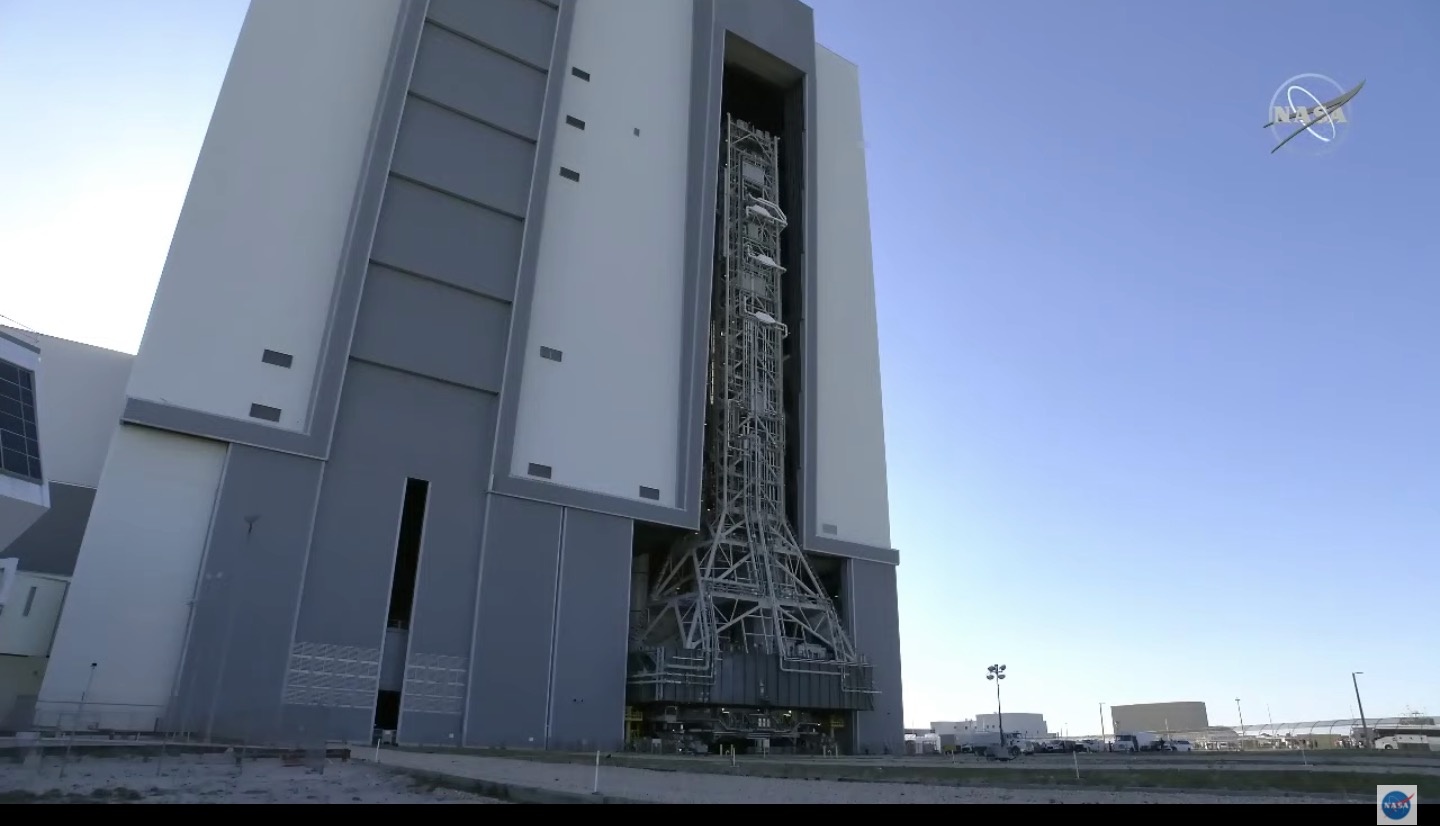
NASA began rolling its Artemis 1 moon mission out to the launch pad at Kennedy Space Center in Florida today (March 17) at 5:47 p.m. EDT (2147 GMT). The agency's crawler-transporter 2 vehicle is carrying the Space Launch System rocket and Orion capsule on a 4-mile (6.4 kilometers) journey that's expected to take about 11 hours. Read more here.
Artemis 1 clears the VAB!
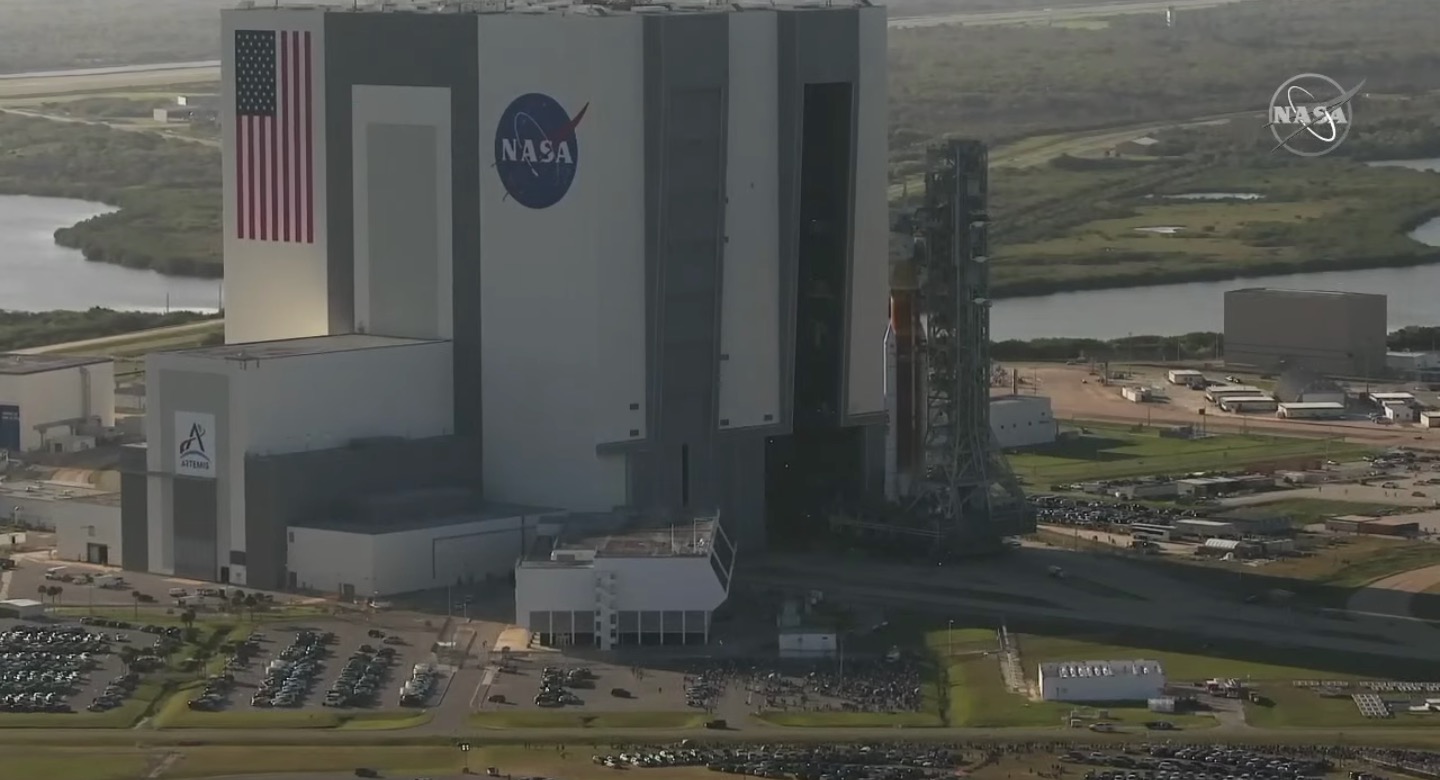
The Space Launch System (SLS) rocket and Orion capsule that will fly NASA's Artemis 1 moon mission this summer emerge from the Vehicle Assembly Building at NASA's Kennedy Space Center in Florida on March 17, 2022. The SLS-Orion duo are on their way to the launch pad for testing, a 4-mile (6.4 kilometers) journey that's expected to take 11 hours. Read more.
NASA chief Bill Nelson speaks during Artemis rollout
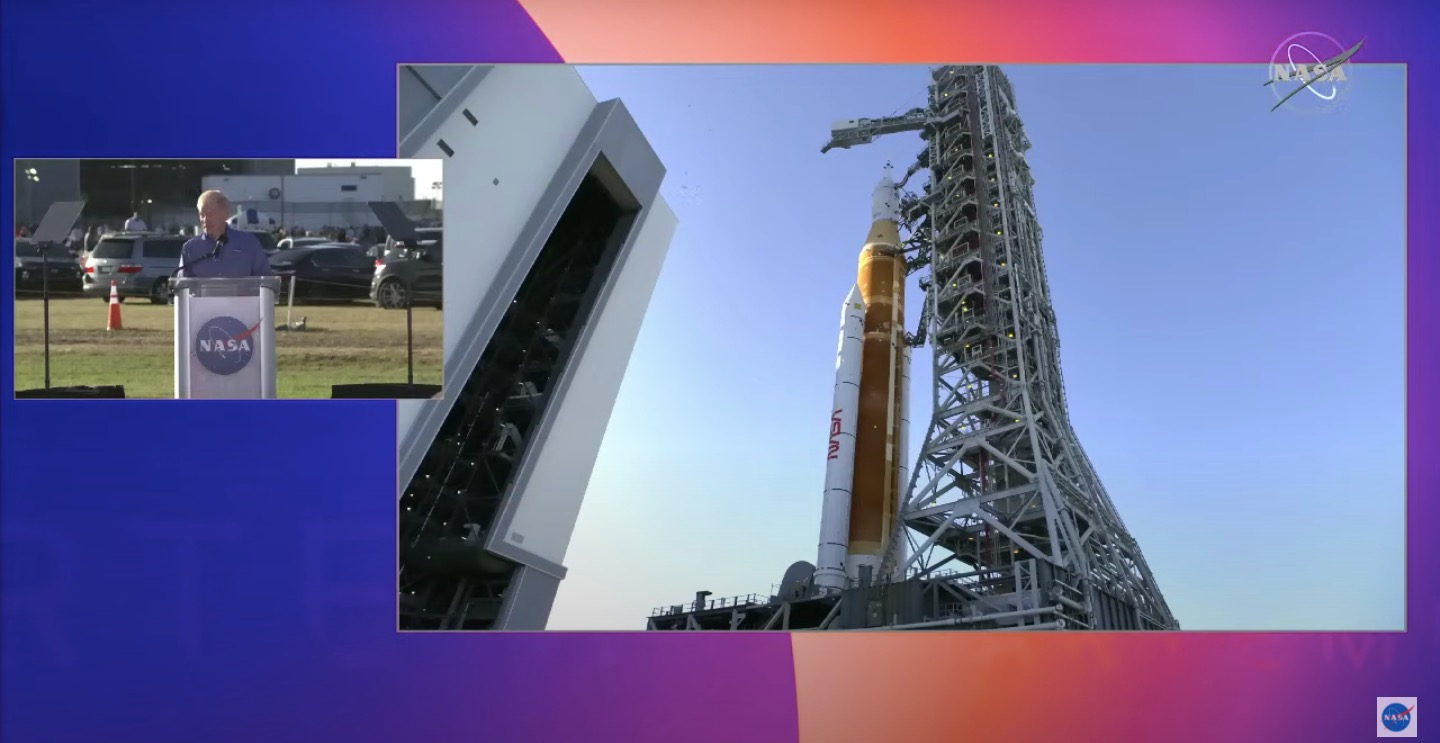
The Artemis 1 rollout featured an appearance by NASA Administrator Bill Nelson, who gave a 13-minute speech as the agency's Space Launch System megarocket and Orion capsule rolled slowly by in the background.
"Ladies and gentlemen, the world's most powerful rocket ever right here," Nelson said. "It's back to the moon and then on to Mars!"
NASA's Artemis 1 megarocket is on the launch pad
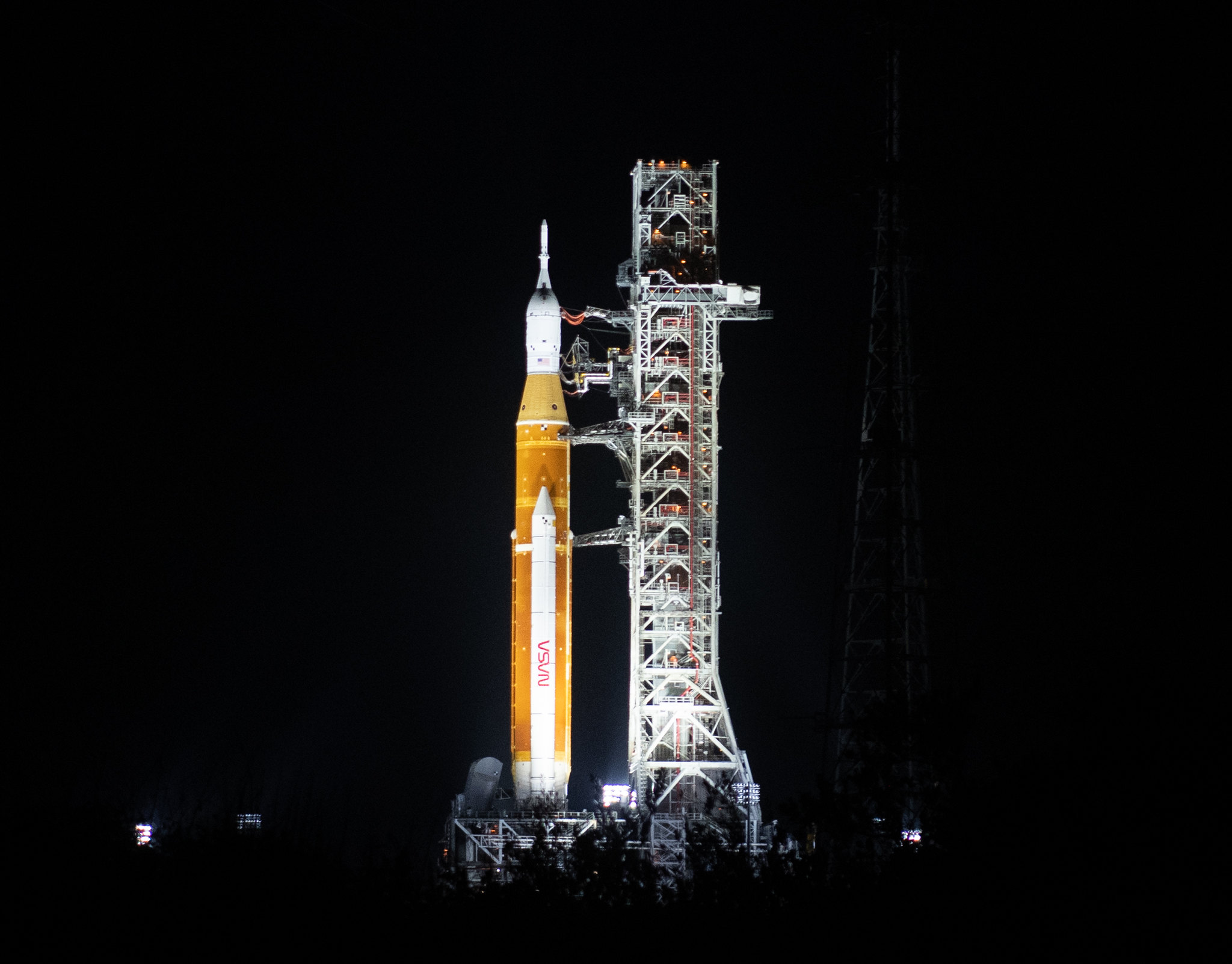
It's a milestone space fans have been waiting for for ages: NASA's first Space Launch System (SLS) rocket reached the launch pad in the early morning of Friday (March 18). The rocket will undergo about a month of testing, retreat to the Vehicle Assembly Building, roll out again and launch no earlier than late May.
There's a rocket there, we promise!
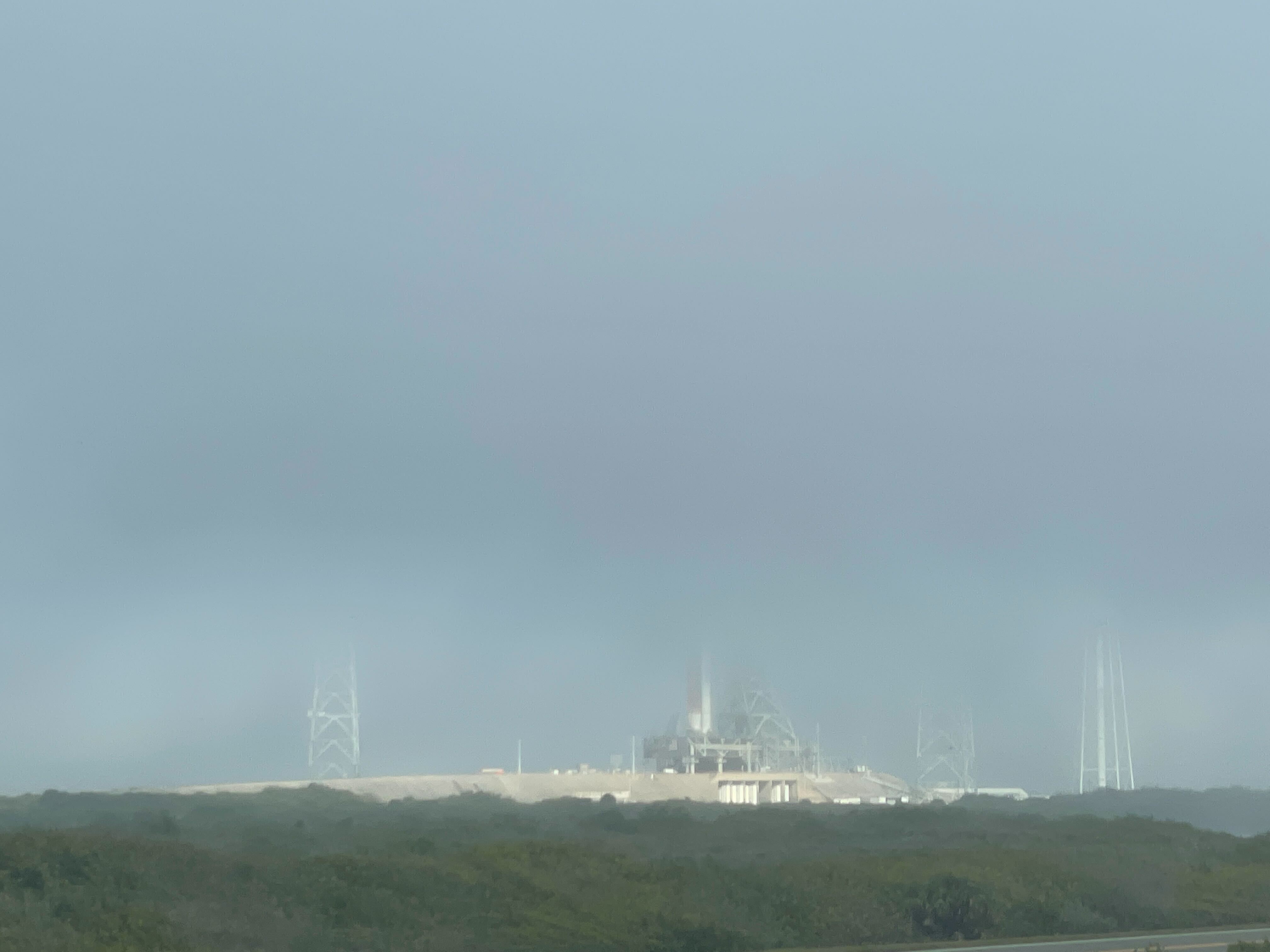
Space.com senior writer Chelsea Gohd is on the scene in foggy early-morning Florida checking out the Artemis 1 rocket on the launch pad. She's live-tweeting the visit so follow along to hear all the latest and see tons more photos:
I see the worm! pic.twitter.com/k4J4WtLNdXMarch 18, 2022
Hey look! It’s Artemis 1 on the launch pad! 😂 pic.twitter.com/SqSS0wnROLMarch 18, 2022
Artemis 1 wet dress rehearsal press conference
NASA will hold a teleconference today at 1 p.m. EDT (1700 GMT) to discuss the agency's critical first fueling test for the Artemis 1 moon rocket currently standing atop Launch Pad 39B at the Kennedy Space Center in Florida. You can watch it live at the top of our homepage.
Called a "wet dress rehearsal," the multi-day test will begin on April 1 and end on April 3 and serve as a launch day dress rehearsal for NASA's Artemis 1 uncrewed moon mission. Artemis 1 is scheduled to launch no earlier than late May or early June.
Speaking in today's conference will be:
- Tom Whitmeyer, deputy associate administrator for common exploration systems development, NASA Headquarters in Washington
- Charlie Blackwell-Thompson, Artemis launch director, NASA Exploration Ground Systems program, NASA Kennedy
- John Honeycutt, manager, Space Launch System program, NASA’s Marshall Space Flight Center in Huntsville, Alabama
- Howard Hu, manager, Orion program, NASA’s Johnson Space Center in Houston
- Mike Sarafin, Artemis mission manager, NASA Headquarters
Tune in at 1 p.m. EDT to find out more about NASA's Artemis 1 fueling test plans.
Artemis 1 SLS rocket core stage powered up for test
NASA's three-day launch countdown and fueling test for its Artemis 1 moon rocket is in full swing, with engineers powering up the Space Launch System's core stage at 3 a.m. EDT (0700 GMT) this morning, NASA reports.
The test, called a "wet dress rehearsal," is practicing launch countdown and fueling procedures for the Space Launch System rocket that will be needed when NASA launches the actual Artemis 1 moon mission with this booster around late May or June.
You can see live views of the Artemis 1 Space Launch System on the launch pad at NASA's Kennedy Newsroom YouTube Channel, which is embedded above.
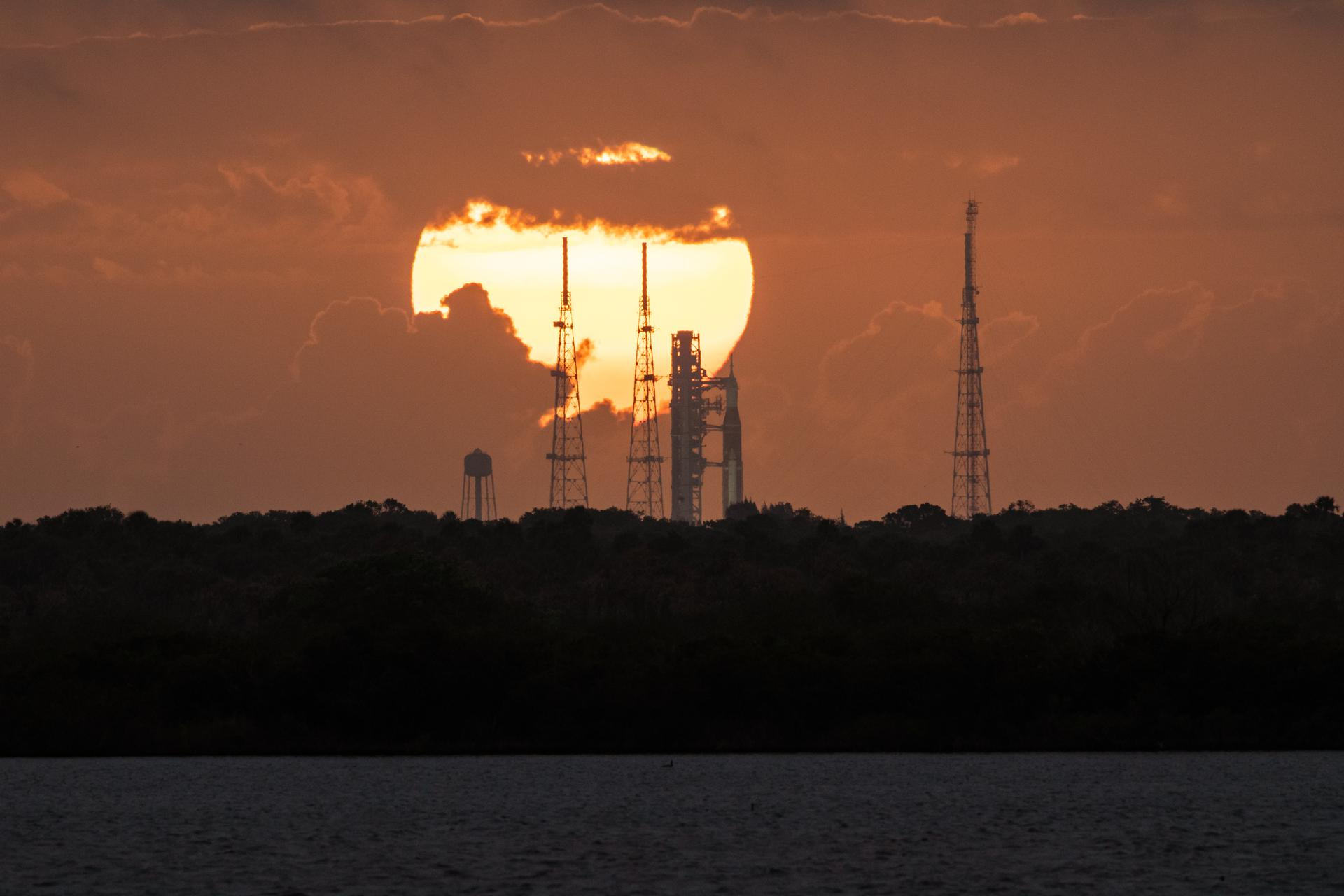
Here's what NASA has on tap for today: "Around 3 a.m. on Saturday April 2, at approximately L-35 hours and 20 minutes, the Artemis I launch control team powered up the Space Launch System rocket’s core stage, which will be loaded with more than 700,000 gallons of propellants during the tanking phase of the countdown. During the day, teams will charge Orion flight batteries, conduct final preparations on umbilical arms, and conduct a final pre-launch walkdown," the agency wrote in a status update.
At 10 a.m. EDT (1400 GMT), NASA will conduct a weather briefing, at which time the agency will release a new update. Jeremy Parsons, NASA's deputy manager of the Exploration Ground Systems program at @NASAKennedy, is providing live updates via the agency's NASA Exploration Ground Systems Twitter account. -- Tariq Malik
Fueling day for Artemis 1 moon rocket
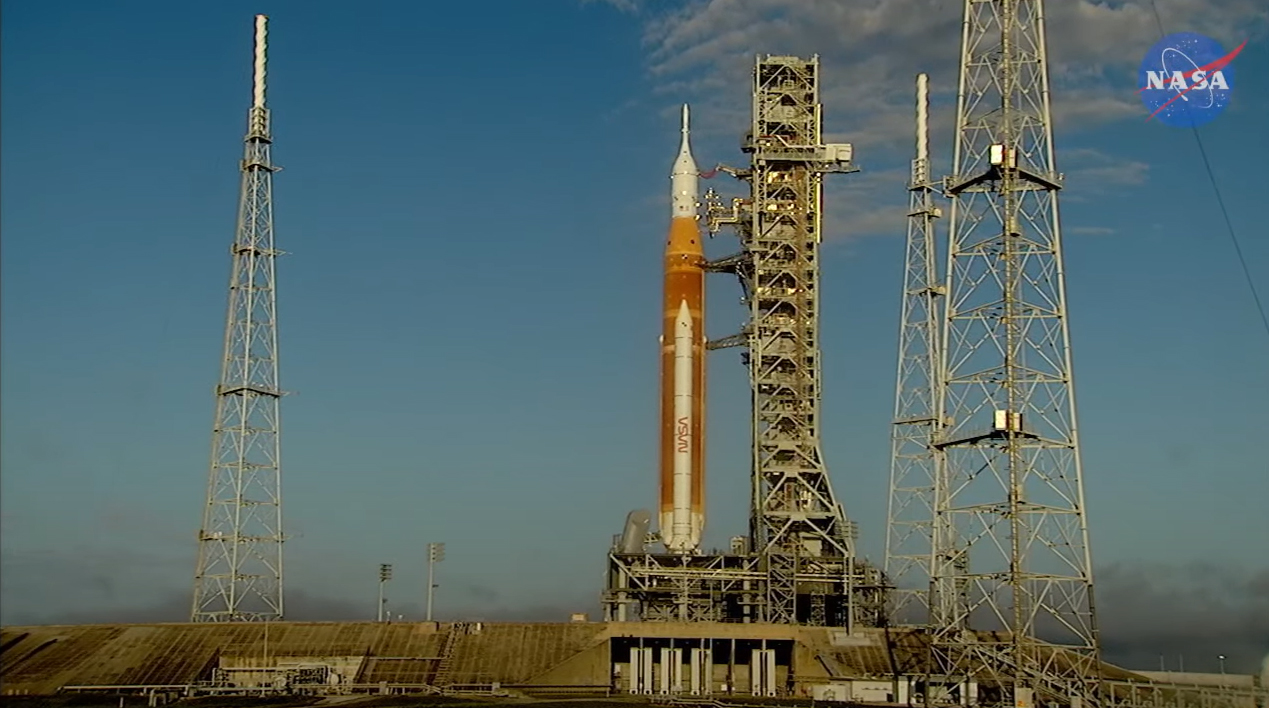
It's fueling day for NASA's Artemis 1 moon rocket as the agency nears the main event of its "wet dress rehearsal."
At 6:45 a.m. EDT today, NASA's Artemis 1 launch director gave the "go" to begin fueling the Artemis 1 Space Launch System rocket at 7:20 a.m. EDT (1120 GMT).
Strong storms overnight caused about an hour of delays for crews working at Launch Pad 39B, according to Jeremy Parsons, NASA's deputy manager of the Exploration Ground Systems, who is live Tweeting the test.
Four lightning strikes occurred in the vicinity of the Pad 39B site, including the strongest strike to the pad's protective catenary wire and tower structure designed to shield the Artemis 1 moon rocket from direct lightning hits.
"1 of the strikes last night was the strongest we have seen since we installed the new lightning protection system," Parsons wrote. "It hit the catenary wire that runs between the 3 towers. System performed extremely well & kept SLS and Orion safe. Glad we enhanced protection since Shuttle!"
(1/4) 1 of the strikes last night was the strongest we have seen since we installed the new lightning protection system. It hit the catenary wire that runs between the 3 towers. System performed extremely well & kept SLS and Orion safe. Glad we enhanced protection since Shuttle!April 3, 2022
Scrub! NASA calls off Artemis 1 fueling test
NASA has called off its planned "wet dress rehearsal" fueling test of its first Artemis 1 moon rocket over safety concerns with the rocket's mobile launch platform.
NASA announced the scrub on Twitter at 12:06 p.m. EDT (1606 GMT), nearly five hours after fueling was originally scheduled to occur. The reason, NASA officials said, was a pressurization problem on the mobile launcher that houses ground crew systems.
"Teams have decided to scrub tanking operations for the wet dress rehearsal due to loss of ability to pressurize the mobile launcher. The fans are needed to provide positive pressure to the enclosed areas within the mobile launcher and keep out hazardous gases," NASA wrote in an update today. "Technicians are unable to safely proceed with loading the propellants into the rocket’s core stage and interim cryogenic propulsion stage without this capability."
NASA is now working to determine if ground crews can make another attempt to fuel the Artemis 1 mission's Space Launch System rocket on Monday, April 4.
A media briefing on NASA's plans is expected later today.
NASA to try Artemis 1 fueling test again
NASA will make a second attempt to fuel the Artemis 1 Space Launch System moon rocket today after a ground systems equipment problem on the rocket's mobile launcher prevented the test on Sunday (April 3).
The Artemis 1 moon rocket is standing atop Pad 39B of NASA's Kennedy Space Center in Cape Canaveral, Florida, where it has been undergoing a critical "wet dress rehearsal" to practice a full launch countdown ahead of its moon mission later this year.
At 6 a.m. EDT (1000 GMT), the launch control team was expected to meet and review the rocket's status before deciding whether to begin loading fuel at around 7 a.m. EDT (1100 GMT). If approved, the team would then proceed to fuel the SLS rocket with the 700,000 gallons of super-cold liquid oxygen and liquid hydrogen.
NASA plans to countdown to a T-0 "liftoff" time of 2:40 p.m. EDT (1840 GMT).
NASA 'go' to fuel Artemis 1 moon rocket
NASA launch controllers cleared the Artemis 1` moon rocket to proceed with "tanking" (or fueling) the Space Launch System booster today at 7:40 a.m. EDT (1140 GMT). Later, officials are expected to give a "go" to actually start the fueling process.
NASA reports that the test team is in a hold currently as they work to resolve an outage with a vendor that provides gaseous nitrogen that is needed for the tanking process.
"Nitrogen is used to prepare for, and during tanking operations, to provide a non-flammable environment inside of the SLS. When the issue is resolved, the countdown clock will pick back up with T-6 hours, 40 minutes on the clock (L-7 hours, 20 minutes) remaining in the countdown, beginning with chilling down the liquid oxygen lines for the core stage," NASA wrote in an update.
Earlier, NASA was targeting a planned T-0 "launch time" of 2:40 p.m. EDT (1840 GMT) in which to conclude today's test. We're awaiting word from NASA if that time will change.
NASA sets new Artemis 1 "launch" time of 6:02 p.m. EDT
NASA has set a new "launch" time for its Artemis 1 moon mission — 6:02 p.m. EDT (2202 GMT) today (April 4).
The huge Space Launch System (SLS) rocket and Orion capsule that will fly Artemis 1 won't actually get off the ground today, of course; NASA is currently conducting a "wet dress rehearsal" that simulates many of the activities leading up to launch, including fueling of the SLS. This crucial trial started on Friday afternoon (April 1) and was supposed to wrap up on Sunday (April 3), but several technical issues pushed some work to today.
Keep checking back here for updates. And you can see live video of the SLS-Orion stack on the launch pad at NASA's Kennedy Space Center here.
NASA halts fueling of Artemis 1 moon rocket due to valve issue
The "wet dress rehearsal" of NASA's Artemis 1 moon mission has hit another snag.
The crucial three-day test was supposed to wrap up Sunday (April 3) with the fueling of Artemis 1's huge Space Launch System (SLS) rocket, but a problem with the fans on its mobile launch tower pushed things back to Monday (April 4). The Artemis 1 team began loading 700,000 gallons of supercold liquid propellants into the rocket on Monday but had to halt after discovering a problem with a vent valve on the mobile launcher.
"Due the vent valve issue, the launch director has called off the test for the day. The team is preparing to offload LOX and will begin discussing how quickly the vehicle can be turned around for the next attempt. A lot of great learning and progress today," NASA's Exploration Ground Systems program said via Twitter Monday afternoon. ("LOX" is liquid oxygen, one of the two SLS propellants. The other is liquid hydrogen.)
Stay tuned for more updates.
Artemis is back to work on Saturday
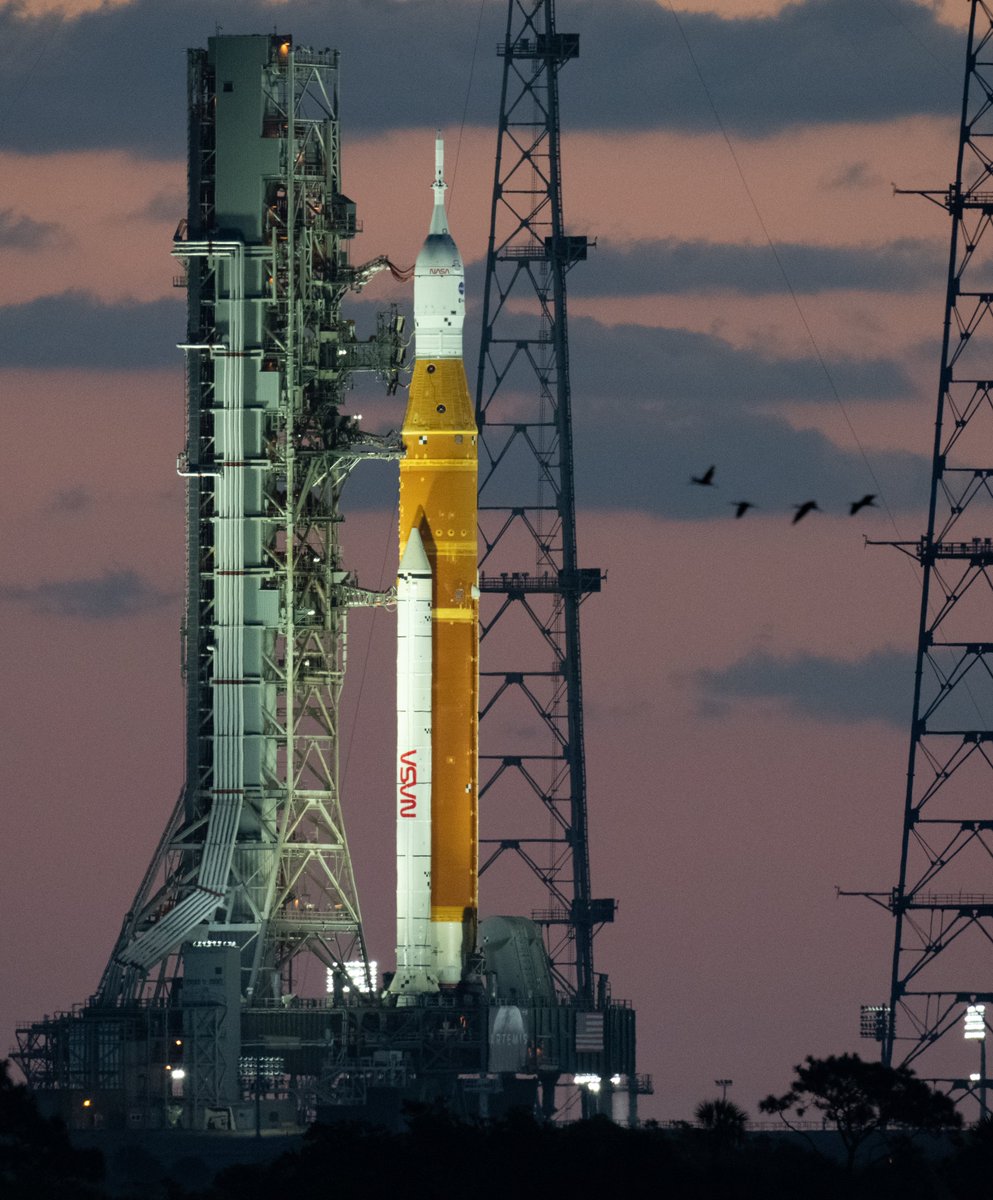
NASA has announced that it will resume work on the Artemis 1 wet dress rehearsal, a crucial pre-flight test for the uncrewed moon-circling mission due to launch this summer. The agency began wet dress rehearsal activities on April 1, but had to stop procedures twice. Then, NASA personnel stood down from the rehearsal in order to permit the Ax-1 mission to the International Space Station to launch on Friday (April 8).
Now, NASA has a plan to get back to work on the rocket check. Agency personnel will begin work on Saturday (April 9) at about 5 p.m. EDT (2100 GMT). The Artemis 1 team will work through each task of launch preparations, straight through to just under 10 seconds before what would be launch time on a real flight. If all goes well, the team will reach that "T-0" time on Monday (April 11) at about 2:40 p.m. EDT (1840 GMT), NASA officials wrote in a statement.
NASA resuming Artemis 1 moon rocket test Tuesday
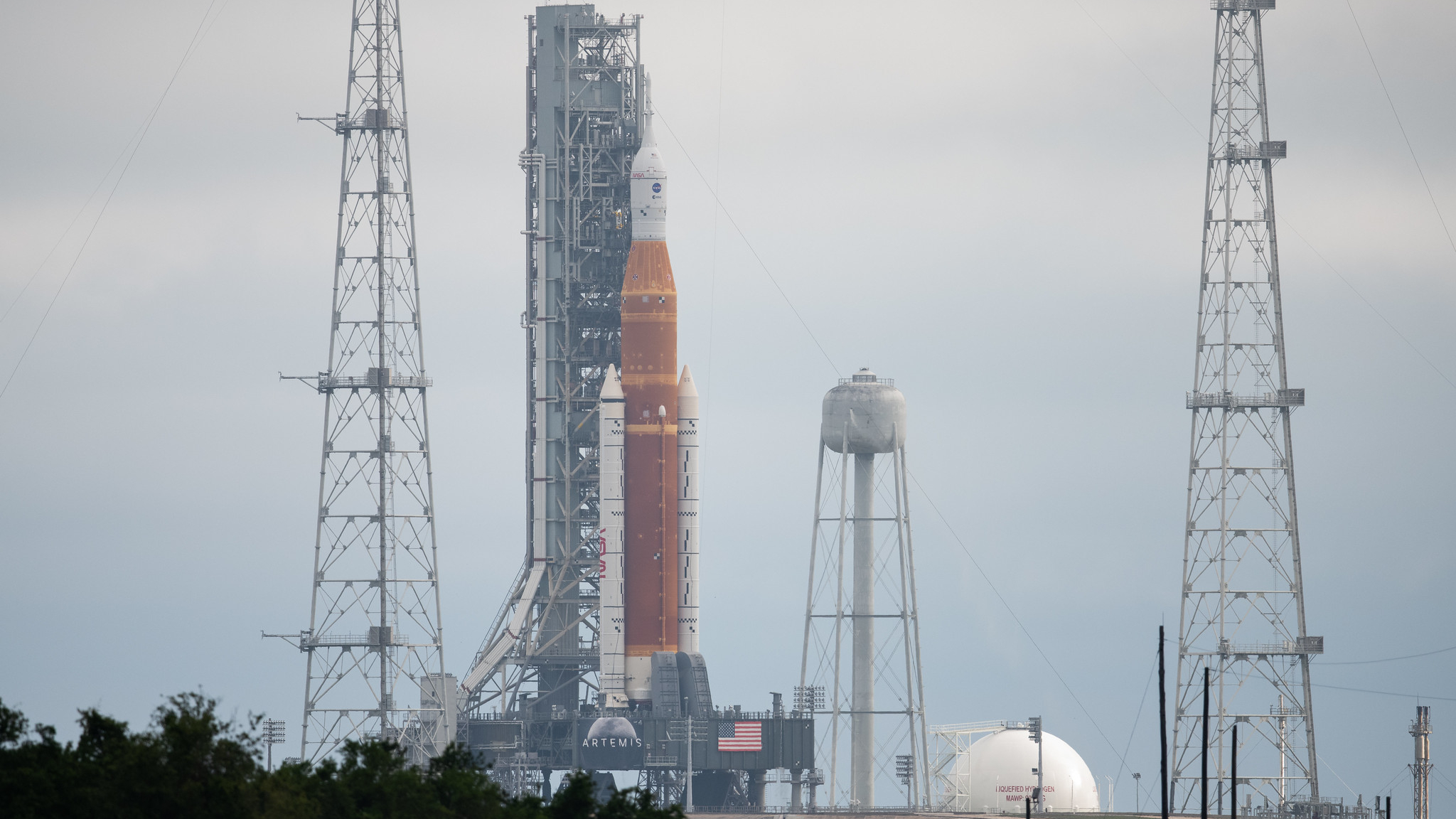
NASA plans to resume the crucial "wet dress rehearsal" of its Artemis 1 moon mission Tuesday (April 12) after a more than weeklong delay.
The test — a practice run of the most important Artemis 1 prelaunch activities, including rocket fueling — began on April 1 and was supposed to wrap up 48 hours later. Technical issues pushed things back a few days, however, and the team then had to stand down for the launch of the Ax-1 private astronaut mission, which lifted off Friday (April 8) from a neighboring launch pad at NASA's Kennedy Space Center in Florida.
But the wet dress is slated to pick up again Tuesday with a "call to stations" at 5 p.m. EDT (2100 GMT). The big-ticket items, including fueling of Artemis 1's huge Space Launch System (SLS) rocket, will occur Thursday (April 14), if all goes according to plan.
Only the core stage of the two-stage SLS will be fueled, however. The original plan called for fueling the upper stage as well, but NASA nixed that part after discovering a problem with a valve on Artemis 1's mobile launch tower. Read our full story here.
NASA resumes Artemis 1 moon mission's wet dress rehearsal
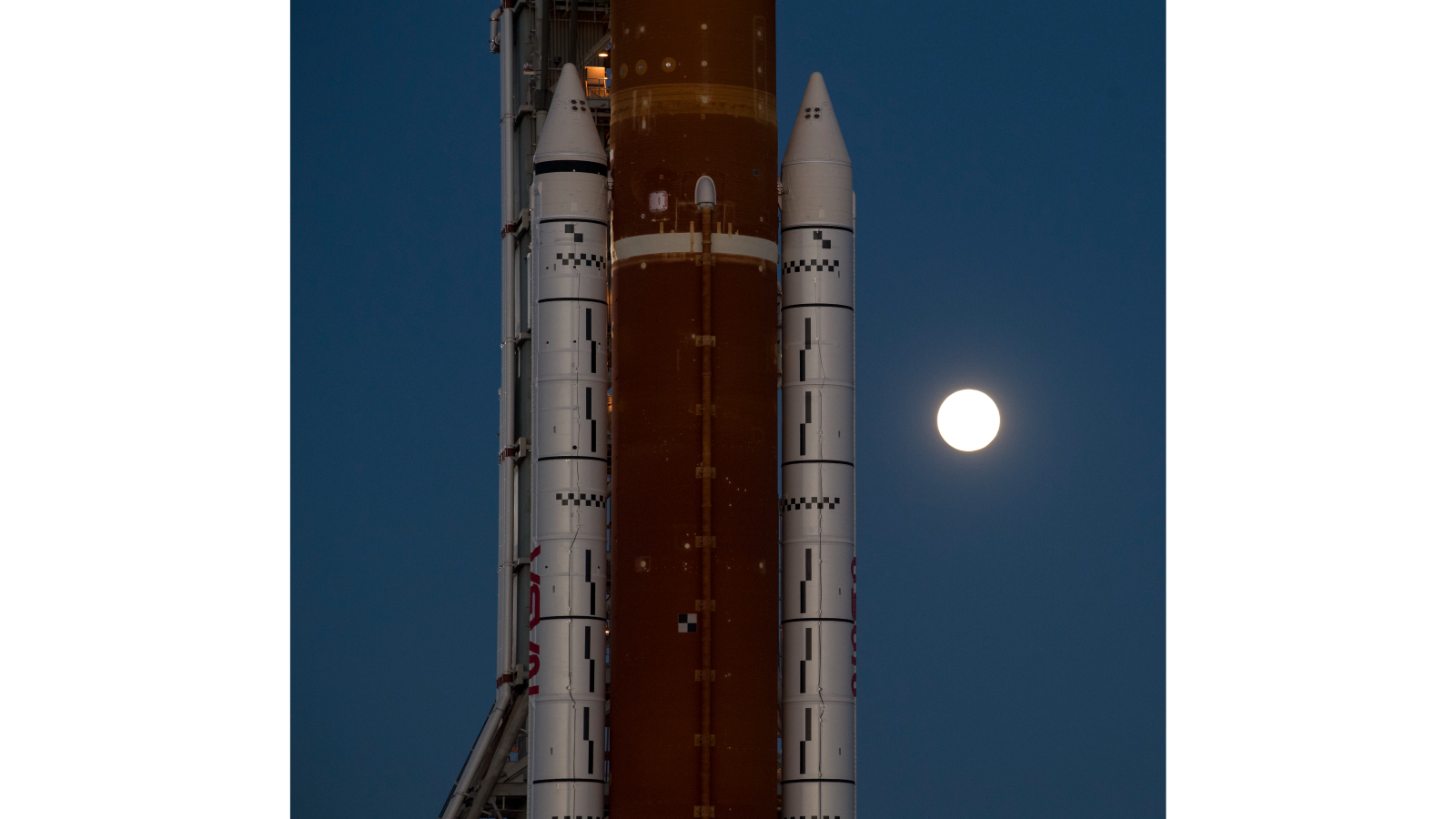
NASA has resumed a key prelaunch test of its Artemis 1 moon mission.
The Artemis 1 wet dress rehearsal began once again at about 5 p.m. EDT (2100 GMT) on Tuesday (April 12), when team members arrived at their stations at the Launch Control Center at NASA's Kennedy Space Center (KSC) in Florida.
The wet dress will unfold over the next 48 hours, with the big events — fueling of the core stage of Artemis 1's huge Space Launch System rocket, for example, and the performance of several simulated countdowns — occurring on Thursday (April 12).
The weather looks good for tanking operations on Thursday, NASA officials wrote in a blog post on Tuesday.
This isn't the first attempt at Artemis 1's wet dress. NASA began the test on April 1 and aimed to finish it on April 3, but technical issues and the April 8 launch of the private Ax-1 astronaut mission pushed things back to Tuesday.
One of the technical issues, a faulty valve on the Artemis 1 mobile launch tower, led to the modification of some wet dress procedures. NASA had originally intended to fuel up both stages of the SLS, for example, but will now focus on tanking just the core stage. Read more in our story here.
NASA powers up Artemis 1 rocket's core stage, Orion spacecraft
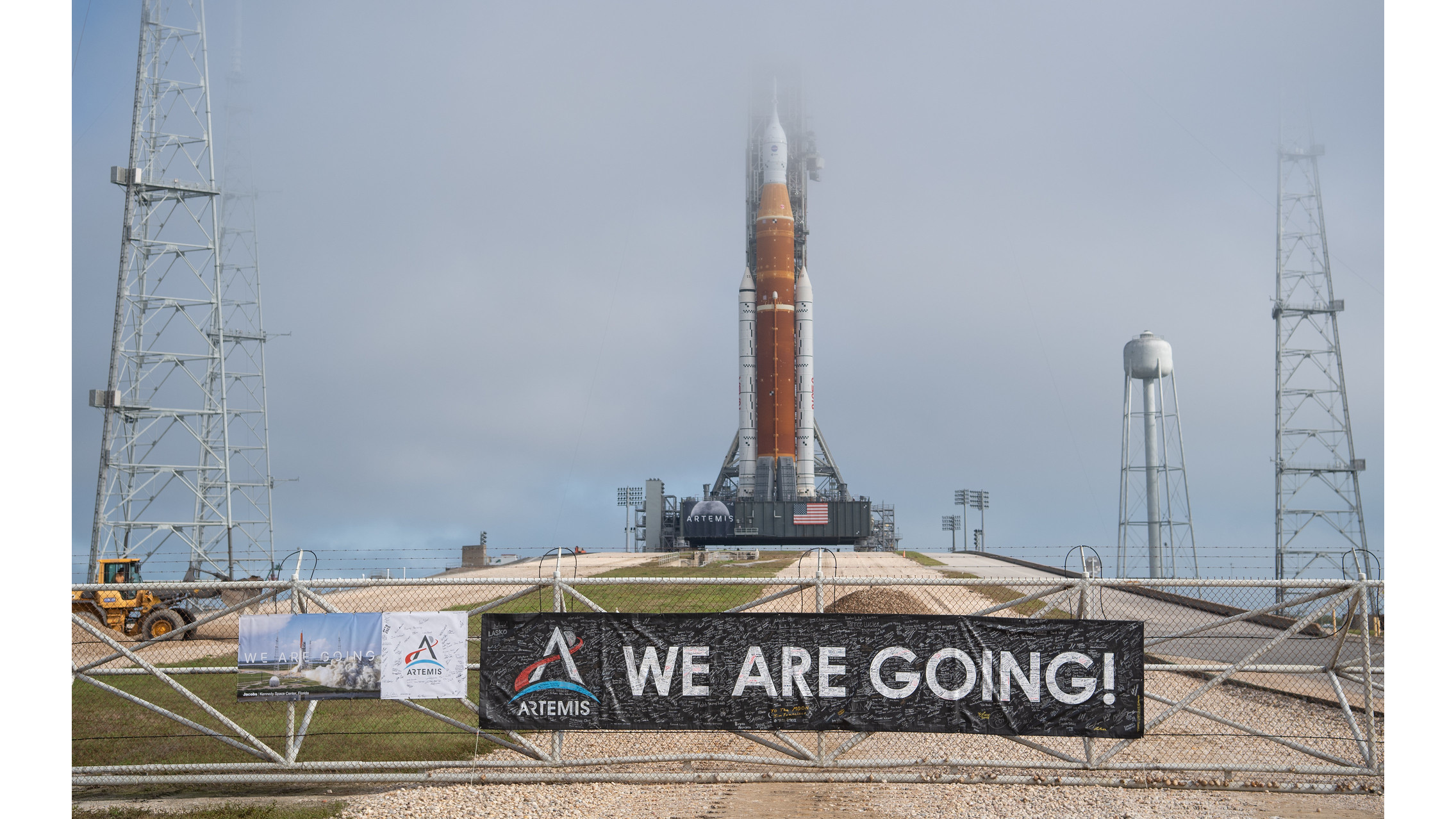
Overnight from Tuesday to Wednesday (April 12 to April 13), the Artemis 1 team powered up the core stage of the mission's huge Space Launch System rocket as well as its Orion spacecraft, NASA officials wrote in an update Wednesday.
This work is part of the Artemis 1 "wet dress rehearsal," a practice run of critical prelaunch procedures such as rocket fueling. The team remains on track to fill the tanks of the SLS core stage (but not the upper stage) on Thursday (April 14), as planned, agency officials said.
The wet dress is scheduled to wrap up on Thursday. If everything goes well, the Artemis 1 team will then proceed toward gearing up for the mission, which will launch an uncrewed Orion on a journey around the moon, perhaps as early as June.
Artemis 1 moon mission test runs into oxygen snag
NASA has continued its work testing hardware that will fly on the uncrewed Artemis 1 mission later this year. This morning, mission personnel worked to cool oxygen lines in preparation for fuel loading, but as liquid oxygen began flowing into the rocket, teams noticed that the temperature had crept too high and paused the test, which had been targeting a "launch" time of 3:57 p.m. EDT (1957 GMT).
"As teams began the liquid oxygen (LOX) slow fill, a temperature limit was exceeded," Jeremy Parsons, deputy manager of the Exploration Ground Systems team at Kennedy Space Center, wrote in a tweet. "Teams believe they understand the issue and are working a solution that will allow operations to resume. These are all important aspects of test conditions in complex environments."
Fueling underway for Artemis 1 moon rocket
NASA is proceeding with liquid oxygen fueling of the Artemis 1 moon rocket after temperature readings slowed their work earlier today.
"After troubleshooting an issue with the temperature of liquid oxygen during early stages of propellant loading into the rocket’s core stage, launch controllers have resumed operations," NASA wrote in an update at 12:25 pm ET. "Teams performed chill down operations again before liquid oxygen began flowing into the tank and adjusted pump speeds as necessary during flow to help ensure temperatures remain below limits. They also opened valves to bleed off any warm liquid oxygen."
NASA has also begun filling the Artemis 1 core stage with the super-cold liquid hydrogen propellant the rocket will use, in all, Artemis 1's Space Launch System rocket will use 537,000 gallons of propellant during its launch to the moon. -- Tariq Malik
NASA pauses fueling of Artemis 1 moon rocket
NASA has paused the fueling of the Artemis 1 mission's Space Launch System (SLS) rocket after encountering an issue during a "fast fill" of liquid hydrogen, or LH2.
"After fast fill on LH2 began, a surge in pressure automatically stopped the flow of liquid hydrogen," agency officials wrote in an update at 2:10 p.m. EDT (1810 GMT) today (April 14). "Teams are working to troubleshoot this issue and the rocket is in a safe configuration. In the meantime, liquid oxygen flow was paused on the core stage to ensure the tanking operations for LOX and LH2 remain synchronized."
LOX, or liquid oxygen, is the other propellant for the SLS.
These operations are part of the Artemis 1 wet dress rehearsal, a crucial series of prelaunch tests that began on Tuesday (April 12) and are slated to wrap up this afternoon. Keep checking back here for more updates about the test.
NASA halts 3rd attempt at fueling Artemis 1 moon rocket
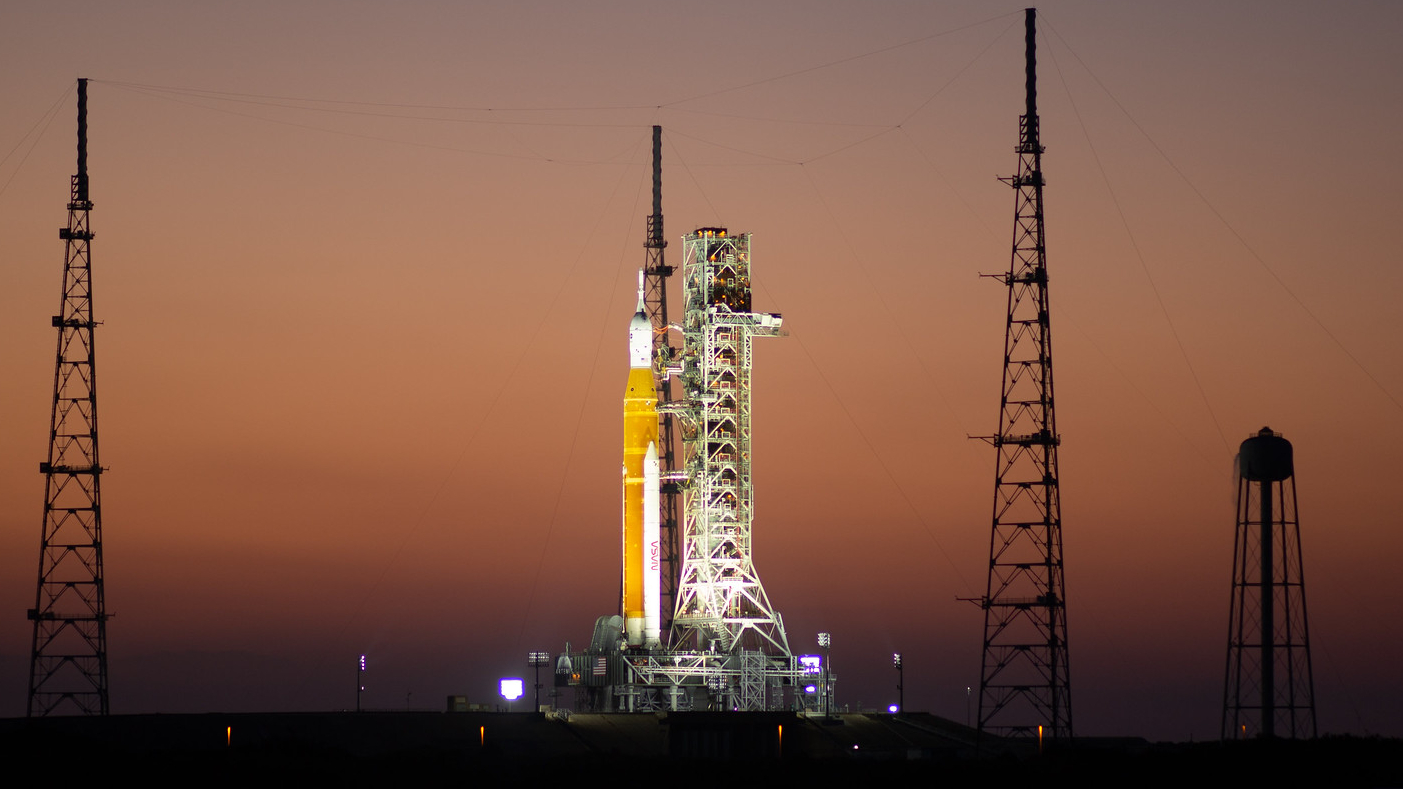
NASA did not finish fueling the core stage of the Artemis 1 moon mission's Space Launch System (SLS) rocket as planned today (April 14), calling it off after noticing a leak of liquid hydrogen. Read our full story here.
It was the agency's third attempt at SLS propellant loading, one of the most important parts of the Artemis 1 prelaunch "wet dress rehearsal." Technical issues scuttled the first two tries as well. It's unclear when the Artemis 1 team will resume the multi-day test, and which procedures they still want to do; we'll have to stay tuned for updates, which NASA officials said will be coming shortly.
Artemis 1 stack rolls off launch pad
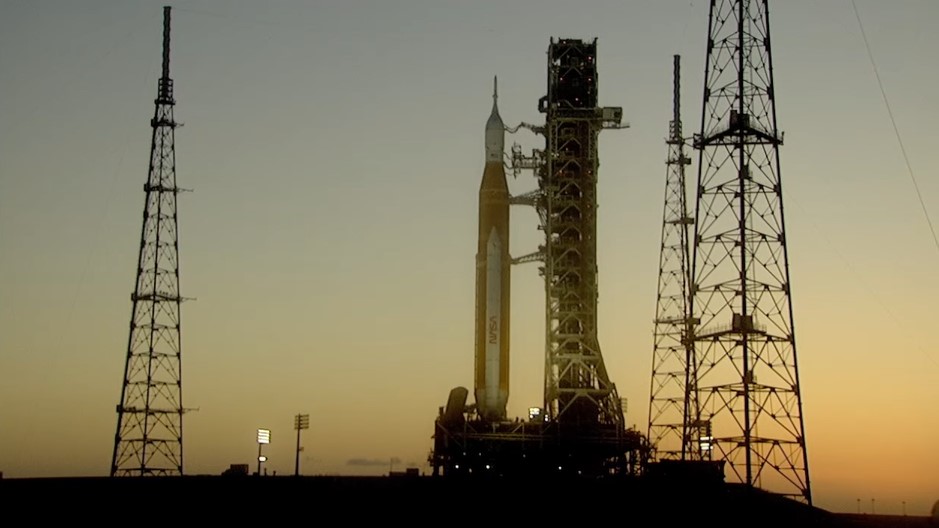
NASA began rolling its Artemis 1 moon mission off Pad 39B at NASA's Kennedy Space Center (KSC) in Florida this afternoon (April 25). The Space Launch System rocket and Orion capsule that will fly Artemis 1 are on their way back to KSC's Vehicle Assembly Building, where team members will address a few issues identified during the Artemis 1 "wet dress rehearsal" earlier this month.
The 4-mile (6.4 kilometers) journey to the VAB is expected to take 8 to 12 hours, NASA officials said.
Artemis 1's second rollout is underway
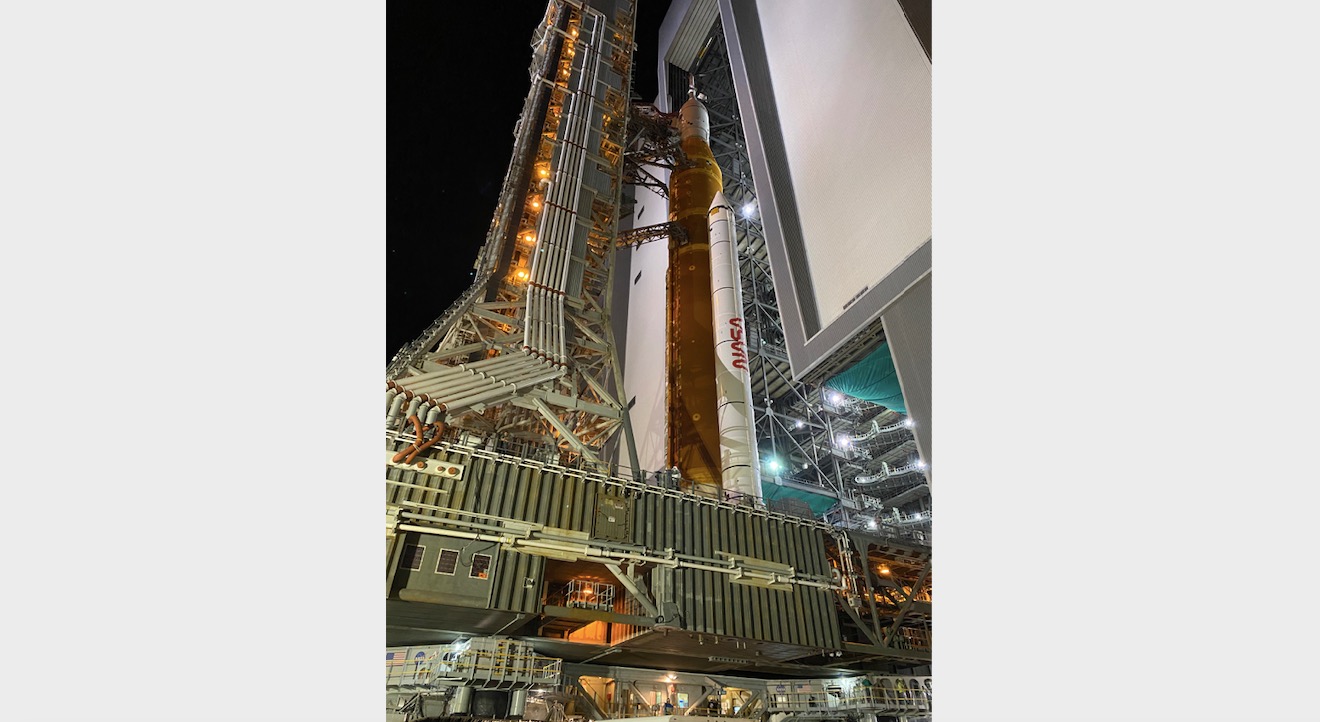
NASA's Artemis 1 moon mission is on the move again. The Artemis 1 Space Launch System (SLS) rocket and Orion capsule left the Vehicle Assembly Building (VAB) at NASA's Kennedy Space Center (KSC) a little after midnight EDT (0400 GMT) on June 6, heading for KSC's Pad 39B. The roughly 4-mile (6.4 kilometers) trek is expected to take 8 to 12 hours. You can learn more in our rollout preview story.
Artemis 1 is headed to Pad 39B for a "wet dress rehearsal," a crucial series of tests that includes fueling of the SLS and the performance of several simulated launch countdowns. The 48-hour wet dress is expected to begin on June 19.
This is Artemis 1's second rollout ahead of a wet dress attempt. The stack first headed to Pad 39B in mid-March and initiated a wet dress on April 1. Artemis 1 ran into some technical troubles on that try, however, and rolled back to the VAB for maintenance work on April 25.
Back on the launch pad
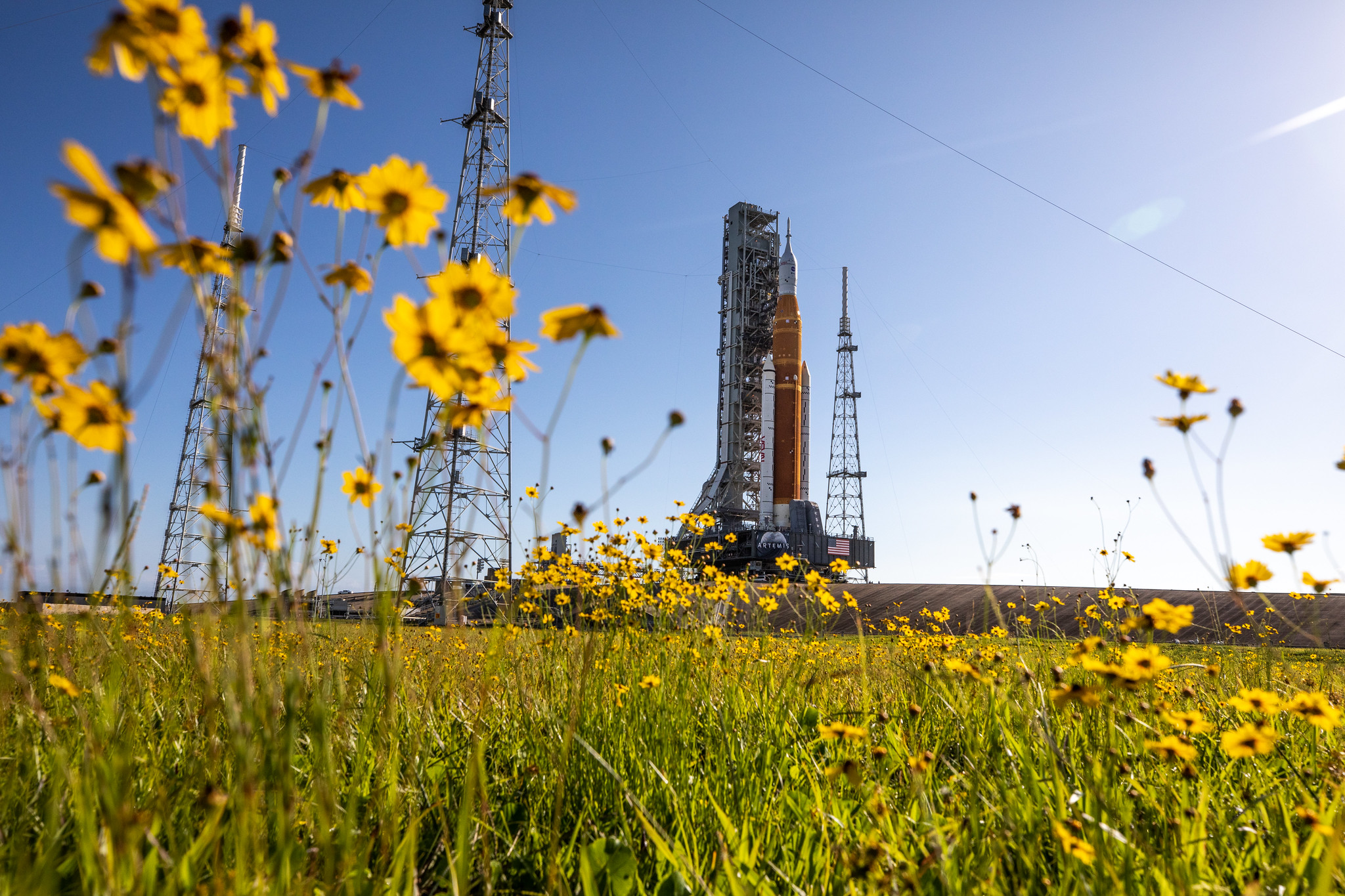
NASA's massive Artemis 1 rocket is back on the launch pad as of Monday (June 6) for a second try at what the agency calls a wet dress rehearsal. During that process, which will begin on June 19 and last about two days if all goes well, NASA personnel will fill the rocket and its launch infrastructure with more than 700,000 gallons (2.65 million liters) of cryogenic fuel, then conduct a series of countdown rehearsals, including practicing for holds and aborts.
This week's arrival marks the Artemis 1 rocket's second visit to launch pad 39B, after NASA attempted a wet dress rehearsal in April. Assuming the agency can complete the test, the rocket will roll back to the massive Vehicle Assembly Building one more time before launching on an uncrewed mission around the moon.
You can watch live footage of the rocket courtesy of NASA.
Wet dress rehearsal begins
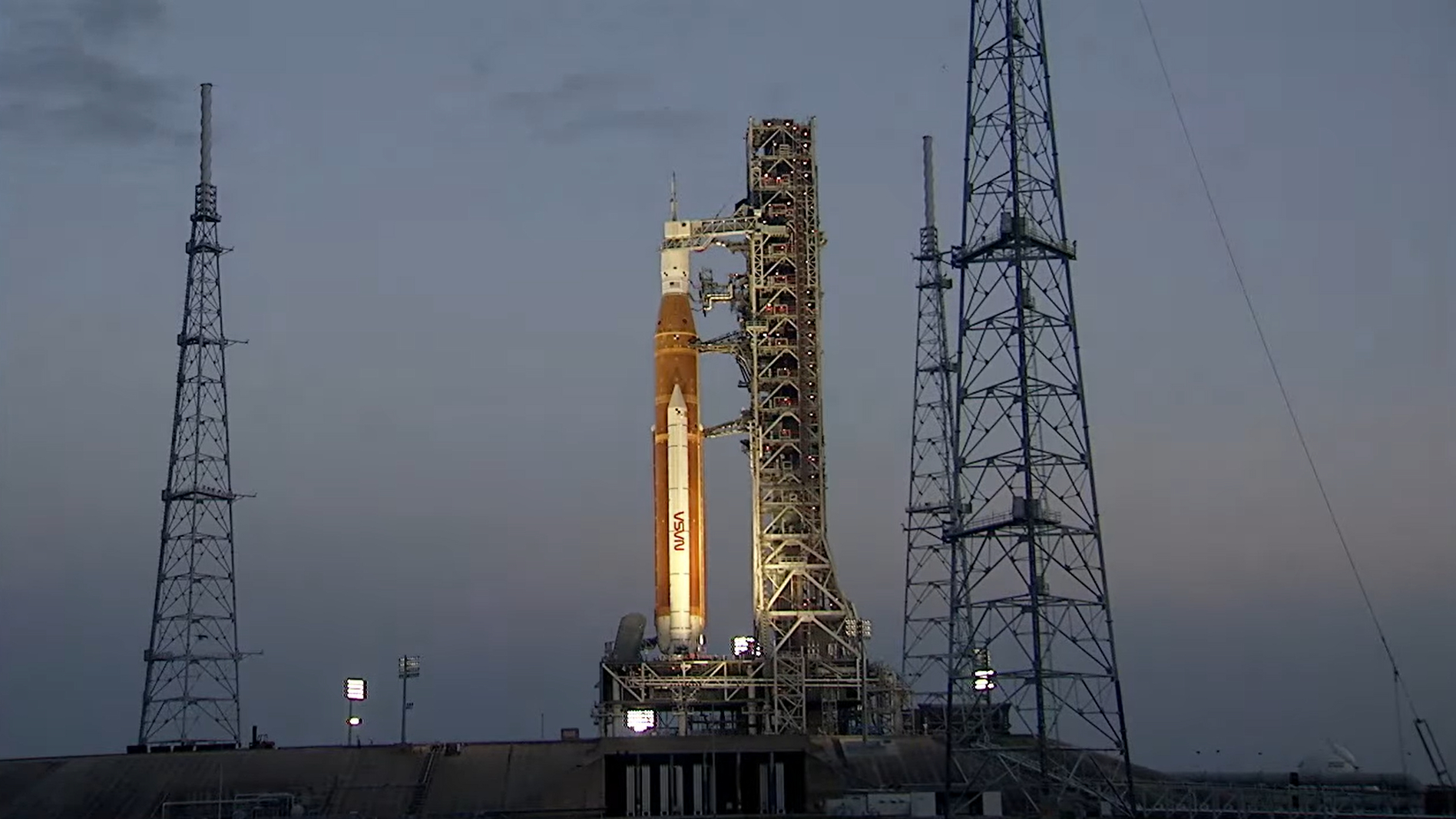
NASA's wet dress rehearsal of its Space Launch System rocket is expected to begin about now, at 5 p.m. EDT (2100 GMT). Under NASA's plan, the launch team will have their call to stations and the countdown will begin in one of the final major milestones before the moon-circling, uncrewed Artemis 1 can be cleared for launch.
NASA tried to perform the wet dress in early April, but had trouble fueling the SLS on three separate attempts. The Artemis stack was rolled back to KSC's Vehicle Assembly Building (VAB) in late April to address a hydrogen leak and other issues. The rocket is now back on the pad ready for a fresh try.
NASA is streaming live video of the rocket and spacecraft at Launch Pad 39B at the agency's Kennedy Space Center. Live commentary will be available on the agency’s website after tanking operations begin Monday (June 20).
The Artemis 1 stack — the SLS and an Orion crew capsule — will be vigorously tested over the next two days to assess its ability to perform a simulated launch countdown. NASA says these will be some of the milestones to look for:
Saturday, June 18, 5 p.m. EDT (2100 GMT) – L-45 hours, 40 minutes and counting
- The launch team arrives on their stations and the countdown begins (L-45, 40 minutes hours)
- Fill the water tank for the sound suppression system (L-45 hours)
- Orion spacecraft power up start (L-41 hours)
- SLS core stage is powered up (L-35 hours, 20 minutes)
- Final preparations of the four RS-25 engines complete (L-30 hours, 30 minutes)
Monday, June 20, 1:40 a.m. EDT (0540 GMT) – L-13 hours and counting
- The SLS interim cryogenic propulsion stage (ICPS) is powered up (L-12 hours, 50 minutes)
- All non-essential personnel leave Launch Complex 39B (L-12 hours)
Monday, June 20, 6 a.m. EDT (1000 GMT) – L-8 hours, 40 minutes and counting
- Built in countdown hold begins and lasts approximately 1.5 hours (L-8 hours, 40 minutes)
- The launch director and mission management team chair conduct a weather and tanking briefing (L-8 hours, 20 minutes)
- The launch director and mission management team chair decide if they are “go” or “no-go” to begin tanking the rocket (L-7 hours, 50 minutes)
Selected milestones after this point on Monday include:
- 7:35 a.m. EDT / 1135 GMT: Core stage liquid oxygen (LOX) chilldown start (L-7 hours, 05 minutes)
- 8:35 a.m. EDT /1235 GMT: Core stage liquid hydrogen (LH2) chilldown start (L-6 hours, 5 minutes)
- 10:10 a.m. EDT / 1410 GMT: Core stage LH2 topping start (L-4 hours, 30 minutes)
- 10:15 a.m. EDT / 1415 GMT: Core stage LH2 replenish start (L-4 hours 25 minutes)
- 10:20 a.m. EDT / 1420 GMT: Orion communications system activation start (L-4 hours, 20 minutes)
- 11:15 a.m. EDT / 1515 GMT: Core stage LOX topping start (L-3 hours, 25 minutes)
- 11:40 a.m. EDT / 1540 GMT: ICPS/SLS telemetry data verified with Mission Control Center and SLS Engineering Support Center (L-3 hours)
- 2 p.m. EDT / 1800 GMT: L-40 minutes and holding; final NASA test director briefing begins.
- 2:30 p.m. EDT / 1830 GMT: Wet Dress Rehearsal Run 1 begins
- 2:41 p.m. EDT / 1841 GMT: Wet Dress Rehearsal Run 1 ends
- 3:41 p.m. EDT / 1941 GMT (approximate): Wet Dress Rehearsal Run 2 begins
- 3:52 p.m. EDT / 1952 GMT (approximate): Wet Dress Rehearsal Run 2 ends
Wet dress rehearsal begins at 5:30 p.m. EDT
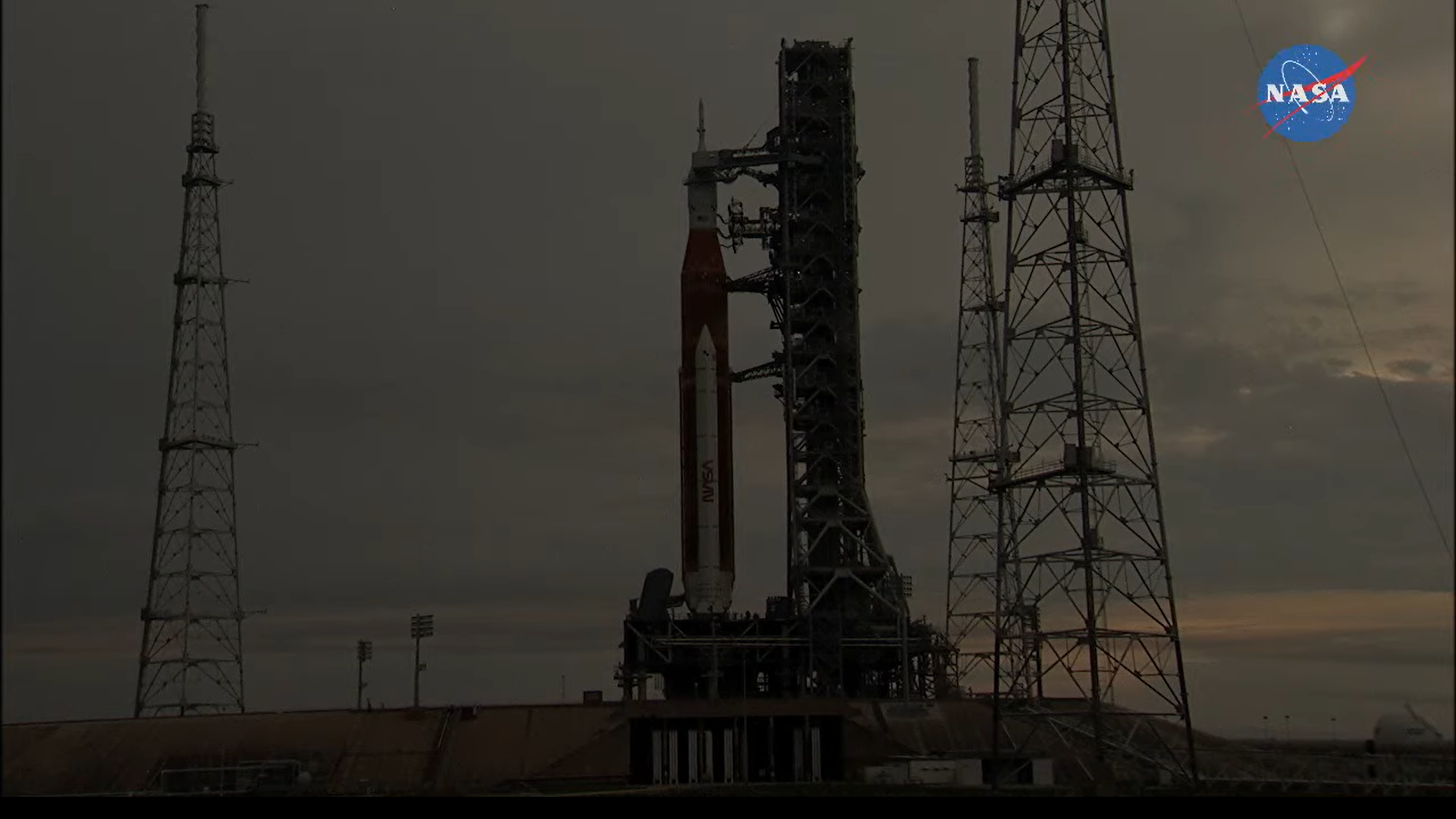
NASA confirmed in a blog post that the countdown for the wet dress rehearsal for Artemis 1 began at 5:30 p.m. EDT (2130 GMT) on Saturday (June 18), exactly on schedule.
The test will evaluate the stacked Artemis 1 system, meaning an Orion spacecraft and Space Launch System megarocket, in a simulated launch countdown test.
"Overnight, teams will power up the Orion spacecraft and the Space Launch System core stage and prepare the rocket’s four RS-25 engines, which will not be lit during the test," NASA said in the update, posted at 5:49 p.m. EDT (2149 GMT).
"Weather constraints for propellant loading operations planned for Monday stipulate there must be less than a 20 percent chance lightning within five nautical miles of pad during the first hour of tanking," the agency added. "Winds also must not be above 37.5 knots and the temperature cannot be below 41 degrees Fahrenheit [5 degrees Celsius.]"
NASA is continuing to provide live video of the rocket on the launch pad at the agency's Kennedy Space Center in Florida, although live commentary is not expected to begin until tanking operations commence on Monday (June 20).
The countdown has begun.The launch team arrived at their stations at 5pm ET for the #Artemis I wet dress rehearsal attempt. Tanking operations are set to begin on Monday, June 20: https://t.co/3HXuRpIjCP pic.twitter.com/KqW6c1EpxLJune 18, 2022
Wet dress rehearsal 'on track' as second day of test approaches
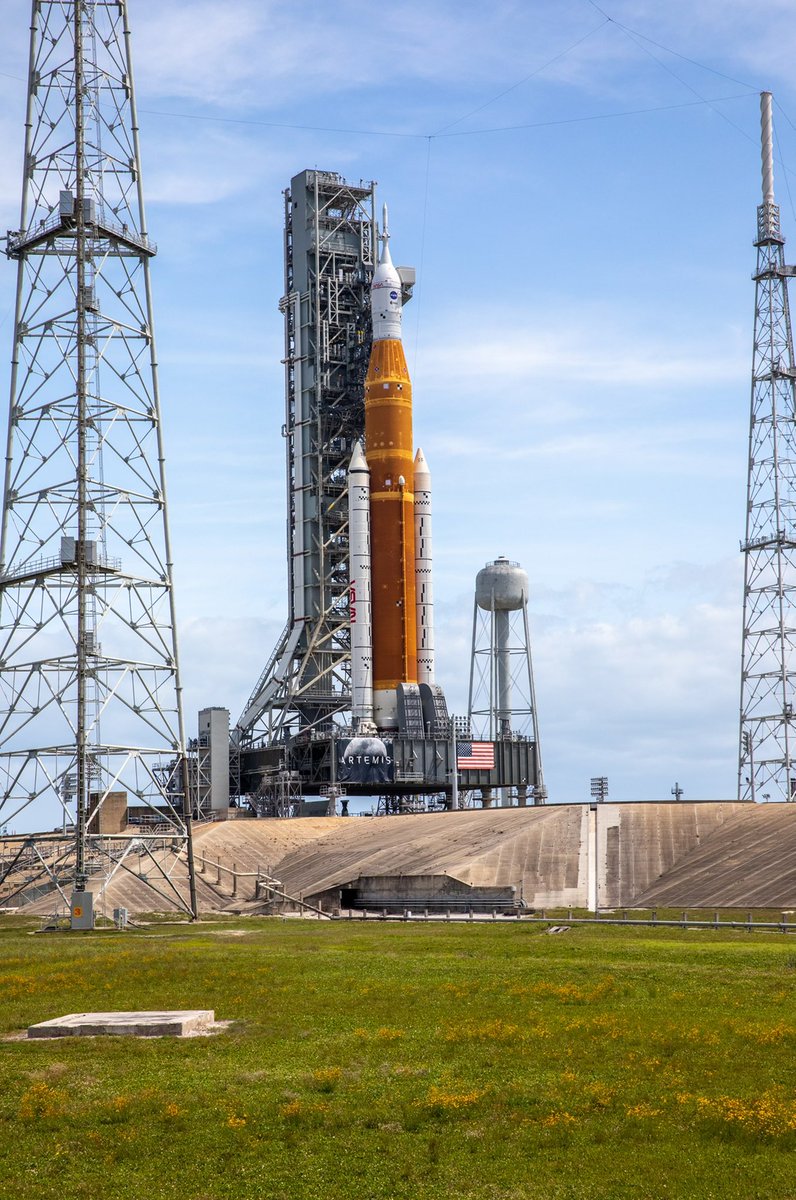
NASA says all Artemis 1 wet dress rehearsal operations are "on track" as the test approaches its second day of work later today, at 5 p.m. EDT (2200 GMT) Sunday.
NASA plans a routine mission management team meeting this afternoon EDT to review the status of rehearsal, the agency said in a blog post Sunday (June 19) at 10:48 a.m. EDT (1448 GMT). The wet dress rehearsal is a key step in getting Artemis 1 ready for its uncrewed round-the-moon test, which may launch later in 2022.
"Overnight, engineers powered up the Orion spacecraft and the Space Launch System's core stage," the agency stated in the blog post. "Teams also configured several systems on the ground, rocket, and spacecraft and performed activities to prepare umbilicals that connect the rocket and spacecraft to the mobile launcher and are used to provide power, communications, coolant, and propellant."
The Twitter feed for NASA's Kennedy Space Center, where the test is taking place at Launch Pad 39B, confirmed at 11:26 a.m. EDT (1526 GMT) that tanking operations remain scheduled for tomorrow (Monday, June 20).
The agency plans to provide live commentary Monday during tanking operations. In the meantime, NASA is streaming live video of the rocket and spacecraft.
Artemis 1 'go' for tanking operations Monday
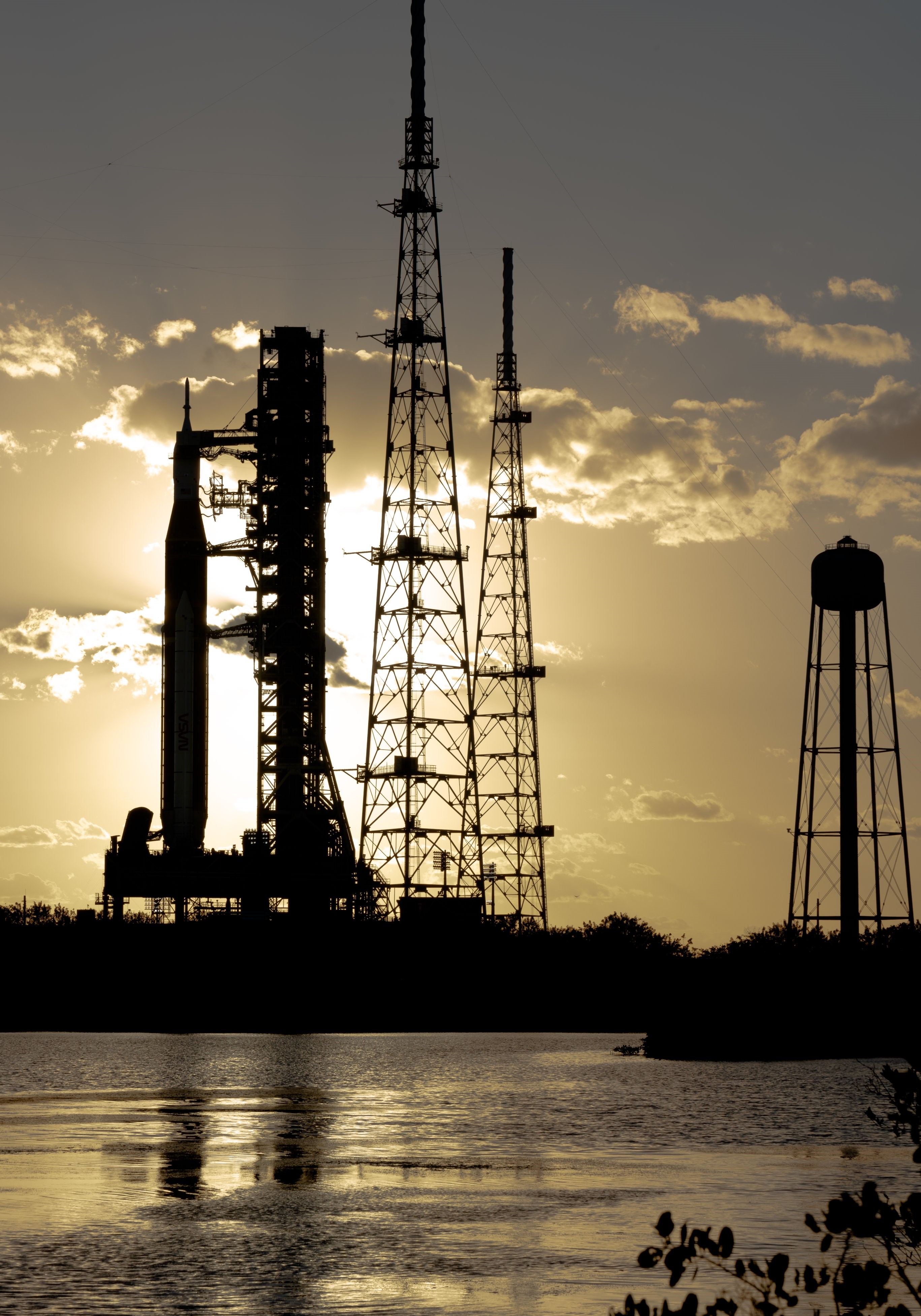
The Artemis 1 stack is "go" to proceed with the terminal countdown of the wet dress rehearsal on Monday (June 20), NASA officials said in a blog post.
The countdown would allow the stacked Space Launch System rocket and Orion spacecraft to practice a launch on the ground prior to doing it for real, during a planned uncrewed round-the-moon test.
"Teams are performing a pre-launch walkdown of the rocket to ensure the Space Launch System is prepared for the upcoming propellant loading operations," the blog post stated at 4:57 p.m. EDT (2157 GMT) on Sunday (June 19).
"Later today, they [teams] will configure mobile launcher and pad facility systems and structures, and power up the interim cryogenic propulsion stage," added the blog post, which was published following a routine mission management team meeting earlier in the afternoon EDT.
Favorable weather conditions are expected for the countdown, NASA noted. For tanking to proceed, there must be less than a 20% chance of lightning within 5 nautical miles (5.8 miles or 9.3 km) of Launch Pad 39B at NASA's Kennedy Space Center in Florida, where the rehearsal is taking place.
Additionally, winds must be lower than 37.5 knots (43.1 mph or 69.5 km/h) and the temperature must be above 41 degrees Fahrenheit (5 degrees Celsius), the agency stated.
Another mission management team meeting is expected Monday at 6 a.m. EDT (1000 GMT) "to assess operations and determine whether to proceed with tanking operations," NASA said. That milestone will be L-8 hours, 40 minutes in the countdown and the meeting will take place at the start of a planned 90-minute hold.
After today’s mission management team meeting progress continues ahead towards terminal count. Weather is still a go for #Artemis I wet dress rehearsal. Meteorologists predict favorable weather for tanking on June 20. Read more here: https://t.co/zgoL2CnoXa pic.twitter.com/nmBkAPSA24June 19, 2022
NASA begins Artemis 1 tanking livestream
NASA has just begun the livestream of the Artemis 1 tanking operations, in anticipation that the wet dress rehearsal will start later today (Monday, June 20). You can watch the livestream above, on NASA's YouTube channel and on NASA's website.
"We are good to go for tanking, in terms of the weather," the broadcast said at 7:12 a.m. EDT (1112 GMT). For example, the weather officer says probability of precipitation is 20%, and lightning is 10%. This forecast is valid until about 2:40 p.m. EDT (1840 GMT), agency officials said on the broadcast.
Updates will be provided every half-hour at the least during the broadcast, which will extend through much of Monday if operations go to plan. The agency said the launch team is working a "few issues", but provided no further detail as of 7:15 a.m. EDT (1115 GMT).
"The team powered up ICPS [interim cryogenic propulsion system] overnight, and just finished their morning prep meeting before we proceed with the test," said Jim Free, associate administrator for NASA's exploration systems development mission directorate, on Twitter at 6:52 a.m. EDT (1052 GMT).
NASA extends hold to examine backup nitrogen issue
NASA has extended its hold of the Artemis 1 tanking operations, which was supposed to conclude at 7:30 a.m. EDT (1130 GMT), due to an issue with a backup supply of gaseous nitrogen, the agency said on its broadcast.
"The primary supply is good. It's the backup supply issue for the controller for the supply valve, and so the launch team is currently working on that issue," Derrol Nail of NASA communications said during the live broadcast a few minutes ago.
"Until they do until find a resolution, the launch team has decided to hold off on cryo loading until they have a better understanding of what is required for that repair."
Problems with gaseous nitrogen supply, used to support activities at the pad, had delayed previous countdown rehearsals, although it was liquid hydrogen and liquid oxygen issues that ended up being the main issue during past tests.
NASA recently upgraded its infrastructure at Pad 39B at the agency's Kennedy Space Center to increase storage facilities for gaseous nitrogen. Engineers performed this work ahead of schedule after Artemis 1 was rolled back to the Vehicle Assembly Building in April to address its tanking issues during previous rehearsals.
Nitrogen is used during testing, along with hydrogen, helium and air, in test stands provided by NASA's High Pressure Gas Facility, according to agency materials. Gaseous nitrogen is used to purge oxygen from the SLS prior to fueling operations, for safety purposes, during wet dress and launch, NASA said during previous tests.
Under the nominal schedule, the terminal countdown is supposed to proceed at 2:30 p.m. EDT (1830 GMT), but Nail said it is likely that countdown will be delayed due to the issue.
NASA proceeds with tanking while working backup issue
NASA officials have decided to "press" towards tanking operations while attempting to address a backup supply issue of gaseous nitrogen in parallel, a live broadcast for the Artemis 1 wet dress rehearsal stated around 7:40 a.m. EDT (1140 GMT).
The primary supply for gaseous nitrogen is working well, but the backup remains at issue.
An update from engineering teams is expected in about 45 minutes on how operations are going, NASA communications official Derrol Nail said during the broadcast. He noted nitrogen is used to prevent buildup of gases, along with keeping avionics and electronics in the engine section dry, among other purposes.
"Gaseous nitrogen is critical to get started with tanking," Nail said.
NASA repairs backup valve for gaseous nitrogen
Engineers have repaired a valve for the backup gaseous nitrogen line, NASA's Exploration Ground Systems stated on Twitter at 7:45 a.m. EDT (1145 GMT).
"The launch team is assessing next steps and continue to be in an extended hold," agency officials tweeted.
A planned hold during the wet dress rehearsal was supposed to conclude at 7:30 a.m. EDT (1130 GMT), but the backup supply issue forced a pause in returning to the countdown.
The primary supply of gaseous nitrogen, required to purge harmful gases from the Space Launch System megarocket during tanking, remains operational.
UPDATE: A valve for the redundant gaseous nitrogen (GN2) line has now been repaired. The launch team is assessing next steps and continue to be in an extended hold. Stay tuned to https://t.co/6CWuCVIE53 for ongoing updates.June 20, 2022
Backup gaseous nitrogen line troubleshooting continues
Artemis 1 wet dress rehearsal teams have successfully replaced a gaseous nitrogen valve on a backup line that forced an extension of a launch hold past 7:30 a.m. EDT (1130 GMT), NASA officials said during a live update at 8:00 a.m. EDT (1200 GMT).
"It would not close," NASA's Derrol Nail, a communications representative, said during a broadcast on NASA Television. "Not sure about what caused the failure at this time, but the teams have been working on it and have replaced the valve. The manual retest of that valve is working well, according to the team that's out there."
Teams are now focused on an automatic controller for the backup gaseous nitrogen line, performing tests to see if that will work properly, Nail said. Provided they get the controller working, engineers have also decided to move the troublesome gaseous nitrogen as the primary source for the rocket's test. (There are two sources; it was the redundant one causing issues, but the prime one was working just fine.)
"The launch team, meanwhile, has been moving forward configuring the launch vehicle for tanking," Nail continued. "They have cycled the valves for liquid oxygen tank in the upper stage, and then began proceeding with cycling the valves on the liquid oxygen stage."
NASA is providing updates approximately every half hour on its live broadcast as tanking operations continue for the wet dress rehearsal, which may take place later today (Monday) if all goes to plan. Exact rescheduled timing for testing procedures have not been released yet, as the troubleshooting is ongoing; the nominal plan had put the first expected terminal countdown at 2:30 p.m. EDT (1830 GMT).
NASA resets terminal countdown to 4:20 p.m. EDT
NASA expects to bring Artemis 1s wet dress rehearsal out of its extended hold at 9:20 a.m. EDT (1320 GMT) after engineers successfully addressed issues with a valve and automatic controller on a backup gaseous nitrogen system.
As planned, the backup gaseous nitrogen system will now be swapped with the primary, meaning the backup will be used as the source to purge harmful gases throughout the tests, NASA's Derrol Nail said during a livestreamed update at 8:30 a.m. EDT (1230 GMT) on NASA Television.
Should the countdown go to plan, the terminal countdown will start at 4:20 p.m. EDT (2020 GMT) and conclude at 4:30 p.m. EDT, roughly two hours later than scheduled.
Weather is expected to hold into that period, Nail said. "Some showers could develop around the pad in the early afternoon, but they're expected to move west. Tanking, therefore, in the weather forecasts for taking is go," he added.
Launch director gives 'go' for cryogenic tanking
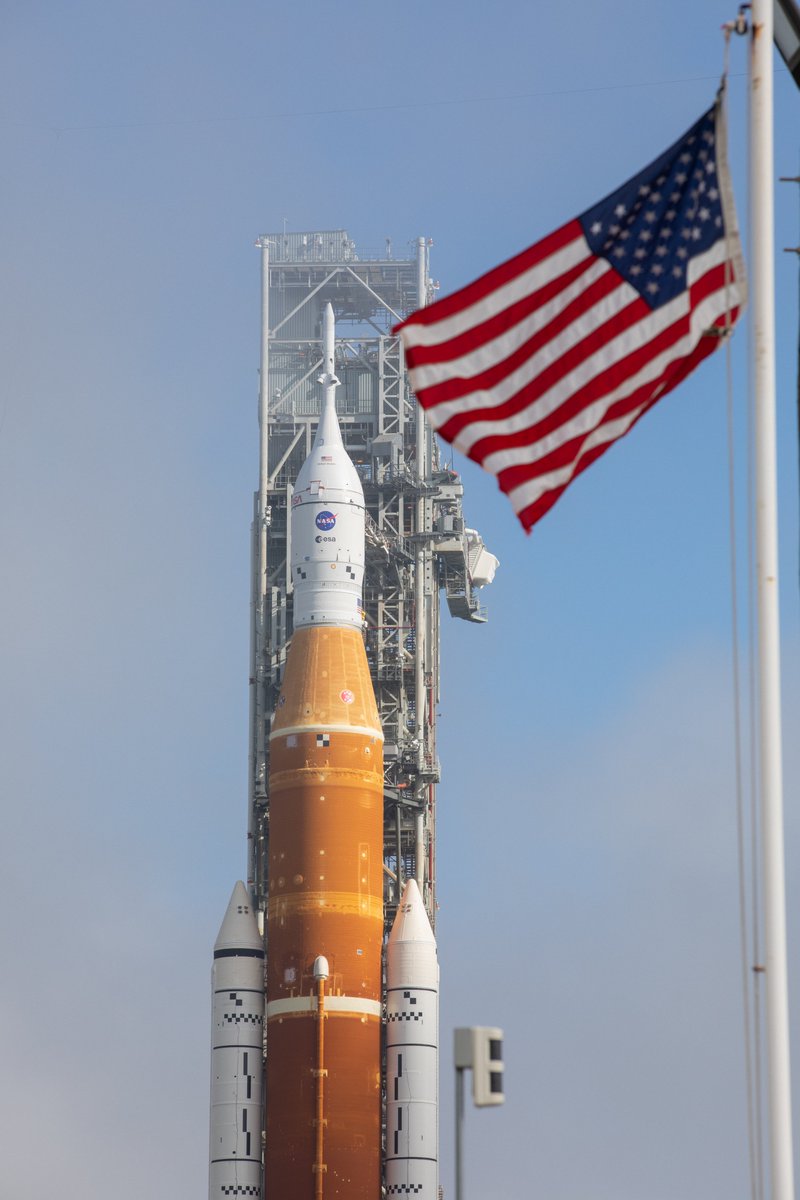
NASA launch director Charlie Blackwell-Thompson gave the "go" for cryogenic tanking to begin on the Artemis 1 wet dress rehearsal, according to a livestreamed update on NASA Television shortly before 9 a.m. EDT (1300 GMT).
The cryogenic cooling was expected to begin at 9:05 a.m. EDT (1305 GMT) as NASA officials proceed with the test, which is a key milestone in assessing the Space Launch System megarocket and Orion spacecraft for their readiness to perform a round-the-moon mission.
Jeremy Graeber, assistant launch director, told listeners on NASA Television that the gaseous nitrogen issue holding up tanking operations earlier in the morning EDT has been resolved. Both the gaseous nitrogen valve and the controller, which had been troublesome, are now working properly following previously disclosed engineering fixes.
"The team did a great job identifying the problem and resolving it, and so we're in really good shape," Graeber said. "That problem has been cleared and we're at a good configuration to pick up with cryo loading [and] no longer constrained."
Engineers have also picked up an issue with the left solid rocket booster, showing that the resistance was lower than expected, Graeber said. But given the consistent history of the booster's performance, the teams decided to proceed and not to declare it a constraint to the wet dress rehearsal.
The resistance test was showing a value of 22.4, compared to a nominal reading of between 24.4 and 37.4, Graeber said.
"The value we're seeing now is consistent with what we've been seeing over the last several weeks," he added. "So although it is outside of our nominal range, we understand that it's consistently here. So we believe that's a valid number."
Weather is predicted to remain good for tanking operations despite T-0 (the simulated liftoff) being pushed back about two hours to 4:30 p.m. EDT (2030 GMT), Graeber added.
We are “GO” to begin tanking of the @NASA_SLS rocket as part of the #Artemis I wet dress rehearsal test.Watch our live feed for updates throughout the day: https://t.co/1XQVlkaW6V pic.twitter.com/7ZEKqt6vYqJune 20, 2022
New eight-minute delay in exiting the hold
NASA expects to exit the lengthened test hold eight minutes later than expected. The new exit time will be 9:28 a.m. EDT (1328 GMT), allowing Artemis 1 wet dress rehearsal operations to proceed, agency officials said during an update on NASA Television.
"The team is configuring the launch vehicle to get ready for cryogenic tanking," agency spokesperson Derrol Nail said during the update, delivered around 9:20 a.m. EDT (1320 GMT).
The hold was lengthened about two hours beyond its expected conclusion at 7:30 a.m. EDT (1130 GMT) due to issues with a backup gaseous nitrogen line, issues which all appear to be resolved now. The nitrogen is required to purge harmful gases during tanking, among other uses.
Should the tanking proceed to plan after this point, the new T-0 (simulated liftoff) would be at 4:38 p.m. EDT (2038 GMT), Nail added during the update.
Tanking ongoing for Artemis 1 wet dress rehearsal
NASA has confirmed tanking is ongoing during the Artemis 1 wet dress rehearsal on NASA Television, its Artemis blog and a tweet from the Exploration Ground Systems account, embedded below.
"The process for filling the core stage tank begins with the chill down, or cooling, of the propellant lines to load the liquid oxygen and liquid hydrogen in preparation for tanking," NASA officials said in the blog post, published Monday (June 20) at 9:38 a.m. EDT (1338 GMT).
"The team will slowly fill liquid oxygen into the core stage tank with the fast fill beginning soon after," the post added. "Teams will then proceed to slowly fill the core stage’s liquid hydrogen tank, followed by fast fill."
Tanking has begun with chilling down the liquid oxygen propellant lines for core stage. In sequential fashion, liquid oxygen and liquid hydrogen will flow into the rocket’s core stage and interim cryogenic propulsion stage tanks and be topped off as some propellant boils off.June 20, 2022
Core stage liquid oxygen enters 'slow fill'
The liquid oxygen for the Space Launch System's core stage has entered the "slow fill" part of the tanking process after chilling of the oxygen to cryogenic temperatures completed, according to an announcement from NASA Television.
"Core stage LOX [liquid oxygen] chilldown ... is complete and the team has now begun slow fill of liquid oxygen into the tank," NASA's Exploration Ground Systems account confirmed on Twitter at 10:08 a.m. EDT (1408 GMT).
The slow fill will take about two hours and 40 minutes to complete, which will be the longest process during wet dress rehearsal operations. Chilling for liquid hydrogen will begin in less than 10 minutes, spokesperson Derrol Nail said on NASA Television at 10:12 a.m. EDT (1412 GMT).
UPDATE: Core stage LOX chilldown of @NASA_SLS is complete and the team has now begun slow fill of liquid oxygen into the tank.June 20, 2022
Core stage liquid oxygen enters 'fast fill'
Liquid oxygen is now proceeding at a fast fill in preparation for Artemis 1 wet dress rehearsal operations, according to a NASA Television update and a brief tweet from the agency's Exploration Ground Systems account.
NASA gives 'go' for liquid hydrogen tank filling
Engineers have a "go" to proceed for liquid hydrogen tank filling, NASA Television said in an update Monday (June 20) around 10:30 a.m. EDT (1430 GMT).
The milestone was confirmed on the agency's Exploration Ground Systems Twitter account at 10:33 a.m. EDT (1433 GMT).
"This is a major milestone," spokesperson Derrol Nail said on NASA TV. "As you may recall from previous wet dress rehearsals, there was a leak ...the umbilical leak was fixed, so this is a big moment for the team."
NASA had made multiple attempts to perform the wet dress rehearsal in April, but ultimately pulled the Space Launch System and Orion spacecraft stack back to NASA's Kennedy Space Center's Vehicle Assembly Building to address the hydrogen leak issue.
Tanking operations are ongoing. Liquid oxygen entered a "fast fill" phase earlier in the hour, and liquid hydrogen lines are now being pre-chilled in preparation for tanking.
UPDATE: We have now entered chilldown of the @NASA_SLS liquid hydrogen transfer line.🚀 Check out our clickable rocket to explore it's tanks here: https://t.co/EVroYXvGoWJune 20, 2022
Artemis 1 begins slow fill of hydrogen
NASA has given the go for Artemis 1 to begin "slow fill" of liquid hydrogen in preparation for the wet dress rehearsal, the agency said on NASA Television Monday (June 20) around 10:42 a.m. EDT (1442 GMT).
Liquid hydrogen will then be authorized for a "fast fill", providing that tanking operations proceed as planned. The milestone was confirmed on the agency's Exploration Ground Systems Twitter account in a brief tweet.
"The reason for that [slow fill] is to properly condition the vehicle," spokesperson Derrol Nail said on NASA Television. "The engineers are trying to prevent thermal shock to the system by flowing too much super-chilled propellant too fast."
Artemis 1 teams adjust liquid oxygen and hydrogen flow
Liquid hydrogen is now flowing during the Artemis 1 wet dress rehearsal, NASA officials said around 11:10 a.m. EDT (1500 GMT) on Monday (June 20), confirming that announcement in an agency tweet.
As liquid hydrogen tanking proceeds in the Space Launch System megarocket, the hydrogen's flow rate will be slightly accelerated in light of liquid oxygen tanking operations, which have been ongoing for about an hour.
The liquid hydrogen team anticipates they will slightly accelerate their flow of gas, while the liquid oxygen team plans to slow down their rate, NASA spokesperson Derrol Nail said during a NASA Television update.
That's because liquid hydrogen must be filled up to at least 5% in the SLS tank before liquid oxygen loading is authorized beyond 49% levels, Nail said. (Current levels are at 15% for liquid oxygen, he noted, so slowing down the oxygen flow is a precaution.)
Teams appear to be carefully adjusting these oxygen-hydrogen flows to reduce loads on the SLS during tanking, although NASA Television did not directly confirm that. The procedure is called an "aft strut constraint." The SLS has four struts securing the core stage to the boosters when the megarocket is stacked on the mobile launcher, according to NASA documentation.
Liquid hydrogen enters 'fast fill'
Liquid hydrogen tanking is now entering a 'fast fill' phase as engineering teams work to get the Space Launch System megarocket tanked for the wet dress rehearsal of Artemis 1 later today, NASA officials said in an update around 11:30 a.m. EDT (1530 GMT).
Liquid oxygen and liquid hydrogen are being tanked at the same time, but the flows on each gas are being adjusted. Hydrogen is flowing a bit faster and oxygen is flowing a bit slower, explained spokesperson Derrol Nail in the update on NASA Television.
The aim is to avoid an "aft strut constraint", Nail said. Aft struts are horizontal attachment points between the solid rocket boosters on either side of the core stage of SLS.
"The vehicle moves during fueling. It's very much alive. As the super-chilled propellants go into that tank, it [the vehicle] becomes heavier," Nail said.
The metal on the tanks also shrinks slightly due to the cryogenic temperatures of the hydrogen and oxygen, he added. "For that reason, the propellants are put in in proportion to each other."
The liquid hydrogen tank, at 537,000 gallons (2.4 million liters), is expected to finish before the liquid oxygen tank at 196,000 gallons (roughly 740,000 liters), Nail said. Liquid hydrogen is much less dense than liquid oxygen.
The oxygen tank is roughly 38% filled as of the update time, while the hydrogen tank stands at less than 5%; the oxygen tank is not allowed to exceed 49% filled until the hydrogen tank gets to at least 5%, according to NASA.
Artemis 1 'go' in prep for liquid hydrogen tanking
Engineers just received the "go" to prepare the upper stage of the Space Launch System (SLS) for liquid hydrogen tanking, beginning with a helium purge, according to NASA Television.
Liquid oxygen and hydrogen beyond 50% filled
Liquid hydrogen and liquid oxygen levels are beyond half filled, NASA said in an update around 12:15 p.m. EDT (1715 GMT). Liquid hydrogen in the Space Launch System megabooster core stage is at 67% full, while liquid hydrogen at 63%.
Engineers are also preparing the upper stage of the rocket for fueling, which will go much faster than the core stage, according to NASA Television spokesperson Derrol Nail.
T-0 on the simulated countdown is still expected at 4:38 p.m. EDT (2038 GMT), following now resolved delays from early in the morning EDT. You can listen in live on NASA's website.
Liquid hydrogen reaches 'topping' stage
With the core stage hydrogen tank at 98% full, the tank is now in "topping" procedures to make sure the liquid gas is fully ready for the wet dress rehearsal in the coming hours, NASA Television said in an update at 12:35 p.m. EDT (1635 GMT).
The liquid oxygen tank in the core stage is at 76% full, and all operations are still proceeding to a T-0 in the wet dress rehearsal test at 4:38 p.m. EDT (2038 GMT).
Core stage almost completed on tanking; upper stage 'a little behind'
The core stage of the Space Launch System is almost completed tanking. Liquid hydrogen is fully tanked, while liquid oxygen is at 90%, NASA spokesperson Derrol Nail said during a Monday (June 20) update at 1 p.m. EDT (1700 GMT) on NASA Television.
The upper stage entered chilldown of its gas lines at 1:03 p.m. EDT (1703 GMT) to prepare it for entry of the cryogenic gas, Nail added.
"We're running a little behind on the tanking for the upper stage, probably about a half hour or so," Nail added. "Tweaking of an upper stage skid took a little longer than expected."
So far, the T-0 in the wet dress rehearsal countdown remains at 4:38 p.m. EDT (2038 GMT) following now-resolved delays from early in the morning EDT. Preparations for the test have been running for nearly two days since a call to stations at 5 p.m. EDT (2100 GMT) on Saturday (June 18).
Tanking graphic during Artemis 1 tanking
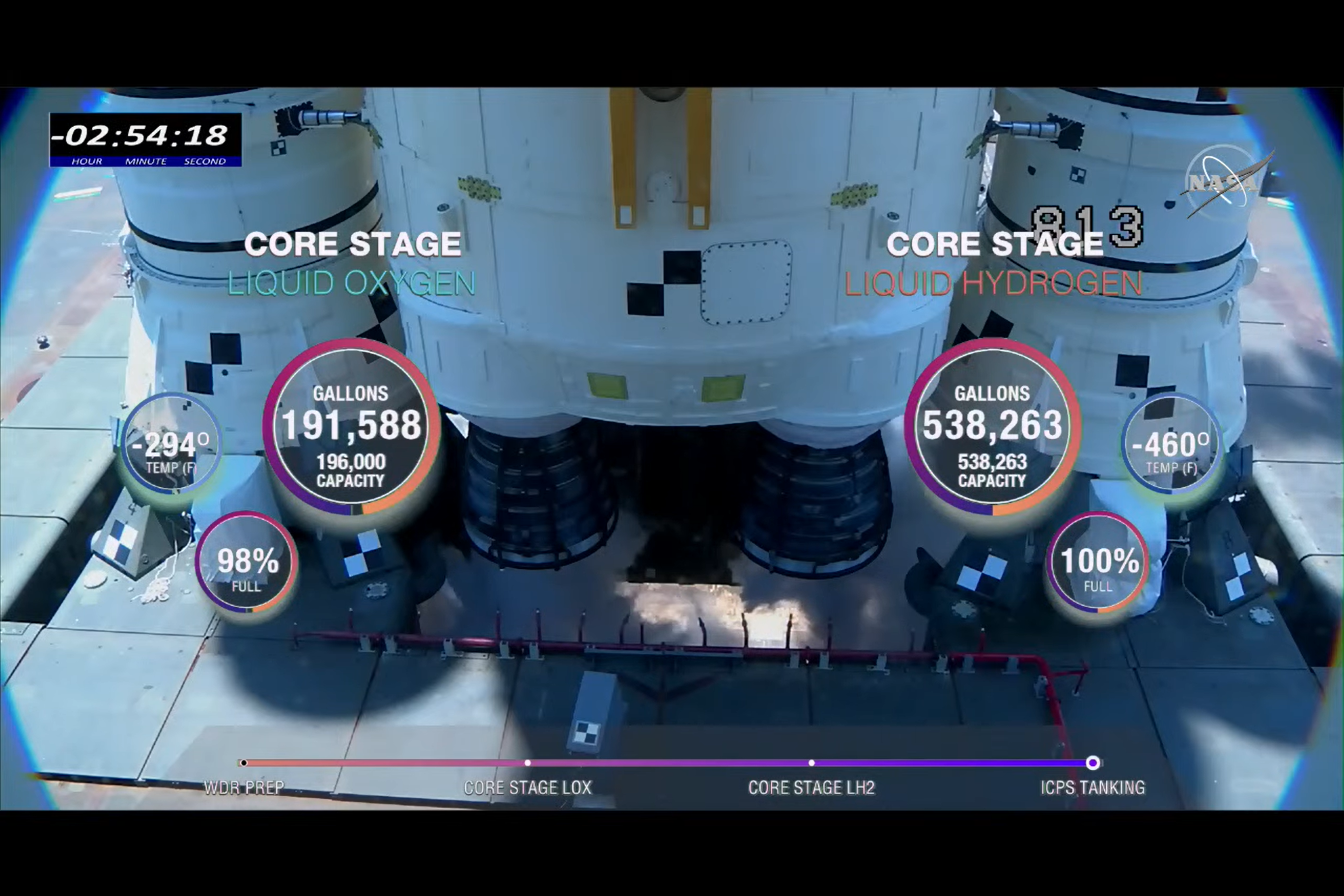
The above graphic was released on NASA Television at 1:15 p.m. EDT (1715 GMT) showing the progress of tanking operations in the Space Launch System's core stage. The rocket is being fueled during the wet dress rehearsal of Artemis 1, which is expected to wrap up later on Monday afternoon (June 20).
Update, 1:32 p.m. EDT / 1732 GMT: While saying the core stage is fully filled, NASA added that the graphic showed the incorrect temperature for the liquid hydrogen. The correct temperature should have read -423 degrees Fahrenheit (-253 degrees Celsius).
Hydrogen leak, grass fire discovered during Artemis 1 tanking
NASA says Artemis 1 teams are "working on an issue with the liquid hydrogen" during tanking operations of the core stage, among other issues.
"They are getting some data that says there's a leak, a liquid hydrogen leak, in the quick disconnect that takes the bleed for the engines," spokesperson Derrol Nail said on NASA Television around 2:07 p.m. EDT (1807 GMT).
"The team is currently evaluating that situation," Nail said. "Of course, any leak of liquid hydrogen is something ... to be concerned about for the launch team. This is a hazardous gas. They want to understand the situation fully before they take any action."
Nail added there are more issues forthcoming: there appears to have been a pressure limit exceeded during fueling in the liquid oxygen for the upper stage, and a small grass fire has emerged nearby the launch pad.
It is unclear what the grass fire was caused by, and agency officials have their cameras on the area to monitor the smoke coming out of the grass.
It is unclear what impacts these issues would have, if any, to the planned T-0 during the wet dress rehearsal, currently set for 4:38 p.m. EDT (2038 GMT).
Hydrogen leak troubleshooting ongoing during Artemis 1 tanking
Artemis 1 teams are currently troubleshooting the leak at the core stage quick disconnect.
"This includes manually configuring valves to reduce the pressure on the upper stage," spokesperson Derrol Nail said on NASA Television.
Whilst troubleshooting continues, there is no plan to intervene with the small grass fire that is burning near the hydrogen flare stack, according to Nail.
As the grass is burning towards a dirt road the belief by the launch team is that it will burn out once it gets to the road.
"It would be more risky to send a team out there to put it out," Nail said.
It is still unclear what impacts these issues would have, if any, on the planned T-0 during the wet dress rehearsal, currently set for 4:38 p.m. EDT (2038 GMT).
Teams at NASA's Kennedy Space Center in Florida continue troubleshooting the hydrogen leak at the core stage quick disconnect of the Space Launch System rocket, which stopped the fueling operation of the Artemis 1 wet dress rehearsal test earlier today.
Teams from Boeing as well as NASA are on site trying to seal the leak, hoping to be able to continue with the test, although it's unlikely that T-0 will occur at 4:38 p.m. EDT (2038 GMT) as still officially planned.
"Team is working to manually adjust the LOX pressure in upper stage to get back into tanking," NASA said on Twitter.
The fueling of the rocket's upper stage has been completed.
Three of four SLS propellant tanks now filled
Three of the four propellant tanks on the Artemis 1 Space Launch System rocket are now filled, and the fourth could be tanked up soon, NASA officials in a Twitter update this afternoon (June 20).
"Liquid oxygen is currently at fast fill for upper stage. Team is working a plan to reseal at the hydrogen leak," the tweet reads, in part. That leak was spotted earlier today at a "quick disconnect" on the SLS core stage.
NASA recalibrating new T-0 for Artemis 1 wet dress rehearsal
NASA is recalibrating the T-0 for its Artemis 1 wet dress rehearsal after failing in an attempt to fix a hydrogen leak in a "quick disconnect" line in the Space Launch System rocket's core stage, agency officials said in an update this afternoon (June 20).
Technicians tried warming up and then cooling down the quick disconnect, hoping that would reseat the hardware and seal the leak. But it didn't work, so Artemis 1 team members are "putting their heads together and seeing if they can come up with any other options to seal that leak," NASA spokesperson Derrol Nail said this afternoon during the agency's webcast of the wet dress rehearsal.
Nail added that the team is also trying to come up with a new T-0 , the milestone that will wrap up the wet dress rehearsal. The current T-0 is 4:38 p.m. EDT (2038 GMT), but it's been apparent for some time now that Artemis 1 would not hit that mark.
Artemis 1 team diagnoses hydrogen leak problem
The Artemis 1 team has determined that the hydrogen leak in one of the Space Launch System (SLS) rocket's "quick disconnect" lines resulted from a faulty seal on the rocket side of the cable, NASA officials said during an update this afternoon (June 20). The team is still working through its next steps and has not yet set a T-0 time that would mark the end of the "wet dress rehearsal" test of the Artemis 1 SLS and Orion capsule.
Artemis 1 moon rocket fully fueled
NASA has fully fueled its Space Launch System (SLS) megarocket, notching a huge milestone in the "wet dress rehearsal" for its Artemis 1 moon mission, agency officials announced via Twitter this evening (June 20).
Some issues have cropped up during the wet dress, however; for example, the Artemis 1 team noticed a hydrogen leak in one of the SLS "quick disconnect" lines. But the wet dress may proceed to its conclusion today even if that leak is not fixed.
"The team may decide to continue terminal count with certain issues masked in order to get further into the testing for today's wet dress rehearsal," NASA officials said in another tweet this evening.
Artemis 1 'go' for T-10 countdown
The Artemis 1 team has decided to proceed with a simulated launch countdown that will end at T-10 seconds, NASA officials announced this evening (June 20). That countdown will be performed in a modified configuration, one that masks a hydrogen leak discovered earlier today.
Artemis 1 begins wet dress rehearsal's terminal count
NASA's Artemis 1 moon mission has begun terminal count in its wet dress rehearsal,. The countdown clock began ticking down from T-10 minutes at 7:33 p.m. EDT (2333 GMT).
Artemis 1 reaches end of terminal count
NASA's Artemis 1 moon mission has reached the end of terminal count, effectively wrapping up its two-day-long wet dress rehearsal. The milestone came today (June 20) at 7:37 p.m. EDT (2337 GMT), after which the mission team began safing Artemis 1's huge Space Launch System rocket.
Terminal count ended at T-29 seconds before (simulated) engine ignition rather than T-9 seconds, as originally planned. That change resulted because the mission team "masked" three issues that cropped up today during the test, including a leak of liquid-hydrogen fuel, agency officials said. Masking allowed the countdown to proceed despite the issues, which would have raised red flags on the day of an actual launch.
Artemis 1 targets Aug. 29 launch date
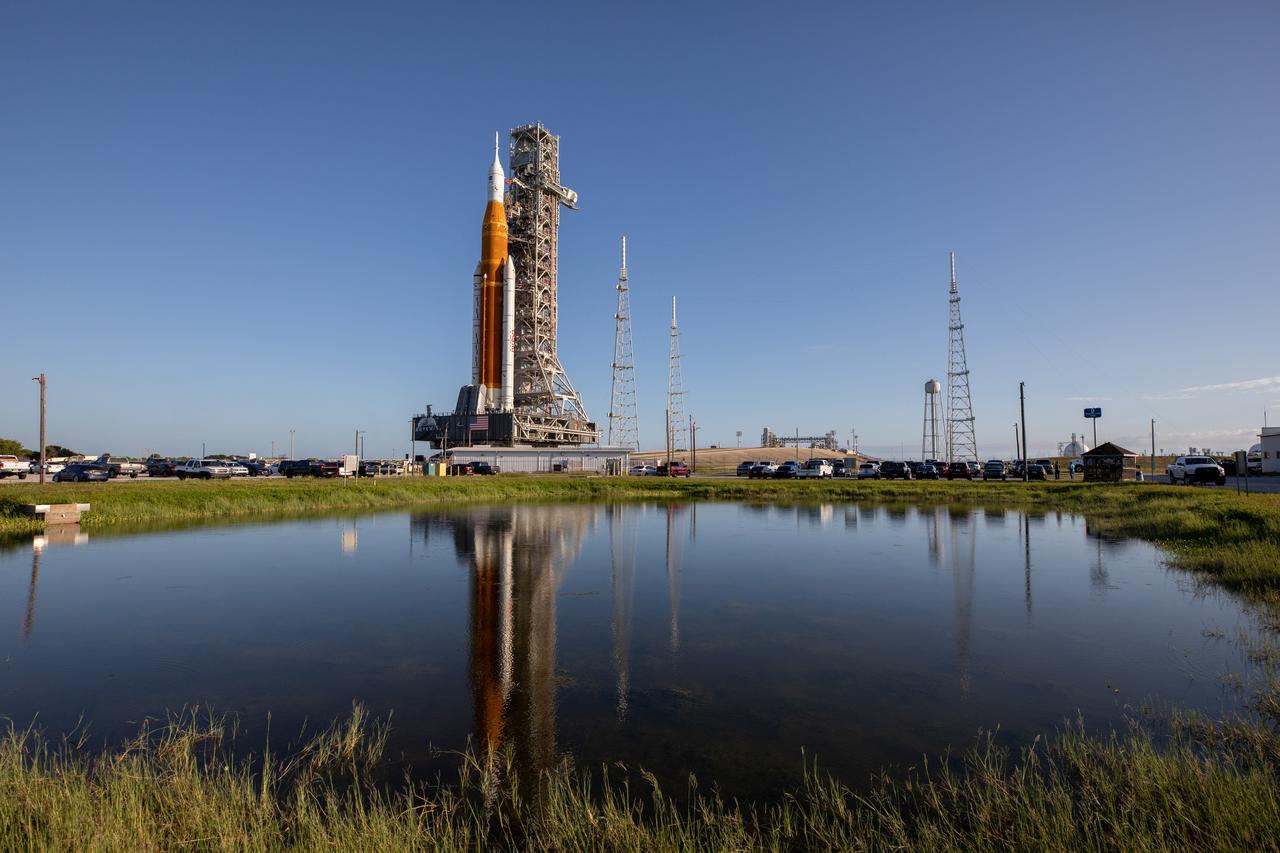
NASA's moon megarocket is scheduled to fly its first mission as soon as late August, pending testing and reviews of all the components of Artemis 1.
The agency announced today (July 20) that it has three "placeholder" launch dates for the uncrewed test flight around the moon: Aug. 29, Sept. 2 and Sept. 5.
"It's not an agency commitment," Jim Free, NASA's associate administrator of exploration systems, said of the interim launch dates during a teleconference with reporters. The agency, he said, will make a commitment closer to the launch date pending work on several outstanding items from Artemis 1's wet dress rehearsal that concluded June 20.
Learn more at Space.com here.
Artemis 1 NASA preview today (Wednesday) at 11 a.m. EDT
NASA's will hold a press conference Wednesday (Aug. 3) at 11 a.m. EDT (1500 GMT) to give a general overview of the Artemis 1 lunar mission, which you can watch for free in the YouTube stream above.
The briefing is expected to last an hour and will feature the following speakers:
- NASA Administrator Bill Nelson;
- Bhavya Lal, associate administrator for technology, policy, and strategy at NASA's headquarters;
- Mike Sarafin, Artemis 1 mission manager with NASA HQ;
- Charlie Blackwell-Thompson, Artemis 1 launch director at NASA's Kennedy Space Center (KSC) in Florida (the mission's launch site);
- John Honeycutt, Space Launch System program manager with NASA's Marshall Space Flight Center in Huntsville, Ala.;
- Howard Hu, Orion program manager, with NASA's Johnson Space Center (JSC) in Houston.
After Wednesday's briefing, NASA will host an in-person media day concerning Artemis 1 at its Johnson Space Center, where astronaut training takes place.
Artemis 1 will send an Orion spacecraft to the moon atop a Space Launch System megabooster, in an uncrewed mission meant to prepare for future human excursions. The mission will also launch 10 cubesats targeting several off-Earth science missions.
The exact duration of Artemis 1 will depend on orbital dynamics at the time of launch; an Aug. 29 launch (the nominal date so far) would see a 42-day flight, for example, but a Sept. 2 liftoff would kick off a 39-day mission.
Read more: NASA will preview its Artemis 1 moon mission this week. Here's how to watch for free.
Artemis 1 cleared for launch; Space.com on site
The Artemis 1 moon megarocket is cleared for launch for its debut mission, no earlier than Aug. 29. The European Space Agency released a video (visible above) celebrating the milestone for the mission, which is led by NASA.
Space.com is on site at NASA's Johnson Space Center in Houston talking to officials about the progress of Artemis 1, which aims to circle the moon and come back to Earth uncrewed on a mission lasting more than a month. We'll keep you tuned into our coverage as the briefings progress.
On Aug. 3, NASA officials said the rocket is on track for launch preparations following a "wet dress rehearsal" fueling test in June that revealed a few issues. The agency also framed this mission as critical to get the Space Launch System rocket and Orion spacecraft ready for future human missions as the system collects science on the moon and on human effects on spaceflight.
Read more: Artemis 1 moon mission readies for crucial test for future crewed flights
Artemis 1 moon rocket rollout moved up to Aug. 16
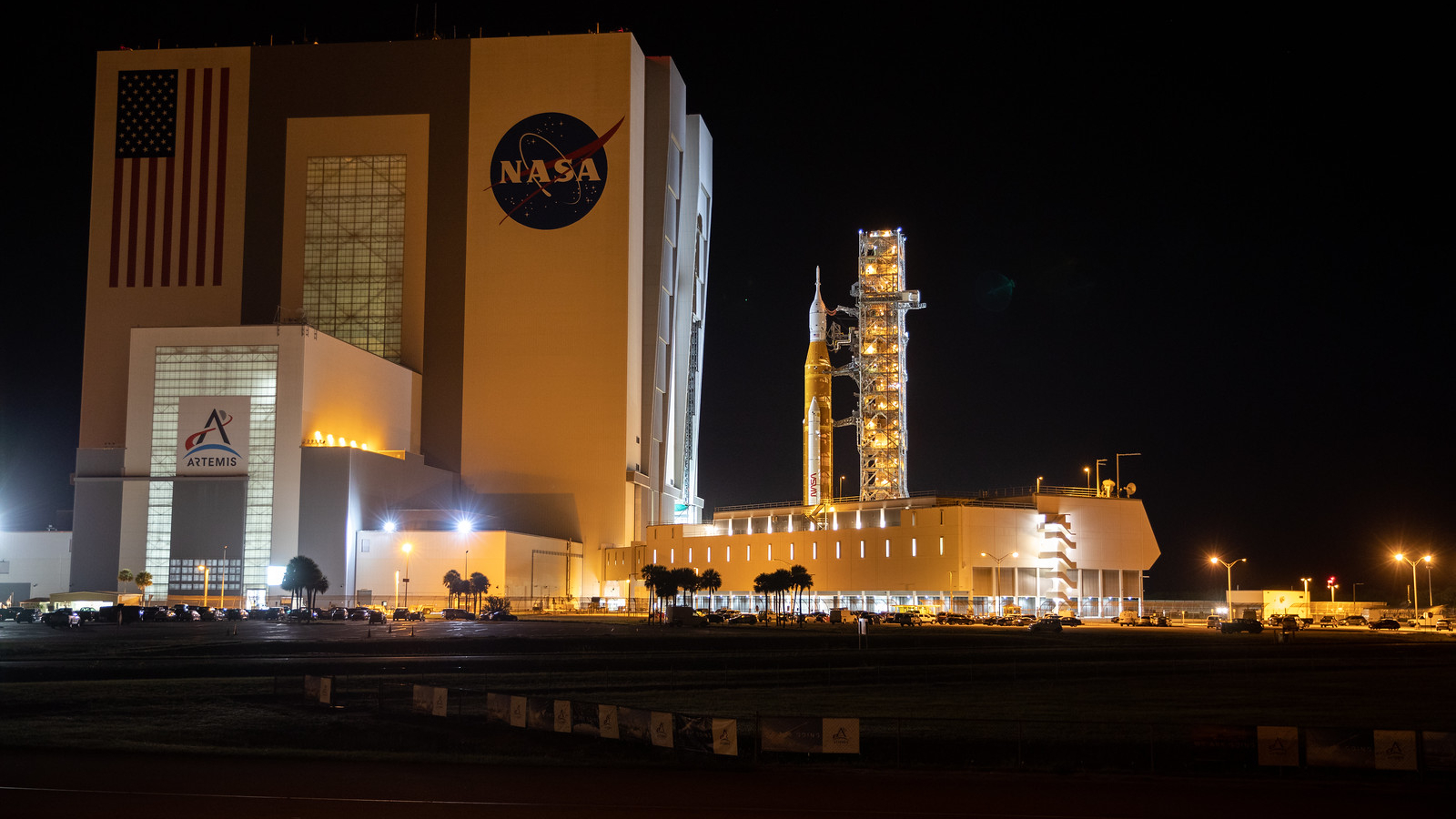
NASA has moved up the launch pad rollout of its Artemis 1 moon rocket, the first Space Launch System, by two days. The rocket will now roll out its Launch Pad 39B site on Tueday, Aug. 16, (two days earlier than planned) to begin final preparations for its Aug. 29 launch to the moon.
Officials with NASA's Ground Systems team announced the schedule change on Twitter.
"ARTEMIS I UPDATE: The rollout of @NASA_SLS & @NASA_Orion to Launch Pad 39B has now moved up to tomorrow, the evening of Aug. 16, ahead of the targeted Aug. 29 launch. Stay tuned for more information as well as ongoing coverage," NASA wrote in the update.
The rollout of Artemis 1's SLS will be webcast live on NASA TV. It will come amid a series of teleconferences this week to discuss the Artemis 1 moon mission. Here's a schedule of events for the week, which you'll be able to watch for free on this page.
- Monday, Aug. 15, at 5 p.m. EDT: Artemis 1 lunar science payloads teleconference.
- Tuesday, Aug. 16, at 12 p.m. EDT: Artemis 1 technology & solar system science teleconference.
- Tuesday, Aug. 16, evening: Artemis 1 moon rocket rollout.
- Wednesday, Aug. 17, at 12 p.m. EDT: Artemis 1 radiation science teleconference.
ARTEMIS I UPDATE: The rollout of @NASA_SLS & @NASA_Orion to Launch Pad 39B has now moved up to tomorrow, the evening of Aug. 16, ahead of the targeted Aug. 29 launch. Stay tuned for more information as well as ongoing coverage. pic.twitter.com/28kRuwB4pNAugust 15, 2022
NASA's Artemis 1 launch pad roll out webcast begins
NASA's live webcast of today's Artemis 1 Space Launch System rollout to the pad has begun. You can watch the Artemis 1 moon rocket rollout live on Space.com, or directly from NASA's Kennedy Space Center Newsroom YouTube page.
While NASA's webcast began at 3 p.m. EDT (1900 GMT), the SLS rocket itself is expected to begin rolling out at 9 p.m. EDT (0100 GMT on Aug. 17). It could take up to 12 hours for the SLS rocket to reach the launch pad.
NASA is providing two views of the rollout. A closeup of the Vehicle Assembly Building, where the SLS is currently located, and of Pad 39B where it will settle in for a planned Aug. 29 launch.
Artemis 1 rollout delayed by storms
The start of NASA's Artemis 1 moon rocket rollout has been delayed by about an hour, to no earlier than 10 p.m. EDT (0200 GMT), due to stormy weather at its Kennedy Space Center, Florida, launch site, according to Spaceflight Now.
Artemis 1's Space Launch System rocket was scheduled to begin at 9 p.m. EDT, but lightning and stormy weather appears to have delayed the rollout. Spaceflight Now reports NASA has a Phase 2 lightning warning in effect currently.
Artemis 1 rocket rollout begins!
NASA's Artemis 1 Space Launch System megarocket has begun its hourslong trek back to Launch Pad 39B tonight for its planned Aug. 29 launch to the moon.
"Rollout has begun," officials with NASA's Kennedy Space Center in Florida wrote as the the SLS rocket began the slow trip to the launch pad atop its massive crawler carrier vehicle and mobile launch platform. It should take up to 12 hours for the 322-foot rocket to complete the trip.
You can watch the rocket rollout live on Space.com, as well as on NASA's Kennedy Space Center Newsroom YouTube feed.
Roll has begun #Artemis I pic.twitter.com/51WSRipiAqAugust 17, 2022
Back at the pad!
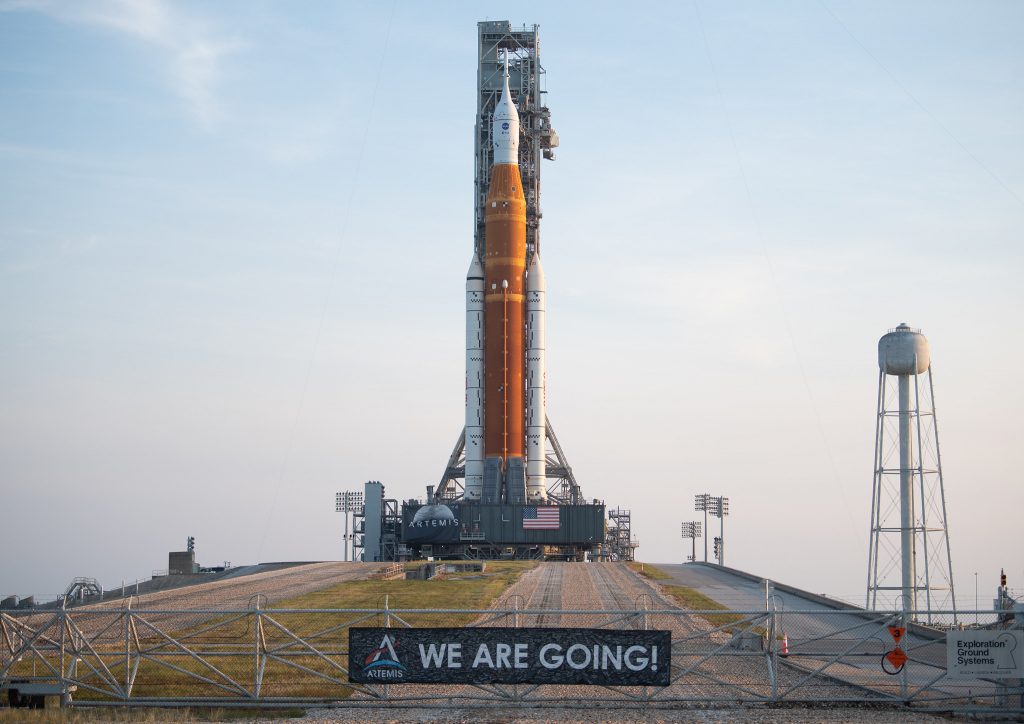
Artemis 1 has reached the pad!
The stack, consisting of the Space Launch System (SLS) megarocket topped by the Orion capsule, arrived at Launch Pad 39B on Wednesday (Aug. 17) around 7:30 a.m. EDT (1130 GMT), according to a NASA statement.
The rocket is targeting launch on Aug. 29 for an uncrewed test flight around the moon.
Artemis 1 science prepares for departure
We've been highlighting several Artemis 1 science investigations in recent stories as the mission prepares for a departure to the moon no earlier than Aug. 29.
Radiation experiments will feature on the mission as it will be taking the Orion spacecraft, rated for humans, deeper in space than any vehicle like it. Mannequins and biological experiments will fly aboard the spacecraft and on cubesats to assess the environment of the moon and deep space for astronaut safety.
Also, a Japanese experiment called OMOTENASHI will serve as a lunar lander. While other investigations are in orbit, this cubesat will be the only of the secondary payloads to conduct a controlled landing on the moon.
Other notable payloads on the mission include an asteroid-bound solar sail, the world's first deep-space biology experiment, and two water-seeking cubesats.

Elizabeth Howell, Ph.D., is a staff writer in the spaceflight channel since 2022. She was contributing writer for Space.com for 10 years before that, since 2012. Elizabeth's on-site reporting includes two human spaceflight launches from Kazakhstan, three space shuttle missions in Florida, and embedded reporting from a simulated Mars mission in Utah.
Artemis 1 launch webcast guide
NASA has laid out the schedule of events for the Artemis 1 moon launch and you'll be able to follow along for free online if you're not planning to head to Florida for the launch.
For Artemis 1, NASA is holding press conferences on Monday night (Aug. 22) and then daily from Aug. 26 through launch day on Aug. 29.
You can see a full schedule of NASA's Artemis 1 launch webcasts, courtesy of Space.com contributor Jeff Spry.
The first of the upcoming webcasts is NASA's Flight Readiness Review briefing, which is scheduled for no earlier than 7 p.m. EDT (2300 GMT) on Monday.
Artemis 1 moon launch is one week away!
NASA's Artemis 1 launch to the moon is officially one week away, with the launch date set for Monday, Aug. 29, at 8:33 a.m. EDT (1233 GMT).
Today, Artemis 1 mission managers will meet in a Flight Readiness Review to discuss the status of the Artemis 1 Space Launch System rocket and its Orion spacecraft. The day-long meeting is expected to run into the late afternoon.
If all goes well, NASA will hold a press conference tonight at 7 p.m. EDT (2300 GMT) to present the launch status of Artemis 1 and the agency's plan to fly the mission.
You'll be able to watch that briefing live on Space.com, courtesy of NASA TV, at start time.
Artemis 1 Flight Readiness Review no earlier than 8 p.m. ET
NASA's Flight Readiness Review press conference for the Artemis 1 moon mission has been delayed 1 hour to no earlier than 8 p.m. EDT (0000 GMT) tonight, the space agency has said.
You'll be able to watch that briefing live on Space.com, courtesy of NASA TV, at start time.
Artemis 1 Go for Aug. 2 launch attempt
NASA has officially cleared the Artemis 1 Space Launch System rocket and its Orion spacecraft for an Aug. 29 launch to the moon.
Liftoff is set for Aug. 29 during a two-hour window that opens at 8:33 a.m. EDT (1233 GMT).
The space agency just wrapped up an hourlong press conference with reporters on the mission. Read our full story.
Certificate of Flight Readiness signed ✅ Excited to report we finished our flight readiness poll and everyone is "GO." Today's #Artemis I Flight Readiness Review worked as it should. We asked critical questions of each other to ensure we're ready to fly. (1/2) pic.twitter.com/7jRXG53mZiAugust 22, 2022
5 Days to Artemis 1 launch
NASA is less than a week away from launching its Artemis 1 mission to the moon and the stage is set for what may be a history-making flight.
As Space.com contributor Rob Lea wrote today, NASA sees Artemis 1 as a path to the moon and Mars, with the first Artemis astronauts to walk on the moon by 2025.
NASA is also planning to set up the Artemis Real-time Orbit Website the day before launch. Staff writer Elizabeth Howell has the story here.
This week, Space.com is taking a look at what we know about the moon with our Moon Week series. Here's what we've run so far:
Monday: Why we're always so entranced by the moon
Tuesday: As NASA nears return to the moon with Artemis, scientists' excitement reaches fever pitch
Wednesday: The moon's far side could offer a view of the universe better than the James Webb Space Telescope
Meanwhile, the European Space Agency has set its hopes for Europeans on the moon on the Artemis program. The agency built the Artemis 1 Orion service module and will use it as a springboard to the moon.
It's also been a long road for NASA's Space Launch System and Orion spacecraft. Rob Lea takes a look at both vehicles in our SLS feature and Orion history recap.
4 Days to Artemis 1 launch!
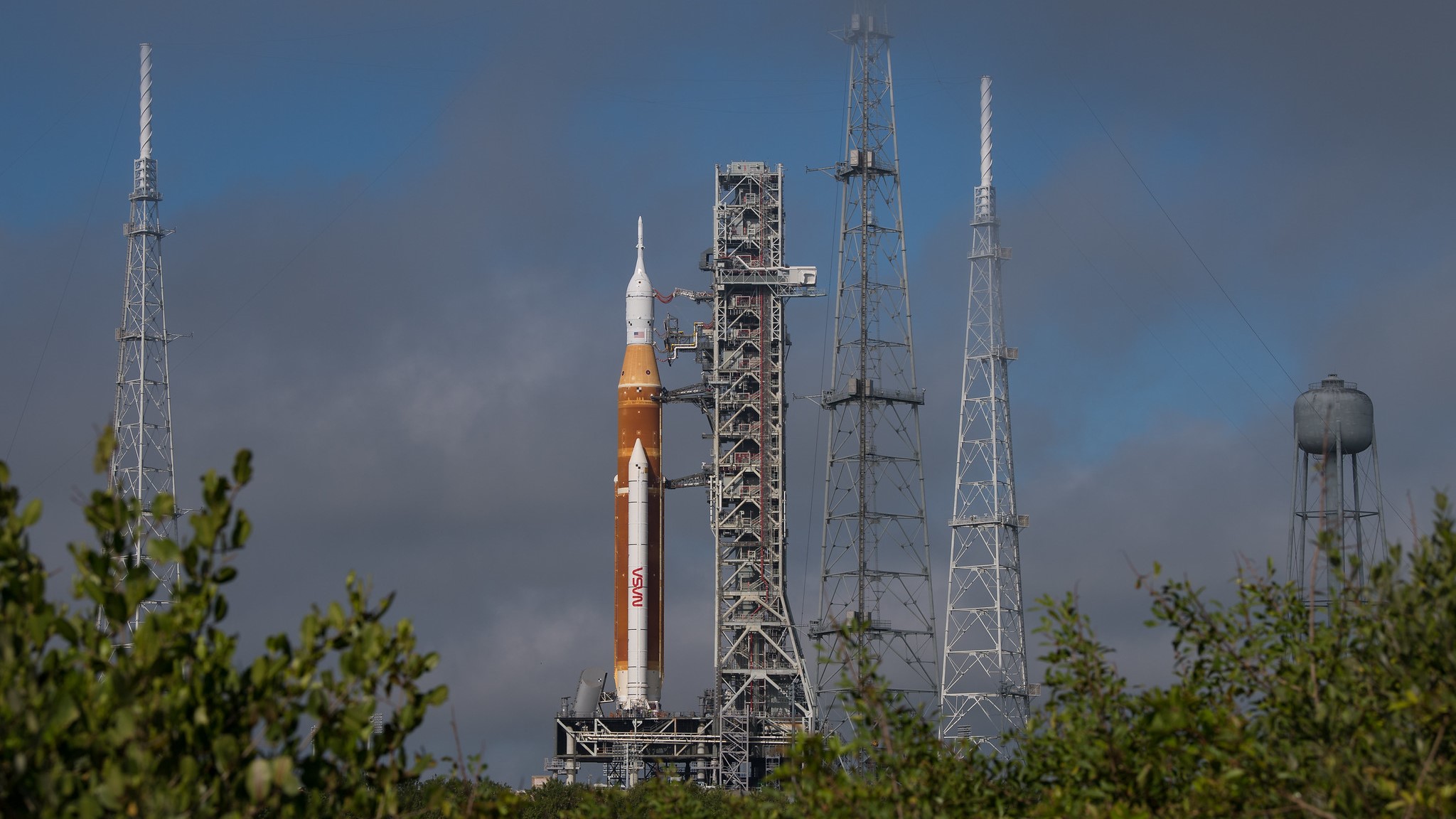
NASA is now four days away from the first launch attempt of its Artemis 1 moon rocket. So far, the space agency has reported no issues with the mission's Space Launch System rocket or its uncrewed Orion spacecraft.
A weather forecast released by the U.S. Space Force's Space Launch Delta 45 group has predicted a 70% chance of good weather for the first launch opportunity on Monday, Aug. 29, at 8:33 a.m. EDT (1233 GMT). NASA has a two-hour window in which to try to launch the mission.
As our Moon Week coverage continues, write JoAnna Wendel takes a look at the moon and Mars, and the perennial choice of which target to aim for by explorers. Check that out below:
Thursday: Moon vs. Mars: NASA's ultimate destination has varied over the decades
-- Tariq Malik
3 Days to Artemis 1 launch; Weather looking good!
The countdown to NASA's first launch attempt of its massive Artemis 1 moon rocket is proceeding ahead of schedule with just 3 days to launch. So far, the space agency is reporting no issues with the mission's Space Launch System rocket or its uncrewed Orion spacecraft.
Engineers have closed the launch abort system hatch and retracted the crew access arm used to provide access to the spacecraft. Booster and core stage engine service platforms, as well as side flame deflectors, have been moved into position for launch.
Friday morning's weather forecast issued by the U.S. Space Force's 45th Weather Squadron calls for a 70% chance of good weather for the first launch opportunity on Monday, Aug. 29, at 8:33 a.m. EDT (1233 GMT). Meteorologists will be monitoring scattered showers across Atlantic waters throughout the two-hour launch window, scrutinizing conditions for possible violations of the Cumulus Cloud, Surface Electric Fields, and Flight Through Precipitation flight rules.
As our Moon Week coverage continues, writer JoAnna Wendel takes a look at the moon and Mars, and the perennial choice of which target to aim for by explorers. Check that out below:
Friday: Moon vs. Mars: NASA's ultimate destination has varied over the decades
Vice-President Kamala Harris will be at Artemis 1 launch

U.S. Vice President Kamala Harris will join VIPs at the scheduled Artemis 1 moon mission lift off Monday (Aug. 29), Space.com learned Thursday (Aug. 25) in an exclusive update from the Vice President's office.
Harris, also the chair of the National Space Council, will tour the Kennedy Space Center where Artemis 1 is poised to lift off, and will also deliver a speech to delegates. The theme will be the historic importance of NASA's Artemis program and the agency's space leadership.
Read more: VP Kamala Harris to attend Artemis 1 moon launch (exclusive)
Artemis 1 pics from space + What time's the launch?
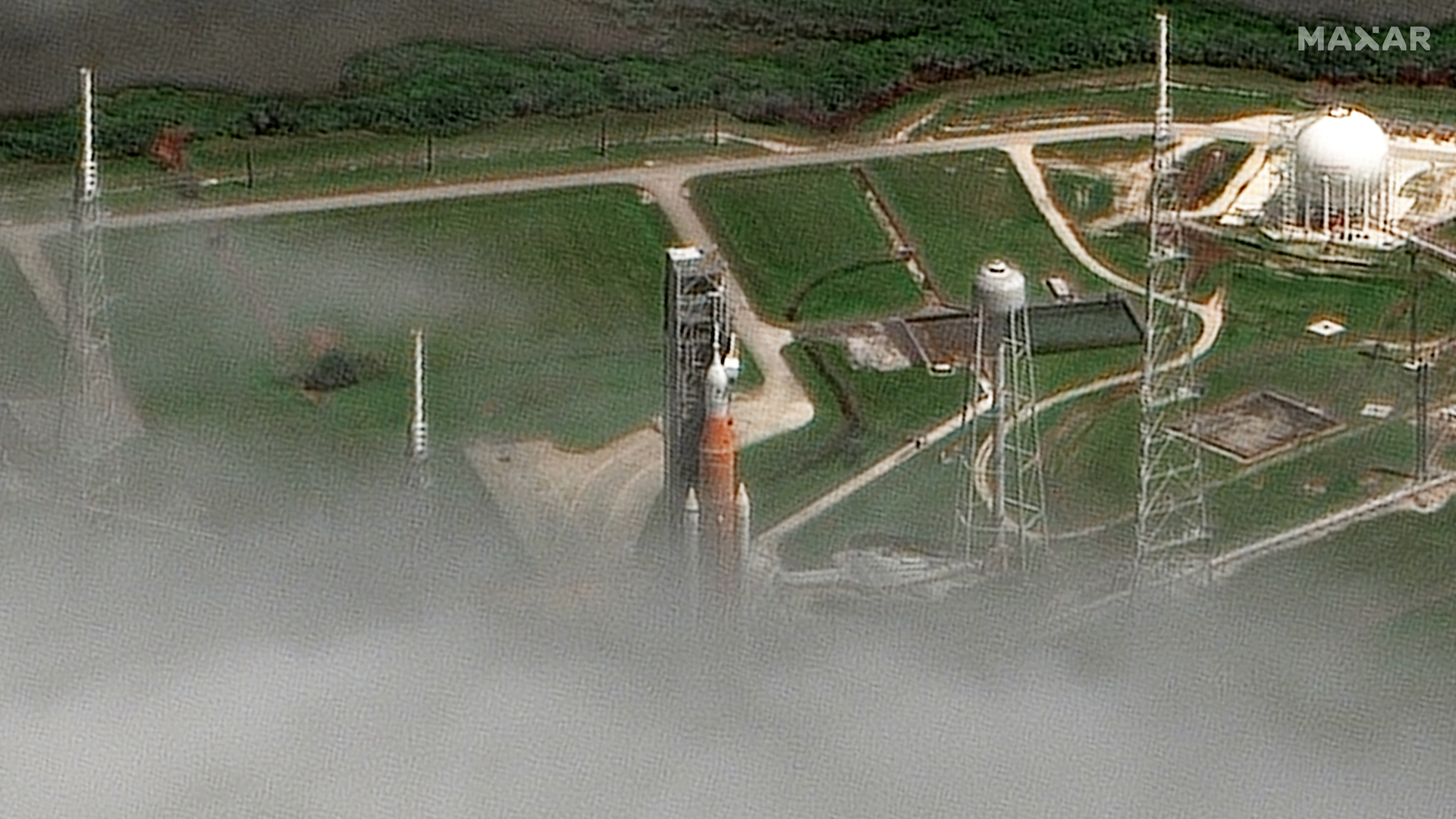
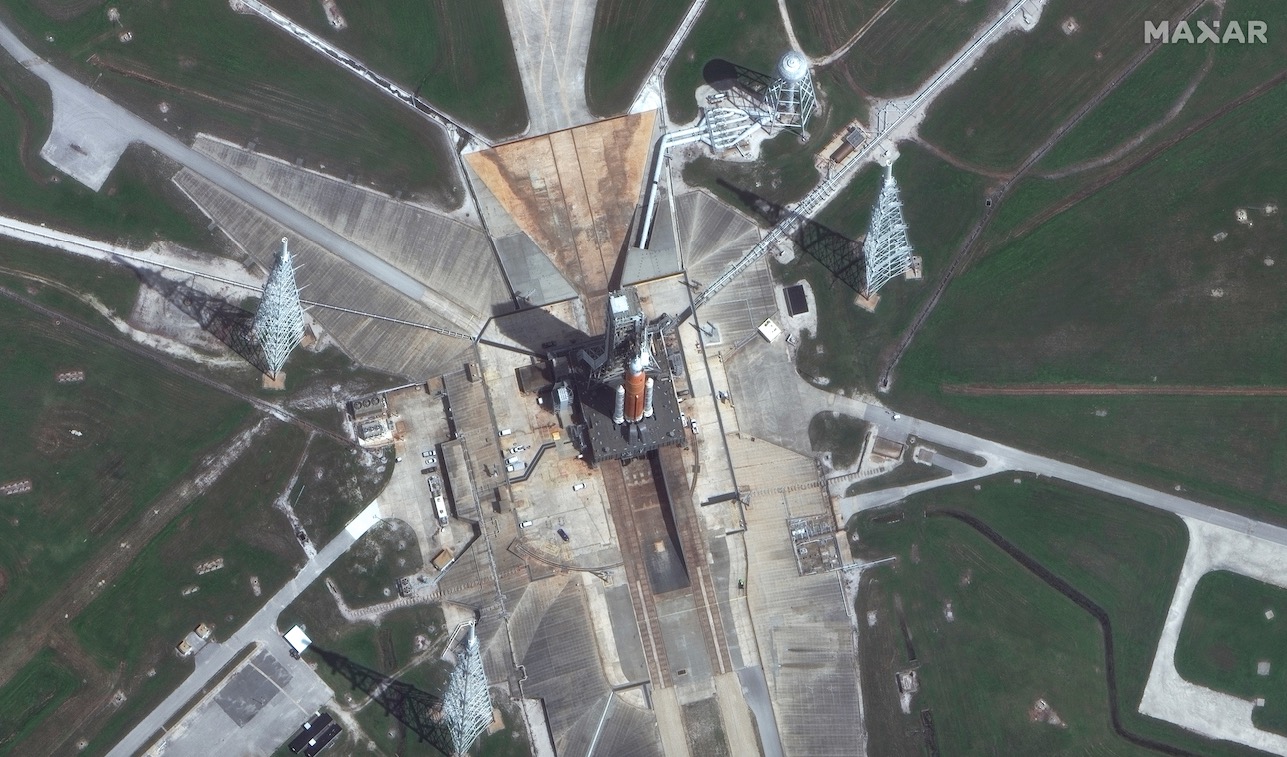
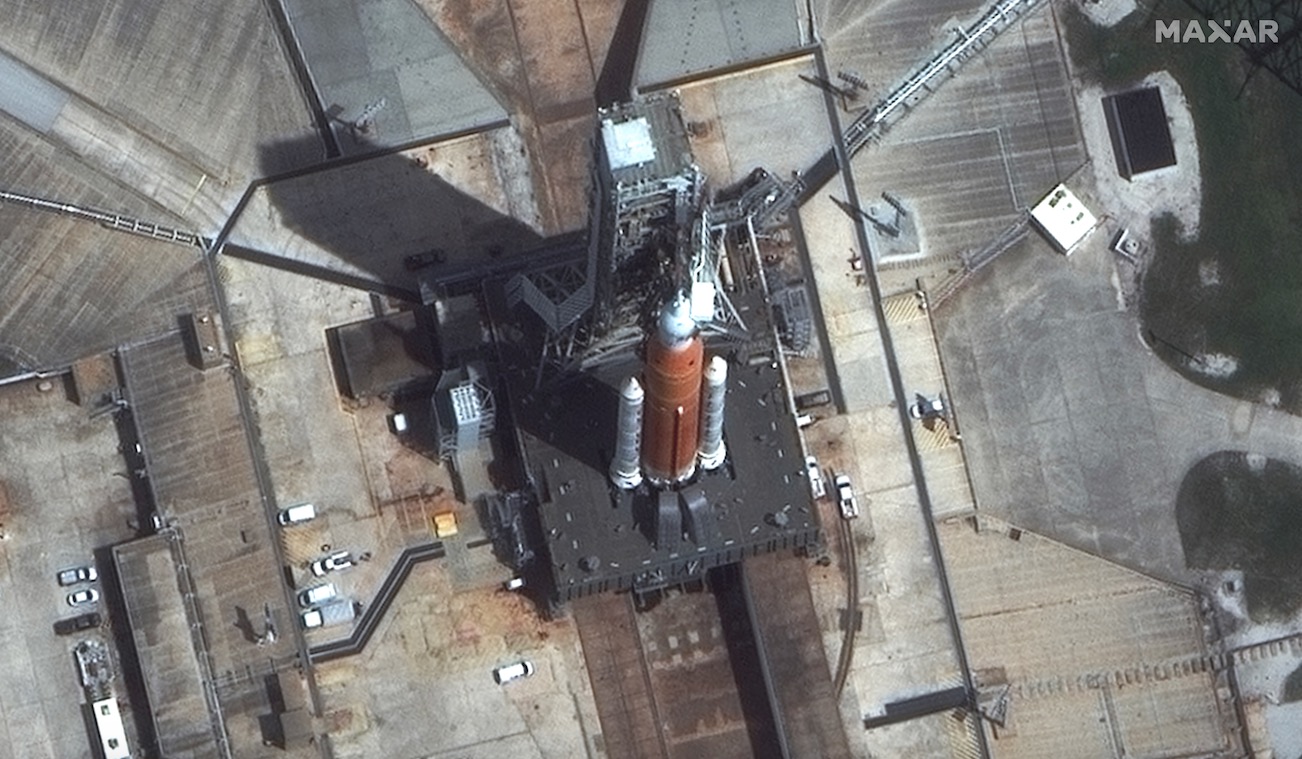
CAPE CANAVERAL, Fla. -- With just 3 days remaining until NASA's Artemis 1 launch, the excitement is starting to build.
Satellite operator Maxar has snapped stunning new photos of the Artemis 1 Space Launch System megarocket from space and the views are amazing. You can read the full story from Space.com's Mike Wall.
Meanwhile, Vice President Kamala Harris announced today that she will be on hand to watch the Artemis 1 launch. Harris is expected to speak shortly after the launch attempt about NASA, Artemis 1 and the space goals of the United States.
Here's what else has happened around Artemis 1 today:
Preserving Apollo sites and more on the moon
As our Moon Week continues, writer Greg Uyeno takes a look at the moon preservation efforts to protect historic sites on the moon.
Alexa riding on Artemis 1!
Space.com editor Brett Tingley has seen the future of Alexa in space, and it is riding on Artemis 1. Meet the Callisto experiment on Orion.
Krispy Kreme's Moon Doughnut
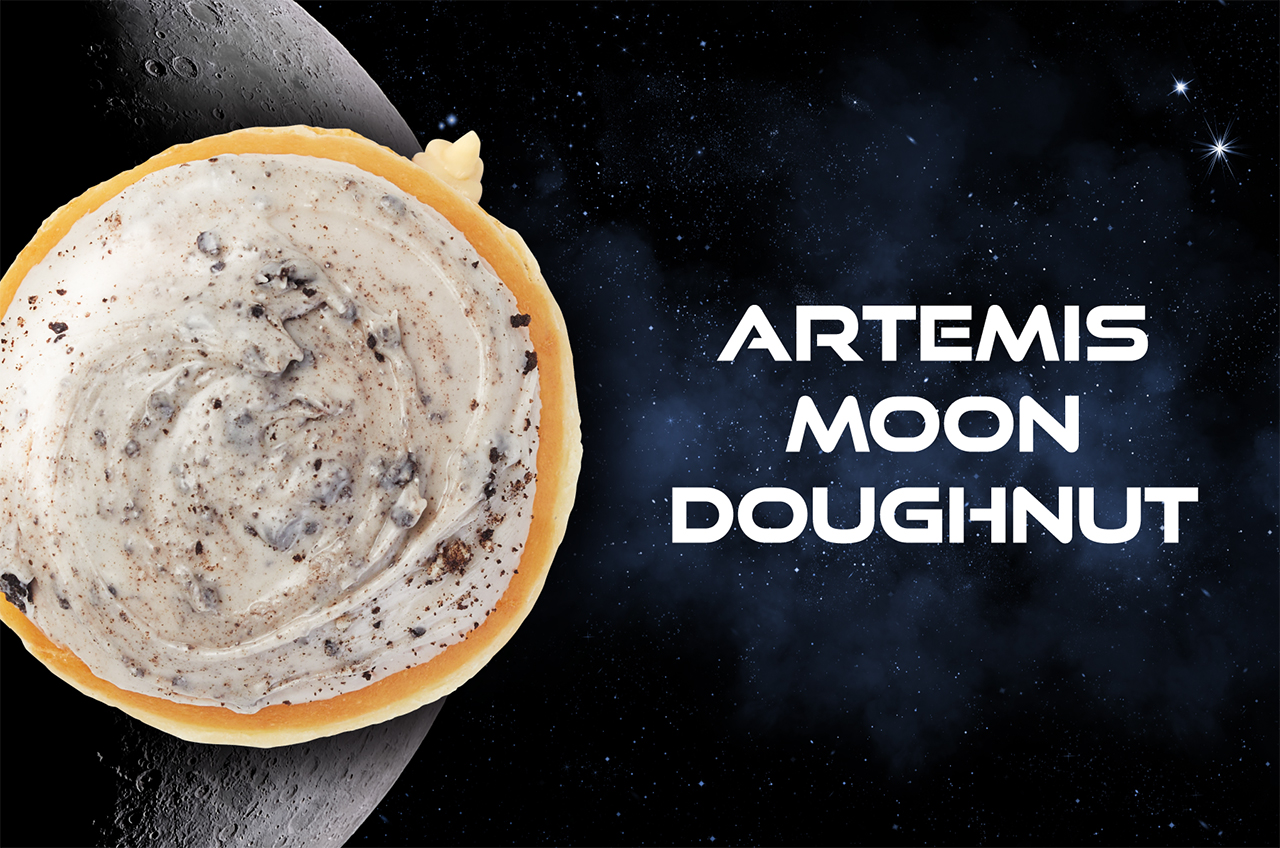
Krispy Kreme has announced it will unveil an Artemis moon doughnut on launch day.
"The Artemis 1 mission is a proud moment, and we are in awe of the amazing Americans behind the world's most powerful rocket. So, we created these delicious doughnuts to enjoy while you watch the launch," Dave Skena, global chief brand officer for Krispy Kreme, said in a statement issued on Friday (Aug. 26). "The Orion spacecraft atop the rocket will stay in space longer than any ship for astronauts has done without docking to a space station, but our Artemis Moon Doughnut will be available only Monday, so start the countdown and don't miss it!"
NASA's Science Chief talks Artemis 1 and Lunar Exploration
And finally, Space.com's Staff Writer Elizabeth Howell caught up with NASA science chief Thomas Zurbuchen about what Artemis 1 means for moon science.
"The Artemis program of course, is to do sustainable exploration on the moon but ... to really turn around and look at Mars as our destination," Zurbuchen said.
T-2 days to launch!
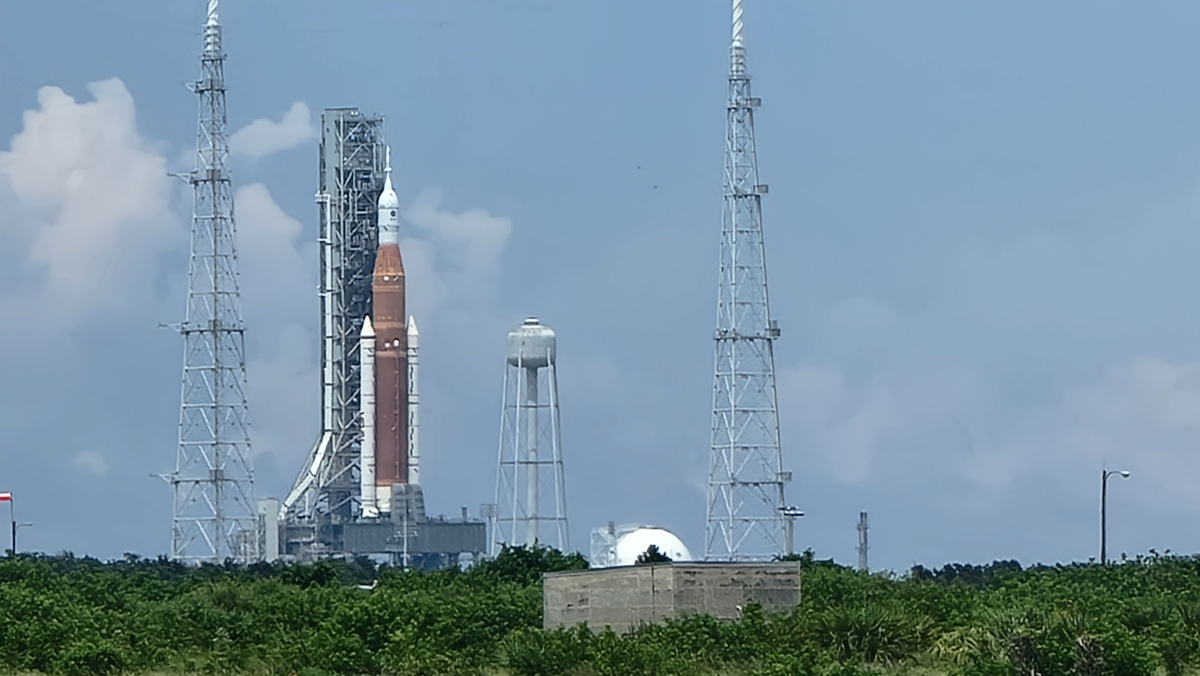
CAPE CANAVERAL, Fla -- NASA is now two days away from the Artemis 1 launch and the launch countdown began today at 10:23 a.m. EDT (1423 GMT). Launch flight controllers reported to their stations at 9:53 a.m. EDT (1353 GMT).
At 11 a.m. EDT (1500 GMT), NASA will hold a press conference to discuss the launch plan for Artemis 1. You can watch that Artemis 1 launch webcast here.
Call to Stations: At approx. 9:53 am EDT, or L-46 hours, 40 minutes before the initial targeted T-0, the launch team arrived at their stations inside the Launch Control Center at @NASAKennedy. The countdown is now underway for the 1st Artemis I launch attempt, Aug. 29 at 8:33 am. pic.twitter.com/HYeFdqgyQuAugust 27, 2022
The latest weather forecast from the U.S. Space Force still calls for a 70% chance of good conditions at launch. Today, the sky was bright blue and dotted with white clouds at launch time over Pad 39B.
While NASA is counting down to the Artemis 1 launch, SpaceX is preparing for a launch if its own.
A SpaceX Falcon 9 rocket is standing atop the company's pad at Cape Canaveral Space Force Station, which is near the Kennedy Space Center here, to launch a new batch of Starlink satellites into orbit. Liftoff is set for 10:22 p.m. EDT (1422 GMT).
You can watch the SpaceX Starlink launch live on Space.com via a preview from Spaceflight Editor Mike Wall.
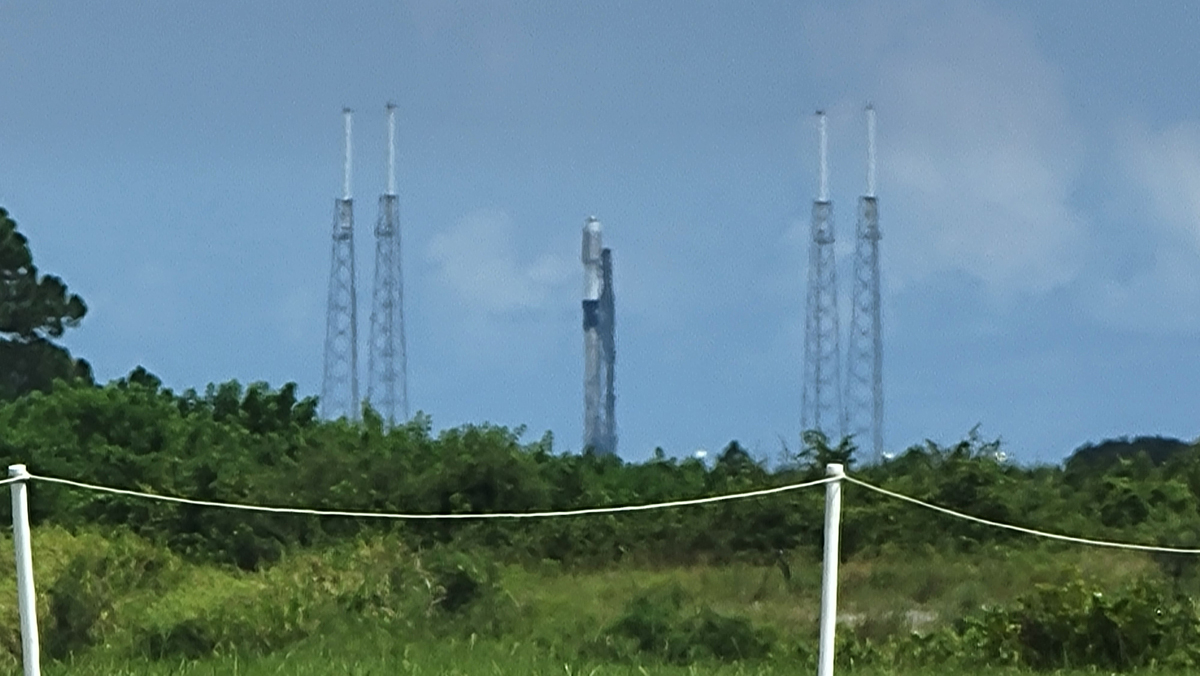
Lightning strikes Artemis 1 launch pad
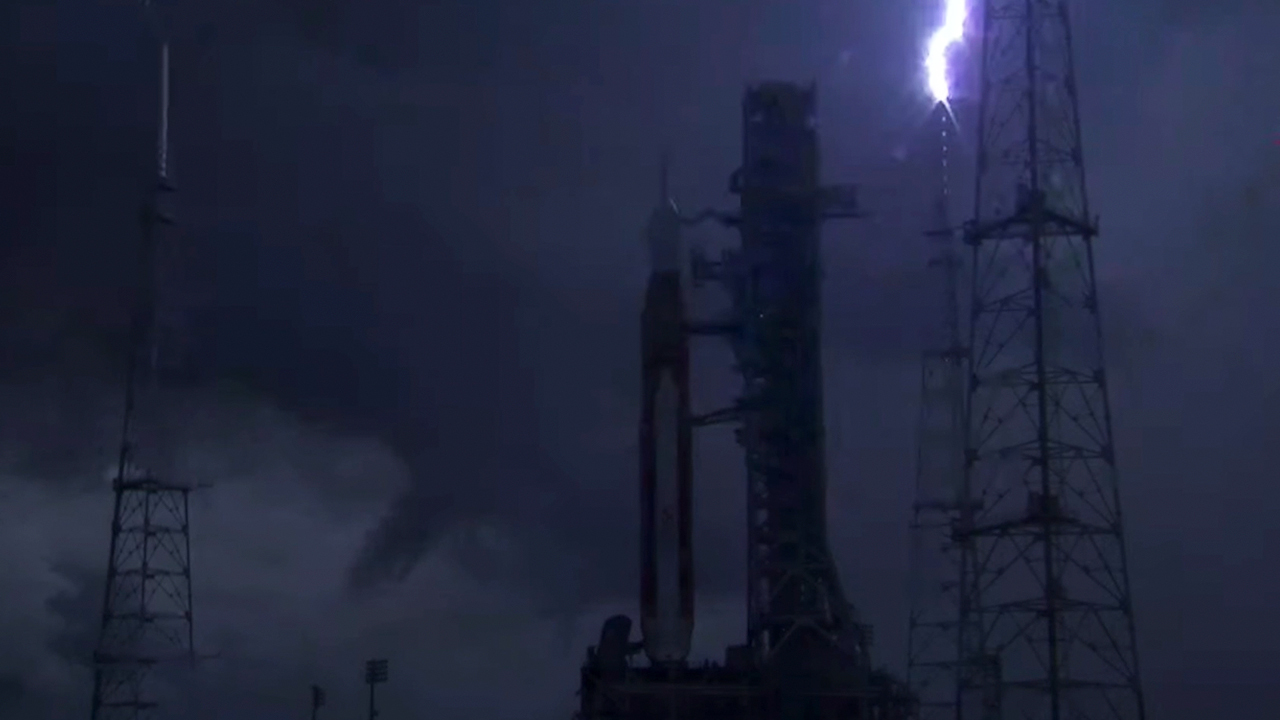
CAPE CANAVERAL, Fla. -- A series of lightning strikes peppered NASA's Launch Pad 39B complex on Saturday, Aug. 29, where the Artemis 1 moon mission is awaiting launch.
The lightning strikes occurred Saturday afternoon amid a flurry of rainstorms here at the Kennedy Space Center.
"A weather team has begun an assessment that includes collecting voltage and current data, as well as imagery," NASA officials wrote in an update. "The data will be shared with a team of experts on electromagnetic environment efforts who will determine if any constraints on vehicle or ground systems were violated. Engineers will conduct a walkdown at the pad tonight, and if needed, conduct additional assessments with subsystems experts."
One day to Artemis 1 launch
There is just one day remaining until NASA's Artemis 1 launch, which mission manager Mike Sarafin has dubbed the "zero hour" for the Artemis generation.
Artemis 1's Space Launch System and Orion spacecraft are still on track to launch on Monday, Aug. 29, at 8:33 a.m. EDT (1233 GMT), but do have a 2-hour window in which to fly.
The weather forecast still calls for a 70% chance of good conditions at launch time.
At 9 a.m. EDT (1300 GMT) today, NASA will hold one final launch countdown update. You can watch that live here at start time.
Artemis 1 remains go with less than 1 day to launch
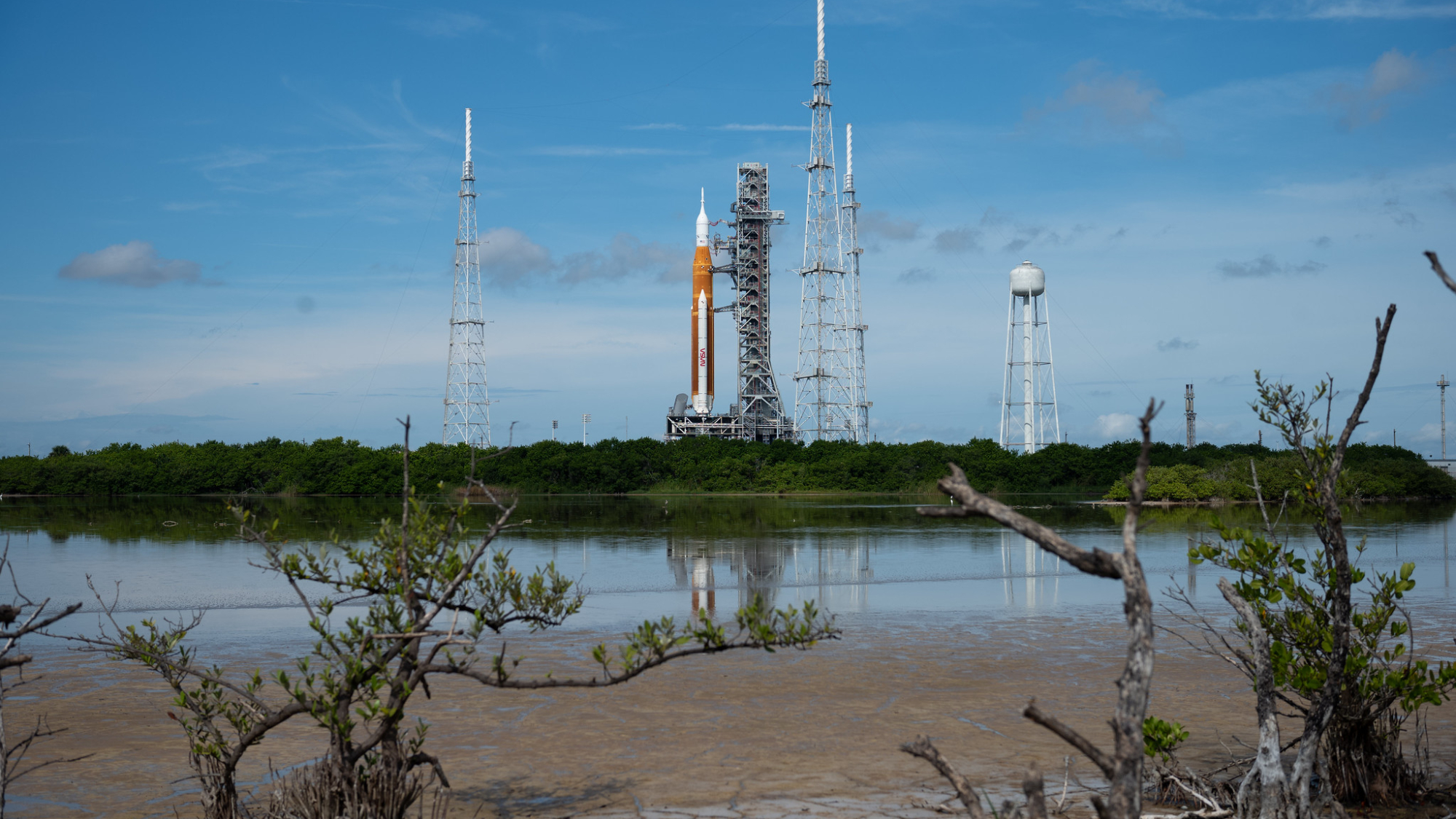
Artemis 1 remains go after several lightning strikes to the pad yesterday (Aug. 27). Technicians "confirmed the strikes were of low magnitude and had no impacts to Space Launch System [rocket], Orion [spacecraft], or ground systems," NASA said in a blog post Sunday, confirming information in a briefing earlier in the day.
There is an 80 percent chance of good weather Monday (Aug. 29) from NASA's Kennedy Space Center in coastal Florida, according to meteorologists with the U.S. Space Force Space Launch Delta 45, the agency said.
This prediction, however, is for the beginning of the two-hour launch window (which opens at 8:33 a.m. EDT or 1233 GMT). Favorable weather conditions will decline to 60% in the latter part of the window, NASA said.
"The primary weather concern for the two-hour launch window remains scattered rain showers," the agency added.

Elizabeth Howell (Ph.D.) has covered five human spaceflights and one launch attempt (which was derailed by a forecasted tropical storm) in Florida and in Kazakhstan. She has been writing about space missions since 2004, including several books. One of them, "Canadarm and Collaboration", focused on the history of Canada's human spaceflight program.
SLS rocket's upper stage powered up
NASA's Artemis 1 test director has given the 'go' to power up the Space Launch System's upper stage, called the Interim Cryogenic Propulsion Stage, as the countdown progresses for the Aug. 29 launch.
At 10:53 p.m. EDT (0253 GMT), about 9 hours before launch, the countdown will go into a planned hold that will last about 2 hours and 30 minutes.
"During this time, the mission management team will review the status of operations, receive a weather briefing, and make a “go” or “no-go” decision to proceed with tanking operations," NASA wrote in an update.
NASA is expected to begin a live webcast as fueling begins at 12 a.m. EDT (0400 GMT).
NASA gives 'go' to fuel Artemis 1 rocket, eyes weather
It's launch day for NASA's Artemis 1 moon rocket and mission managers have officially given the "go" to begin fueling operations on the massive Space Launch System booster, but not fueling itself.
Artemis 1 launch director Charlie Blackwell-Thompson has ordered a hold on actually fueling the SLS rocket due to a nearby storm system where lightning was spotted. NASA weather rules don't allow fueling to occur when there is lightning near the Artemis 1's Pad 39B here at the Kennedy Space Center.
NASA spokesperson Derrol Nail said launch controllers can begin chill-down operations on the SLS rocket, but won't start fueling it with its 730,000 gallons of propellant until the weather situation is determined.
Artemis 1 fueling on hold
NASA has declared a weather hold on fueling operations for the Artemis 1 SLS moon rocket due to a lightning risk near the launch pad.
A nearby storm system has a greater than 20% chance of spawning lightning near the pad during the 1st hour of fueling (which NASA calls tanking), which is a violation of tanking weather rules.
Artemis 1 launch director Charlie Blackwell-Thompson said Saturday that her team could delay the start of tanking by up to 2 hours and still attempt a launch at 8:33 a.m. EDT (1233 GMT).
Artemis 1 'go' for tanking
NASA commentator Derrol Nail reports that the lightning risk for today's fueling operations of Artemis 1 has eased and launch controllers have given the go ahead to begin fueling.
Pre-chilldown operations are underway ahead of the process to fill the Space Launch System with its 730,000 gallons (2.76 million liters) of super-cold liquid oxygen and liquid hydrogen propellant.
Liquid Hydrogen fueling begins for Artemis 1
Artemis 1 launch controllers have begun "slow fill" fueling of liquid hydrogen propellant into the massive Space Launch System rocket.
"Fast filling" of the rocket's liquid oxygen propellant is continuing.
Still no word if NASA will have to target a later time in its 2-hour launch window today for the launch, which remains targeted at 8:33 a.m. EDT (1233 GMT).
NASA tracking possible liquid hydrogen leak on SLS
NASA launch controllers are investigating a possible liquid hydrogen leak in a tail service mast umbilical on the Space Launch System core stage, NASA spokesperson Derrol Nail says.
At about 3:11 a.m. ET, Nail reported that launch controllers detected a higher than acceptable concentration of hydrogen in a "purge can" that covers umbilical connections into the SLS rocket and is designed to detect leaks.
NASA initially halted the flow of liquid hydrogen propellant into the rocket, but has resumed fast filling now.
"The team is now working to determine if they have a leak, and where it is and how bad it is, if they have one," Nail said.
NASA gives 'go' to fuel upper stage of SLS
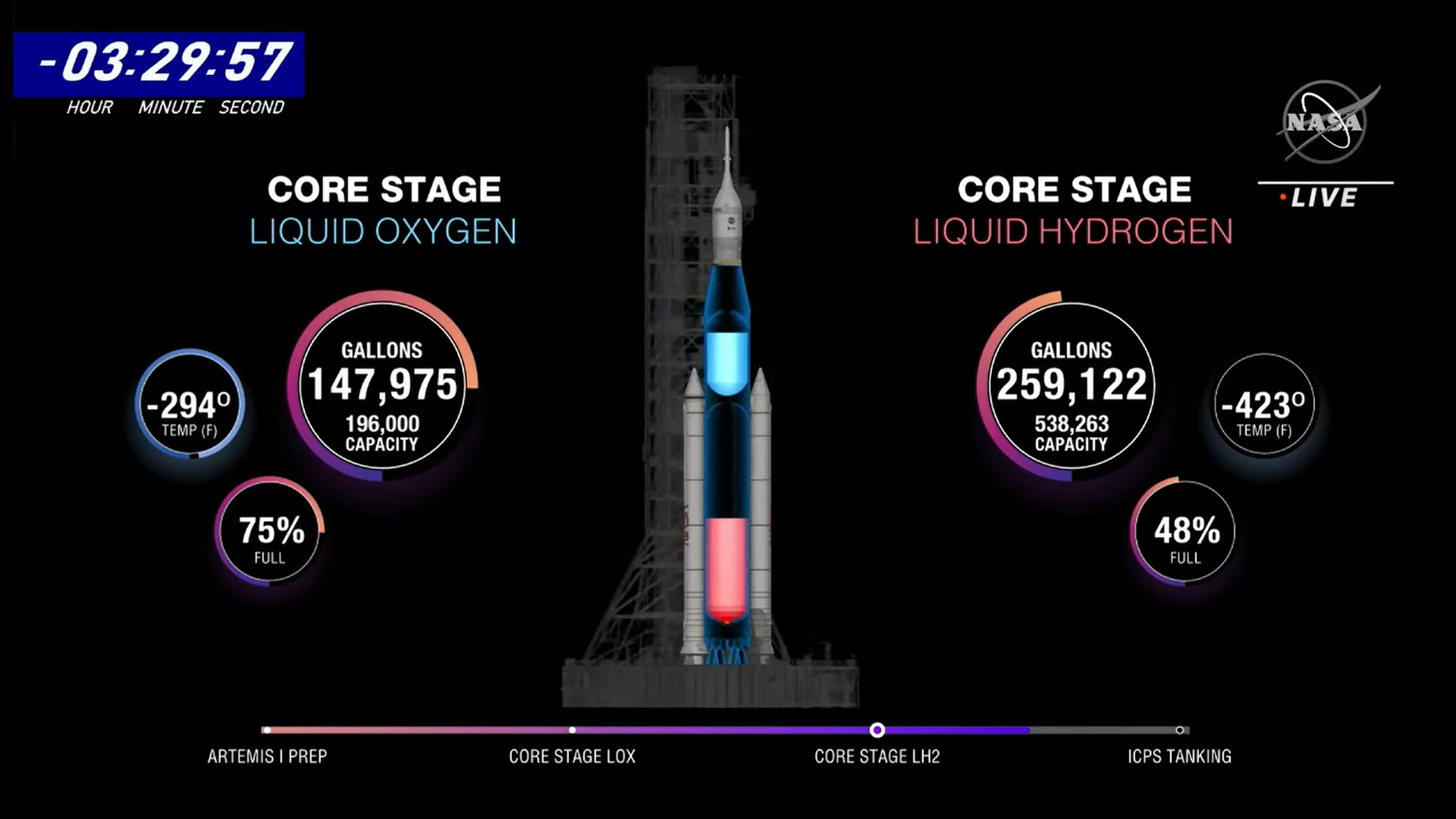
NASA has given the go to continue fueling the SLS rocket and is now filling the rocket's upper stage with liquid hydrogen fuel.
Fast-filling of the first stage continues. Above you can see the progress as of 4:30 am ET of the fueling process.
NASA tops off liquid hydrogen tank on SLS core
The liquid hydrogen tank on the core stage of NASA's SLS rocket is now fully fueled and in stable replenish mode, NASA reports. The core stage's liquid oxygen tank is also nearly fully fueled.
Meanwhile, NASA is filling the liquid hydrogen tank on the upper stage as today's tanking process continues.
NASA's Derrol Nail says the launch team has left the fuel leak issue behind as it appears to be stable now.
Another critical test is coming soon in the fueling process. NASA repaired a different fuel leak after a wet dress rehearsal earlier this year. That fix will be tested at around 5:43 a.m. ET, Nail has said.
NASA updates on fuel leak and more
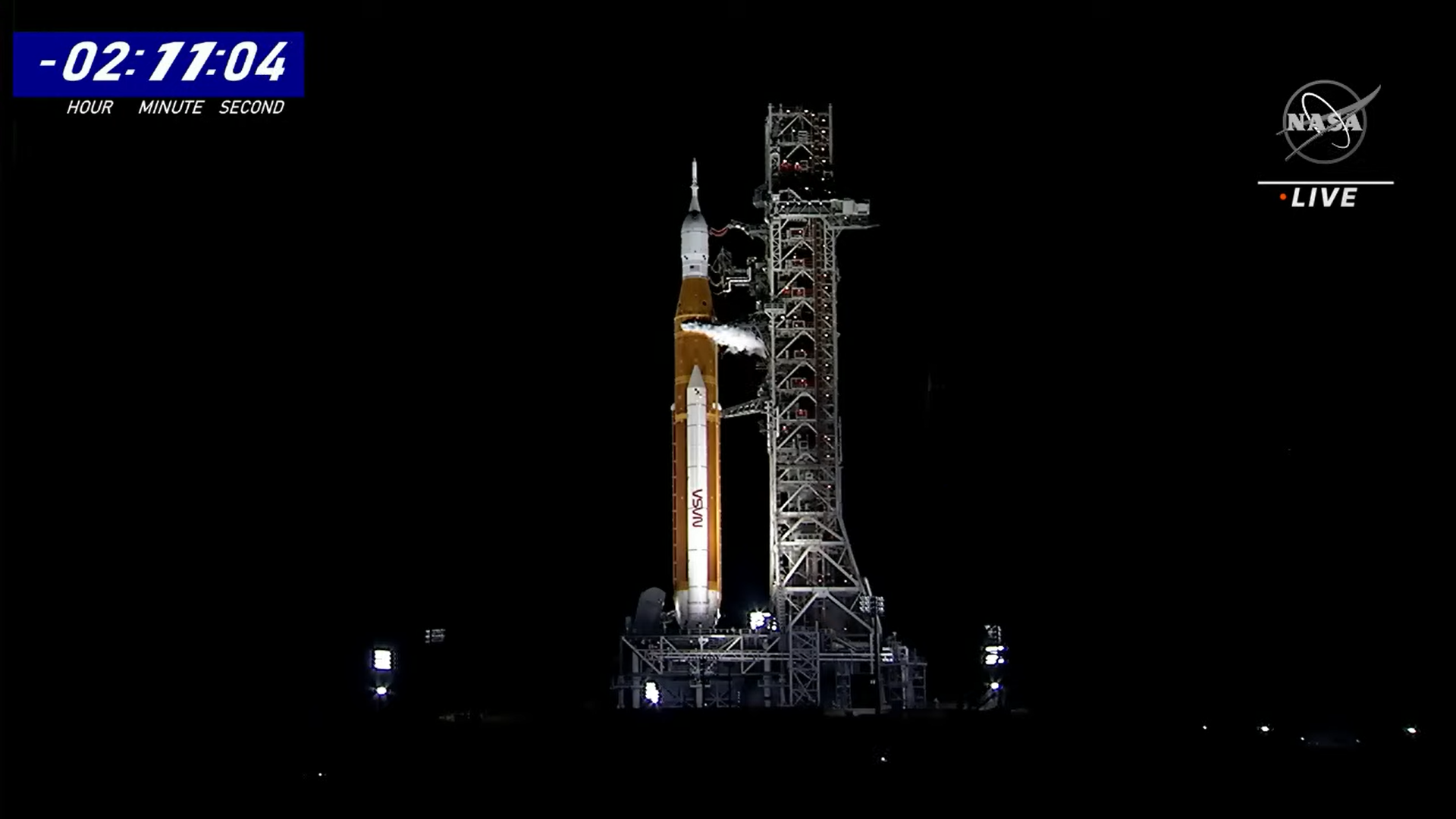
The Artemis 1 mission may take off a little later than hoped, according to NASA personnel.
During the live broadcast, NASA spokesperson Derrol Nail spoke with assistant launch director Jeremy Graeber for more details about the status of the fueling process. As of a bit more before 6 a.m. EDT, the team has begun filling the SLS Interim Cryogenic Propulsion Stage, which sits atop the core stage.
That work came after launch personnel announced that the core stage's liquid oxygen and liquid hydrogen fuel tanks are both fully filled, a key milestone in preparation for launch.
"We are fully loaded on both the liquid oxygen and liquid hydrogen tanks on the core stage, which is great, that puts us in a really good configuration moving forward," Graeber told Nail during the live broadcast.
Fueling the core stage had encountered a slight hiccup when teams noticed what appeared to be a liquid hydrogen leak. However, the launch team is now cautiously optimistic that a quick response — entering what the team calls "revert" mode, tracing the leak, manually initiating a slow fill and then gradually increasing the pace of fueling — addressed the issue.
"We have not had an increase in that leak throughout the rest of that fill, and now that we're at core stage replenish, we're in really great shape," Graeber said. "Now we're moving forward."
That said, the leak combined with a one-hour delay due to weather issues early in the fueling window may mean that the Artemis 1 mission won't be able to lift off quite at 8:33 a.m. EDT (12330 GMT), the beginning of the launch window. Graeber declined to estimate how much the launch might be delayed, citing "quite a lot of work" before a planned 30-minute hold at what mission personnel dub T-10, during which mission personnel will assess the launch schedule.
"We will look at all the work, determine where we stand, and then we will establish a new T-0 at that time," Graeber said.
— Meghan Bartels
Engineers Troubleshooting Artemis Engine Issue; Possible Crack
Launch teams are troubleshooting issues with Artemis 1 – the first test flight of NASA's mighty Space Launch System (SLS) rocket on a mission to carry the Orion spacecraft on a trip to the moon and back.
Engineers are troubleshooting an issue with one of the four RS-25 engines at the base of the rocket's core stage. The 'engine kickstart bleed' - procedure which conditions the engines for launch - is in progress; however, RS-25 engine No. 3 is not producing the required flow rate. Also, a possible crack has been detected in a flange on the 'intertank', which connects the liquid hydrogen and liquid oxygen tanks.
Liftoff of Artemis 1 had originally been targeted for 8:33 a.m. EDT (1233 GMT) from the Kennedy Space Center’s historic Launch Complex 39B; however, that launch time will likely slip later into the launch window. A new T-0 launch time will be determined at the planned T-minus 10 minute hold.
Lightning along Florida's Space Coast predicated a delay in the start of tanking – loading the launch vehicle's core stage with liquid hydrogen and liquid oxygen – which has a ripple effect on countdown milestones.
You can watch the launch live online here
Weather forecasts remains positive, with an 80% probability of favorable conditions at the opening of the two-hour launch window, deceasing to 60% towards the end – scattered showers over the Atlantic will increase the possibility of violating the 'cumulus cloud' and ‘flight through precipitation’ weather constraints.
--Roger Guillemette
Launch Team Working To Resolve Artemis 1 Engine Problem; Investigating Possible Crack
The Artemis 1 launch team is continuing to troubleshoot an issue with one of the four RS-25 engines at the base of the Space Launch System rocket's core stage. RS-25 rocket engine No. 3 is not producing the desired flow rate during the 'engine kickstart bleed' procedure, which conditions the four engines for launch. All four rocket engines must be at the proper temperature for launch
Launch crews are also investigating a possible crack in the foam insulation or a flange on the 'intertank', which connects the liquid hydrogen and liquid oxygen tanks.
Liftoff of Artemis 1 had originally been targeted for 8:33 a.m. EDT (1233 GMT) from the Kennedy Space Center’s historic Launch Complex 39B; however, that launch time will undoubtedly likely slip later into the two-hour launch window. A new T-0 launch time will be determined at the planned T-minus 10 minute hold.
Lightning along Florida's Space Coast forced an hour-long delay in the start of tanking – loading the launch vehicle's core stage with liquid hydrogen and liquid oxygen – which has impacted the launch preparations.
You can watch the launch live online here
If NASA is unable to launch today, the agency does have at least two backup days on which to fly Artemis 1 on its mission to the moon. If the agency solves the vehicle issues, it could try to launch again Sept. 2 or Sept. 5, weather permitting.
--Roger Guillemette
Artemis Countdown in Unplanned Hold
The countdown for this morning's Artemis 1 launch attempt is in an unplanned hold at the T-minus 40 minute mark.
One of the Space Launch System's RS-25 rocket engines – Engine No. 3 – is not producing the desired flow rate during the 'engine kickstart bleed' procedure, which conditions the four engines for launch. All four rocket engines must be at the proper temperature for launch.
Liftoff of Artemis 1 had originally been targeted for 8:33 a.m. EDT (1233 GMT) from the Kennedy Space Center’s historic Launch Complex 39B; however, that launch time will slip much later into today's two-hour launch window. A new T-0 launch time will be determined at the planned T-minus 10 minute hold - if the engine problem can be resolved in time.
You can watch the launch attempt live online here
--Roger Guillemette
Artemis 1 Launch Scrubbed Due to Rocket Engine Problem
A problem with one of the four rocket engines that will power NASA's giant new launch vehicle for deep space exploration forced the space agency to call off the booster's much-anticipated launch debut early today.
One of the Space Launch System's RS-25 rocket engines – Engine No. 3 – was not producing the desired flow rate during the 'engine kickstart bleed' procedure, which conditions the four engines for launch. All four rocket engines must be at the proper temperature for launch.
After numerous unsuccessful troubleshooting attempts, the launch team simply ran out of time and could not complete the preparations necessary to launch Artemis 1 before the close of today's two-hour launch window. Engineers will continue to collect test data from the partially-fueled launch vehicle to determine the cause of the rocket engine problem.
NASA had hoped to test this liquid hydrogen engine chilldown procedure during its final launch dress rehearsal in June but was unable to, according to NASA's Derrol Nail. "So this was the first opportunity for the team to see this live in action. It’s a particularly tricky issue to get that temperature dialed in."
The rocket engine problem stalled plans to launch the SLS rocket and its unpiloted Orion spacecraft on an ambitious 42-day test flight around the moon. Liftoff was originally scheduled for 8:33 a.m. EDT (1233 GMT).
The fuel leak was not the only issue NASA faced during Monday's launch countdown. Offshore storms and lightning delayed fueling of the SLS rocket by nearly an hour, forcing launch controllers to work to catch up for lost time. Rain showers were also encroaching upon the launch area at the time of the scrub.
NASA does have at least two backup days on which to fly Artemis 1 on its mission to the moon. If today's vehicle issues can be resolved, NASA could try to launch again Sept. 2 or Sept. 5, weather permitting. The space agency is also keeping a wary eye on several tropical weather systems developing over the warm Atlantic waters that could potentially threaten Florida's east coast.
NASA won't launch today, more to come

NASA has scrubbed its Artemis 1 launch attempt. A post-scrub press briefing is expected in about four hours and will be available to watch here at Space.com.
Read our full story about the scrub>
VP Kamala Harris and NASA administrator Bill Nelson on Artemis 1 launch delay

Shortly after the Artemis 1 scrub, Vice-President Kamala Harris and NASA administrator Bill Nelson both said they aren't worried about the implications.
Harris, speaking to reporters at NASA's Kennedy Space Center where the Artemis 1 launch was scrubbed Monday (Aug. 29), said it had taken decades of work to come to this launch attempt. She thanked NASA employees for their service so far.
The Vice President said the work on Artemis 1 was a tribute to "these exceptional public servants, these exceptional skilled professionals who have the ability to see what is possible, and what has never been done before."
Nelson, speaking on NASA Television, reminded viewers that his own space shuttle launch in January 1986 was scrubbed four times before a successful launch. He emphasized that Artemis 1, as a test launch, is meant to assess the system to its limits to get ready for humans on future missions.
"We are stressing and testing this rocket and the spacecraft in a way that you would never do with a human crew on board. That's the purpose of a test flight," he said, noting NASA would "work the problem" to get ready for the next launch attempt.
Full story: VP Harris and NASA chief unconcerned by Artemis 1 launch delay

Elizabeth Howell (Ph.D.) has covered five successful human spaceflight missions and two launch scrubs on site from Kazakhstan and Florida. One of those scrubs, STS-115 in 2006, was initially delayed to a tropical storm and sent back to NASA's Vehicle Assembly Building (VAB) at the Kennedy Space Center. After the tropical storm path shifted, Howell witnessed when STS-115's shuttle was turned back to the launch pad midway through its journey to the VAB; this was the only time in the shuttle program's history when such an event occurred.
NASA briefing tonight
NASA has announced that it will hold a briefing about Artemis 1 tonight at 6 p.m. EDT (2200 GMT) after yesterday's scrub. Speakers will include Mike Sarafin, Artemis mission manager; Charlie Blackwell-Thompson, Artemis launch director; and John Honeycutt, manager, Space Launch System (SLS) Program.
NEW ARTEMIS 1 LAUNCH DATE: Sept. 3
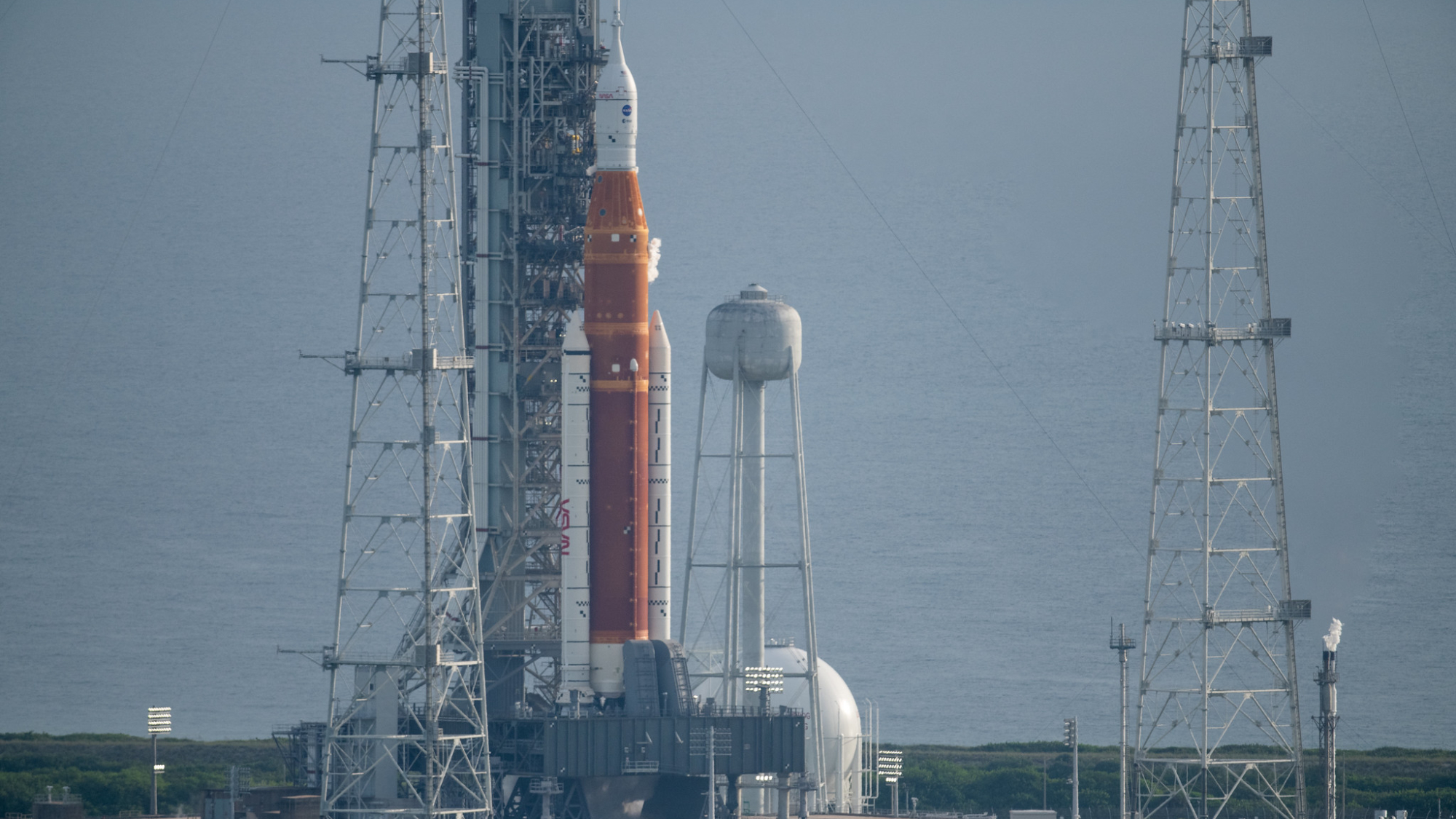
NASA has set a new launch date for the Artemis 1 mission to the moon.
The Space Launch System and its Orion spacecraft will now launch no earlier than Saturday, Sept. 3, at 2:17 p.m. ET (1417 GMT) at the start of a two-hour launch window. There is a 60% chance of good weather at launch time. A full story on this change will be posted shortly.
NASA will do some work on the SLS core booster to address a hydrogen leak detected during the launch countdown. Launch controllers will also begin the chill down of the SLS rocket's four main engines earlier than during Monday's countdown in order to make sure they reach the right temperature of -420 degrees Fahrenheit for launch. That approach was successfully tested during tests at the Stennis Space Center in Mississippi.
If NASA cannot launch on Sept. 3 due to weather, the agency will aim for a backup launch date on Sept. 5.
Weather 60% 'go' for Artemis 1, 6 pm ET briefing
NASA's Artemis 1 mission has a 60% chance of good weather for the opening of its next launch window on Saturday, Sept. 3, at 2:17 p.m. EDT (1817 GMT).
"While rain showers are expected in the area, they are predicted to be sporadic during the launch window," NASA officials wrote in an update Wednesday.
Today (Sept. 1), Artemis 1 mission managers are meeting to review the mission's launch readiness, including the status of its Space Launch System and Orion spacecraft. NASA will hold a press conference at 6 p.m. ET (2200 GMT) today. You can watch that live at start time online.
NASA will resume its Artemis 1 launch countdown on Saturday at 4:37 a.m. EDT (0837 GMT). Fueling coverage will begin at 5:45 a.m. EDT (0945 GMT).
One day to Artemis 1 launch
CAPE CANAVERAL, Fla. -- NASA is one day away from launching the Artemis 1 moon mission from NASA's Kennedy Space Center here at Launch Pad 39B.
You can watch a live press conference at 9 a.m. EDT (1300 GM) to see the latest weather and launch countdown update.
The launch remains set for Saturday, Sept. 3, at 2:17 p.m. EDT (1817 GMT).
Watch live: Space.com editor-in-chief Tariq Malik talks Artemis 1
Space.com editor-in-chief Tariq Malik is on the scene at NASA's Kennedy Space Center in Florida following the agency Artemis 1 mission.
At 3:30 p.m. EDT (1930 GMT), check out his discussion about the Space Launch System megarocket and Artemis 1 at this link.
The mission is go to launch no earlier than Saturday (Sept. 3) at 2:17 p.m. EDT (1617 GMT) on a mission to test SLS and the Orion spacecraft around the moon.
It's Launch Day for Artemis 1
It's launch day for NASA's Artemis 1 moon mission and flight controllers have given the "go" for tanking the massive Space Launch System rocket. Weather permitting, fueling will begin around 5:45 a.m. EDT (0945 GMT). Liftoff remains on track for 2:17 p.m EDT (1817 GMT) today.
NASA's tanking webcast will begin around then and you can watch it on the Space.com homepage.
You can watch it launch live online, courtesy of NASA TV. NASA's official webcast will begin at 12:15 p.m. EDT (1615 GMT).
Happy #Artemis1 launch day, take 2, space fans! It's Game Day, space fans... pic.twitter.com/S9IfKqNdhVSeptember 3, 2022
The #Artemis I mission management team at @NASAKennedy has given the "go" to proceed with tanking. We are now awaiting the decision of Launch Director Charlie Blackwell-Thompson. Stay tuned! pic.twitter.com/O6P6umx650September 3, 2022
Artemis 1 'go' for core stage fueling
NASA launch director Charlie Blackwell-Thompson has given the go-ahead for core stage fueling of the Space Launch System rocket.
"We are go for core stage cryo loading," NASA commentator Derrol Nail said at 5:57 am ET (0957 GMT).
Once fueling begins, it should take up to 4 hours to fill the 32-story SLS rocket with its 730,000 gallons of super-cold liquid oxygen and liquid hydrogen fuel.
NASA tackles fueling pressure issues
NASA has briefly halted its fueling process due to an overpressure warning on its liquid hydrogen vent line. A manual process to use the vent line was set up and the liquid hydrogen flow has resumed.
NASA also detected a pressure issue on the liquid oxygen side and is working to resolve it, says NASA commentator Derrol Nail.
NASA resumes fueling for Artemis 1
The countdown clock is again ticking down toward launch for Artemis 1 as NASA exited a planned 2.5 hour hold.
NASA is now in fast-fill mode for the liquid oxygen supply of Artemis 1's SLS rocket. The SLS rocket holds about 196,000 gallons of liquid oxygen and 537,000 gallons of liquid hydrogen. Slow-fill of liquid hydrogen is under way.
Liquid hydrogen leak detected during fueling
NASA has detected a leak in a liquid hydrogen connection point on the Space Launch System rocket. The leak is in a quick disconnect on the SLS booster, but is in a different area than the leak detected during Artemis 1's Aug. 29 launch attempt.
Launch controllers have stopped liquid hydrogen flow and will let the leaking connector warm up for 30 minutes to try and reseat it for a better seal, NASA's Derrol Nail said.
Fueling resumes for liquid hydrogen
NASA has resumed liquid hydrogen flow for today's Artemis 1 moon rocket tanking. The team lost about 30 minutes during the pause to troubleshoot a fuel leak in the hydrogen supply line of of the Space Launch System's core booster.
Fueling of both liquid hydrogen and liquid oxygen is continuing.
NASA halts liquid hydrogen fueling again
NASA has halted liquid hydrogen fueling again on the Artemis 1 SLS rocket in order to continue troubleshooting work on a fuel leak. During a slow manual fill of the hydrogen, launch controllers detected the leak again.
They'll now stop the hydrogen flow and try to repressurize the line to seal the leak, which is in an 8-inch supply line where it feeds into the massive SLS core booster tank.
Here's a video explanation of the leak:
NASA resumes fueling to check leak fix
NASA has resumed flowing liquid hydrogen through the Space Launch System's main supply line to check if a repressurization cycle has fixed the fuel leak. It is the 2nd try to fix the leak after engineers warmed up the fuel connector, then flowed super-cold liquid hydrogen through it to try and seal the leak earlier. The 2nd test involved closing valves and pressurizing the line with helium to seal the leak.
SLS rocket fuel leak continues despite troubleshooting
NASA's second attempt to plug a fuel leak on the Artemis 1 Space Launch System booster has failed, NASA says.
"The troubleshooting didn't work," NASA commentator Derrol Nail said during live commentary. NASA engineers are now studying options on how else to stop the leak.
The leak is in the engine compartment where an 8-inch liquid hydrogen fuel line feeds into the massive propellant tank. It was detected at 7:15 am ET. Engineers initially warmed the area up, then passed super-cold propellant through it to seal it. When that failed, they closed valves to the SLS and tried to repressurize the line to seal the leak. That also failed, Nail said.
NASA to try again to stop fuel leak
NASA will try again to stop a liquid hydrogen fuel leak on the Artemis 1 Space Launch System rocket. They will try the first method again: stop propellant flow, let the 8-inch SLS hydrogen fuel line warm up for 30 minutes, then resume flowing super-cold liquid hydrogen through it to get it seated.
The team stopped the fueling process 15 minutes ago, so is about midway through the waiting period. NASA has filled up the liquid oxygen tank on the SLS rocket and is in stable replenish for that side.
3rd attempt to stop Artemis 1 fuel leak fails
NASA's third attempt to stop the hydrogen leak on the Artemis 1 Space Launch System's core booster has failed. For this attempt, engineers tried to warm and chill the leaky fuel supply line connector again, but the leak was still present.
"As soon as they resumed flow, when they added any pressure at all, they saw the leak return," NASA commentator Derrol Nail said on NASA TV.
Engineers are now assessing their options. Launch controllers have completed loading the 196,000 gallons of liquid oxygen on the core stage and is preparing to fuel the SLS's upper stage.
Launch team recommends "no go" for Artemis 1
NASA commentator Derrol Nail reports that the Artemis 1 launch team is recommending "no go" for today's Space Launch System launch attempt.
Launch director Charlie Blackwell-Thompson has not yet called an official scrub for the day and is reviewing options for the countdown and mission.
An update is expected shortly.
SCRUB! NASA calls off Artemis 1 launch attempt
NASA Launch director Charlie Blackwell-Thompson has officially called off today's launch attempt of the Artemis 1 moon mission.
"We have a scrub for the day, a cutoff, of the launch attempt for Artemis 1," NASA commentator Derrol Nail said during a live broadcast.
An interview with launch officials is expected shortly on NASA TV. You can watch that live here on Space.com.
NASA begins detanking Artemis 1 rocket
CAPE CANAVERAL, Fla. -- NASA has begun emptying the massive Artemis 1 Space Launch System rocket after today's launch scrub. Read our wrap story on the fuel leak scrub.
The SLS's liquid oxygen supply is currently at 90% and falling as NASA "detanks" the rocket, spokesperson Derrol Nail said during NASA TV commentary.
NASA to discuss Artemis 1 launch scrub
CAPE CANAVERAL, Fla. -- NASA Administrator Bill Nelson is expected to discuss today's Artemis 1 moon launch scrub with commentator Derrol Nail soon on NASA TV. You can watch that live here on Space.com.
The Artemis 1 Mission Management Team will also begin an hours-long meeting to discuss forward plans for the Artemis 1 launch. A post-MMT press briefing is slated for 4 p.m. EDT (2000 GMT), NASA officials have said.
NASA chief Bill Nelson hailed the Artemis 1 launch team and said scrubs are part of the business of space exploration, adding that the mission will only fly when its ready.
"We'll go when it's ready. We don't go until then, and especially now on a test flight," Nelson said in televised comments after the scrub. "This is part of the space business."
NASA Artemis 1 launch briefing at 4:30 pm ET
NASA's Artemis 1 post-scrub briefing will now begin no earlier than 4:30 p.m. EDT (2030 GMT), NASA officials said.
The delay from 4 p.m. ET is due to a late start of the Mission Management Team meeting, where NASA officials are weighing whether to press ahead with a planned launch try on Sept. 5 or 6 or delay until mid-October.
NASA assessing next launch window for Artemis 1
After two scrubbed launch attempts last week, NASA's Artemis 1 Mission Management Team is meeting this week to discuss options for the test flight's next launch attempt.
NASA has several options on the table after a big hydrogen leak forced the agency to call off an attempted launch on Sept. 3.
One option is to fix the leak at the pad and conduct a fuel test, but in order to stay at its Florida launch pad the Artemis 1 rocket would need a waiver from the U.S. Space Force on its Flight Termination System, which must be checked every 25 days to meet safety requirements. That check can only be done inside NASA's Vehicle Assembly Building, where the Artemis 1 Space Launch System rocket was assembled.
If NASA does not get the waiver, the agency could still do the repair and test at the pad, but would have to roll back to the VAB for the systems check, adding weeks of delay. The agency could also wait and do the hydrogen leak repair inside the VAB along with the systems check, then roll back to the pad for the fueling test.
The next launch windows for Artemis 1 run from Sept. 16-Oct. 4 and Oct. 17-Oct. 31.
If Artemis 1 does have to roll back to the VAB, a slip to mid-October may be the best schedule, NASA has said.
NASA Artemis 1 update coming today
NASA will hold a press teleconference today, Sept. 8, at 11 a.m. EDT (1500 GMT) to discuss the plan ahead for the Artemis 1 moon mission. You can follow that briefing on the Space.com homepage.
Currently, NASA plans to fix a hydrogen leak on the core stage of the Artemis 1 Space Launch System atop Pad 39B as it works with the U.S. Space Force on qualification schedules for the rocket's Flight Termination System, which is currently past due for a systems check that would require a rollback to the Vehicle Assembly Building.
NASA targets Sept. 23 for next Artemis 1 launch attempt
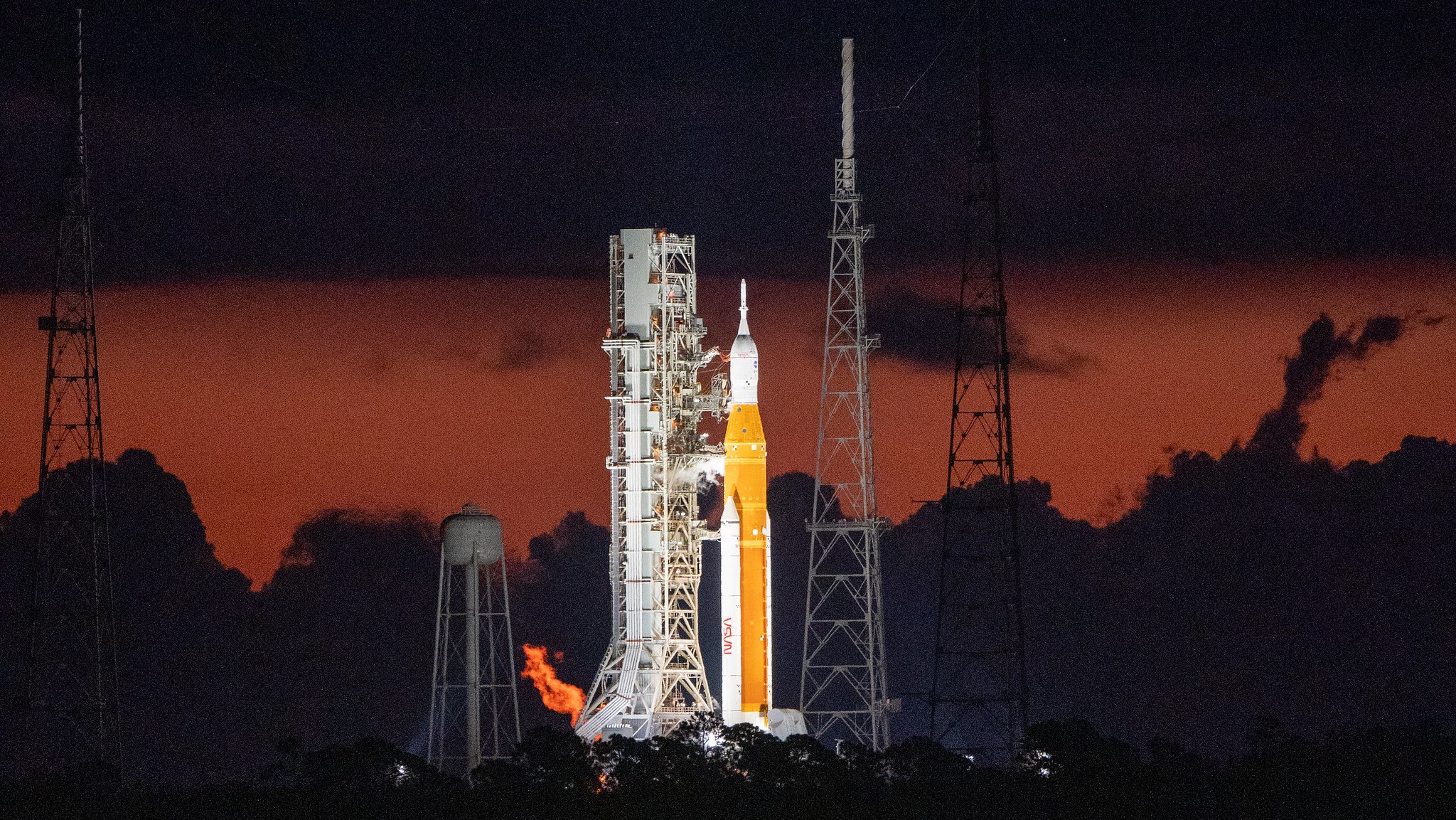
Artemis 1 has a tentative go for Sept. 23, but only if the rocket can meet several requirements. These include fixing a hydrogen leak, passing a fueling test and getting a safety system waiver.
NASA officials did not say just how long of a waiver they are seeking from the U.S. Space Force, which oversees the Eastern Range in Florida that Artemis 1 will use for its launch attempt.
Read more: NASA targets Sept. 23 for next Artemis 1 launch attempt, but a lot has to go right
Leaky seals replaced on Artemis 1 rocket
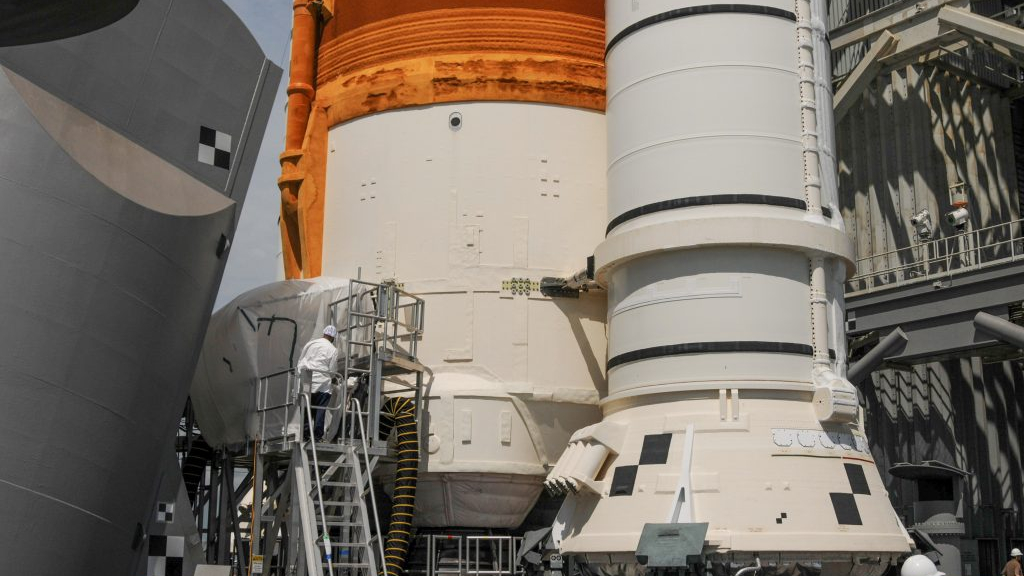
NASA engineers have replaced the leaky seals on the "quick disconnect" fuel line interface of the Artemis 1 Space Launch System rocket to fix issues that prevented a Sept. 3 launch.
Pad technicians replaced the seals on an 8-inch line used to fill and drain liquid hydrogen on the SLS's core booster (the leak that prevented the Sept. 3 launch try) as well as those on a 4-inch line that had a separate leak.
"Coming up, technicians will reconnect the umbilical plates and perform inspections over the weekend before preparing for a tanking demonstration as soon as Saturday, Sept. 17," NASA wrote in an updatelate Friday (Sept. 9). This demonstration will allow engineers to check the new seals under cryogenic, or supercold, conditions as expected on launch day and before proceeding to the next launch attempt. "
NASA aims for Sept. 27 for Artemis 1 launch
NASA is now targeting no earlier than Tuesday, Sept. 27, for the launch of the Artemis 1 moon mission on the first Space Launch System rocket. A backup date is available on Oct. 2. Read our full story here.
The new launch targets are a four-day slip for Artemis 1. NASA was targeting a Sept. 23 launch date, but that was pending repair work on the SLS rocket and a planned Sept. 17 fueling test.
That fueling test is now scheduled for no earlier than Wednesday, Sept. 21, NASA officials said.
"The updated dates represent careful consideration of multiple logistical topics, including the additional value of having more time to prepare for the cryogenic demonstration test, and subsequently more time to prepare for the launch," NASA officials wrote in Monday's blog post(opens in new tab). "The dates also allow managers to ensure teams have enough rest and to replenish supplies of cryogenic propellants."
Here's a look at the launch dates for Artemis as they stand now:
- Sept 27: 70-minute launch window opens at 11:37 a.m. EDT; landing on Nov. 5
- Under review – Oct. 2: 109-minute launch window opens at 2:52 p.m.; landing on Nov. 11
Artemis 1 fueling test update today
NASA will hold a live press teleconference today at 11:30 a.m. EDT (1530 GMT) to discuss a planned fueling test of the Artemis 1 moon rocket. You can follow along with the briefing on our Artemis 1 mission webcasts page.
Here is who will speak during the briefing:
- Tom Whitmeyer, deputy associate administrator for Common Exploration Systems Development, NASA Headquarters
- Mike Sarafin, Artemis mission manager, NASA Headquarters
- Jeremy Parsons, deputy manager, Exploration Ground Systems Program, NASA’s Kennedy Space Center
- John Blevins, chief engineer, Space Launch System Program, NASA’s Marshall Space Flight Center
Artemis 1 fueling test to demo leak fixes
Mission managers with NASA's Artemis 1 moon mission said today that the agency's planned fueling test of its Space Launch System will be a critical test of recent fixes to plug liquid hydrogen leaks.
"Ultimately, we've mitigated everything that we can think of and we will know in 36 hours or 48 hours or so, how effective those mitigations work," John Blevins, NASA's SLS chief engineer of the Marshall Space Flight Center in Huntsville, Alabama, told reporters.
NASA Artemis 1 fueling test begins
NASA is conducting a fueling test of its Artemis 1 moon rocket today, called a "wet dress rehearsal," to test leak repairs to two hydrogen fuel lines and ensure the rocket is fit to fly. You can watch it live and learn about the test in our preview story.
Today's fueling test, which was due to start at 7:15 a.m. EDT (1115 GMT), will run through about 3 p.m. EDT (1900 GMT). It will also test a new "kinder and gentler" fuel loading process that will load the liquid hydrogen into Artemis 1's Space Launch System rocket more slowly than previous efforts. The process will take about 30 minutes longer than in the past and is designed to limit the pressure and temperature strains on the rocket's fuel lines and seals.
NASA sees hydrogen leak again on Artemis 1 rocket
NASA Artemis 1 mission managers detected a liquid hydrogen leak similar to one that forced NASA to call off a Sept. 3 launch attempt during today's fueling test.
The leak was in the same 8-inch quick disconnect that saw the large leak on Sept. 3.
After pausing hydrogen fueling loading, the team warmed the connector and then resumed liquid hydrogen flow. Fueling of liquid hydrogen is now in the fast-fill stage.
Currently, the Artemis 1 rocket's fueling process is 92% complete for liquid oxygen and 24% complete for liquid hydrogen.
After warming up the quick disconnect, or interface where the fuel feed line connects to the rocket, to reseat the connection as part of the troubleshooting plan to fast fill the propellant is now at 24% on the liquid hydrogen side and 92% full for liquid oxygen.September 21, 2022
NASA begins Artemis 1 engine 'kickstart bleed' test
NASA has begun its so-called engine "kickstart bleed" test on the Artemis 1 SLS rocket to chill down the core booster's four main engines to prepare them for their super-cold propellants.
The test, which NASA was unable to perform in its two launch attempts or several fueling tests, will circulate liquid hydrogen through a 4-inch and 6-inch fuel lines to cool the four RS-25 engines on the booster.
Engine 'kickstart bleed' test complete
NASA has officially completed its much sought after engine kickstart bleed test on the Artemis 1 Space Launch System main engines.
During the test, NASA closed a liquid hydrogen vent valve to increase pressure on the lines, which lead to an increase in gaseous hydrogen leak the agency detected earlier. They peaked at 3.4%, which was below NASA's 4% limit, and the test was able to be completed.
The vent valve was then reopened, allowing the pressure and leak to drop as expected. That's a milestone checked off for NASA as fueling continues.
NASA slowly increasing liquid hydrogen fueling
NASA is slowing raising the pressure on its liquid hydrogen flow into the Artemis 1 SLS booster as it tries to manage the leak in the 8-inch line feeding into rocket.
Launch controllers will slowly raise the pressure to return the fueling process to launch day speeds while checking the leak rate in the connector. If the leak rate exceeds the 4% limit for five minutes, NASA will stop the flow, commentator Darrel Nail said on NASA TV.
The SLS rocket is currently 100% full of liquid hydrogen and 83% filled with liquid hydrogen, which is rising.
Artemis 1 core booster fully fueled for test
NASA reports that both the liquid hydrogen and the liquid oxygen tanks on the core stage are fully fueled in today's test. The hydrogen leak detected earlier continues to be manageable.
NASA is now preparing to fill the smaller interim cryogenic propulsion stage, the upper stage of the two-stage SLS rocket.
Both core stage tanks are in replenish and stable. Leak manageable. The team is preparing to load liquid hydrogen into the interim cryogenic propulsion stage (ICPS).September 21, 2022
Artemis 1 rocket upper stage fueling underway
The upper stage of the Artemis 1 rocket is now in "fast fill" to fuel its liquid hydrogen and liquid oxygen tanks in today's tanking test.
The upper stage, known as the Interim Cryogenic Propulsion Stage, is the second stage of the two-stage Space Launch System rocket.
The countdown for the cryogenic demonstration continues. Once ICPS is in stable replenish, engineers will conduct the pre-pressurization test, bringing the core stage liquid hydrogen tank up to the flight pressure it will experience pre-launch.MORE: https://t.co/sZHUlMyNKg pic.twitter.com/2xRKS8uumJSeptember 21, 2022
NASA completes Artemis 1 rocket pre-pressurization test
NASA has completed a hydrogen "pre-press" test to pressurize the Artemis 1 moon rocket's fuel tanks as it would for launch.
The test was "a big accomplishment" for the NASA launch team, said commentator Derrol Nail. The agency did see a leak in a 4-inch hydrogen line at 4%, the limit under the agency's flight rules, and will analyze that.
NASA declares Artemis 1 fueling test a success
NASA has ended its Artemis 1 fueling test, declaring it a success after meeting all test objectives, despite two leaky seals that launch controllers were ultimately able to overcome.
"What they did is they went looked at what are our contingency procedures, what do we have in place? How do we work our way through it?" NASA Artemis 1 Launch Director Charlie Blackwell-Thompson said after the test on NASA TV. "And they went through those ops just as I would expect them to do and and we were successful in managing our way through it."
Blackwell-Thompson said there is more analysis needed before NASA can decide if the Artemis 1 moon rocket is ready to attempt a launch on Sept. 27.
"I don't like to get ahead of the data," Blackwell-Thompson said. "And so I'd like the team to have the opportunity to go look at it to see if there are changes we need to make to our loading procedure, our timelines or if, if we're, you know, good as is."
Our wrap story will be posted to the Space.com homepage shortly.
NASA Artemis 1 press conference today
NASA will hold a press conference today, Sept. 23, at 12:30 p.m. EDT (1630 GMT) to discuss the results of a Sept. 21 fueling test of the Artemis 1 Space Launch System rocket. You can watch it live on Space.com if the feed above keeps refreshing.
NASA fueled the Artemis 1 SLS to test repairs to fix two leaks on the core booster's liquid hydrogen system. While leaks were still detected during the test, NASA says it was able to manage them effectively.
Currently, NASA is targeting no earlier than Sept. 27 to launch the Artemis 1 moon mission. The agency, however, did have to complete the leak repairs, the fueling test and secure a special waiver from the U.S. Space Force to do so.
The agency is expected to give an update on that waiver work, as well as potential weather impacts to the mission, during today's briefing. Here's who will be speaking during the call.
- Tom Whitmeyer, deputy associate administrator, Common Exploration Systems Development, NASA Headquarters
- Brad McCain, vice president and general manager, Jacobs Space Operations Group
- John Blevins, SLS chief engineer, NASA’s Marshall Space Flight Center
NASA stands down from Sept. 27 launch window
NASA announced today that it will not attempt to launch the Artemis 1 moon mission on Sept. 27 due to the impacts of Tropical Storm Ian, which is expected to reach Florida as a major hurricane early next week.
NASA made the decision to skip the launch try even as it weighs whether to roll the mission's 322-foot (98 meters) Space Launch System rocket and Orion spacecraft off its Launch Pad 39B and head to shelter in its Vehicle Assembly Building hangar. NASA will make a final decision on whether to roll back to the hangar on Sunday.
"NASA is foregoing a launch opportunity Tuesday, Sept. 27, and preparing for rollback, while continuing to watch the weather forecast associated with Tropical Storm Ian," NASA said in statement. "During a meeting Saturday morning, teams decided to stand down on preparing for the Tuesday launch date to allow them to configure systems for rolling back the Space Launch System rocket and Orion spacecraft to the Vehicle Assembly Building. Engineers deferred a final decision about the roll to Sunday, Sept. 25, to allow for additional data gathering and analysis. If Artemis I managers elect to roll back, it would begin late Sunday night or early Monday morning."
Hurricane Ian forces Artemis 1 back to shelter

Hurricane Ian, which is expected to make landfall Thursday (Sept. 29) and affect the Artemis 1 Floridian launch pad, caused NASA to decide to roll back the Space Launch System (SLS) megarocket to shelter, the agency said via a blog post Monday (Sept. 26).
Artemis 1 was supposed to lift off for the moon Oct. 2 following a recent delay induced by the hurricane; now, it will roll back to the nearby Vehicle Assembly Building and is not expected to be authorized for another launch until at least mid-October.
Read more: Artemis 1 will roll off launch pad to ride out Hurricane Ian
Artemis 1 back in Vehicle Assembly Building
Artemis 1 is inside the Vehicle Assembly Building, according to live views from the livestream showing the rollback. NASA is expected to hold a media briefing today (Sept. 27) around 2 p.m. EDT (1800 GMT) at www.nasa.gov/live.
Artemis 1 in shelter as Hurricane Ian hits Florida
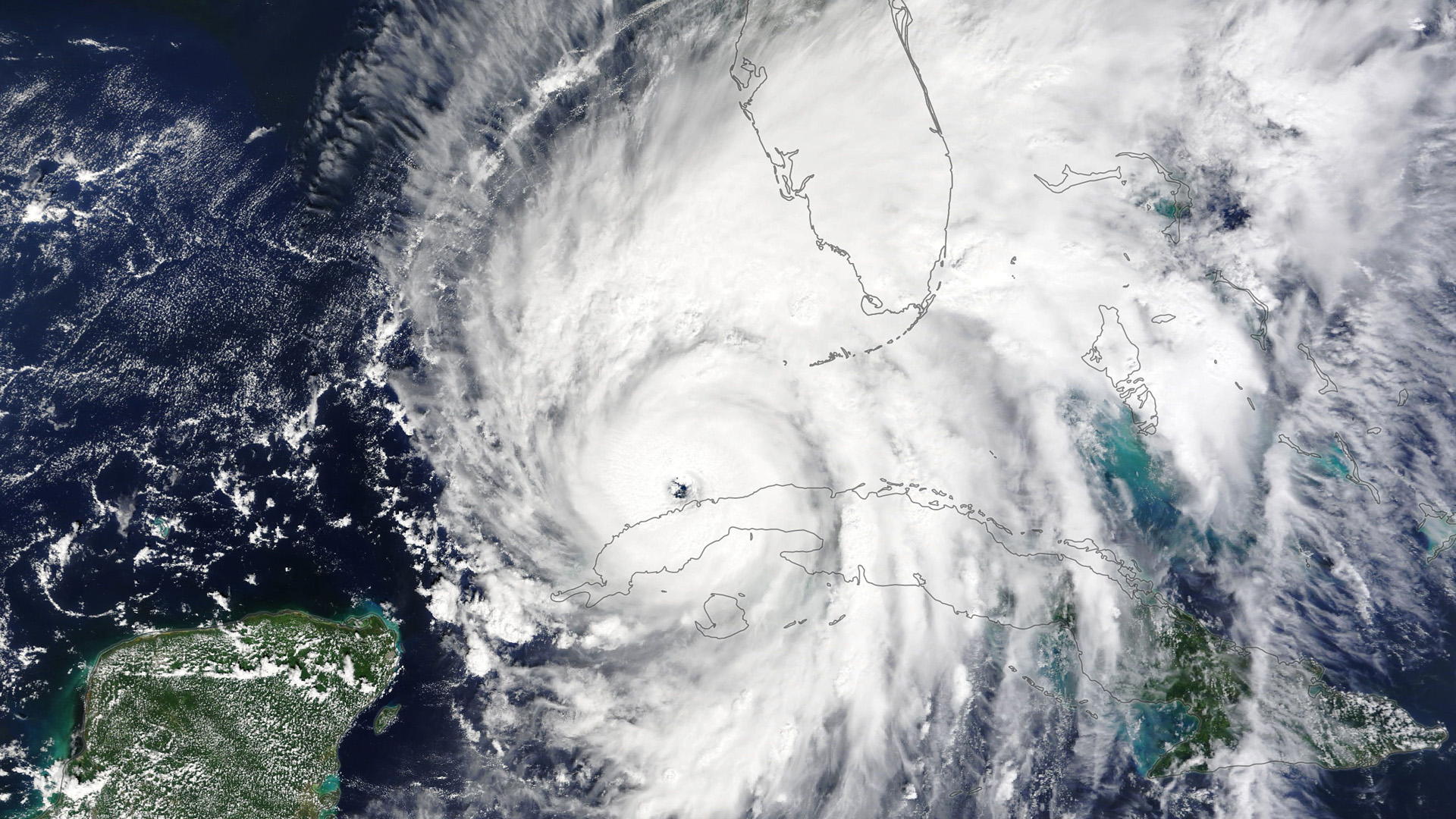
The agency's Artemis 1 stack, including the Space Launch System (SLS) megarocket, rolled back to shelter Tuesday (Sept. 27) ahead of Hurricane Ian, which has been described by officials as potentially "catastrophic" for Florida, which includes its launch pad at the Kennedy Space Center.
"As #HurricaneIan intensifies and folks prepare for its impact, I'm thinking of our @NASA workforce and families in Florida, especially those on the @NASAKennedy ride-out team. Thank you for your dedication. Know that NASA will do everything to ensure your safety and wellbeing," NASA administrator Bill Nelson wrote on Twitter Wednesday (Sept. 28).
The next opportunity will likely be no earlier than November, although NASA said in a press conference that numerous options are on the table depending on weather, the safety of teams and the readiness of the rocket.
Read more: As Hurricane Ian closes in, NASA weighs options for Artemis 1 moon rocket launch
Artemis 1 launch delayed to mid-November
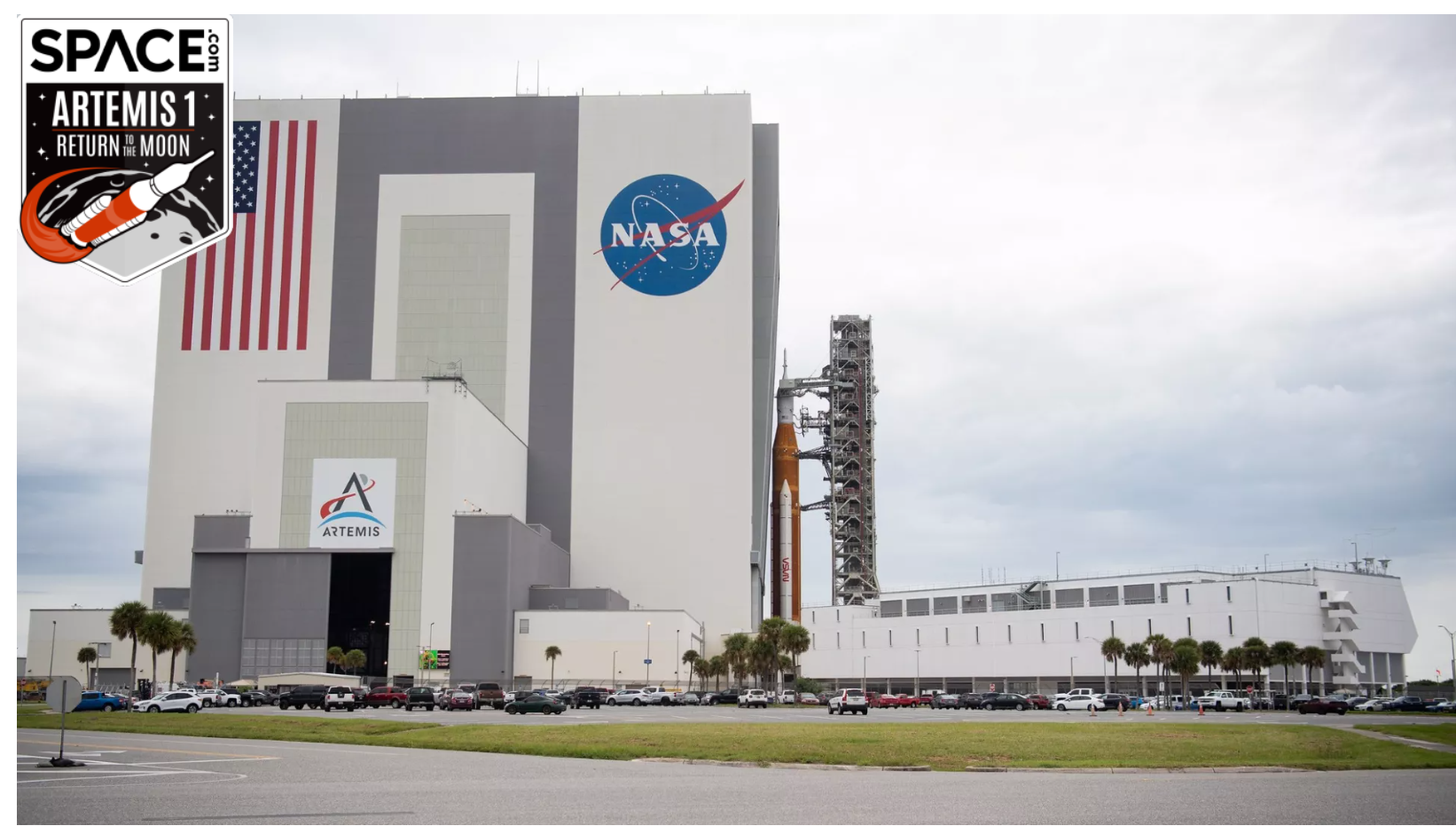
NASA's Artemis 1 mission to the moon has been delayed to no earlier than Nov. 12 due to the impacts of Hurricane Ian at the Kennedy Space Center this week, the agency announced today. Read our full story on the new delay.
NASA rolled the Artemis 1 moon rocket, its first Space Launch System megarocket, into the cavernous Vehicle Assembly Building for safekeeping ahead of Ian's arrival at the Cape Canaveral spaceport this week. The Artemis 1 rocket and its Orion capsule were not damaged, and NASA reported minimal damage to the space center, though some minor water intrusion to some facilities was reported.
"Focusing efforts on the November launch period allows time for employees at Kennedy to address the needs of their families and homes after the storm and for teams to identify additional checkouts needed before returning to the pad for launch," NASA officials wrote in today's update.
NASA now targeting Nov. 14 Artemis 1 moon launch
NASA has set a new launch date for Artemis 1 on Nov. 14 following an expected rollout Nov. 4. The mission will have a 69-minute launch window that opens at 12:07 a.m. EST (1707 GMT) on Nov. 14, during which it will attempt to send the Orion crew capsule to lunar orbit, NASA stated in an update today (Oct. 12).
NASA has also requested a pair of two-hour backup launch windows, for Nov. 16 at 1:04 a.m. EST (0604 GMT) and Nov. 19 at 1:45 a.m. EST (0645 GMT). Should the mission go on Nov. 14, that launch would result in a mission duration of about 25.5 days with splashdown occurring on Dec. 9.
Read more: NASA now targeting Nov. 14 for Artemis 1 moon launch
One week remains before Artemis 1 re-rolls to the pad
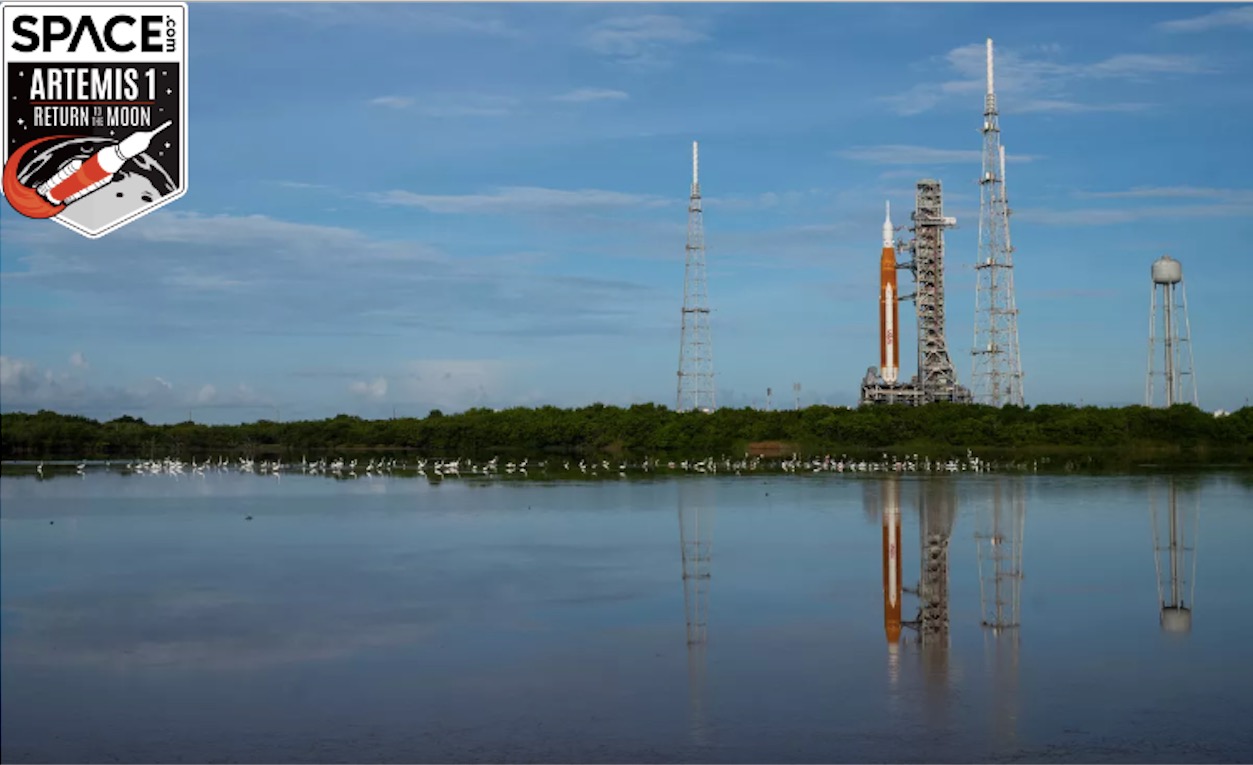
Artemis 1 is almost ready to return to its launch pad. The massive Space Launch System rocket stack, which includes an uncrewed Orion spacecraft, remains on track to return to Launch Pad 39B on Friday, Nov. 4 at NASA's Kennedy Space Center.
NASA may send Artemis 1 to the moon as soon as Nov. 14, and in the meantime the agency has made more orders of Artemis program equipment. There are now three more Orion crew capsules coming from aerospace giant Lockheed Martin, in a deal worth $1.99 billion covering Artemis 6 through 8.
Read more: NASA orders 3 more Orion crew capsules for Artemis moon missions
New Launch Date: NASA targets Nov. 16 for Artemis 1
NASA is now targeting Wednesday, Nov. 16, for the historic Artemis 1 moon rocket launch from Pad 39B at the Kennedy Space Center in Florida. Liftoff is now set for 1:04 a.m. EST (0604 GMT).
NASA delayed the launch from its earlier Nov. 14 target due to the potential impact of Tropical Storm Nicole, which threatened high winds, rain and other harsh conditions at Artemis 1's launch site. The storm made landfall in eastern Florida today (Nov. 10).
So far, the Artemis 1 moon rocket appears to be still standing, according to live views from NASASpaceflight, but NASA has yet to provide a status update on any impact the storm may have.
NASA's currently window to launch Artemis 1 runs through Nov. 19, with attempts possible on Nov. 16 and Nov. 19.
NASA to repair 'minor damage' at Artemis 1 launch pad
NASA engineers are working to repair some damage from Tropical Storm Nicole at the Artemis 1 moon rocket's Launch Pad 39B as the agency assesses its plans for launch.
Jim Free, NASA's associate administrator for Exploration Systems Development, said engineers will make "minor repairs" to the rocket or pad and conduct a power-on test.
"Our @NASAGroundSys team regained access to the pad last night after the storm passed to survey @NASA_SLS & @NASA_Orion," Free wrote on Twitter. "Our employees are our top priority as Florida recovers. Today, we'll conduct a power-on test, make minor repairs, & continue preparing for #Artemis I's launch."
At 3 p.m. EST (2000 GMT) today, NASA will hold a live webcast to discuss the repairs and impact of Tropical Storm Nicole on the Artemis 1 mission's planned launch date, which is currently set for Nov. 16. You can follow that briefing live on Space.com's homepage.
Our @NASAGroundSys team regained access to the pad last night after the storm passed to survey @NASA_SLS & @NASA_Orion. Our employees are our top priority as Florida recovers. Today, we'll conduct a power-on test, make minor repairs, & continue preparing for #Artemis I's launch. pic.twitter.com/efHscY8D7ZNovember 11, 2022
Artemis 1 still working to Nov. 16 launch
In a press conference today, NASA's Jim Free, associate administrator for Exploration Systems Development, said the agency is still aiming to launch its Artemis 1 moon mission on Nov. 16, even as engineers are assessing the impacts of Tropical Storm Nicole on the rocket this week.
Free said engineers are making "minor repairs" on the rocket, and that at no time did wind speeds exceed the rocket's tolerances at the height levels where restrictions were in place.
Free did say that the tropical storm strengthened unexpected from forecasts earlier in the week. At some points, wind gusts of over 100 mph were registered at the pad, but not at the levels of the rocket where it would have posed a concern for the rocket, NASA officials have said.
NASA would likely not have rolled the Artemis 1 moon rocket out of the Vehicle Assembly Building last week if it had known Tropical Storm Nicole, which made landfall in Florida as a Category 1 hurricane, would have been as severe as it was.
A Nov. 16 launch would liftoff at 1:04 a.m. EST (0604 GMT).
NASA engineers checking Artemis 1 rocket
NASA engineers are working today to conduct additional checks on the Artemis 1 moon rocket after its lashing by Tropical Storm Nicole earlier this week. The rocket remains on track for its Nov. 16 launch to the moon, NASA has said.
"Technicians also are working to fix several minor items from the storm. Most repairs involve loose caulk or weather coverings. An umbilical used to provide purge air, or proper environmental conditions to the Orion spacecraft, was out of position," NASA wrote in an update on Friday (Nov. 11). "The umbilical maintained purge throughout the storm and has been repositioned to allow proper retraction at liftoff. Engineers have also removed the hard cover over the launch abort system window installed before the storm and will inspect the window to confirm it is in good condition for launch."
A series of power-up checks are scheduled for today. On Sunday, the team will perform final software and hardware checks on the vehicle.
NASA discusses Artemis 1 launch date for Nov. 16
NASA mission managers are meeting today in a so-called Mission Management Meeting to decide whether to proceed with a planned Nov. 16 launch of the Artemis 1 moon rocket, even as engineers continue final tests to ensure the rocket and its Orion spacecraft are ready after being slammed by a tropical storm.
Artemis 1 mission managers are expected to spend the day evaluating launch options for Artemis 1 and hold a press conference tonight at 7 p.m. EST (0000 GMT). You can watch that press conference live on Space.com at start time.
Meanwhile, engineers are performing some final checks on the vehicle.
"Engineers plan to conduct the standard final software and hardware-related tests required before launch, on Sunday," NASA wrote in a Friday update.
NASA still go for Nov. 16 Artemis 1 launch
NASA mission managers said late last night that the Artemis 1 moon rocket is still "go" for a planned launch, despite minor damage caused by Hurricane Nicole, which battered the rocket with strong winds and rain last week when it hit the Space Coast as a tropical storm.
Space.com Spaceflight Editor Mike Wall has the full story from Artemis 1 mission managers, who said engineers are studying the loss of a layer of caulk on the Orion spacecraft that was ripped off by the storm. The caulk is meant to to smooth out indentions on the Orion capsule during the aerodynamic stresses of launch and cannot be fixed at the launch pad.
Meanwhile, some other systems that can be repaired at the pad do have redundancies.
The mission management team will meet gain today, Nov. 14, to discuss these open issues as they work to decide if Artemis 1 can actually attempt its next launch try at 1:04 a.m. EST (0604 GMT) on Nov. 16.
Weather 90% 'go' for Artemis 1 launch, NASA weighs plan
The weather forecast for NASA's planned Artemis 1 moon rocket launch has improved to a pristine 90% chance of clear skies for early Wednesday, Nov. 16, at 1:04 a.m. EST (0604 GMT).
The Artemis 1 Mission Management Team, meanwhile, is currently meeting to discuss the launch plan in the wake of minor damage to the rocket caused by Hurricane Nicole.
NASA plans to host a teleconference on its launch plan tonight, beginning no earlier than 6:30 pm EST (2330 GMT). You can listen in live on Space.com and on our Artemis 1 webcast page.
NASA prepares to launch Artemis 1 moon rocket!
Late Monday, NASA mission managers officially gave the go-ahead to launch its first-ever Space Launch System rocket on the Artemis 1 moon mission. Liftoff is set for Nov. 16 (that's tomorrow) at 1:04 a.m. EST (0604 GMT). There is a 90% chance of good weather at launch time. Space.com Editor Brett Tingley is live at NASA's Kennedy Space Center for the launch.
If you're planning to watch the entire event, you've got a long night ahead.
NASA's webcast will begin at 3:30 p.m. EST (2030 GMT) with live views of fueling as the launch team fills the SLS rocket with its 730,000 gallons of propellant.
The main webcast will begin at 10 p.m. EST (0200 Nov. 16 GMT) and run through liftoff. NASA has a full two-hour window in which to launch the mission, so liftoff could occur as late as 3:04 a.m. EST (0804 GMT).
One hour after launch, NASA will hold a press conference on the mission's status.
You can see all the Artemis 1 moon rocket launch livestream events in our guide to watching it live.
NASA prepares to fuel Artemis moon rocket
All systems appear to be performing well as NASA prepares to fuel the Artemis 1 moon rocket for its launch overnight.
At 3:30 p.m. EST (2030 GMT), NASA is expected to begin livestreaming its fueling process, but it is a slow process that will take hours. The activity begins with the chill-down of fuel lines that will funnel the super-chilled liquid hydrogen and liquid oxygen propellant. Once complete, NASA will begin slow-filling the fuel in stages.
If that process goes well, NASA will then start "fast-filling" to get the Space Launch System rocket tanked up with the 730,000 gallons of propellant it needs for launch.
Even with this massive amount of propellant, most of the SLS rocket's thrust at liftoff will come from its twin solid rocket boosters, five-segment boosters based on space shuttle parts.
NASA Artemis 1 fueling webcast begins, weather 80% go
NASA has begun streaming live views of the Artemis 1 Space Launch System fueling, which will fill the 322-foot rocket with vital liquid hydrogen and liquid oxygen it propellant it needs to launch toward the moon. You can watch the fueling webcast live on Space.com's livestream guide, as well as on our homepage.
The weather outlook has deteriorated slight for tonight's launch, slipping from a pristine 90% chance of good weather to an 80% chance of fair conditions.
NASA 'Go' for fuel loading
NASA has officially begun the hours-long fueling process for the Artemis 1 moon rocket after giving the 'go' for propellant loading, a process NASA calls tanking. Launch controllers are currently working to chill down the fuel lines for fueling.
The fueling of the Artemis 1 Space Launch System will load the massive rocket with more than 750,000 gallons of super-cold liquid hydrogen and liquid oxygen. It Currently, the launch countdown in the middle of a built in hold at the 6-hour, 40-minute mark. It was expected to last about 3.5 hours.
Liquid hydrogen fueling begins for Artemis 1
Fueling has officially begun for Artemis 1. NASA spokesperson Derroll Nail said liquid hydrogen is now flowing into the massive tank on the Space Launch System rocket in the "slow-fill" stage. Meanwhile, launch controllers have begun the chill-down of the the rocket's liquid oxygen lines.
The SLS rocket holds about 537,000 gallons of liquid hydrogen, which makes up the build of its 750,000 gallons of propellant. The rest is liquid oxygen to serve an oxidizer.
Artemis 1 rocket liquid oxygen in fast-fill
NASA Artemis 1 launch controllers have begun the "fast-fill" process to load up liquid oxygen propellant on the Space Launch System rocket. The milestone was reached at about 4:49 p.m. EST (2149 GMT), NASA's Derrol Nail said in live commentary.
Liquid hydrogen fueling continues on its "slow-fill" process. NASA is intentionally fueling the liquid hydrogen slower than usual as part of a "kinder, gentler method" to avoid the leaks that marred earlier launch attempts.
Artemis 1 moon rocket now in fast-fill for liquid hydrogen
NASA's Artemis 1 Space Launch System is now in "fast-fill" mode to load the 537,000 gallons of liquid hydrogen it will need for launch. This stage is where NASA saw some fuel leaks during previous tankings during launch attempts in August and September.
Since then, NASA has developed a slower "kinder, gentler" fueling method to avoid such leaks. That approach, which was tested in a fueling check in September, will be put to its biggest test yet today.
Artemis 1 fueling hits critical milestone, night visibility map
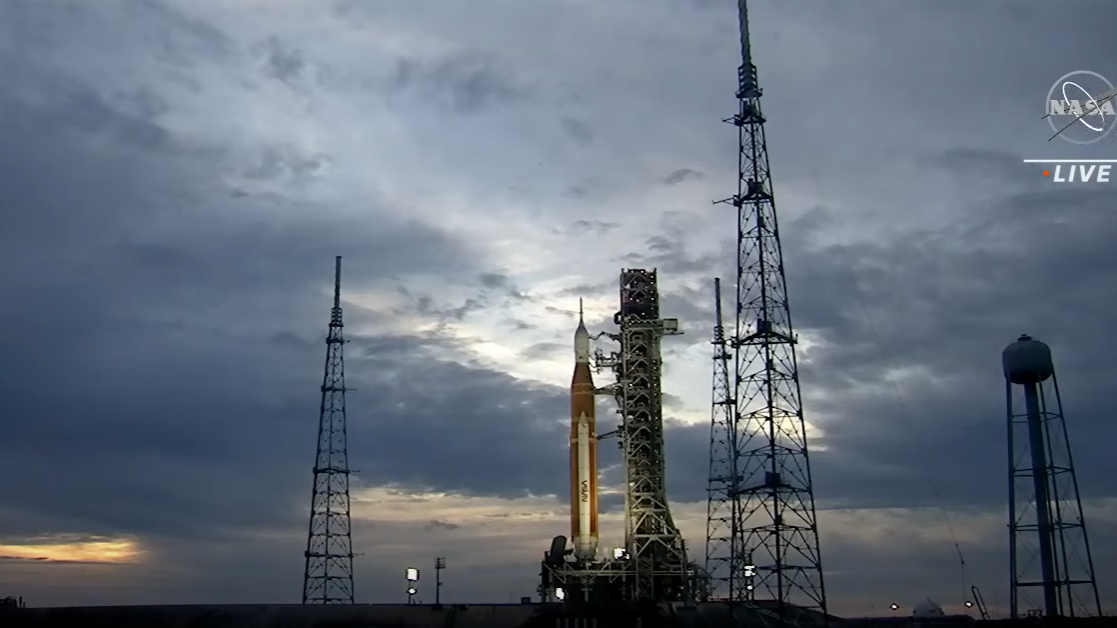
Launch controllers have completed a critical "engine bleed test" to chill the fuel lines to the Artemis 1 moon rocket's four RS-25 engines ahead of launch. The test, which flows cold hydrogen propellant through the lines, prepares the fuel plumbing for the super-cold liquid hydrogen.
The process appears to be going well. It was temperature issues in this test that scrubbed the 1st launch attempt on Aug. 29. Some fuel leaks at this stage also scrubbed a Sept. 3 launch try. NASA did detect a slight leak, but it was within the acceptable margins, NASA says.
Meanwhile, now that NASA is launching the Artemis 1 mission at night, there is a chance for you to see it in the night sky if you live in the Florida area. NASA has released a visibility map for skywatchers hoping to see the rocket.
Read the full story from Space.com's Brett Tingley at NASA's Kennedy Space Center.
You can also watch the launch in VR with Felix & Paul's "Artemis Ascending" using an Oculus Quest starting at 12 am ET.
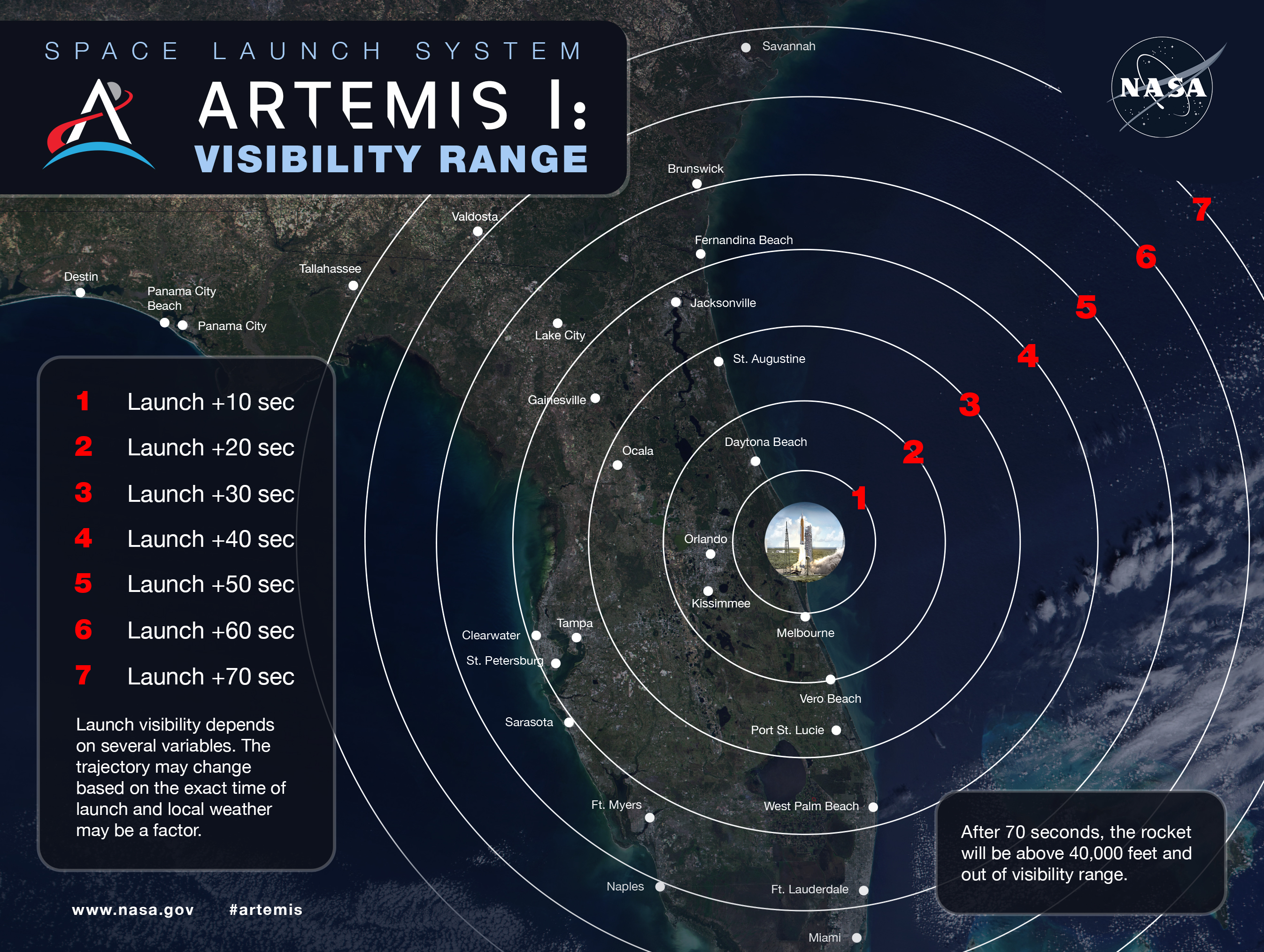
Artemis 1 fueling continues
Fueling of the Artemis 1 moon mission's huge Space Launch System (SLS) rocket continues to proceed apace. The roughly six-hour process began at around 4:30 p.m. EST (2130 GMT); two hours in, the SLS core stage's liquid hydrogen tanks were 100% full, marking the end of the "fast fill" stage. The core stage's liquid oxygen tanks were 62% of the way there, according to a graphic NASA provided on its webcast.
Artemis 1 is scheduled to launch during a two-hour window that opens at 1:04 a.m. EST (0604 GMT) on Wednesday (Nov. 16). Follow the action leading up to the liftoff, and watch the launch itself, here at Space.com.
You can also watch the launch in 360-degree VR, beginning at midnight EST (0500 GMT). Learn how here.
Artemis 1 core stage's propellant tanks now full
Fueling of the Artemis 1 moon mission's Space Launch System (SLS) rocket hit a big milestone at 7:37 p.m. EST on Tuesday (Nov. 15; 0037 GMT on Nov. 16), about three hours into the process: The SLS core stage's liquid oxygen and liquid hydrogen tanks are both now 100% full.
That doesn't mean fueling is complete, however; the Artemis 1 team must still load the SLS upper stage and continue to replenish the core stage tanks. Indeed, the entire fueling process is expected take about six hours.
Artemis 1 remains on track for liftoff early Wednesday (Nov. 16), during a two-hour window that opens at 1:04 EST (0604 GMT). Watch the remaining preparations and the launch here at Space.com, courtesy of NASA.
Fueling of SLS upper stage moves ahead, weather 90% go
The upper stage of NASA's Artemis 1 Space Launch System rocket is now in "fast fill" of liquid oxygen as NASA works to top off the Interim Cryogenic Propulsion Stage for tonight's launch. Liftoff remains on track for 1:04 a.m. EST (0604 GMT).
The weather outlook has improved, returning to a 90% chance of good launch weather after dropping to 80% earlier today, NASA's Derrol Nail reports.
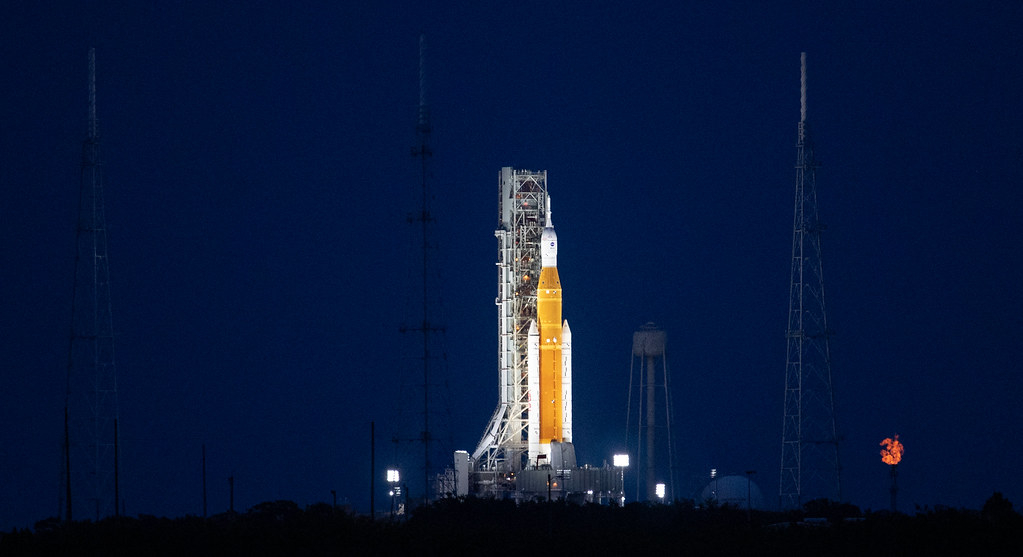
Fuel leak detected on SLS core stage
NASA has detected an "intermittent leak" of liquid hydrogen in the replenish valve on the core stage of the Artemis 1 Space Launch System rocket. Launch controllers have stopped liquid hydrogen flow into the core stage as it is reviewed.
Mission managers are preparing a "Red Crew" to head out to the launch pad to torque down connectors at the base of the rocket to try and fix the leak. The Red Team is a crew trained to work on a rocket while it is fueled or being fueled, NASA says.
NASA 'Red Crew' addressing SLS rocket fuel leak
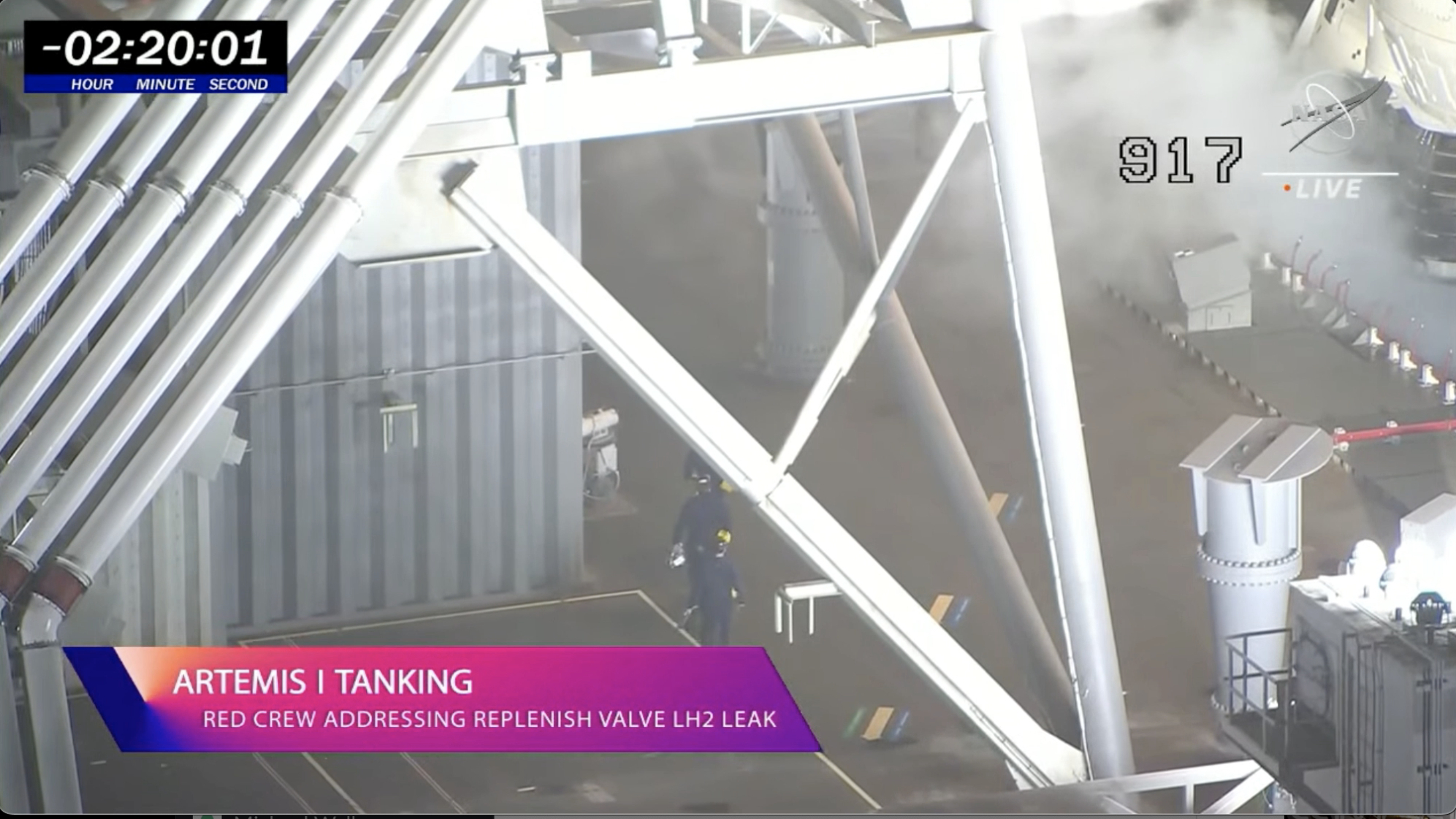
NASA's Artemis 1 Red Crew has reached the Launch Pad 39B where they are tightening down some packing nuts in an attempt to stop a fuel leak in the replenishment valve for liquid hydrogen propellant on the SLS core stage.
In the photo above, you can see the Red Crew working near the site, with the large RS-25 engines of the core stage visible in the right of the frame.
At 10:30 p.m. EST, NASA will begin its official livestream for the Artemis 1 mission. This is a milestone for NASA, which was never able to start its official webcast during the previous two attempts due to fueling issues.
Technicians Dispatched to Fix Hydrogen Leak
NASA Television has started its live launch coverage of tonight’s launch attempt of Artemis 1 – the first test flight of NASA's mighty Space Launch System (SLS) rocket on a mission to carry the Orion spacecraft on a trip to the moon and back.
The launch team detected an "intermittent leak" of liquid hydrogen in the replenish valve on the core stage of the Artemis 1 Space Launch System rocket. Launch controllers have stopped liquid hydrogen flow into the core stage.
Mission managers have dispatched a "Red Crew" to the launch pad to torque down ‘packing nuts’ on a hydrogen replenish valve in an attempt to fix the leak. The ‘Red Team’ is a crew trained to work on a rocket while it is fueled or being fueled.
"It is a hazardous operation inside the blast danger area," NASA launch commentator Derrol Nail said during a livestream of the Artemis 1 fueling operations tonight (Nov. 15).
Liftoff of Artemis 1 remains targeted for 1:04 AM EST (0604 GMT) from the Kennedy Space Center’s historic Launch Complex 39B; however, the launch time may very well slip later into the two-hour launch window.
Weather is not a concern this evening, with a 90% probability of acceptable conditions throughout the launch window.
You can watch the launch live online here:
-- Roger Guillemette
Liquid Hydrogen Replenish Resumes For Artemis 1 Launch
The launch team has resumed replenishing liquid hydrogen to the launch vehicle for tonight's launch attempt of Artemis 1 – the first test flight of NASA's mighty Space Launch System (SLS) rocket on a mission to carry the Orion spacecraft on a trip to the moon and back.
Earlier, the launch team detected an "intermittent leak" of liquid hydrogen in the replenish valve on the core stage of the Artemis 1 Space Launch System rocket. Launch controllers then stopped liquid hydrogen flow into the core stage.
A "Red Crew" was dispatched to the launch pad to torque down ‘packing nuts’ on the valve in an attempt to fix the leak.
To add to the drama, the U.S. Space Force Eastern Range has advised NASA that it is currently ‘Red’ or No-Go for launch due to the loss of signal from one of its radar sites.
Liftoff of Artemis 1 remains targeted for 1:04 AM EST (0604 GMT) from the Kennedy Space Center’s historic Launch Complex 39B; however, the launch time will likely slip later into the two-hour launch window.
Weather is not a concern this evening, with a 90% probability of acceptable conditions throughout the launch window.
-- Roger Guillemette
Artemis 1 Countdown Holding at T-minus 10-minutes
The Artemis 1 launch team is evaluating a new launch time for tonight's launch attempt – the first test flight of NASA's mighty Space Launch System (SLS) rocket on a mission to carry the Orion spacecraft on a trip to the moon and back.
The countdown clock is now holding at the T-minus 10-minute mark - a pre-planned 30-minute hold.
Earlier this evening, the launch team detected an "intermittent leak" of liquid hydrogen in the replenish valve on the core stage of the Artemis 1 Space Launch System rocket.
A "Red Crew" was dispatched to the launch pad to torque down ‘packing nuts’ on a hydrogen replenish valve to fix the leak. These repairs delayed the sequence of events leading up to launch.
The U.S. Space Force Eastern Range also had its issues – a faulty ethernet switch caused a loss of signal from one of its radar sites, essential for launch safety if the rocket strays off-course.
Liftoff of Artemis 1 was originally targeted for 1:04 AM EST (0604 GMT) from the Kennedy Space Center’s Launch Complex 39B; however, the launch time will slip later into the two-hour launch window.
Weather remains 'Green' with a 90% probability of acceptable conditions throughout the launch window.
-- Roger Guillemette
Artemis 1 - Go For Launch
The Mission Management Team has given the final OK for this morning’s launch attempt of Artemis 1– the first test flight of NASA's mighty Space Launch System (SLS) rocket on a mission to carry the Orion spacecraft on a trip to the moon and back.
Liftoff of the massive 322-foot (98.3 m) tall Space Launch System (SLS) rocket with the Orion lunar spacecraft Is now scheduled for 1:47:44 AM EST (0647:44 GMT).
Weather is not a concern this evening, with a 90% probability of acceptable conditions throughout the launch window.
-- Roger Guillemette
Artemis 1 - 5 Minutes to Launch
The Orion spacecraft has transitioned to internal power for this morning's launch of the Artemis 1 rocket at 1:47:44 AM EST (0647:44 GMT) from Launch Complex 39B at Florida’s Kennedy Space Center.
No technical issues are being worked. Weather conditions are ‘Green.’ GO FOR LAUNCH!
Here’s a summary of the final countdown and ascent to orbit milestones:
Arm flight termination system (T-5 min)
Start core stage auxiliary power unit (APU) (T-4 min)
Core Stage APU starts (T-4 min)
Interim Cryogenic Propulsion Stage (ICPS) to internal battery power (T-1 min 56 sec)
Core stage switches to internal power (T-90 sec)
“Go for automated launch sequencer” command (T-33 sec)
Core stage flight computer to automated launching sequencer (T-30 sec)
Hydrogen burn off igniters initiated (T-12 sec)
Core stage engine start command (T-10 sec)
RS-25 engines startup (T-6.36 sec)
Booster ignition, umbilical separation, and liftoff! (T-0)
-- Roger Guillemette
LIFTOFF! Artemis 1 Heading to Orbit
Artemis 1 has lifted off from Kennedy Space Center’s Launch Complex 39B on its way to the moon.
Flight controllers in Houston are reporting that the Space Launch System rocket and Orion spacecraft are performing nominally as they commence the 8 1/2-minute climb to orbit. -- Roger Guillemette
Artemis 1 - Orion Spacecraft Safely In Orbit
Following a spectacular middle-of-the-night launch of the Space Launch System rocket from Florida’s Kennedy Space Center, NASA's unpiloted Orion spacecraft is safely in orbit as the first step of the moon-bound Artemis 1 mission.
Liftoff occurred at 1:47:44 AM EST (0647:44 GMT) with a 'clean' ascent to orbit.
More than 730,000 gallons of propellant in the SLS launch vehicle were consumed during ascent before the core stage separated from the spacecraft. -- Roger Guillemette
Orion spacecraft deploys solar arrays
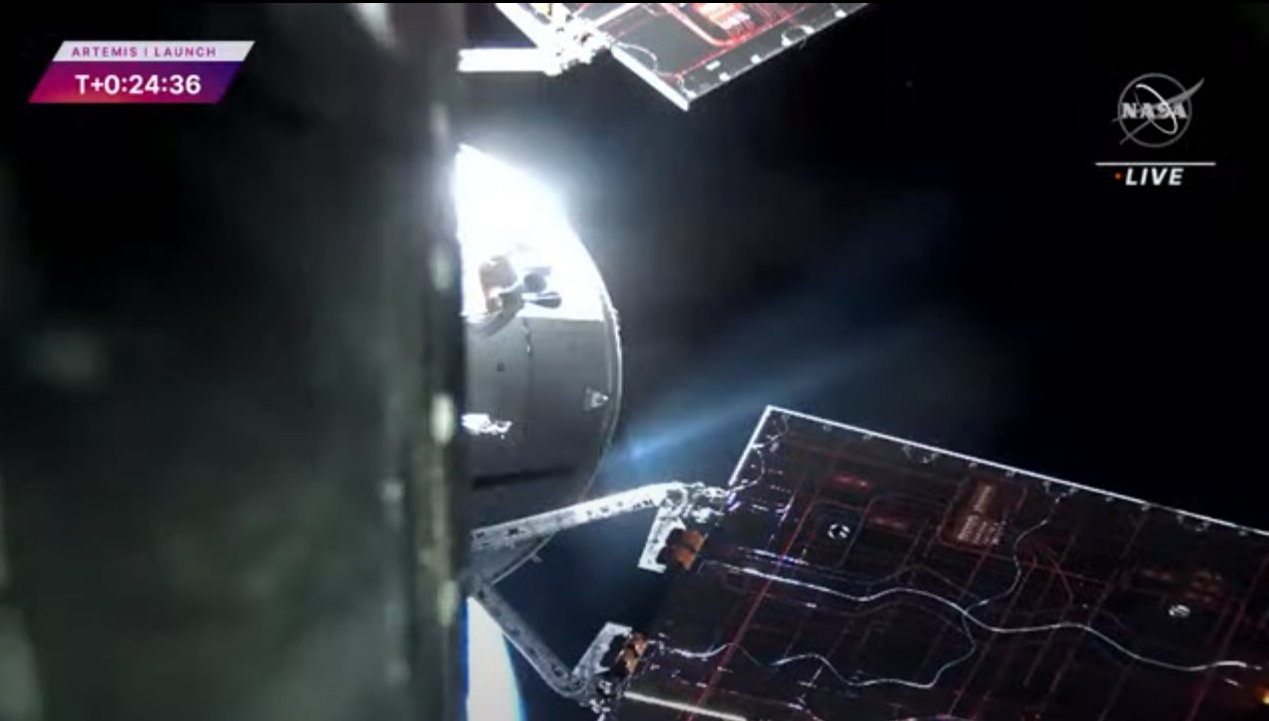
The Artemis 1 Orion spacecraft has successfully deployed its four solar arrays and NASA is already beaming live views of the spacecraft from lunar orbit. An orbit-raising maneuver is coming up as the spacecraft raises its orbit head of a planned Earth departure burn later this morning.
Space.com Editor Brett Tingley captured the scene in our launch wrap for Artemis 1.
Artemis 1 SLS/Orion ace perigee manuever
The Artemis 1 SLS rocket upper stage successfully raised the orbit of the Orion spacecraft in a perigee burn at about 2:40 am ET. Read our wrap story of the Artemis 1 moon rocket launch by Editor Brett Tingley, who was there for the launch.
"The perigee raise maneuver has been successfully completed. The interim cryogenic propulsion stage fired for just over 20 seconds to raise the lowest point of Orion’s Earth orbit in preparation for the critical trans-lunar injection burn that will send Orion to the Moon," NASA officials said in a statement. "The trans-lunar injection burn is currently targeted for about 3:14 a.m. EST and will last about 18 minutes."
Here's a stunning video of launch:
Artemis 1 SLS upper stage sends Orion to the moon
NASA's Leah Cheshier reports that the Artemis 1 ICPS upper stage has successfully performed a so-called Trans Lunar Injection burn that has placed the attached Orion capsule on a committed path to the moon. The ICPS stage will separate from Orion so that it can make its own way to lunar orbit.
"The spacecraft is moonbound," Cheshier said.
At the time of the 18-minute burn's completion, Orion was flying at about 22,500 mph.
Artemis 1 SLS upper stage separates from Orion
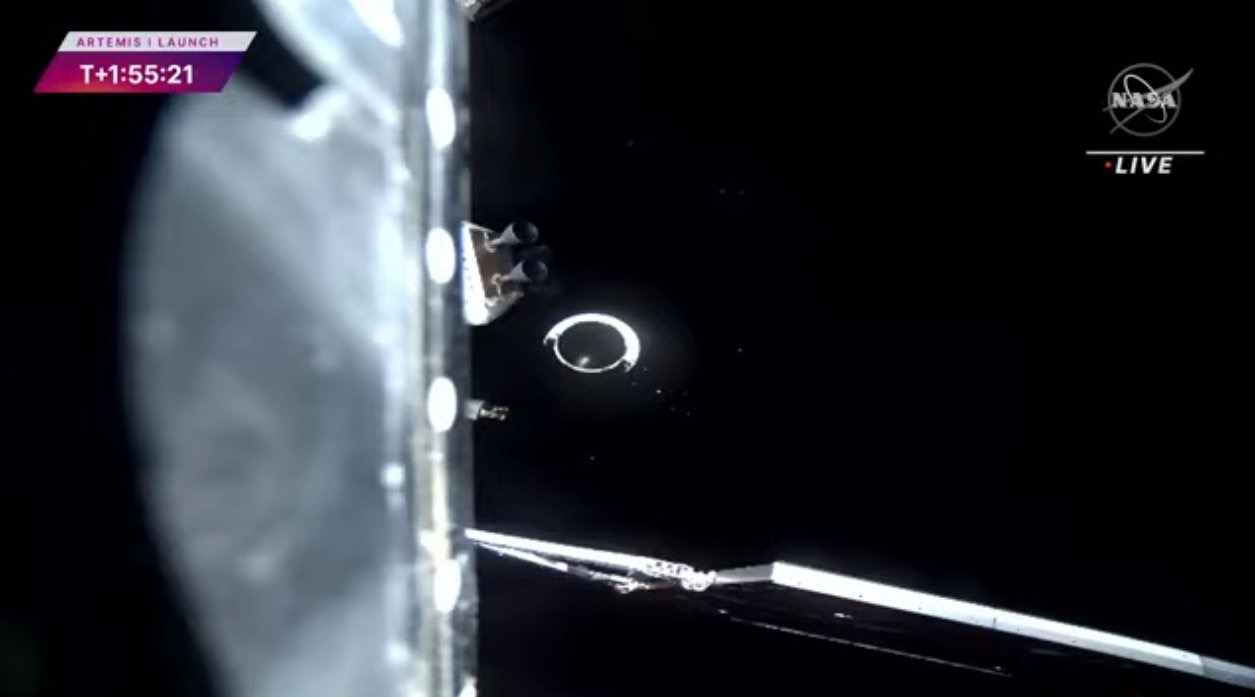
The Artemis 1 Space Launch System rocket's upper stage, called the Interim Cyrogenic Propulsion Stage, has successfully separated from the Orion spacecraft, marking the official end of today's launch.
The ICPS, as it's called, will continue to coast in the wake of the Orion spacecraft. It is carrying 10 small cubesats that will be released in stages on the way to the moon. Some of the small craft will study the moon or test Artemis technologies. One cubesat will deploy a solar sail to visit an asteroid.
Meanwhile, the Orion spacecraft is on its own journey to lunar orbit.
NASA will hold a press conference at 5 am EST (1000 GMT) to discuss today's successful launch. You can watch it live on Space.com at start time.
Artemis 1 on its way to the moon: 'We are all part of something incredibly special'
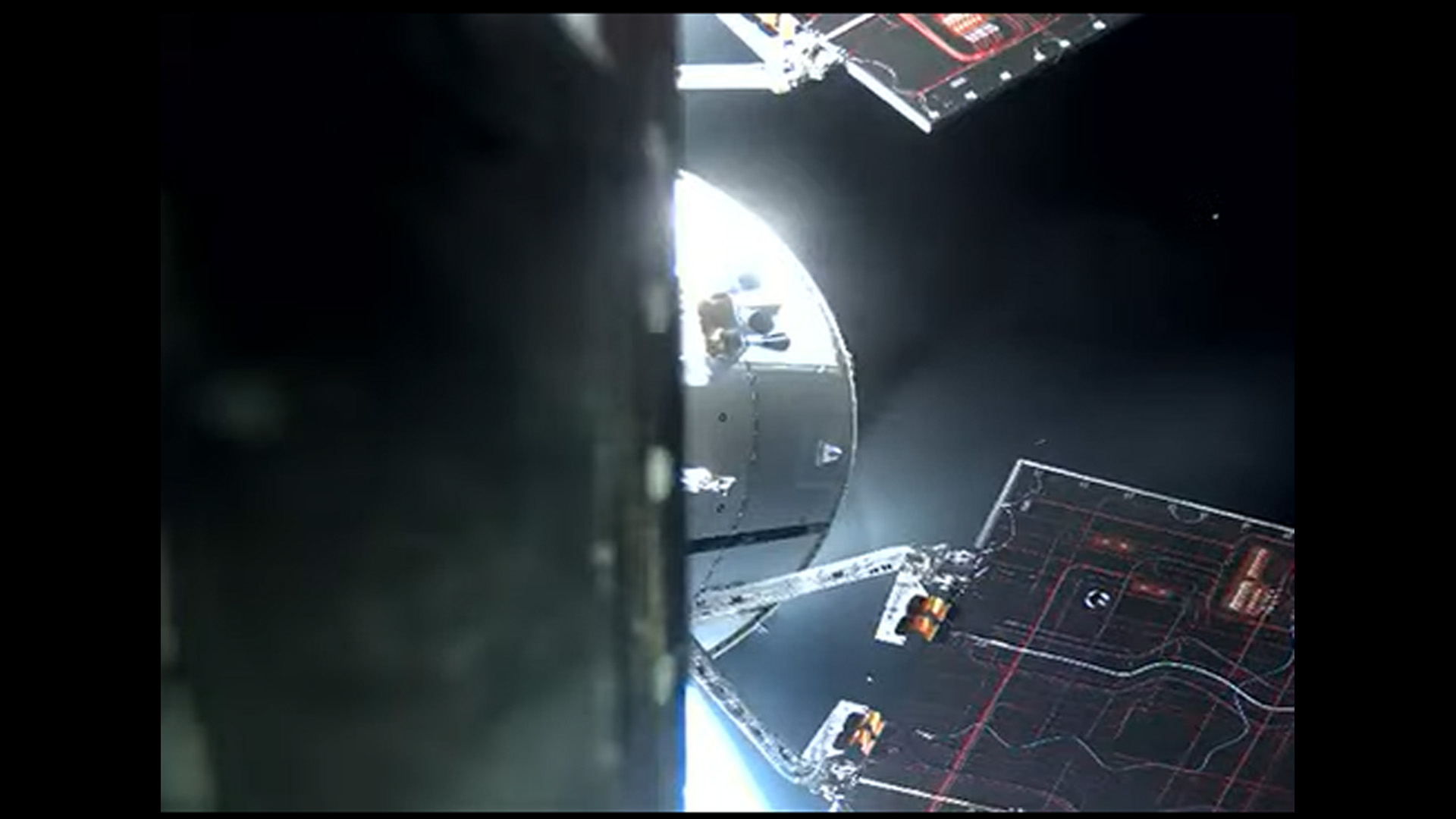
Artemis 1 is smoothly on its way to the moon after a crucial engine burn that sent the Orion capsule out of Earth orbit, hours after the Space Launch System hefted the spacecraft on the rocket's maiden flight.
Artemis launch director Charlie Blackwell-Thompson congratulated her team at mission control shortly after the successful launch at 1:47 a.m. EST (0647 GMT) from NASA's Pad 39B at Kennedy Space Center (KSC) in Florida.
"This is your moment," she said. "We are all part of something incredibly special: The first launch of Artemis, the first step in returning our country to the moon and on to Mars. What you have done today will inspire generations to come."
Orion has already beamed its first pictures home from space, too. "All four solar arrays deployed!" the European Space Agency tweeted, along with three low-resolution snaps from Orion. "They can swivel and rotate to follow the sun and power up the @NASA_Orion spacecraft."
Parts of the spacecraft are visible in the photos, along with the curve of Earth. The cameras are commercial off-the-shelf technology that has been "highly modified for use in space," according to a NASA statement.
Orion's first outbound burn
NASA is preparing for the Orion spacecraft's first outbound burn, which is scheduled to occur around 9:30 a.m. EST (1430 GMT). The burn will adjust the capsule's path toward the moon and check the orbital maneuvering system, a large engine on the vehicle. The engine will conduct four more burns over the course of the mission.
Artemis 1 Orion fires engine in flawless burn
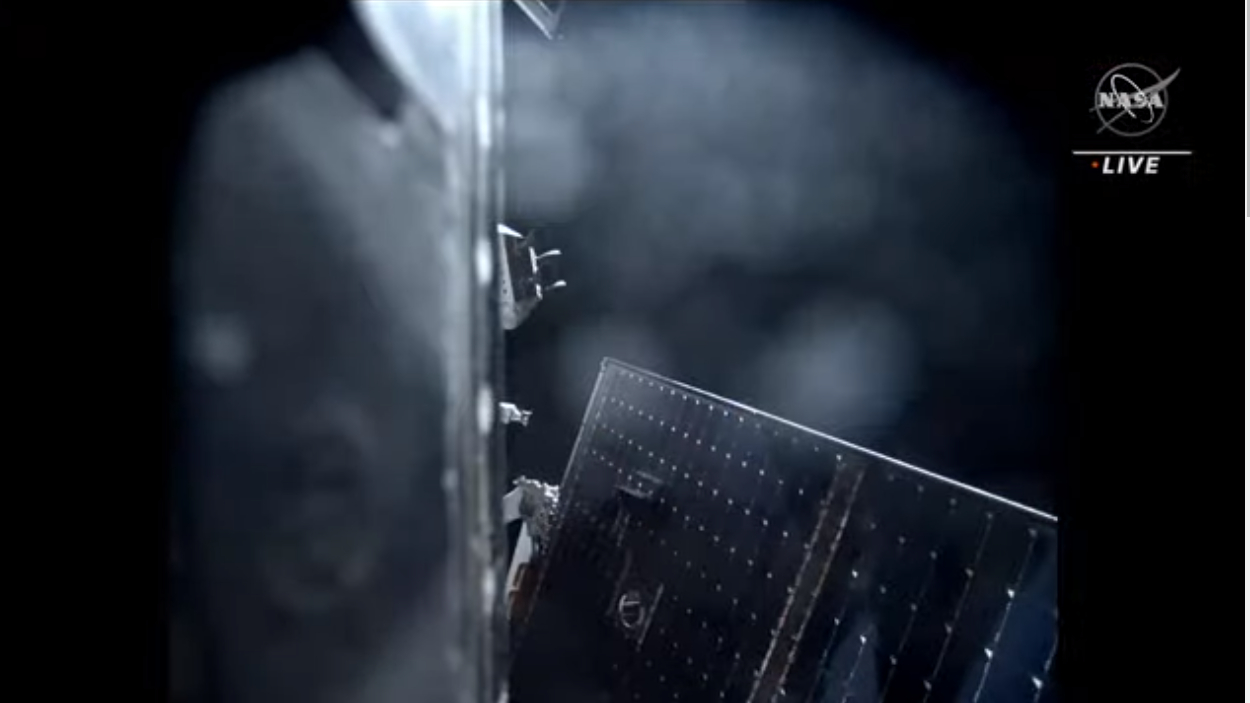
The main engine of NASA's Orion spacecraft successfully performed its first burn just after 9:30 a.m. EST (1430 GMT) today in an outbound lunar course correction maneuver, NASA says.
The engine burn lasted 30-seconds, with the engine on Orion's European Space Agency-built performing as expected. This was the first-ever test of the Orion main orbital maneuvering system engine for the mission, notching another success in the relatively smooth flight so far.
The next event will be live views of Earth from Orion, which NASA will broadcast at 10:45 a.m. EST (1545 GMT). You can watch that live on Space.com, courtesy of NASA.
Artemis 1 Orion spacecraft snaps stunning Earth view
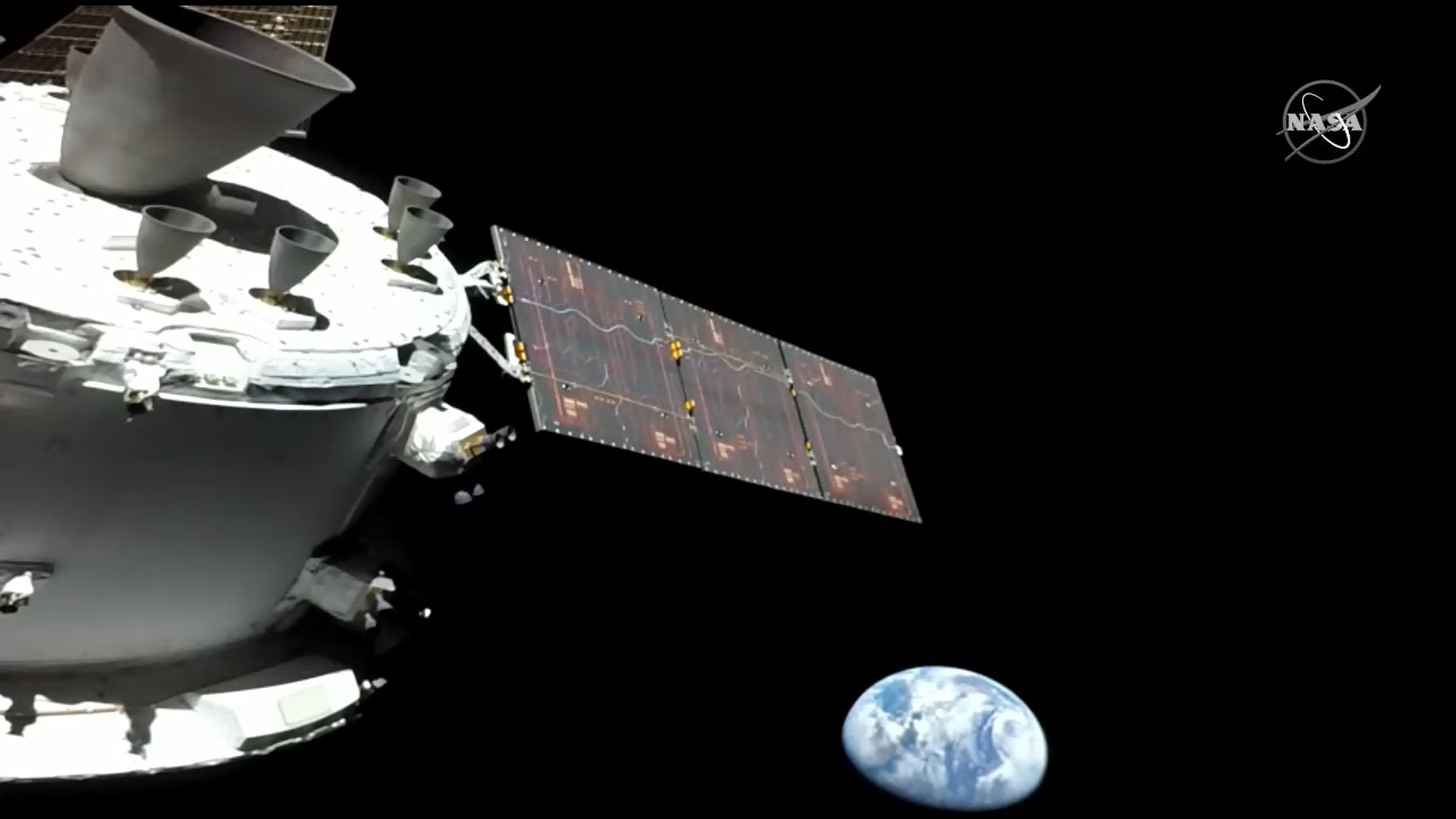
The Artemis 1 Orion spacecraft has captured its first amazing view of the entire Earth in its rearview mirror.
In a live webcast today, NASA unveiled the first camera view of a half-lit Earth as Orion was 57,000 miles away as it headed to the moon. Space.com's Meghan Bartels has the full story on Artemis 1's first photo of Earth.
The view shows the Earth, with parts of the engine and thrusters on Orion visible in the foreground. The image came from one of a suite of cameras on the exterior and interior of Orion that NASA engineers will use to measure the performance of the spacecraft.
One view showed the interior of Orion, included the spacesuit-clad "Moonikin" Campos and Callisto, an Alexa-powered experiment to study technology aides for astronauts.
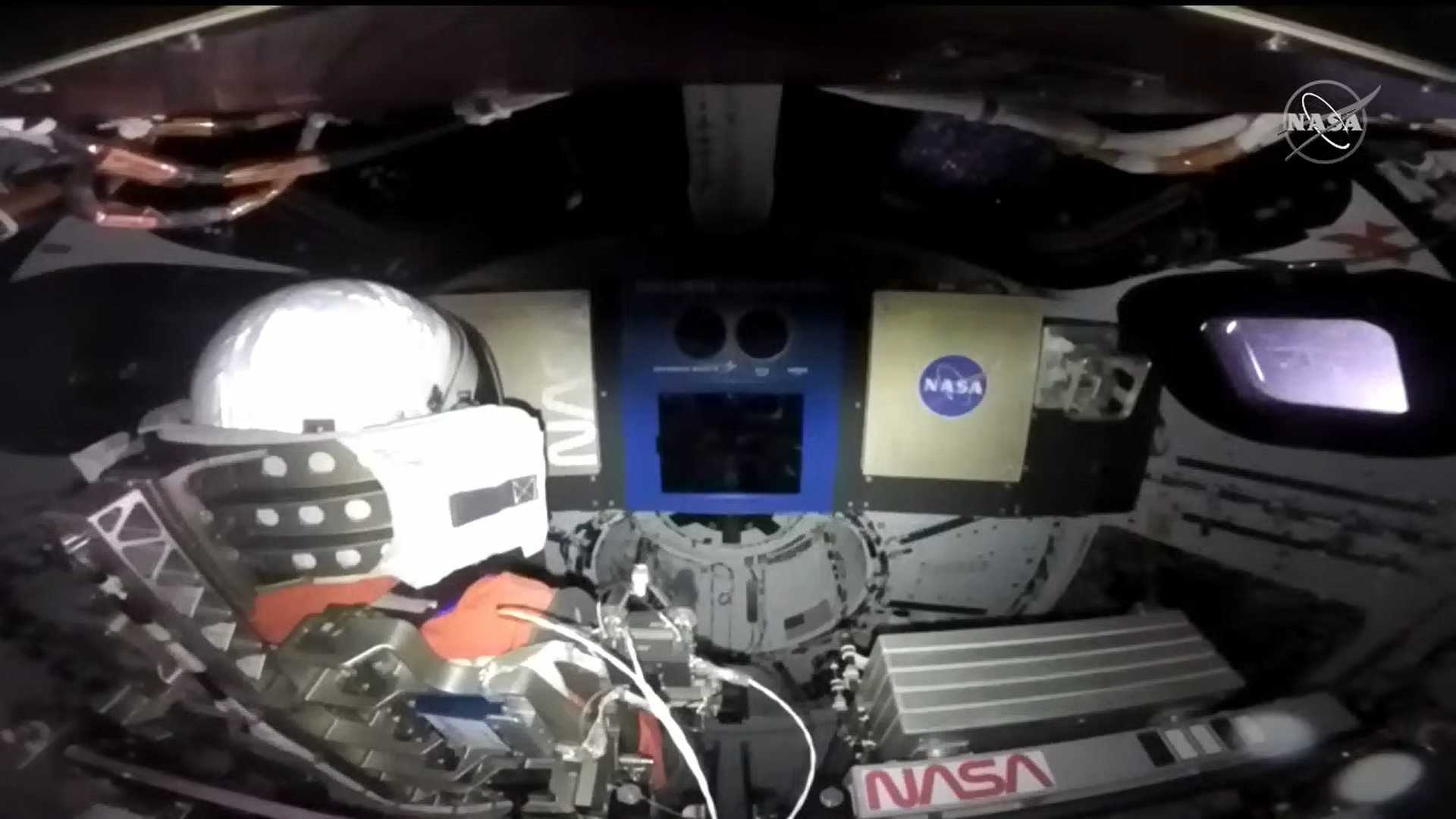
Artemis 1 continues journey to moon, cubesats begin checking in
The Orion spacecraft is flying on towards the moon, having completely a crucial correction burns yesterday to continue to the Artemis 1 destination. Investigators are checking in with 10 cubesats that were deployed from the Space Launch System rocket upper stage.
"Each cubesat has different timelines for acquiring a signal with its mission operators," NASA officials wrote in an evening blog post Wednesday (Nov. 16).
A second outbound trajectory burn is scheduled for today (Nov. 17) using auxiliary thrusters, NASA added, but did not release timing in the post for the maneuver. While events in the next few days are not being carried live, the agency continues to provide updates via social media and blog posts.
Orion more than halfway to the moon, turns on Amazon's Alexa
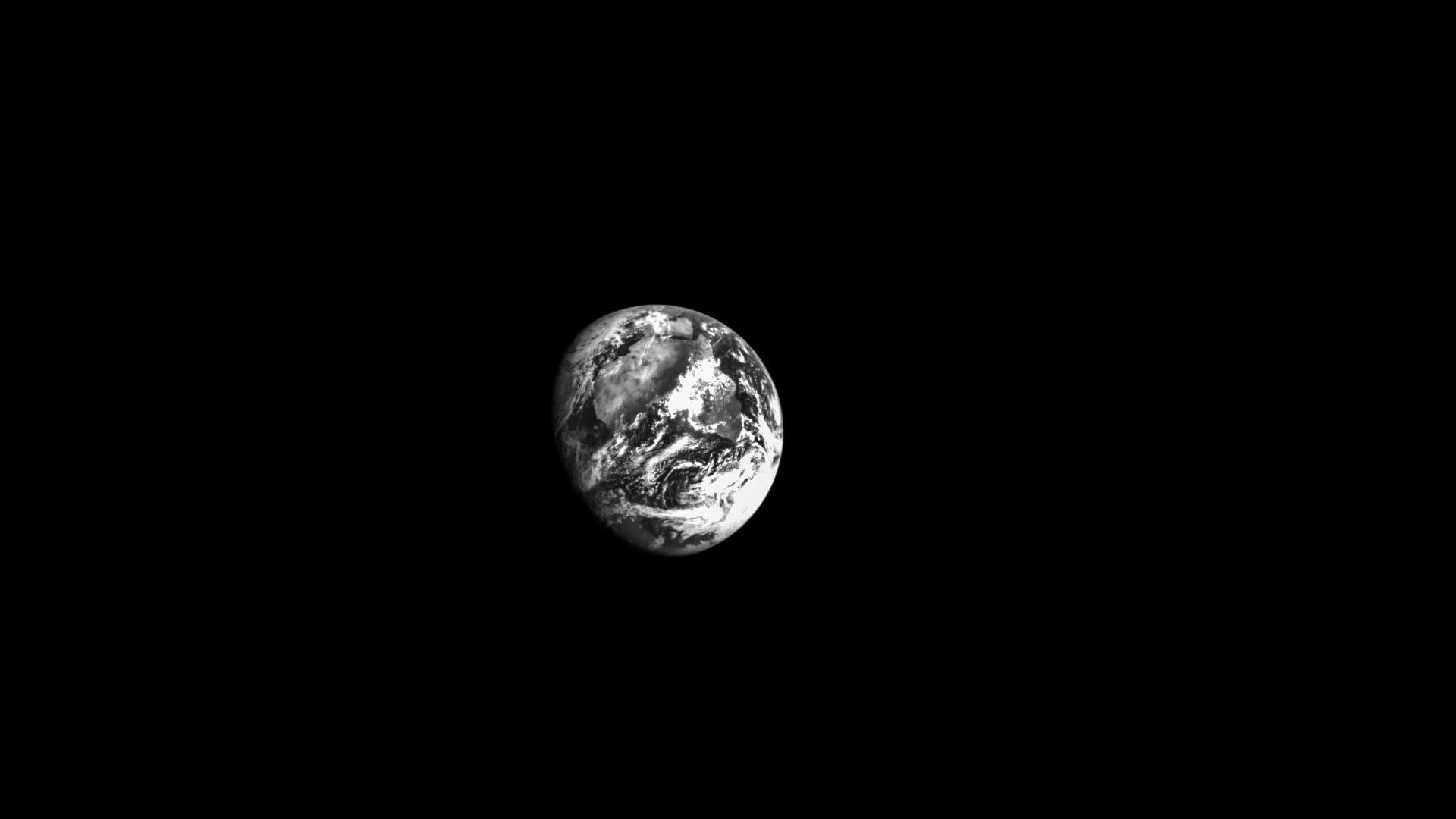
Two days after the epic Artemis 1 launch aboard the Space Launch System rocket Wednesday (Nov. 16), the uncrewed Orion spacecraft is more than 186,000 miles (299,000 km) from Earth and more than halfway to the moon, according to NASA's online spacecraft tracker.
Orion completed an engine firing or "burn" at 6:32 a.m. EST (1132 GMT) on Thursday (Nov. 17) using auxiliary thrusters on the European Service Module, NASA officials said in an evening blog update on Thursday.
Ground teams also turned on a space version of Amazon's Alexa artificial intelligence virtual assistant, which is called Callisto. "Callisto is located in the Orion cabin and will test voice activated and video technology that could assist future astronauts on deep space missions," NASA officials stated.
Artemis 1 Orion over halfway to the moon
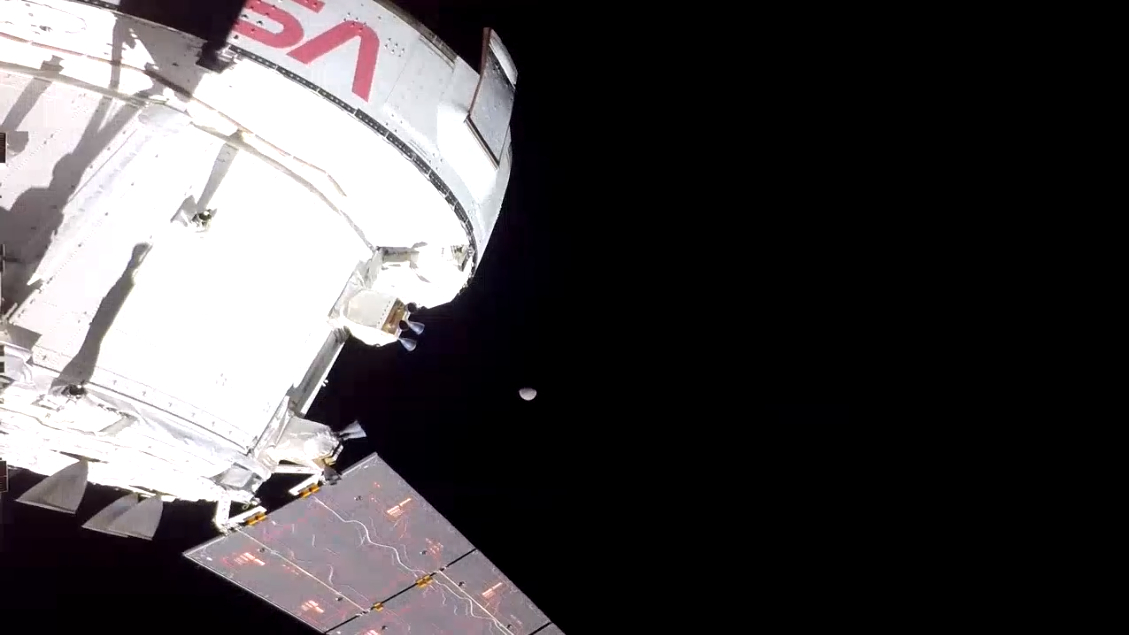
NASA's Artemis 1 Orion spacecraft has passed the halfway mark to the moon and is "exceeding expectations" on its uncrewed test flight, the U.S. space agency said late Friday. Space.com's Mike Wall has the full story.
Today, Nov. 19, is Flight Day 4 of Orion's 25-day Artemis 1 mission. The spacecraft is currently 216,391 miles from Earth, 93,048 miles from the moon and cruising through space at 995 mph, according to NASA. You can track Orion through space on its mission. Find out how here.
Orion will make its closest approach to the moon, flying as low as 60 miles, on Monday, Nov. 21.
Artemis 1 Orion on track for moon flyby
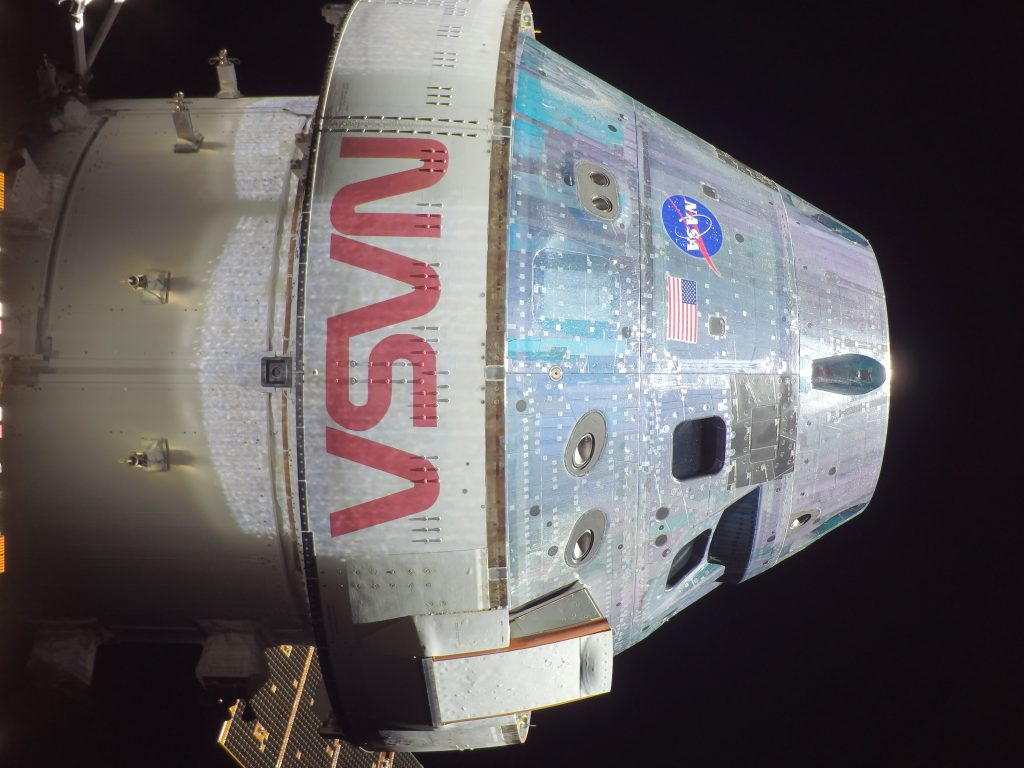
NASA's Artemis 1 Orion spacecraft is now one day away from its closest encounter with the moon of its mission.
Today is Flight Day 5 of the Artemis 1 mission. As of this morning, Orion is 230,059 miles from Earth, 55,201 miles from the Moon, cruising at 539 mph, according to a NASA update.
On Monday, Nov. 20, the Orion spacecraft will fly within 80 miles of the moon as it prepares to enter its distant retrograde orbit later next week. The flyby will coincide with a maneuver NASA calls the "outbound powered flyby" where Orion will fire its main engine at 7:44 a.m. EST (1244 GMT).
NASA's Artemis 1 mission management team met on Saturday (Nov. 19) and officially gave the "go" to proceed with the engine burn. When Orion fires its engines, it will be behind the moon and out of communication with Earth, NASA says.
The spacecraft will slip behind the moon, as seen from Earth,, at 7:25 a.m. EST (1225 GMT) and reemerge on the other side at 7:59 a.m. EST (1259 GMT). It's time of closest approach to the moon will be at 7:57 a.m. EST (1257 GMT).
On Saturday, flight controllers tested Orion's solar arrays by moving each of them into a different position to test the Orion's WiFi signal strength with its wingtip cameras.
" The Integrated Communications Officer, or INCO, tested the WiFi transfer rate between the camera on the tip of the solar array panels and the camera controller. The goal was to determine the best position to most efficiently transfer imagery files," NASA wrote in an update. "Teams learned that having multiple cameras on at once can impact the WiFi data rate, and therefore, future solar array wing file transfer activities will be accomplished from one solar array wing at a time to optimize transfer time."
Flight controllers also tested Orion's radiator system to cool the spacecraft, as well as several tests of the spacecraft's star trackers, which are used for navigation.
Early in Orion's mission, thruster firings by the capsule interfered with the star trackers.
"In previous flight days, engineers evaluated initial data to understand star tracker readings correlated to thruster firings," NASA wrote in the update. "Engineers hope to characterize the alignment between the star trackers that are part of the guidance, navigation and control system and the Orion inertial measurements units, by exposing different areas of the spacecraft to the Sun and activating the star trackers in different thermal states."
Artemis 1 Orion approaches the moon
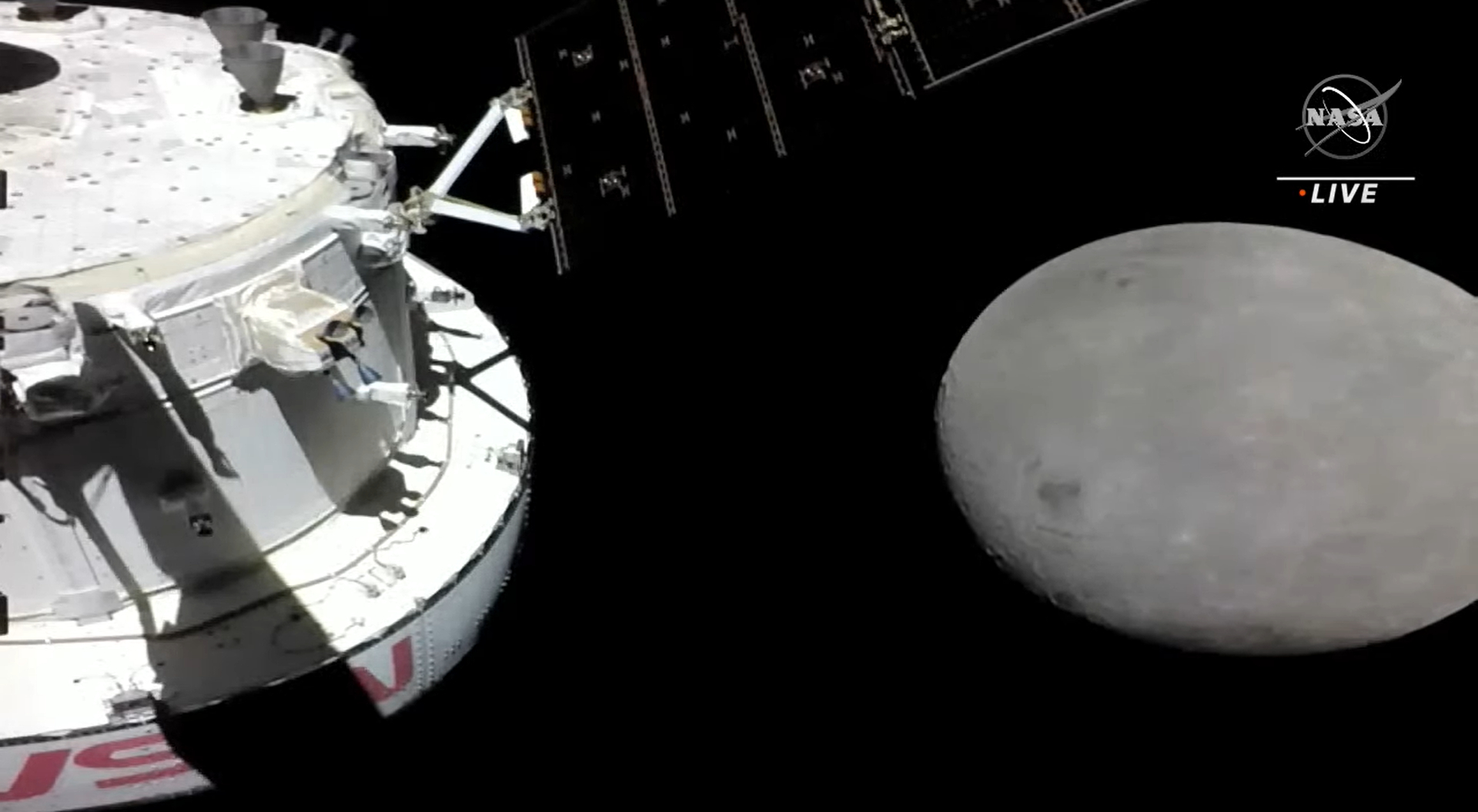
NASA's Artemis 1 Orion spacecraft is only a few hours away from its closest encounter with the moon. Orion is on track to skim past the moon just 80 miles (130 kilometers) above the lunar surface at 7:44 a.m. EST (1244 GMT).
Today is Flight Day 6 of the Artemis 1 mission.
You can watch the flyby live on Space.com and on NASA's YouTube channel.
Orion spacecraft comes within contact of Earth
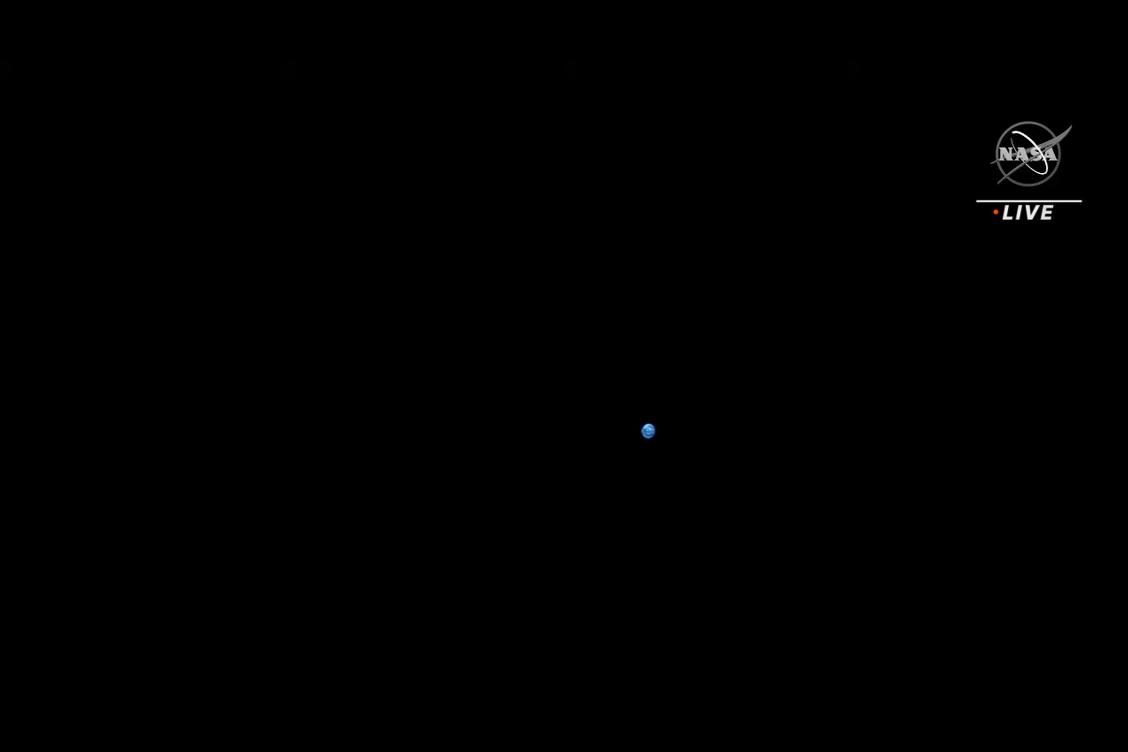
The Orion spacecraft has re-emerged from behind the moon and Mission Control is evaluating how well the engine burn went. Orion also showed the Earth at a distance in the moments after it emerged from behind the moon.
Orion successfully completes engine burn
The Orion spacecraft has successfully finished its outbound burn on the back side of the moon, according to NASA. This puts the uncrewed spacecraft on a path to test out a path ahead of the future human missions in the Artemis program, assuming that the rest of the mission goes to plan. Read our wrap story here.
Artemis 1 Orion spacecraft flies over Apollo 11 landing site
The Artemis 1 Orion spacecraft zoomed 1,384 statute miles (2,227 km) above the landing site of Apollo 11, the first-ever human touchdown area on the moon, around 8:38 a.m. EST (1338 GMT) on Monday (Nov. 21), according to NASA official Sandra Jones. No imagery was immediately available on NASA Television of the 1969 landing area.
NASA officials to discuss Artemis 1 flyby
The livestream of Orion's engine burn around the moon has completed, and NASA officials will be ready to discuss its success at 5 p.m. EST (2200 GMT), according to agency official Sandra Jones. Footage will be livestreamed on NASA Television and available here at Space.com.
NASA officials celebrate Orion flyby success in blog post
NASA officials celebrated the success of the Artemis 1 Orion spacecraft flyby and engine burn near the moon on Monday (Nov. 21) in a blog post.
"Orion reacquired signal with NASA's Deep Space Network at 7:59 a.m. EST (1459 GMT) after successfully performing the outbound powered flyby burn," NASA officials wrote, saying the burn took place for 2 minutes and 30 seconds. Orion was more than 230,000 miles (370,000 km) from Earth while it was firing its engines, officials said.
"The outbound powered flyby burn is the first of two maneuvers required to enter the distant retrograde orbit around the moon," NASA officials added. "The spacecraft will perform the distant retrograde orbit insertion burn Friday, Nov. 25, using the European Service Module."
NASA officials will provide a livestreamed status update at 5 p.m. EST (2200 GMT), which you can watch in the link above via NASA Television.
Artemis 1 Orion doing well after moon flyby
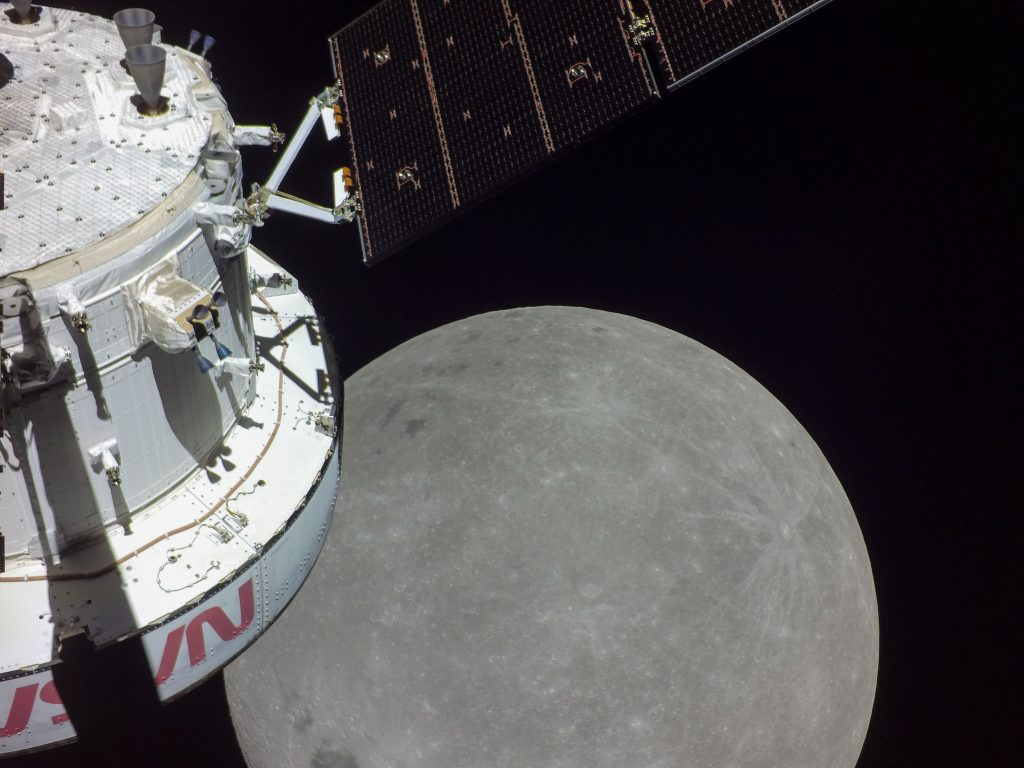
NASA's Artemis 1 Orion spacecraft is doing well after flying close by the moon on Nov. 21, mission managers said Monday evening.
"The mission continues to proceed as we had planned, and the ground systems, our operations teams, and the Orion spacecraft continue to exceed expectations, and we continue to learn along the way about this new, deep-space spacecraft," said NASA's Artemis 1 mission manager said in the briefing from the Johnson Space Center in Houston, Texas.
Mission managers said they were "giddy" over the amazing images from the Orion spacecraft as it zoomed by the moon at 5,102 mph after the flyby maneuver. The spacecraft flew over the Apollo 11, Apollo 12 and Apollo 14 moon landing sites during the flyby.
"Today was a terrific day," Howard Hu, Orion program manager, added. "We're coming in every day and it doesn't seem like work. I mean, it is just fabulous. I want to hear the information that's coming from the spacecraft, learning about the spacecraft and being excited about what we're doing. And it's just, it's just been phenomenal. I've got a big smile every day."
Orion readies for distant retrograde maneuver on Friday
A day after "giddy" NASA officials praised the footage of the moon and the Earth flowing from Artemis 1's close flyby of the moon with the Orion spacecraft yesterday (Nov. 22), the agency is preparing for the next deep space maneuver.
Orion will do a "distant retrograde orbit insertion burn" on Friday (Nov. 25), meaning it is high above the moon's surface and traveling opposite to the moon's direction around Earth, agency officials wrote in a late-night blog post Monday.
"This orbit provides a highly stable orbit where little fuel is required to stay for an extended trip in deep space to put Orion’s systems to the test in an extreme environment far from Earth," NASA officials wrote.
Orion's journey to 57,287 miles (92,194 km) beyond the moon will exceed the record set by the last human-rated capsule in the region, which was the command module and lunar module combination of Apollo 13. Orion, however, is uncrewed.
The spacecraft has used slightly less propellant than expected so far and there remains more than 2,000 pounds (907 kg) of margin if required.
Artemis 1 moon rocket blew elevator doors out at launch pad
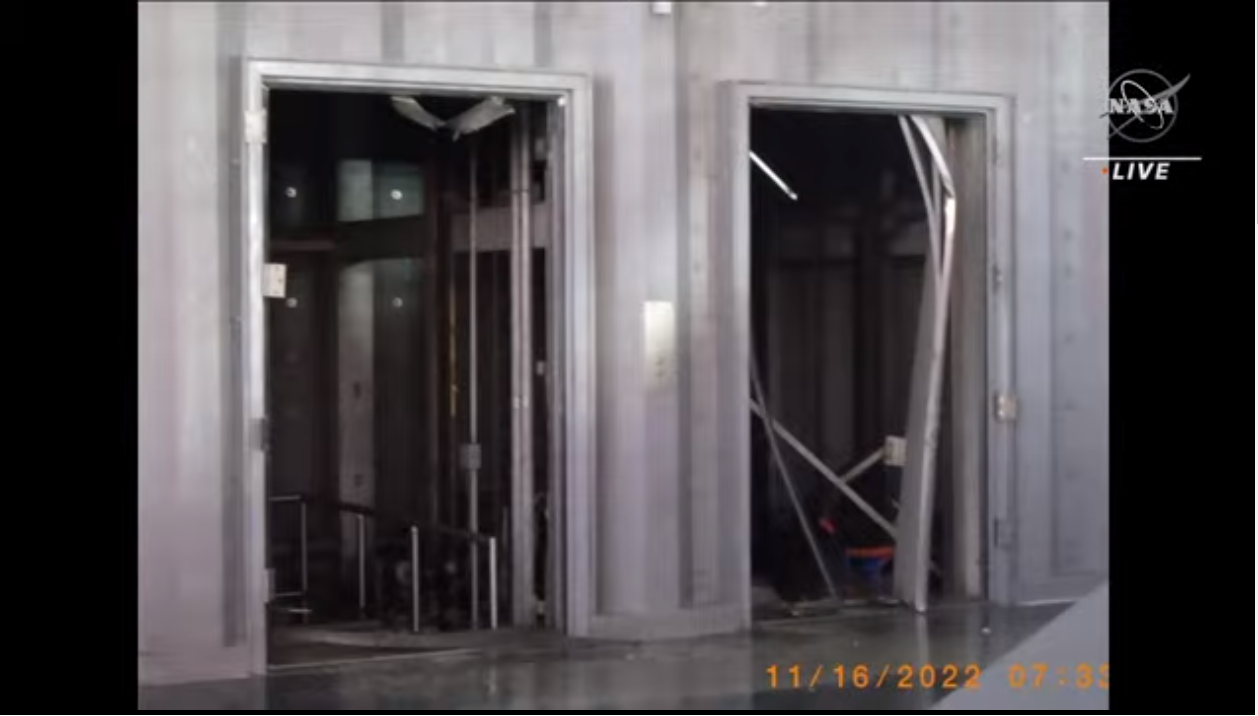
New images from NASA show how the Space Launch System (SLS) rocket blew out elevator doors and caused minor damage during the launch of Artemis 1, the first flight of the Artemis program, on Nov. 16.
The flight is nominal as an uncrewed Orion spacecraft toward the moon, and much of the damage was expected, but managers are nonetheless looking for any changes that can be made ahead of future missions.
"It just goes to show," Artemis program manager Mike Sarafin said Monday (Nov. 21) of the damage, "that the environment ... is not the friendliest when you have the world's most powerful rocket lifting off."
Read more: Huge Artemis 1 moon rocket blew the doors off its launch tower's elevators (video)
Watch Earth set behind moon in Artemis 1 video
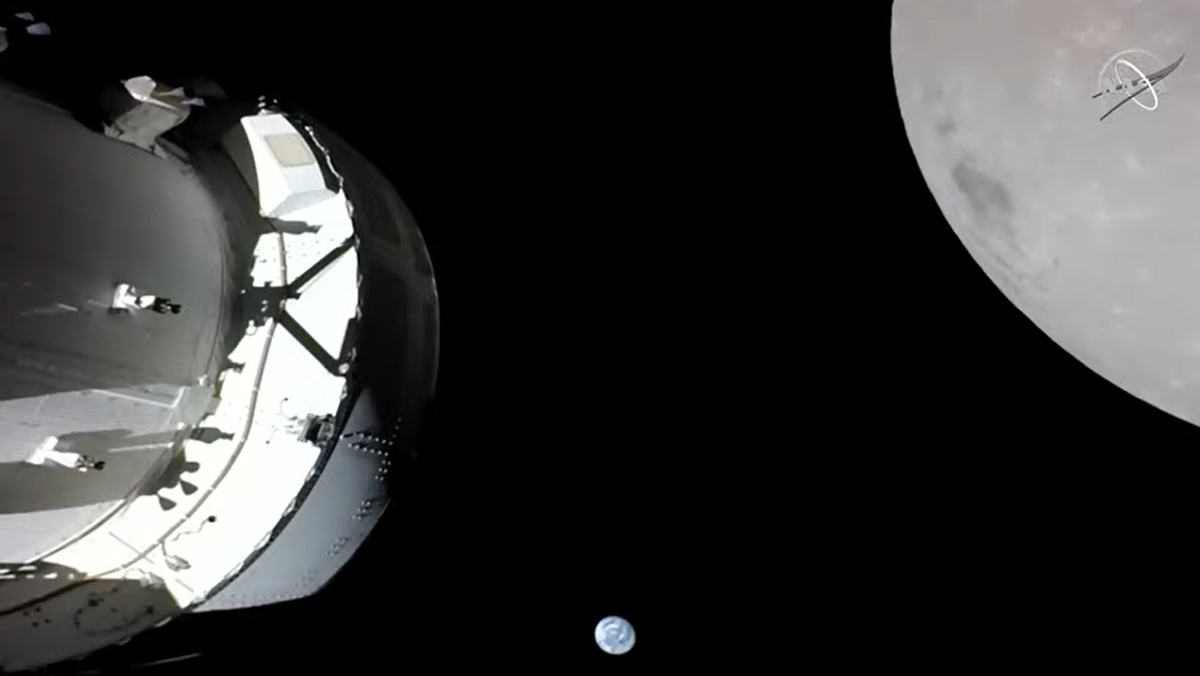
A fresh video from from deep space captured Earth setting behind the moon during the Artemis 1 lunar flyby yesterday (Nov. 21).
"You are seeing the Earth; you are seeing home. You are seeing yourself in that image right there as Orion is 232,000 miles [373,000 kilometers] away from planet Earth," NASA spokesperson Sandra Jones said during live coverage of the Orion spacecraft lunar flyby Monday (Nov. 21) on NASA Television.
Read more: Artemis 1's Orion spacecraft sees Earth setting behind moon (video)
Orion more than 200,000 miles from Earth, 2 cubesats have issues
This morning (Nov. 23) Orion is more than seven days into its mission following the dramatic Artemis 1 launch on Nov. 14, and is more than 210,000 miles from Earth and 44,000 miles from the moon, according to recent NASA statistics.
Some of the 10 cubesats riding along with Artemis 1 during launch have experienced issues in the last day. The LunaH-Map spacecraft, designed to map the distribution and abundance of water ice on the moon's surface, failed to fire its engine as planned but may be able to be salvaged.
The Japanese OMOTENASHI spacecraft also waved off a planned lunar landing due to communications issues, but may be retasked in March when its solar panels are likely to receive more sunlight (and by association, power). However, the EQUULEUS spacecraft from Japan (which has been working) did send a picture back yesterday showing the day-night terminator of the moon.
NASA briefly loses contact with Orion, but all is fine now
NASA unexpectedly lost contact with the Orion capsule early Wednesday morning (Nov. 23), but for now all appears to be fine. The link was lost for 47 minutes while reconfiguring a link between the capsule and the Deep Space Network, which tracks spacecraft in deep space.
"The reconfiguration has been conducted successfully several times in the last few days, and the team is investigating the cause of the loss of signal," NASA officials wrote in a brief update on Wednesday.
Read more: NASA loses contact with Artemis 1's Orion spacecraft for 47 minutes
Orion spacecraft captures stunning close-up images of the moon
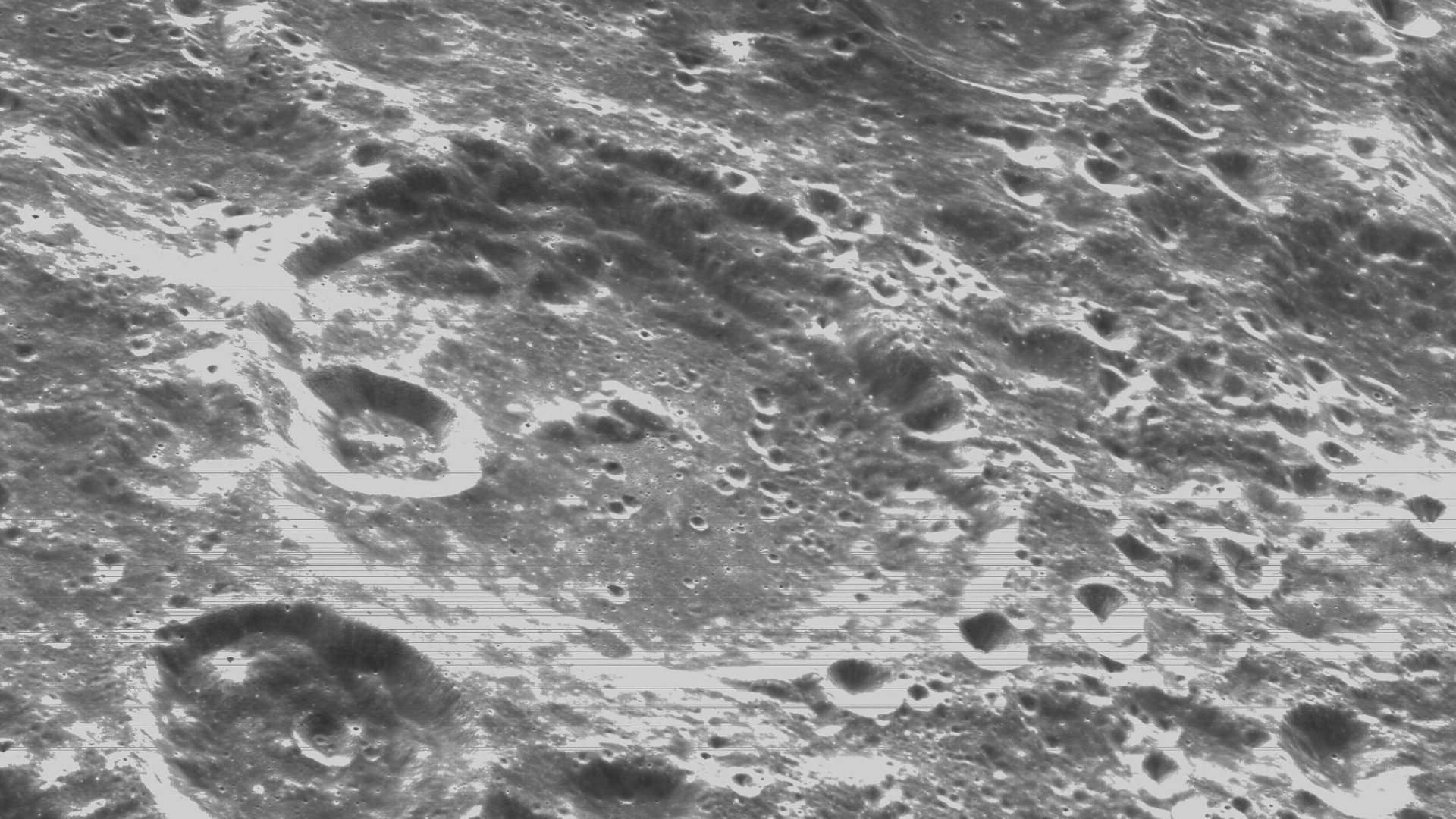
This morning (Nov. 24) the Orion spacecraft is more than eight days into its mission and is more than 219,000 miles (352,000 kilometers) from Earth and 53,000 miles (85,000 km) from the moon, according to recent NASA statistics.
Yesterday (Nov. 23) NASA released a series of Incredible close-up images of the moon captured by the Orion spacecraft during its close approach on Nov. 21 showing the lunar surface in exquisite detail.
Read more: Artemis 1's Orion spacecraft captures stunning photos of the moon during its closest approach
Watch Orion spacecraft perform insertion burn into distant retrograde orbit
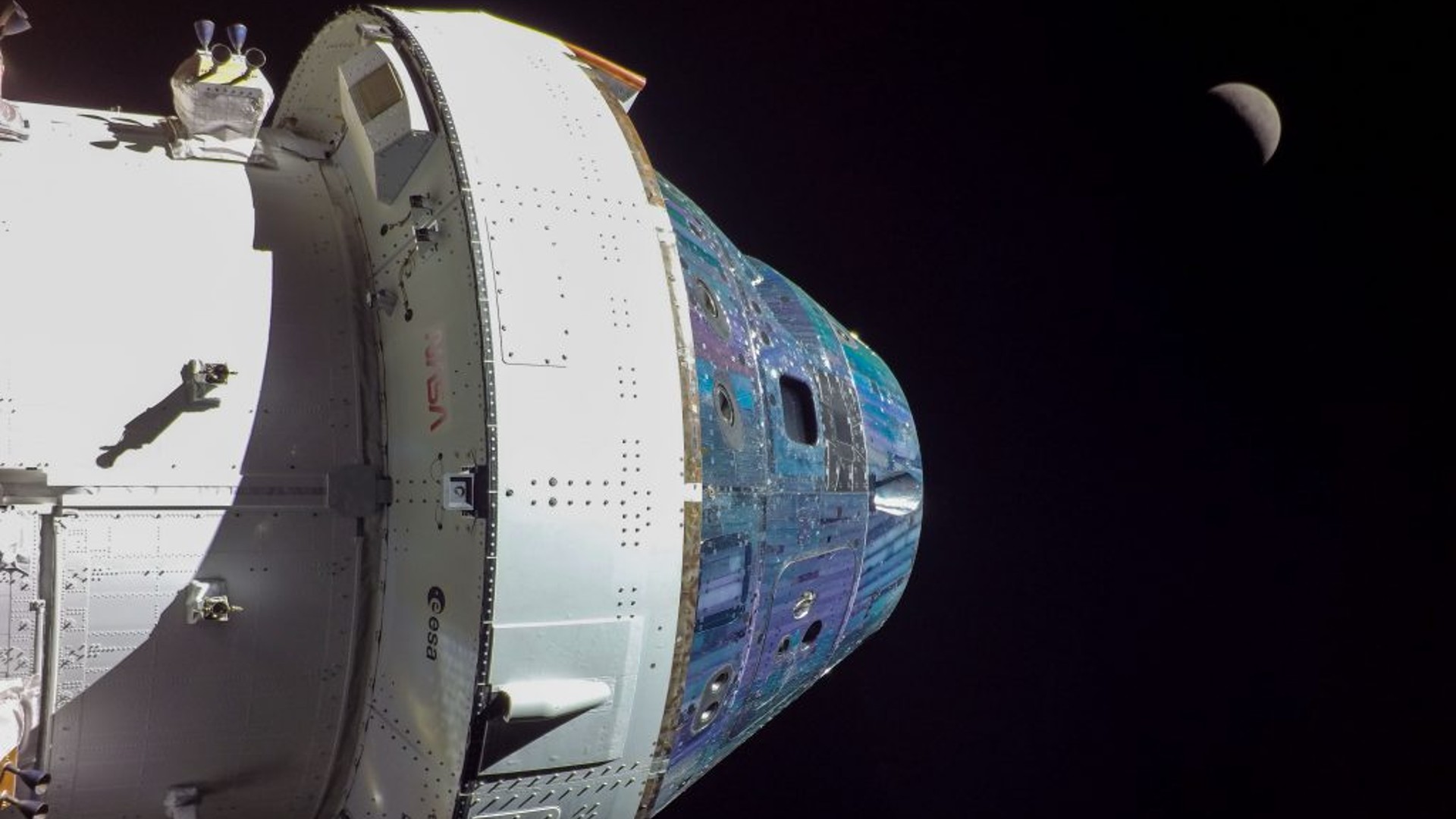
On Friday (Nov. 25), the Artemis 1 moon mission's Orion spacecraft will fire its thrusters to insert itself into a distant retrograde orbit around the moon.
The insertion burn will send Orion far out past the moon, some 40,000 miles (64,373 kilometers) past Earth's cosmic companion. Orion will spend between six and 19 days in this orbit in order to collect data about the spacecraft's performance in deep space.
This distant retrograde orbit was chosen because it is fairly stable in terms of the equilibrium between Earth's and the moon's gravitational pulls, allowing Orion to expend less fuel while it orbits the moon before its journey home.
According to a NASA update, the maneuver will begin on Friday (Nov. 25) at 4:52 p.m. EST (2152 GMT). You can watch live coverage of the insertion burn here on Space.com courtesy of NASA TV beginning at 4:30 p.m. EST (2130 GMT).
Read more: Watch Artemis 1's Orion spacecraft enter lunar orbit Friday
Success! Orion spacecraft engine burn places Artemis 1 mission into moon's orbit

The Orion spacecraft is safely in its lunar orbit, according to NASA.
"It looks like we had a good burn," NASA public affairs specialist Chelsey Ballarte said during a live NASA Television broadcast covering Artemis 1 activities on Friday (Nov. 25).
The engine burn that placed the spacecraft in a distant retrograde orbit around the moon ran for about 1 minute and 28 seconds after starting at 4:52 p.m. EST (2152 GMT). The uncrewed Orion will later become the furthest-flung human-rated spacecraft in history, surpassing the mark set by the Apollo 13 crew and their two spacecraft in 1970.
"We're going to continue to have imagery and videos in high definition from this mission as well," Ballarte added. The next live update from NASA officials regarding Artemis 1 is expected Monday (Nov. 28) at 5 p.m. EST (2200 GMT) during the midpoint of the mission, which we will carry here at Space.com.
Following that mission briefing, Orion will perform an engine burn Dec. 1 to begin the journey home, splashing down on Dec. 11 in the Pacific Ocean off the coast of California if the schedule holds.
Artemis 1 Orion spacecraft breaks Apollo 13 record

It's official, NASA's Artemis 1 Orion spacecraft has shattered an Apollo 13 distance record for the farthest distance from Earth by a crew-capable spacecraft. Space.com contributor Robert Pearlman of collectSPACE.com has the full story.
Today at 8:40 a.m. EST (1340 GMT), the Artemis 1 Orion surpassed a distance record set on April 14, 1970 by the Apollo 13 spacecraft Odyssey and its three-astronaut crew. At the time, Odyssey became the farthest crewed spacecraft from Earth at a distance of 248,655 miles (400,171 kilometers).
Today, the Artemis 1 Orion spacecraft surpassed that distance and, on Monday (Nov. 28), will set a new record when it reaches its maximum distance of 268,553 miles (432,194 km) from Earth.
Artemis 1 Orion nears midpoint of moon mission
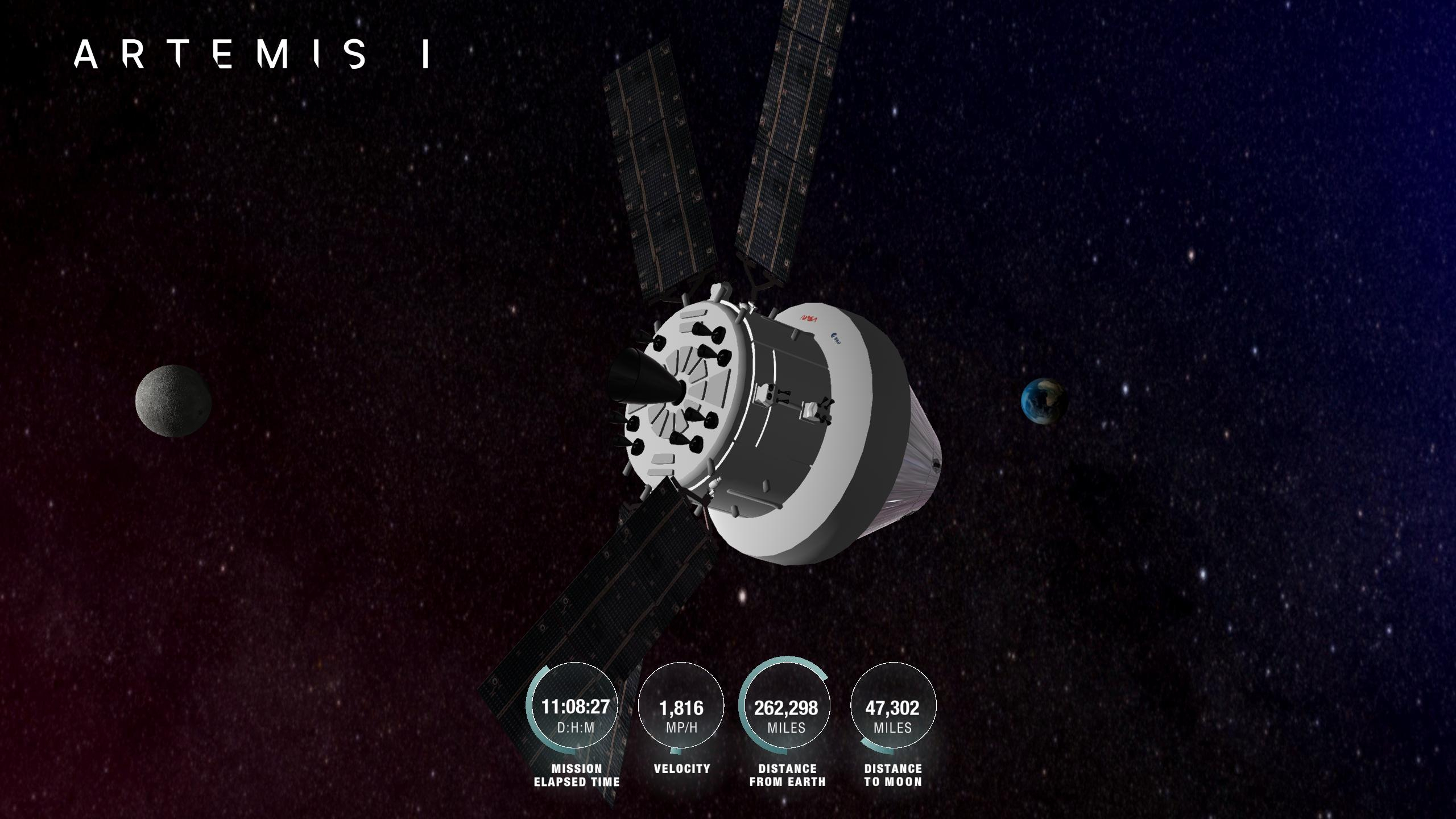
Today is Flight Day 12 of NASA's Artemis 1 Orion mission to the moon, with the spacecraft poised to pass the 11 day, 10 hour mark at about 12 pm ET today.
As of this post, Orion is 262,298 miles from Earth, 47,302 miles from the Moon, cruising at 1,816 miles per hour, according to a NASA update.
You can track the Artemis 1 Orion mission online through NASA's Track Artemis website.
Orion reaches a dozen days in space, approaches mission midpoint

More than 12 days into the mission, the Orion spacecraft is nearly 268,000 miles (431,000 km) from Earth and 44,000 miles (70,800 km) from the moon, according to NASA statistics. Orion will reach its furthest distance from Earth today (Nov. 28), NASA officials wrote in a blog post, when it gets close to 270,000 miles (435,000 km). It also will reach the midpoint of its mission today.
"On the 12th day of the Artemis I mission, team members conducted another planned test of the star trackers aboard Orion as it continued along a distant retrograde orbit of the moon, and began another reaction control thruster flight test," NASA officials wrote in the blog post late Sunday (Nov. 27).
Engineers have also been interacting with Callisto, which is based on Amazon's Alexa voice assistant technology, the agency noted. "Callisto is located in the Orion cabin and will test voice activated and video technology in the deep space environment."
Orion spacecraft hits max distance from Earth
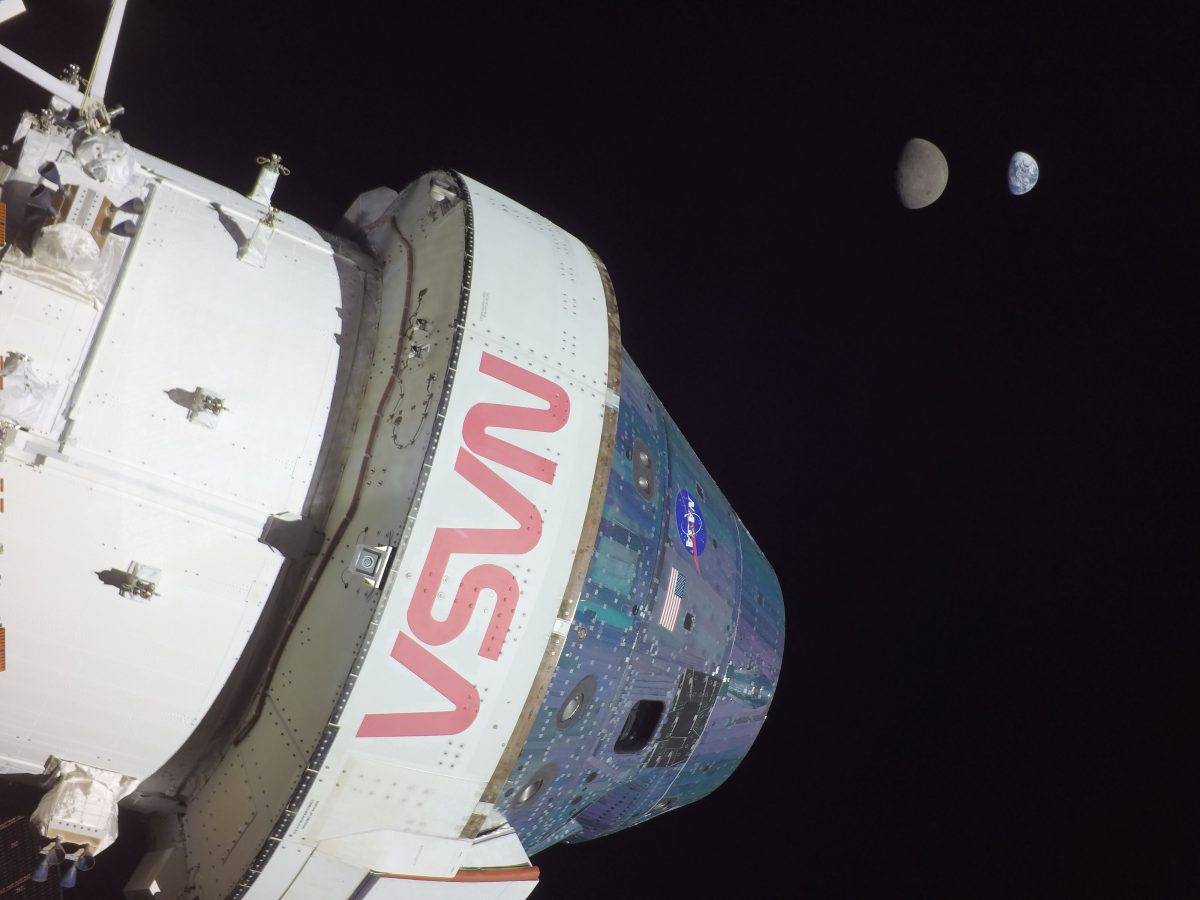
Today is Flight Day 14 of NASA's Artemis 1 Orion mission to the moon.
As of midday today, Orion is 265,769 miles from Earth, 44,949 miles from the Moon and cruising at 1,753 mph, according to a NASA update. On Monday, Orion reached its maximum distance from the Earth, a whopping 268,563 miles from our planet.
On Wednesday, Nov. 30, NASA will hold a press conference to preview Orion's departure from the moon, which is scheduled to occur in the afternoon of Thursday, Dec. 1. At that time, the Orion spacecraft will fire its engine to leave its distant retrograde orbit of the moon and begin the dayslong journey back to Earth.
Orion is scheduled to splash down in the Pacific Ocean on Dec. 11.
Artemis 1's Orion capsule is "go" to leave lunar orbit Thursday
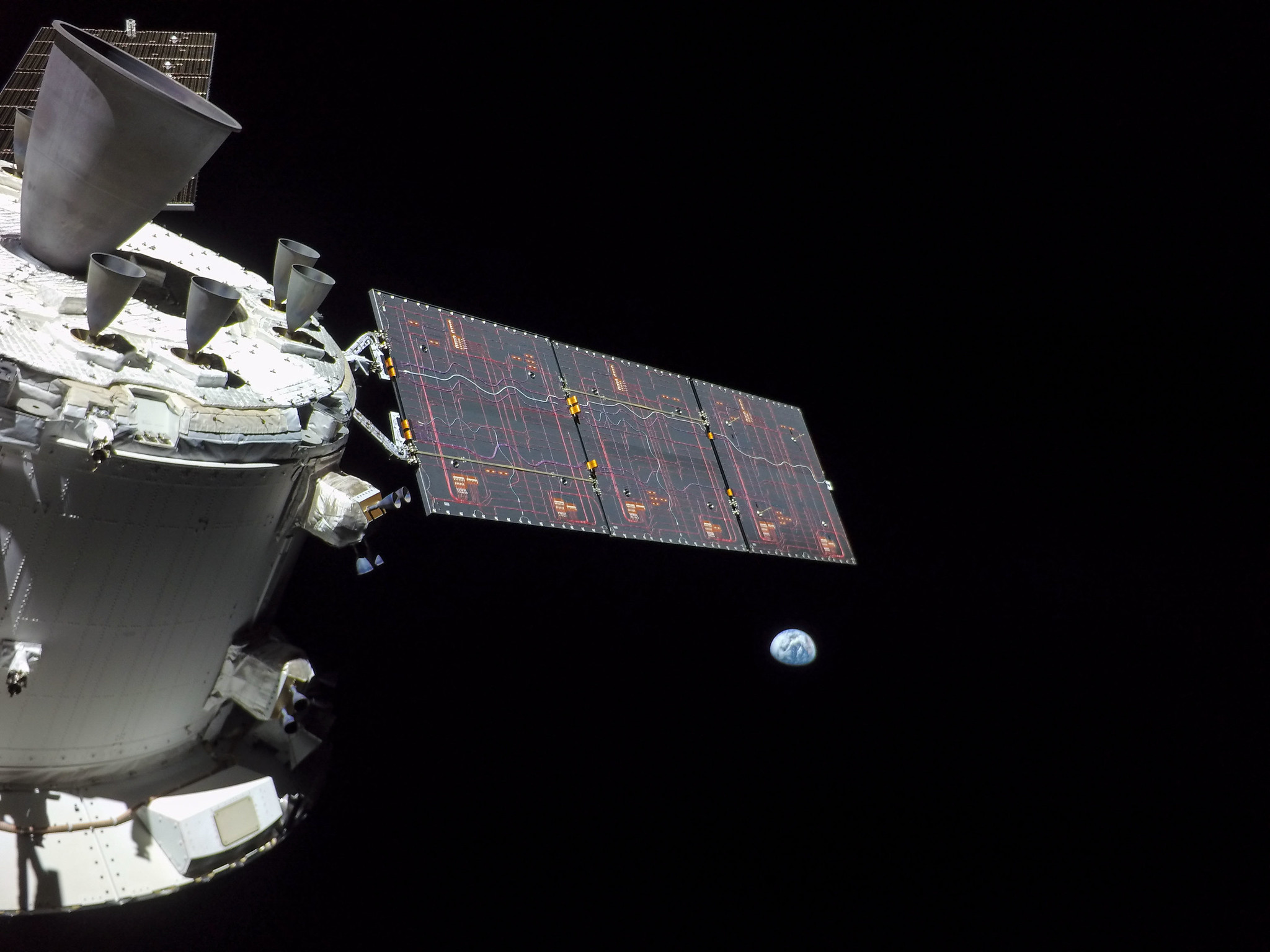
The Artemis 1 mission team met on Wednesday (Nov. 30) to decide whether the Orion capsule is ready to depart lunar orbit tomorrow (Dec. 1). All team members voted "yes," so the spacecraft is all set for its departure burn.
That crucial maneuver will take place tomorrow at 4:54 p.m. EST (2154 GMT) and last for 105 seconds. If all goes according to plan, Orion will conduct another, longer burn on Dec. 5 during a close lunar flyby. That latter maneuver will keep the capsule on course for its return to Earth, which will occur with a Pacific Ocean splashdown on Dec. 11.
Orion prepares to exit lunar orbit today (Dec. 1)
The Orion spacecraft is go to exit its distant retrograde lunar orbit today (Dec. 1) as it cruises through Day 15 of the Artemis 1 mission, according to a NASA blog update. The spacecraft is more than 243,000 miles from Earth and 52,700 miles from the moon (391,000 km and 84,800 km, respectively), its official Twitter account stated Thursday morning.
The engine burn is expected at 4:53 p.m. EST (2153 GMT), NASA officials added in the post. The spacecraft has been performing well on its mission so far with extra objectives added to test it out ahead of its expected Dec. 11 splashdown.
"On Flight Day 15, Orion also performed a planned orbit maintenance burn to maintain the spacecraft’s trajectory and decrease its velocity ahead of its Thursday departure from a distant lunar orbit," NASA officials wrote.
"During the burn, Orion used six of its auxiliary thrusters on the European Service module to fire for 95 seconds. The burn was initially planned for a shorter duration but was lengthened as part of the team’s effort to add test objectives to the mission. The 95-second burn provided additional data to characterize the thrusters and the radiative heating on the spacecraft’s solar array wings to help inform Orion’s operational constraints. All previous thruster burns were 17 seconds or less."
Orion spacecraft flying back to Earth after 1st of 2 engine burns

The Orion spacecraft is on its way home today (Dec. 2) on Day 16 of the Artemis 1 mission. The spacecraft is more than 230,000 miles (370,000 km) from Earth, according to its official Twitter account.
Orion successfully executed its departure burn from the moon's orbit yesterday (Dec. 1). A second burn will happen on Dec. 5 during a close approach to the moon, roughly 79 miles (127 km) above the surface, a NASA blog post stated. Then splashdown in the Pacific Ocean is expected Dec. 11.
Read more: NASA's Artemis 1 Orion spacecraft leaves moon's orbit to head home
Artemis 1 Orion spacecraft en route home
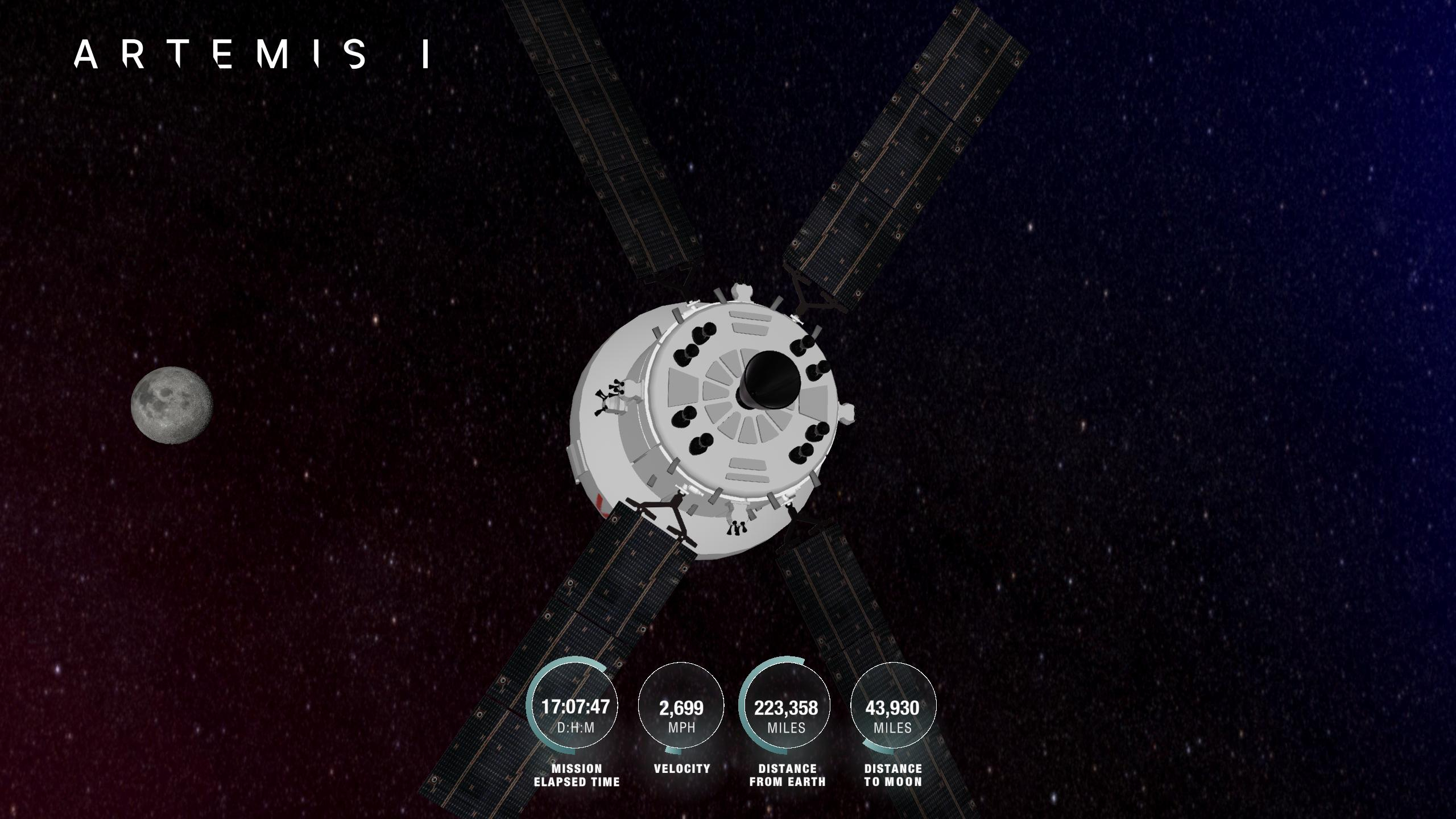
Today is Flight Day 18 of NASA's Artemis 1 Orion mission to the moon.
As of 10 am EST (1500 GMT) today, the Orion spacecraft was 223,358 miles from Earth, 43,930 miles from the Moon, cruising at 2,699 mph. The spacecraft is making its way back to Earth for a planned splashdown off the coast of Southern California on Dec. 11.
Orion fired its engine to leave its distant retrograde orbit around the moon on Thursday, Dec. 1. Since then, flight controllers have used the spacecraft's cameras to take new images of Orion, the moon and Earth, with instruments onboard tracking the radiation environment.
Today, Dec. 3, Orion reenters the moon's "sphere of influence" in which the moon is the primary gravitational force acting on the spacecraft. It will leave that region on Tuesday, Dec. 6, one day after a return powered flyby on Monday, Dec. 5, that will take it just 79 miles above the lunar surface.
Artemis 1 Orion doing well on Flight Day 19
NASA's Orion spacecraft has begun Flight Day 19 of its 25-day mission to the moon as it prepares for a final flyby maneuver of the moon on Monday, Dec. 5.
As of 5 am EST today, Orion was 220,573 miles from Earth and 33,015 miles from the moon (and closing) as it is cruising at 2,906 mph.
On Monday, Orion will swing within 79 miles of the moon and perform its final inbound maneuver to place it on course for a splashdown off the coast of Southern California on Dec. 11.
NASA ready to broadcast Artemis 1 Orion live burn: watch live @ 9 ET
NASA is about to broadcast the Artemis 1 engine burn as the Orion spacecraft continues its epic journey home from the moon. Watch live here, courtesy of NASA Television, and read our preview story here. Coverage starts at 9 a.m. EST (1400 GMT) and the engine burn is expected at 11:43 a.m. EST (1643 GMT).
Orion spacecraft closing in on the moon
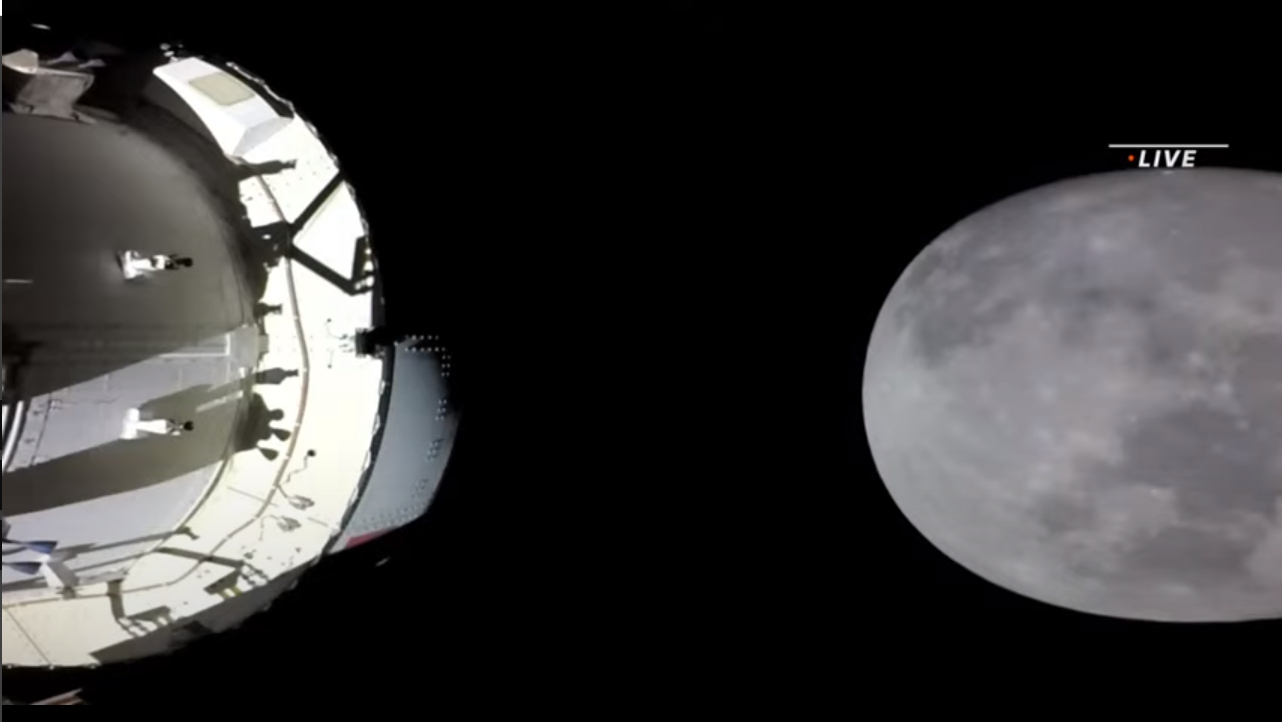
NASA's Orion spacecraft is closing in on its close flyby of the moon, where it will approach within 79 miles of the lunar surface during its departure burn to aim itself toward Earth. The engine burn will begin at 11:43 a.m. EST (1643 GMT).
Orion more than 4,200 miles from the moon
As Orion prepares for its engine burn in a little less than two hours, the spacecraft is aprproximately 4,227 miles (6,802 km) away from the moon traveling at 4,000 miles (6,437 miles) per hour, according to Sandra Jones, a spokesperson on NASA Television. You can watch live here at Space.com or read our preview story.
Orion 1.5 hours from engine burn, 3,529 miles from the moon
As Orion cruises towards an engine burn in about 1.5 hours, the spacecraft is about 3,529 miles (5,679 km) from the moon and traveling 4,157 miles (6,690 km) per hour, spokesperson Sandra Jones said on NASA Television. Watch the broadcast live in our preview story here.
Orion entering last hour before engine burn
As the Artemis 1 Orion spacecraft prepares for its engine burn in just over an hour, the vehicle is about 3,091 miles (4,974 km) away from the moon traveling at 4,238 miles (6,820 km) per hour, according to NASA spokesperson Sandra Jones. Above is a video of the spacecraft's view from space taken from NASA's live broadcast, which is ongoing; you can watch it while looking at our preview story here.
Less than 1 hour before Orion engine burn
The Artemis 1 Orion mission to the moon is less than an hour before an engine burn to bring it back home on Dec. 11. The burn is expected to start at 11:43 a.m. EST (1643 GMT). The spacecraft is roughly 2000 miles (3,218 km) away from the moon, according to spokesperson Sandra Jones during NASA's live broadcast. Coverage is ongoing; you can watch Orion while looking at our preview story here.
NASA tours Apollo moon landing sites ahead of Artemis 1 engine burn
NASA's deputy Apollo curator, Juliane Gross, appeared on the live broadcast of the Artemis 1 Orion engine burn to tell NASA Television viewers what they were seeing as Orion flew within view of the moon; Orion is expected to start its engine burn at 11:43 a.m. EST (1643 GMT). You can watch the interview between Gross and NASA spokesperson Sandra Jones above.
The Apollo rocks, collected between 1969 and 1972, were "really, really cool" but as there were only six landing missions on the equatorial near side they could not represent all regions of the moon, according to Gross. The Apollo missions found largely basalt rocks, whereas Artemis is going to be targeting the south pole region.
"We don't really expect a lot of basalts there. That's more like a highland region," Gross said of the Artemis program landing sites.
"The south polar region also has the largest impact basin that we have on the moon, and also the oldest. So if we can bring back rocks from there, we can hopefully date that really, really old impact region, and then get a better idea of when things happened on the moon and establish a timeline."
Orion 'go' for moon engine burn to return back to Earth
Orion is all set for its moon engine burn at 11:43 a.m. EST (1643 GMT) after Artemis 1 flight director Judd Frieling completed the standard go/no go poll of his team.
The approximately 3 minute, 27 second burn will take place on the far side of the moon while the spacecraft is out of communication with Earth. Orion is less than 1,000 miles (1,609 km) away from the moon, and when its burn happens it will be roughly 79 miles (127 km) from the lunar surface.
If all goes to plan, Orion will splash down in the Pacific Ocean on Dec. 11. Coverage is ongoing; you can watch Orion while looking at our preview story here.
Orion's scheduled engine burn starts at 11:43 a.m. EST
Orion's engine burn is expected to be starting at 11:43 a.m. EST (1643 GMT) at an altitude of 79 miles (127 km) above the moon.
NASA is not in direct communication with the Artemis 1 spacecraft right now as the vehicle is on the far side of the moon, out of the line of sight with antennas on Earth. The engine will fire for about 3 minutes and 27 seconds, if all goes to plan, to aim for a spacecraft splashdown in the Pacific Ocean on Dec. 11.
About half an hour before the engine burn, Orion adjusted its solar arrays and captured an incredible view of the moon's surface below. You can see the action in the video embedded in this post.
Live coverage is ongoing at NASA Television; you can watch the broadcast and read our preview story of today's events here.
Orion re-emerges from far side of the moon, NASA assesses engine burn success
The Orion spacecraft is back in communication after its scheduled engine burn at the far side of the moon at 11:43 a.m. EST (1643 GMT). NASA engineers are assessing the success of the burn, which is planned to put the Artemis 1 mission on track to land in the Pacific Ocean on Dec. 11.
Live coverage at NASA is ongoing and you can read our preview story here.
NASA confirms Orion burn success
NASA has confirmed that the Orion spacecraft is on its way back to Earth as planned following the successful burn at 11:43 a.m. EST (1643 GMT) on the far side of the moon. Coverage is ongoing on NASA Television.
NASA Orion engine burn coverage concludes; next update at 5 p.m. EST
NASA has concluded its coverage of the Orion spacecraft engine burn near the moon, which put the vehicle on a track back to our planet for a splashdown Dec. 11.
Above is a video taken from the live broadcast shortly after Orion reemerged from the far side of the moon, showing the Earth far in the background.
The next update for the Artemis 1 mission will be a briefing by NASA officials regarding how everything is going so far; we will have coverage here at Space.com at 5 p.m. EST (2200 GMT). You can read our wrap story on today's events here.
Orion coming back to Earth after crucial engine burn

On Flight Day 20, the Orion spacecraft is roughly 246,000 miles (396,000 km) from Earth and 47,500 miles (76,400 km) from the moon, according to NASA statistics. The Artemis 1 mission concluded a crucial engine burn yesterday during a close approach to the moon and is on its way back to Earth for a splashdown on Dec. 11.
Read more: Artemis 1 Orion spacecraft on track for return to Earth after moon flyby
Orion leaves moon's sphere of influence on way back to Earth
On Day 21 of the mission, Orion has left the moon's sphere of influence on its way back home, according to NASA. The spacecraft is about 238,000 miles (383,000 km) from Earth and 114,000 miles (183,000 km) from the moon, the agency's Twitter account stated. Orion is expected to splash down in the Pacific Ocean Sunday (Dec. 11), finishing the Artemis 1 mission.
Orion continues its journey home after taking in breathtaking moon views
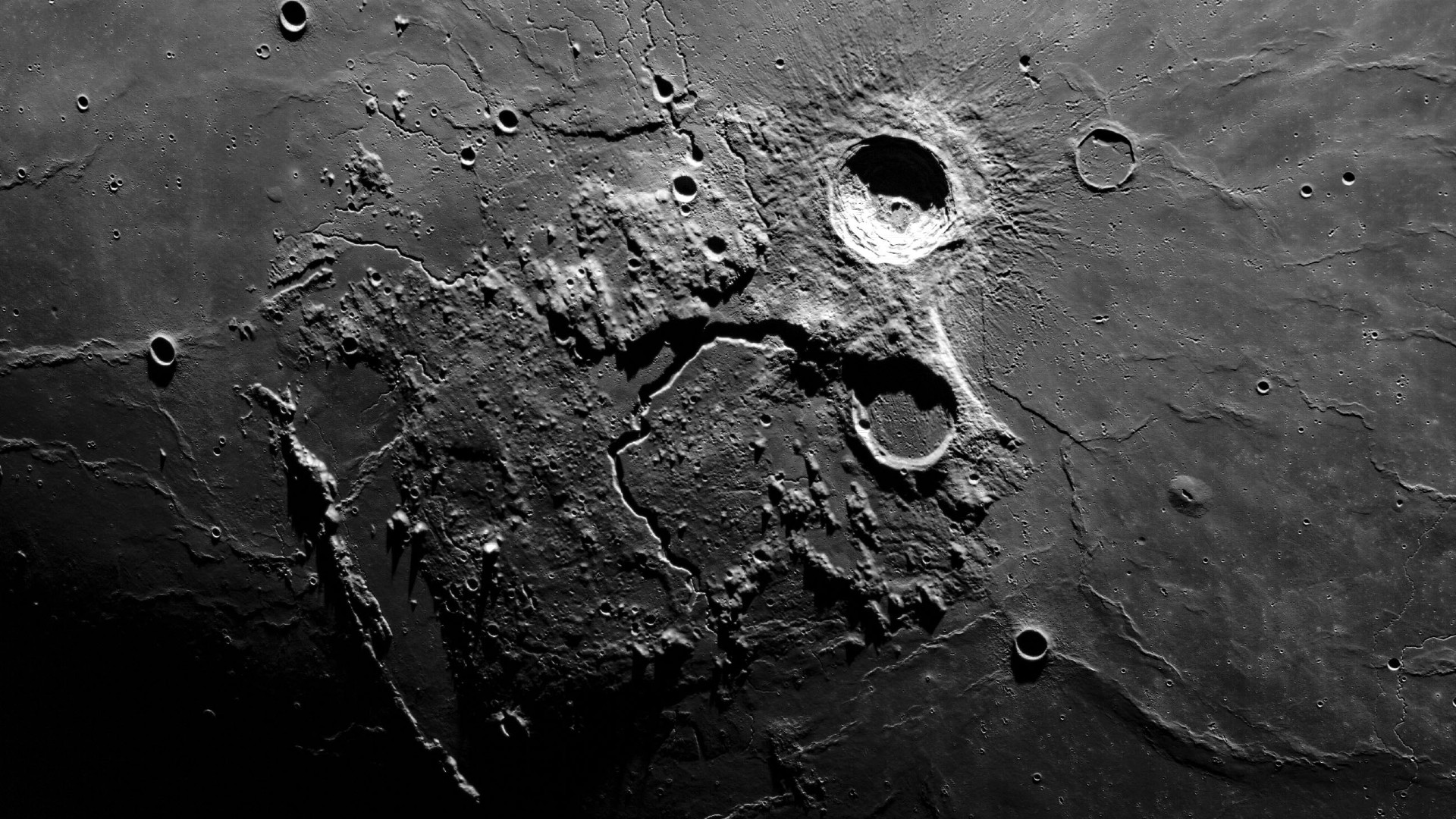
On Day 22 of Orion's maiden voyage, the spacecraft continues to make its way towards Earth after leaving the moon's sphere of gravitational influence. Orion is accelerating as it heads towards Earth, traveling at speeds upwards of 1,110 mph (1,786 kph) as of 6:00 a.m. EST (1100 GMT) on Thursday (Dec. 8), according to NASA.
Orion has captured some incredible imagery as it heads home, including a breathtaking video of the moon eclipsing the Earth as seen from deep space. The uncrewed spacecraft was photographed from Earth on Wednesday (Dec. 7) as it was still 237,000 miles (382,000 kilometers) away.
If the mission continues to go as smoothly as it has thus far, Orion will return to Earth on Dec. 11 and splash down in the Pacific Ocean off the coast of California, bringing an end to the Artemis 1 mission.
Orion less than 200,000 miles from Earth, splashdown in two days
The Orion spacecraft is roughly 190,000 miles (305,775 km) from Earth and 199,400 miles (321,000 km) from the moon on Day 23 of its mission, according to NASA statistics. The Artemis 1 mission of which Orion is a part is slated for splashdown in two days, on Sunday (Dec. 11). Live coverage will be available here at Space.com.
Artemis 1 Orion 1 day to splashdown

Today is Flight Day 25 of NASA's Artemis 1 mission to the moon and back on an uncrewed Orion spacecraft.
As of this morning, Orion was 136,597 miles from Earth, 232,127 miles from the moon and cruising at 2,813 mph, according to a NASA update.
Today, Orion's service module will fire it engine in its fifth return trajectory burn to fine-tune its approach for splashdown tomorrow.
The Artemis 1 Orion spacecraft will return to Earth Sunday, Dec. 11, with a splashdown at 12:40 p.m. EST (1740 GMT).
Here are the 8 steps of the Artemis 1 Orion spacecraft splashdown from Space.com writer Elizabeth Howell.
We also have a timeline of the Orion splashdown if you're wondering what time to tune in.
You can also relive what the Artemis 1 launch looked like in amazing images from Space.com contributor Josh Dinner.
Check out NASA's latest Artemis 1 All Access video on splashdown by opening the video below in a new window.
Splashdown Day for Artemis 1 Orion
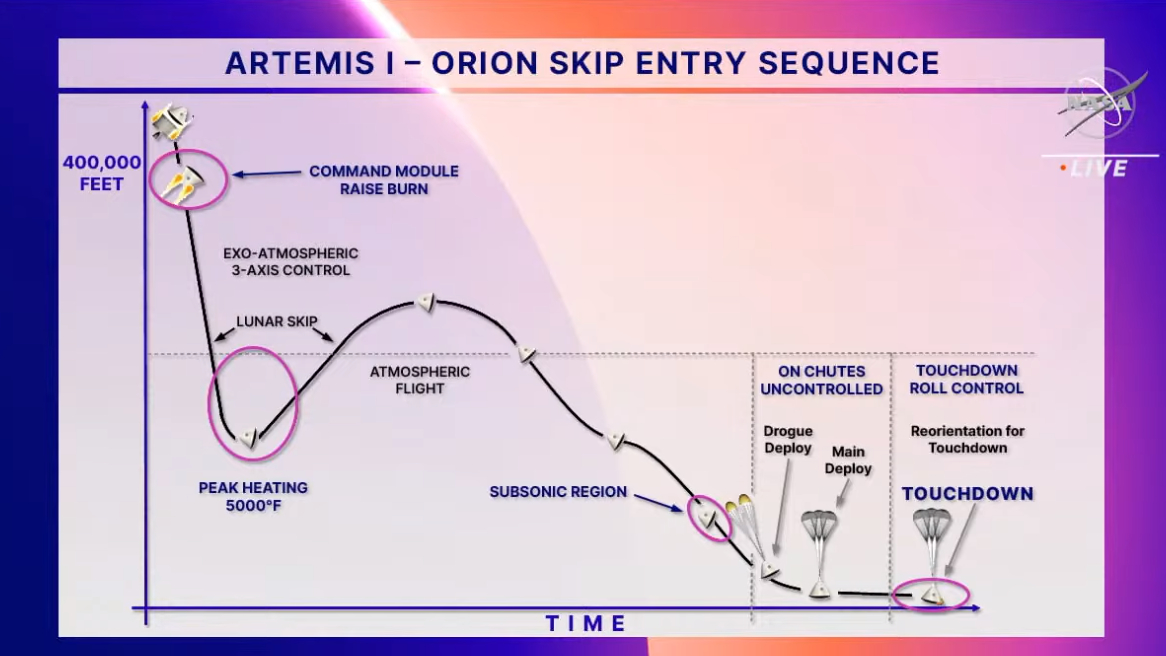
It's splashdown day for NASA's Artemis 1 Orion spacecraft and bound to be an exciting one for NASA and space fans everywhere.
At 12:40 p.m. EST (1740 GMT), the Orion crew capsule will splashdown in the Pacific Ocean off the coast of Baja California and NASA will provide live coverage of the splashdown starting at 11 a.m. EST (1600 GMT). You can watch the splashdown live for free, from NASA TV.
Today is Flight Day 26 of Orion's 26-day mission to the moon and the spacecraft was 38,292 miles from Earth, 251,521 miles from the Moon and cruising at 6,996 mph as of 8 am ET.
Orion was expected to fire its engine one last time for its sixth and final return course correction burn. At 12 p.m. EST (1700 GMT), Orion's crew capsule will separate from its service module to begin its final descent to Earth. You can see how the reentry and splashdown will work above.
Orion captures stunning view of Earth, NASA TV webcast begins
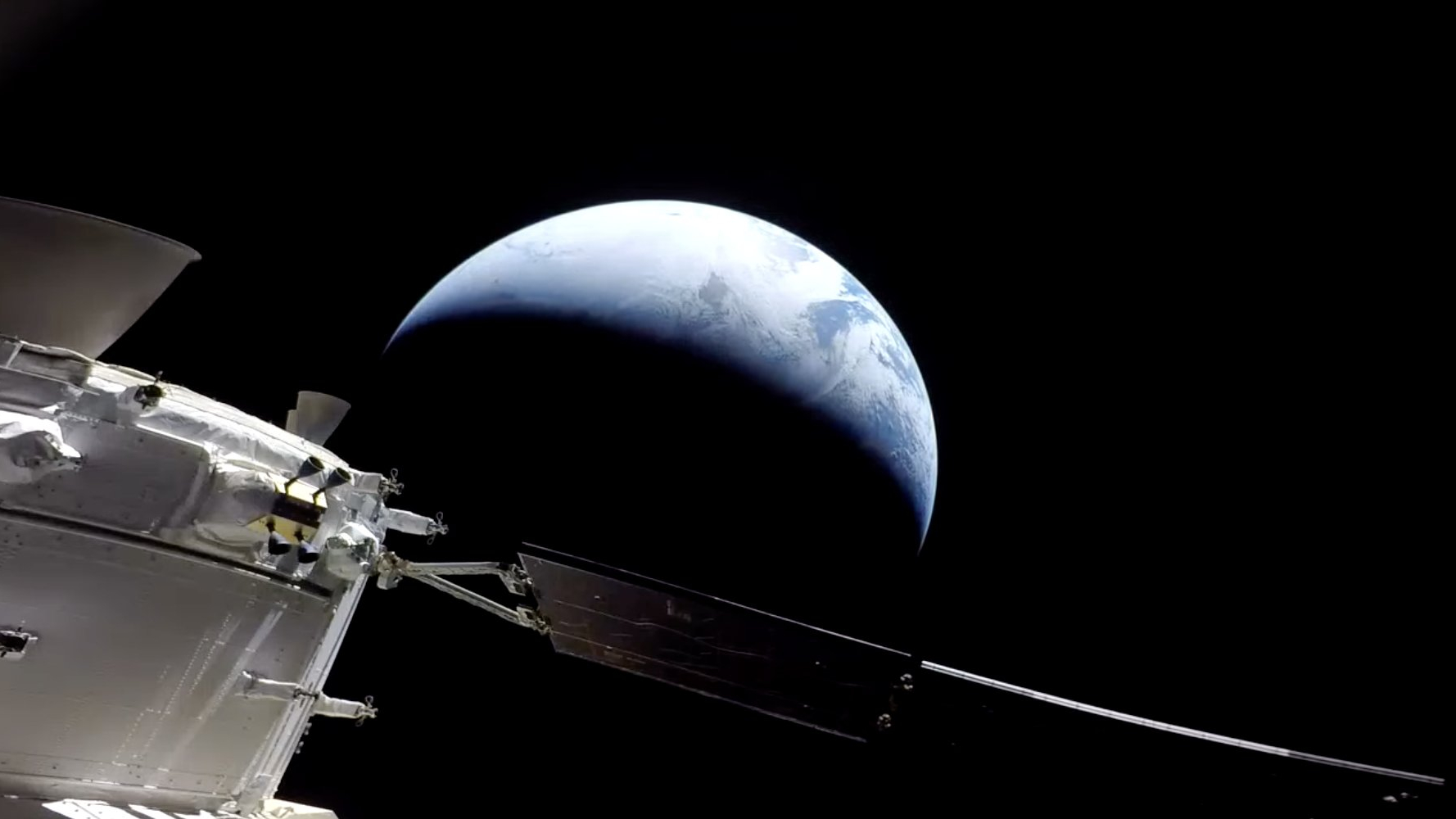
NASA's Orion spacecraft is less than 2 hours away from splashdown, with a live webcast of its landing began at 11 a.m. EST (1600 GMT).
The Earth looks like a brilliant blue crescent to Orion in its exterior cameras, and you can see the still image above of the view.
We captured a video of the view as well, and you can see that here.
Artemis 1 Orion is one hour from splashdown
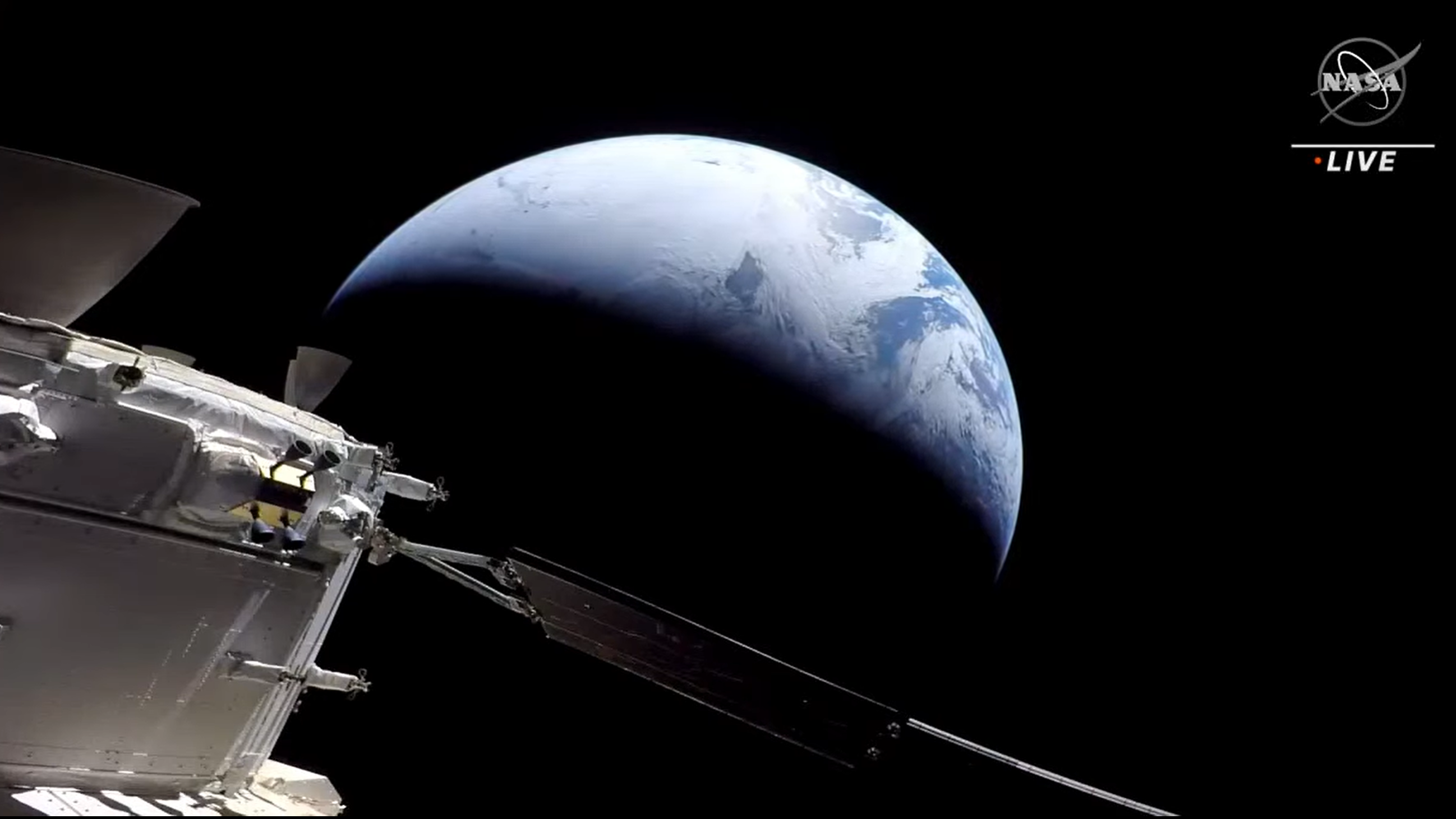
The Artemis 1 Orion spacecraft is one hour from its expected splashdown at 12:40 p.m. EST (1740 GMT) in the Pacific Ocean. Live coverage is ongoing here at Space.com as the mission targets a return to our home planet off the coast of Baja California, following a nearly month-long mission in space that launched Nov. 16.
U.S. Navy puts small boats in the water to prepare for Orion splashdown
The U.S. Navy has deployed six small boats to support the Artemis 1 Orion splashdown while the U.S.S. Portland awaits off the coast of Baja, California, according to NASA spokesperson Derrol Nail. Splashdown is expected at 12:40 p.m. EST (1740 GMT).
NASA Artemis 1 Orion broadcasts last timelapse from orbit
NASA's Artemis 1 Orion spacecraft is well into its splashdown preparation for 12:40 p.m. EST (1740 GMT), but before it shut off the live cameras a few more views of Earth came in from space.
The timelapse here showcases a few serene moments of our home planet as seen from Orion, duplicating what humans themselves may see during Artemis 2 as soon as 2024.
Orion spacecraft separates from service module
The Orion spacecraft has begun the re-entry and splashdown phase of Artemis 1, starting with the vehicle separating from the service module that supplied power and other needs during its nearly month-long mission around the moon. Splashdown is expected at 12:40 p.m. EST (1740 GMT). Read more about the re-entry stages here.
NASA's Artemis 1 Orion spacecraft performs "raise burn"
The Orion spacecraft is doing a last "raising burn" in the closing minutes of Artemis 1, as it completes a nearly month-long mission around the moon. Splashdown is expected at 12:40 p.m. EST (1740 GMT). Read more about the re-entry stages here.
NASA's Artemis 1 Orion begins re-entry
The Orion spacecraft is starting re-entry, including a brief skip off the atmosphere, to continue closing off the month-long mission of Artemis 1 that orbited the moon. Splashdown is expected at 12:40 p.m. EST (1740 GMT). Read more about the re-entry stages here.
NASA's Artemis 1 Orion spacecraft finishes skip maneuver
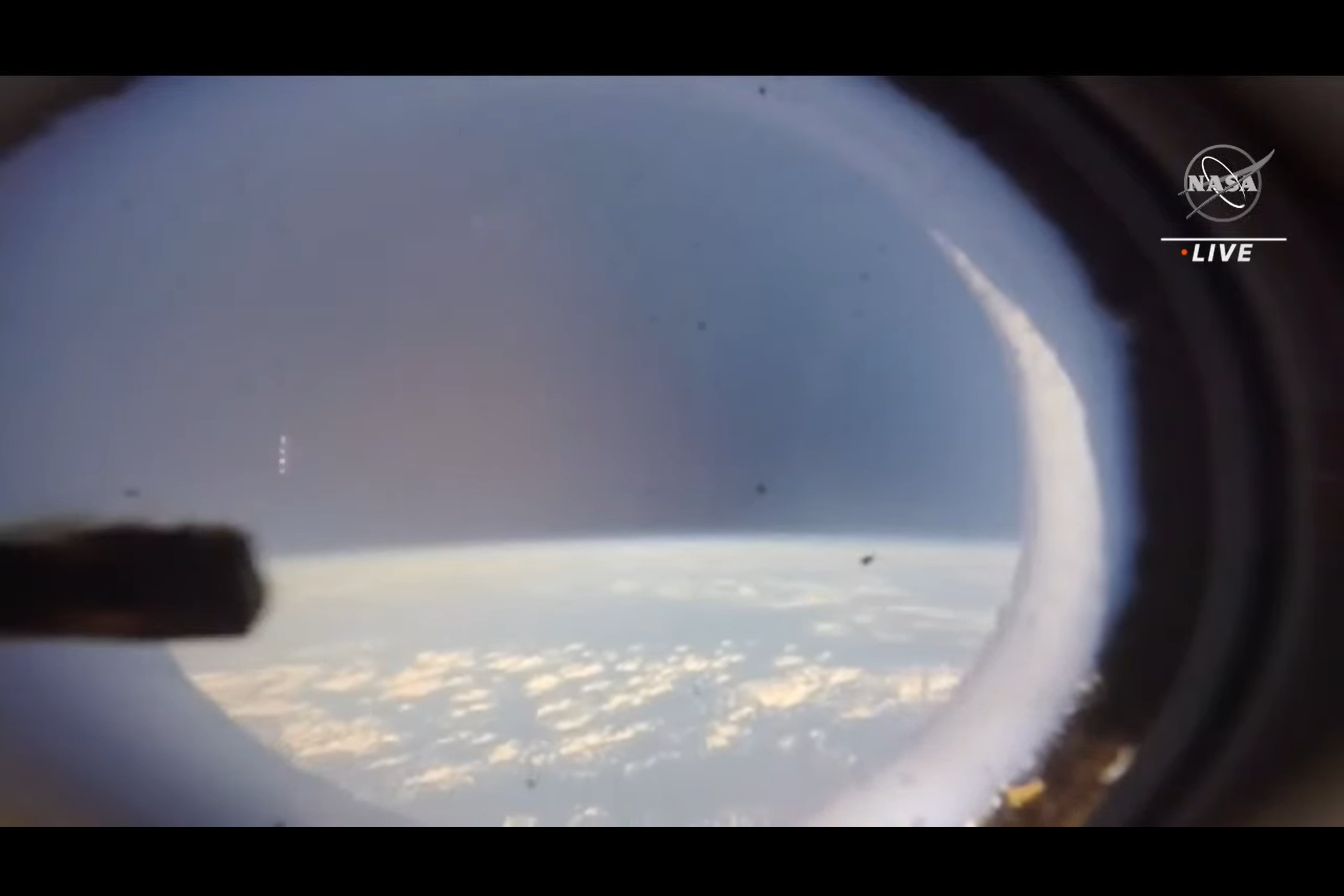
The Orion spacecraft has completed its skip maneuver and in a second phase of re-entry, to continue closing off the month-long mission of Artemis 1 that orbited the moon. Splashdown is expected at 12:40 p.m. EST (1740 GMT). Read more about the re-entry stages here.
NASA Orion spacecraft emerges from re-entry
The Orion spacecraft is emerging from re-entry blackout, to continue closing off the month-long mission of Artemis 1 that orbited the moon. Splashdown is expected at 12:40 p.m. EST (1740 GMT). Read more about the re-entry stages here.
NASA Artemis 1 starting to deploy its 11 parachutes
The Orion spacecraft is starting to deploy its 11 parachutes in several rounds to slow down for splashdown, as it enters the final minutes of the Artemis 1 that orbited the moon. Splashdown is expected at 12:40 p.m. EST (1740 GMT). Read more about the re-entry stages here.
'Three good main chutes for Orion'
Orion has deployed its main parachutes and its moments from splashdown.
Orion 1 splashes down, completing mission
The Orion spacecraft has splashed down in the Pacific Ocean, concluding Artemis 1's nearly month-long journey around the moon. More updates are still coming on Space.com about splashdown activities, so please stay tuned.
Artemis 1 concludes historic uncrewed moon mission
The first mission of NASA's Artemis moon program is in the books.
An uncrewed Orion capsule splashed down in the Pacific Ocean off the coast of Baja California this afternoon (Dec. 11), bringing a successful end to NASA's historic Artemis 1 moon mission after a 1.4 million-mile (2.3 million kilometers) flight. The splashdown occurred 50 years to the day of NASA's Apollo 17 moon landing, the last astronaut mission to touch down on the lunar surface.
Read more: Splashdown! NASA's Artemis 1 Orion capsule lands in Pacific to end epic moon mission
NASA administrator: Artemis 1 'going back into deep space with a new generation'
Administrator Bill Nelson said the Artemis 1 mission is "going back into deep space with a new generation," in comments on NASA Television Sunday (Dec. 11).
"It is [a mission] that marks new technology, a whole new breed of astronaut, a vision for the future that captures the DNA of particularly, Americans, although we do this as an international venture," Nelson added.
Pointing to early European colonizers from which some Americans are now descended, Nelson said the DNA of Americans is as "explorers", because "we always have a frontier, and that frontier is now to continue exploring the heavens." (That said: Nicole Mann, the first Native American woman in space, is now working on the International Space Station. That shows the range of Americans participating in the space program.)
Nelson added that the United States tends to broadcast its space activities openly; the agency, however, has withheld some information about Artemis 1 preparations under export control concerns. While Nelson did not mention any international differences by name, from past comments he may have been thinking of China and Russia; the latter is an ISS partner who has fallen out of favor with many in the U.S. following an unsanctioned invasion of Ukraine nearly a year ago.
"We do it openly, and we do it with our friends, and we invite all peoples of the Earth," Nelson said of space exploration, alluding to the Artemis Accords set of nations (numbering more than two dozen) who have signed on to commit to peaceful international norms of space exploration. Russia is not a signatory to the accords, and nor is China. China is banned from doing bilateral work with NASA under Congressional legislation.
Nelson also pointed to commercial partners, including SpaceX, who have signed on for infrastructure like human landers or for small private missions that are expected to start going to the surface as soon as 2023.
Artemis 1 recovery ship captain on mission success
The captain of the U.S.S. Portland, which is supporting the recovery of Artemis 1, provided live commentary moments ago on ongoing recovery operations on NASA Television, from the Pacific Ocean.
"Right now we have the orbital [spacecraft] in the water," Capt. John Ryan said. "Right now we're kind of in that two- to three-hour window where NASA and the Navy's ... teams are conducting some tests. We're getting imagery and data for NASA, which helps support the future astronaut missions."
Ryan paid tribute to the teams' years of training. "I just basically want to keep the ship within visual distance of the orbital, and our teams, in case they need anything. It also is providing, let's be honest, a lot of people are out here. They're super excited about this. Let's provide visual opportunities for people to get photos, and get their digital part of being the history of this event."
U.S. Vice-President Kamala Harris: 'I applaud the NASA team for their work'
I applaud the @NASA team for their work on completing a successful Artemis I mission. We’re one step closer to returning astronauts to the moon. pic.twitter.com/mv8tAk1craDecember 11, 2022
Vice-President Kamala Harris, who is also the chair of the National Space Council, congratulated NASA on its Artemis 1 mission success on Twitter Sunday (Dec. 11).
"I applaud the team for their work on completing a successful Artemis I mission. We’re one step closer to returning astronauts to the moon," wrote Harris, also sharing splashdown footage from NASA Television in the tweet.
Recovery operations forecast for 2:40 p.m. EST
NASA says the recovery operations of the Orion spacecraft should begin at around 2:40 p.m. EST (1940 GMT). Coverage is ongoing on NASA Television and here at Space.com. Read our wrap story.
Orion spacecraft powers down as planned during recovery operations
NASA says the Orion spacecraft has been powered down and that Navy boats are beginning to approach the vehicle for recovery operations. Coverage is ongoing on NASA Television and here at Space.com. Read our wrap story.
NASA concludes recovery coverage, readies for press conference at NET 3:30 EST
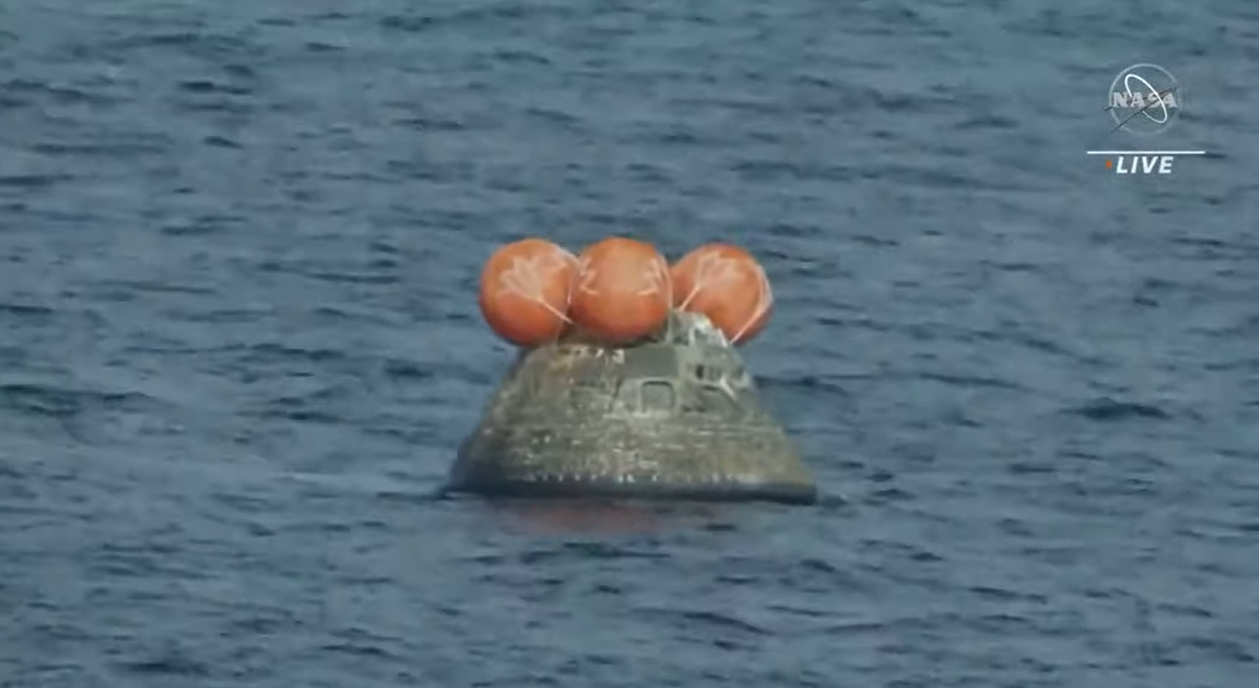
NASA has concluded its recovery coverage of the Orion spacecraft on NASA Television, but events are still happening quickly for the Artemis 1 mission.
Live views of the recovery by the U.S.S. Portland are available on a NASA Kennedy Space Center livestream.
The press conference to go over the end of mission, today's splashdown and what is next for the greater Artemis program is expected to start no earlier than 3:30 p.m. EST (2030 GMT) and you can watch live here at Space.com. Read our wrap story.
NASA post-splashdown Artemis 1 briefing
NASA will hold a press conference at 3:30 pm ET today to discuss the successful Artemis 1 Orion splashdown. You can watch it live on Space.com, courtesy of NASA TV.
Speaking in the briefing will be:
- Bill Nelson, NASA administrator
- Jim Free, NASA associate administrator for the Exploration System Development Mission Directorate, NASA Headquarters
- Vanessa Wyche, director, Johnson
- Janet Petro, director, Kennedy
- Mike Sarafin, mission manager, NASA Headquarters
- Howard Hu, Orion Program manager, Johnson
- Emily Nelson, chief flight director, Johnson
- Melissa Jones, recovery director, Kennedy
Orion capsule hauled aboard Navy recovery ship
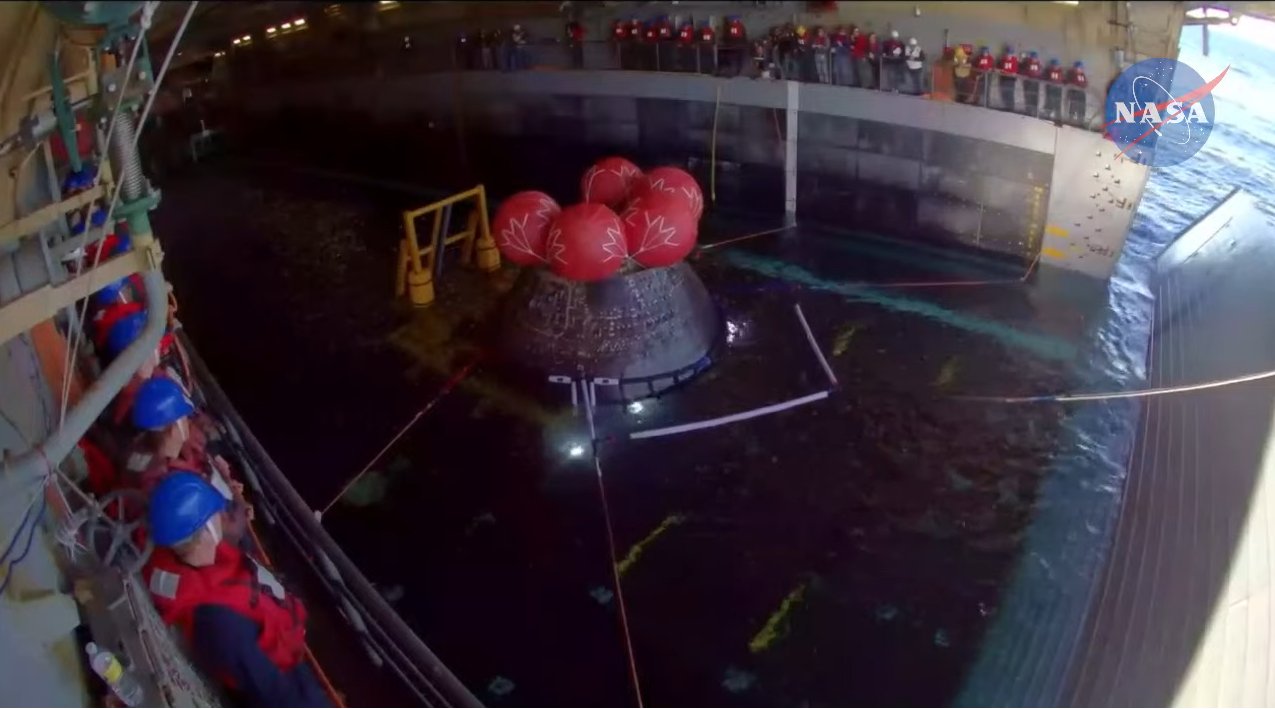
The Artemis 1 Orion capsule has been secured inside the USS Portland, a U.S. Navy vessel sent to recover the spacecraft, NASA announced in a blog post on Sunday evening (Dec. 11). The Portland will haul Orion to port in San Diego, with arrival expected on Tuesday (Dec. 13).
Orion splashed down in the Pacific Ocean about 100 miles (160 kilometers) west of Baja California on Sunday at 12:40 p.m. EST (1740 GMT), bringing a successful end to the 25.5-day Artemis 1 mission.
Artemis 1 Orion spacecraft moved to dry land
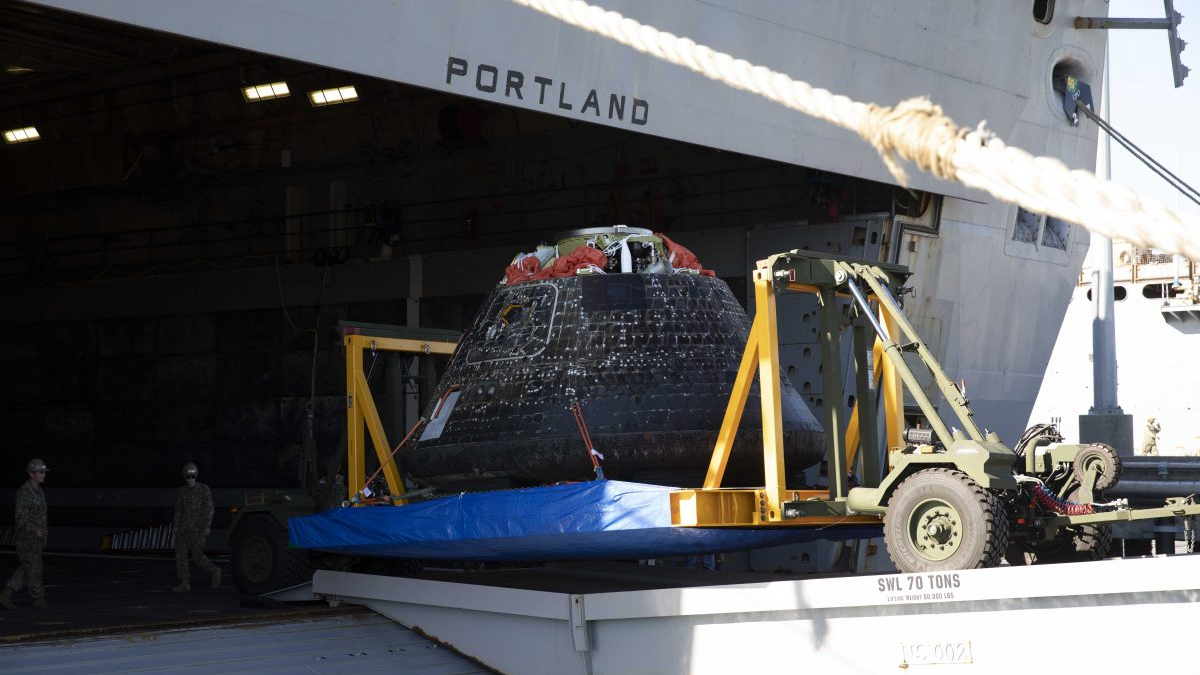
The Artemis 1 Orion capsule is back on dry land for the first time since its launch to the moon on Nov. 16.
The spacecraft was unloaded from the U.S. Navy recovery ship USS Portland in San Diego, California on Wednesday (Dec. 14) so that it can be prepared for a cross-country drive to its home port at the NASA's Kennedy Space Center in Cape Canaveral, Florida.
"Before its departure, teams will open Orion’s hatch as part of preparations for the trip to Kennedy and remove the Biology Experiment-1 payload which flew onboard Orion," NASA officials wrote in a statement. "The experiment involves using plant seeds, fungi, yeast, and algae to study the effects of space radiation before sending humans to the Moon and, eventually, to Mars. Removing the payload prior to Orion’s return to Kennedy allows scientists to begin their analysis before the samples begin to degrade."





